Australian
and international
exploratory
performance and
media arts
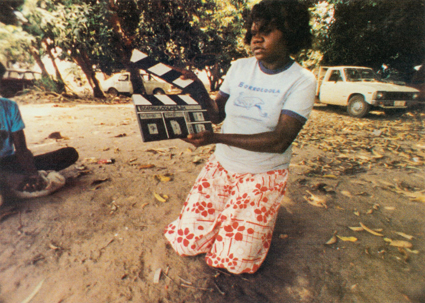
Two Laws (1981)
THERE WAS A SENSE OF POIGNANCY THAT PERMEATED PROCEEDINGS AT THE ‘FROM U-MATIC TO YOUTUBE’ SYMPOSIUM, A CONFERENCE CO-CONVENED BY MONASH UNIVERSITY AND THE AUSTRALIAN CENTRE FOR THE MOVING IMAGE (ACMI). ON THE OPENING MORNING, DR. THERESE DAVIS (MONASH UNIVERSITY) BROKE THE NEWS THAT A NUMBER OF THE SCHEDULED PARTICIPANTS FROM REMOTE BORROLOOLA COMMUNITY IN THE NORTHERN TERRITORY–KEY INVITED SPEAKERS—COULD NO LONGER MAKE THE EVENT AFTER THE SUDDEN DEATH OF A COMMUNITY ELDER.
It was touching to learn that this elder was a significant figure and actor in some of the Borroloola films that were to be screened at the event. The symposium was henceforth dedicated to the “old people” of Indigenous communities who have fought hard for the current possibilities for Aboriginal filmmaking in Australia. The entire event was recorded on film so that a future dialogue might continue between the participants and those absent.
The major focus of the symposium was to recognise the achievements and the challenges of remote community filmmaking. These are frequently low-budget films that don’t usually make it to any type of public screening. Because such films are community projects or else privately undertaken, they comprise a grey area of Australian filmmaking, neglected and virtually unknown both in public discourse and academic scholarship.
The symposium provided a choice opportunity for ACMI and co-convenor Helen Simondson to showcase some of the work they have been doing in conjunction with Aboriginal communities in Victoria through the Digital Storytelling program. In operation at ACMI since February 2004, the scheme involves teams working with community groups to enable individuals across the state to create three to four minute multimedia stories about their lives, histories and interests. Despite a tendency toward sentimentality, without question Digital Storytelling has provided an important recording tool for Indigenous Victorian communities when beforehand there was none.
While it may be a standard view that films should be shown to large audiences, there is also significant Indigenous filmmaking screened purely for the benefit of small, remote communities. The Yanyuwa Song Lines Animation Project from the Borroloola community is a case in point. Their short films—The Law that comes from the Land, the Islands and the Sea (2010), The Song of the Tiger Shark at Manankurra (2010), The Dreamings of the Saltwater Country (2010)—have been made as attempts to rescue sacred stories and songlines for the Borroloola community that would otherwise be lost with the passing of elders. As Associate Professor John Bradley (Monash University), who helped with the production of these short films, warns, “it is inconceivable what really dies” when traditional stories are lost in the generation gap. These films were screened at the symposium and at one public screening at ACMI but only with the special permission of the Borroloola community. This raised an important issue that characterises some Indigenous community filmmaking—what Professor Stephen Muecke (UNSW) referred to as the “politics of non-distribution,” which might also complicate the job of accounting for the extent of community filmmaking in Australia.
A tie-in event to the symposium was the release on DVD of the landmark film Two Laws by Carolyn Strachan and Alessandro Cavadini, timed to commemorate its 30-year anniversary. Made at the beginning of the land rights struggle in Arnhem Land in the late 1970s, it provides a fascinating document of life in the Borroloola community in the midst of large-scale political upheaval. ACMI arranged a public screening of the film. Two Laws is admittedly not an Indigenous film in the sense of being made by an Indigenous director or producer from the community—at the time the Borroloola community had no filmmaking experience and required outside expertise. Yet the film was obviously created with much insight and creative contribution from the community. According to Strachan and Cavadini, who spoke at the panel session “Updating Two Laws: DVDs and Indigenous film heritage,” even the narrative of the film was collaboratively created, defined by storytelling traditions from the Borroloola community.
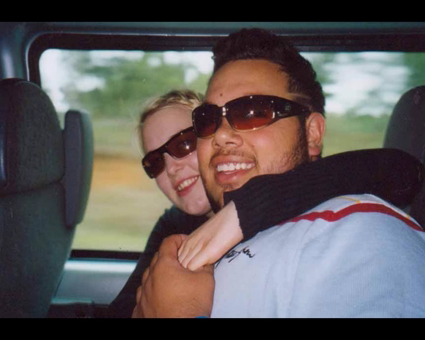
Tim Kanoa, Digital Storytelling, ACMI
Of course, 30 years on, there is also much to celebrate about Indigenous filmmaking, with successful feature films made by directors such as Ivan Sen, Rachel Perkins and Warwick Thornton. The second focus of the symposium was to celebrate the achievements of Indigenous filmmakers and foreground issues at stake in contemporary digital filmmaking. To this end, the symposium focused on the work of two Aboriginal female filmmakers, Darlene Johnston and Romaine Moreton, invited speakers at the event.
Discussions were framed around screenings of the makers’ precocious first short films, Johnston’s Two Bob Mermaid (1996) and Moreton’s The Farm (2006). Johnston, who has gone on to make a number of acclaimed short films and documentaries and is currently getting ready to shoot her first feature film, Obelia, spoke about current copyright opportunities for emerging filmmakers and of her experience working with renowned actor David Gulpilil for her film Crocodile Dreaming (2007). Moreton indicated the importance of using cinema to highlight the previously untold stories of Indigenous life in Australia; in her instance with the making of The Farm it was the green bean-pickers doing casual work around Queensland and Central New South Wales. She also spoke eloquently about Indigenous community filmmaking elsewhere in the world such as the Canadian online portal IsumaTV which is produced for Inuit communities and could serve as inspiration and a possible model for Australian communities.
There were some voices of dissent at the symposium; some felt that the proceedings required a much stronger Indigenous presence. To this end, it was urged that a second, larger conference with greater funding be held, incorporating views from Indigenous filmmakers from around the country. Overall, the symposium seemed well placed to raise awareness of the politics of contemporary Indigenous community filmmaking, as well as to focus on the sheer sensitivity of many of the issues involved in the filmmaking process and in copyright law.
Perhaps one shortcoming of the symposium was that it was difficult to assess how extensive Indigenous community filmmaking is. The case studies featured were informative, yet these were only two examples. How many remote communities are making films? How can one attempt to characterise Indigenous community filmmaking over the last three decades? A second conference could feature reports from community groups in each state and territory and perhaps aim to form a national network to encourage further production, distribution and leverage future filmmaking opportunities.
Australian Centre for the Moving Image and Monash University, From U-matic to YouTube: a symposium celebrating three decades of Australian Indigenous community filmmaking, ACMI, Melbourne, June 8-9
RealTime issue #98 Aug-Sept 2010 pg. 32
© Gem Blackwood; for permission to reproduce apply to realtime@realtimearts.net
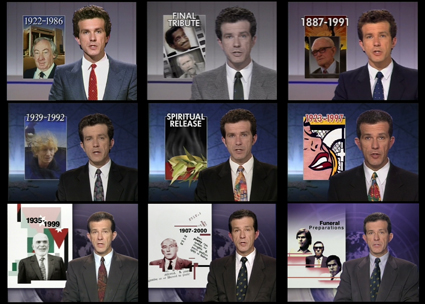
O-bit, Layla Vardo, HATCHED 2010 National Graduate Show, PICA, Perth
see image notes*
O-bit, Layla Vardo, HATCHED 2010 National Graduate Show, PICA, Perth
LET’S ASSUME, FOR THE SAKE OF ARGUMENT, THAT THERE IS SUCH A THING AS ‘THE SOCIAL NETWORKING REVOLUTION,’ AS IF THERE WAS NOTHING OF THE KIND BEFORE THE EVANGELISTIC WEB 2.0, AND TELL ME THAT MYSPACE IS NOT THE ‘HORROR VACUI’ OF OUR TIMES. I’VE ALREADY DIGRESSED INTO POLEMIC. LET’S BEGIN AGAIN, WITH A QUESTION: WHAT IS THE CURRENT STATE OF MEDIA EDUCATION IN THE CONTEXT OF SOCIAL NETWORKING?
Debates around nomenclature, the novelty or regressive nature of new formations are of course perennial, shifting with trends in industry, emergent communication technologies and constant updates within contemporary ‘app’ culture. The old chestnut “new media art” seems to have finally succumbed to the dustbin of history, absorbed into the malleable and apparently more robust discourse of “digital media” (though media or digital art doesn’t seem to trouble the attention of arts critics too often these days). Similarly, the pervasive formations of mobility, customisation and social networking have taken centre stage as inflections of the contemporary mediascape. The Web’s old hat, man.
new contexts
How has the higher education sector responded to these shifts? The fusion of different disciplines is a common feature of much recent and ongoing curriculum development throughout Australian universities. The University of Western Sydney’s recently accredited Master of Convergent Communications course is predicated on the “breakdown of traditional media silos.” Developed by media artist Kate Richards, the course is sensitive to the dynamic “transformation of media production and consumption practices” and the imperative that curricula, designed for preparing graduates to work in such a context, must also change.
Mitchell Whitelaw, who teaches in the postgraduate Digital Design program at the University of Canberra, is also interested in the “fuzzy areas between established practices,” a notion approaching the “hybridity” that RMIT academic and media artist Ian Haig values (though for him the paradigm of “digital media” is a “no brainer” and he dismisses it as “corporate, generic and uncreative”).
Chris Chesher, Director of the Digital Cultures program at the University of Sydney, points out that the introduction of its Bachelor of Arts Informatics program in 2000 was in response to the interests of employers seeking graduates “with the capacity to combine techno-savvy with writing, research and the creative skills of an Arts degree.” In 2007 the program was relaunched as Digital Cultures, a change that reflected the “refocusing of the program around Humanities, Social Sciences and Creative Arts engagements with cultural changes associated with digital technologies.” The Bachelor of Digital Media degree at the College of Fine Arts (UNSW) has also strategically positioned itself, in Ross Harley’s words, “across art school approaches to media production, communications-style degrees typically offered in humanities and social sciences, and design-centric approaches to the teaching of creative production and computing”.
So where will these fuzzy, techno-artistic hybrids find employment, having completed their digital media education? Whitelaw postulates the tantalising, yet not unproblematic idea that in this climate of emergent possibility his students “will have jobs that currently don’t exist.” This is indeed a notion that will detain the attention of critics and industry soothsayers for some time to come. Though a word of caution: multimedia graduates in search of as yet unimagined occupations ended up designing snappy promos for Foxtel or Val Morgan—hardly speculative industries or occupations.
multimedia tiredness
Both principles, of transcending definitional boundaries and blending media in unexpected ways, have clearly escaped the quagmire of ‘multimedia,’ with its reductive combination of audiovisuality and interactivity. It is indeed conspicuous to note that institutions that developed significant multimedia programs in the 1990s (such as Swinburne and RMIT) have moved towards the broader catch-all of Digital Media with its emphasis on a suite of production and conceptual literacies grounded in the principle of a utilitarian, digital paradigm that unifies domestic, commercial, industrial and creative activities. The University of Adelaide’s Graduate Certificate of Design in Digital Media also emphasises the “integration” of digital media into a range of practices and identifies its cohort as “post-professionals” seeking to extend their disciplinary knowledge through the use of digital media. Stephen Huxley, from Swinburne University of Technology’s Faculty of Design points to an overall “tiredness” associated with the notion of multimedia among industry and students alike. Huxley also points to the maturity of industries that developed out of the 1990s and were defined “under the umbrella term of multimedia,” suggesting that they “can no longer be addressed appropriately as a collective.”
transmedial adaptation
Media artist Maria Miranda also describes the ways in which artists have responded to such enormous changes in the mediascape in the last five to 10 years. She notes accordingly that media artists are “increasingly working within social networking paradigms and a much more low tech approach” (personal communication). Miranda’s portrait of the contemporary media artist resonates with and sheds valuable light upon current trends in media education in the Higher Education sector, which is also becoming more nomadic and sensitive to the trans-mediated nature of quotidian life: she writes, “many artists are working in public spaces, and across sites both online and offline simultaneously.” Recent responses within the Academy towards the revival of frayed and fraught notions such as convergence (University of Western Sydney) and culture (AFTRS’ new Graduate Certificate in Screen Culture) suggest that program design and branding within the sector are pro-active, offering digital media education that critically assesses this transmedial reality, as well as adequately equipping graduates for working within its changing industries. In this, then, media education is visionary as much as grounded in the present. The University of Western Sydney’s rationale and approach in this context of dynamic change is made plain, in that it is predicated on the “uneasy fit between creative and mobile audiences.” In the assertive, second person vernacular that is de rigueur within academic program design, its projected outcomes for students are clearly forward thinking and innovative: “you will develop new digital content, build skills and resources and explore the industry’s future, while assessing how you can adapt your experience to this rapidly changing industry.”
Not surprisingly, Queensland University of Technology’s “cultural industries”-inflected Media and Communications program accepts that the mix of fixed and mobile media is simply a fact of life. Accordingly, its program is interested in the concept of the “distribution of creative content” through various and intersecting media channels. Indeed, its Honours program in Technology Innovation (Digital Media) describes the “evolution” of the digital media industry (again understood as the dispersal of multimedia into more established practices such as cinema and performance) as “just beginning.” This development of student literacy, informed by the connection between digital technology and ‘creative’ disciplines, is also a focus of the University of Tasmania’s Masters in Creative Media Technology.
decentralised learning & working
If we accept that Digital Media is the new black and multimedia is so yesterday, how are Universities accommodating the voracious behemoth of social networking into the delivery of their curricula? The decentralising of learning and teaching has tapped into the social network’s imperative of delivering, to quote Ted Nelson, “anything instantly.” Lectures no longer have to be delivered, but can instead be pre-recorded and downloaded as podcasts to be auditioned at a time and place of the student’s discretion using mobile media. Online resources of all kinds (such as blogs and Wikis) have become a staple to be browsed like so many apps and, not surprisingly, it is becoming commonplace for universities to have their own iTunes channel for archiving downloadable learning materials. Many campuses have also embraced the virtual space of Second Life, whereby islands cater for the transfer of knowledge as much as the fulfilment of fantasy. Facebook, too, has been colonised by universities in the name of ubiquitous presence in the mediated lives of their students. Even the linguistically challenged Twitter has become a curriculum resource, with Griffith University Journalism students among the first in the country required to tweet as part of their assessable work.
to tweet or not
What are we to make of this confluence of academic work and the wireless public domain, the creative commons and the social network? In a recent essay on the blurring of public and private spheres in the “Age of Always Connect,” American writer Mark Dery discusses notions of “over-sharing” and the “death of shame” as the negative signs of the times we live in (http://trueslant.com/markdery/). Written with his inimitable acerbic wit, force and invention the essay is a cautionary tale about the double-headed hydra of mediated solipsism (the silent fixation on screens that makes “solitude portable”) and the unwanted broadcasting of privacy (“the stranger with the headset, chattering blithely about her irritable bowel as she elbows past you at the supermarket meat counter”).
It is clear that the academy has already embraced the siren song of the mediated world of me (it is “trending” in tweet-speak), but does it follow that the social network and the ideal of a ‘commons’ should become part of the intellectual infrastructure of the university? And does such a suggestion make me a tweet-less dag? What is to become of knowledge (as something that precedes and must succeed me) in the confessional tweet economy when definitions of media art, discussions of the media sector and what I’m wearing at the time will be undifferentiated noise in the flow? Discuss in 140 characters or less.
*Image notes: Layla Vardo is a graduate of RMIT (2009). Her work O-bit was awarded a prize as part of the Dr Harold Schenberg Bequest presented at HATCHED 2010 National Graduate Exhibition, PICA, Perth.
“Chronicling the aging of the subject and the medium of television itself, O-bit is a single channel video installation composed of chronological jump-cut images and breath sounds of news anchor Richard Morecroft as he delivers obituaries and death reports during his 17 years presenting the ABC nightly news” (Hatched 2010 Catalogue).
RealTime issue #98 Aug-Sept 2010 pg. 33
© Darren Tofts; for permission to reproduce apply to realtime@realtimearts.net
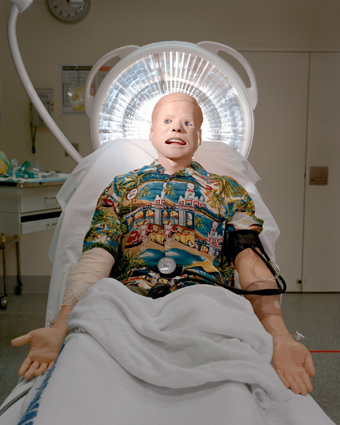
Living in Sim, Justine Cooper
image courtesy of the artist
Living in Sim, Justine Cooper
THE UNCANNY VALLEY TAKES ITS NAME FROM A GRAPH DEVELOPED BY JAPANESE ROBOTICIST MASAHIRO MORI IN 1970 TO MEASURE THE EMOTIONAL RESPONSES OF HUMANS TO THE DEGREE OF ANTHROPOMORPHISM IN ROBOTS. THE ‘UNCANNY VALLEY’ IS A PRONOUNCED DIP IN THE GRAPH WHICH OCCURS WHEN PEOPLE REACT NEGATIVELY TO THE ROBOTS BECOMING CLOSER TO THEM IN HUMAN APPEARANCE. THIS VALLEY IS WHERE THINGS SEEM HUMAN AND NOT QUITE HUMAN AT THE SAME TIME. TO QUOTE CURATOR LYNNE SANDERSON’S CATALOGUE ESSAY: “THIS IS THE PLACE WHERE ZOMBIES AND CORPSES THRIVE. IT IS ALSO WHERE MANNEQUINS LIVE…” LIKE MORI’S EXPERIMENTS THE EXHIBITION PRODUCES A RANGE OF CONTRADICTORY REACTIONS.
On the opening night we all crowd onto the viewing platform in a small side room waiting for Peter William Holden’s Arabesque to fire up again; it takes about 12 minutes for the hydraulic system to reset itself. Finally, the opening bars of Strauss’ Blue Danube can be heard and the performance literally kicks off. Eight robotic legs and arms move in time to the entire piece of music, and I hear someone mutter behind me that it is a fitting tribute to such a trite piece of music. Perhaps he means we’ve heard it so often that it has entered into the realm of artifice.
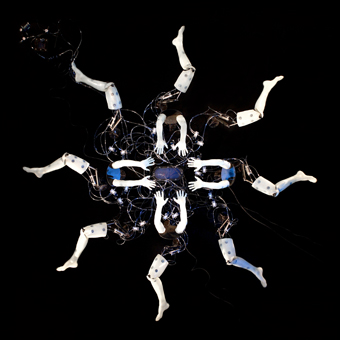
Arabesque, Peter William Holden
image by Medial Mirage/Matthias Moller
Arabesque, Peter William Holden
The photos of Arabesque in the catalogue show glowing iridescent legs and arms; a slow shutter speed must have been used, as luminous lines of movement are visible as well. These photographs of the “mechanical flower” are quite beautiful, whereas the artwork itself is fascinating in a different way, mainly with how it works. The cast arms and legs are made from a translucent material which has the appearance of waxy, dead skin. They are powered by hydraulics, with air periodically hissing its release, accompanied by the click of the limbs as they move. The artist deliberately left the many cables and workings of the sculpture in sight, acting as a kind of puzzle as to how it operates. People standing next to me laugh and clap and cry out “brilliant.” When taken in the context of the Uncanny Valley thesis, this seems akin to laughing at a funeral—that tendency to laugh in moments when not quite comfortable. I overhear many other people saying “It is like a…” which seems to signify that the work has entered the realm of the uncanny—as something for which we don’t yet have a language.
Dominating the gallery space is Justine Cooper’s photographic and video work Living in Sim which Cooper made as an outcome of her residency in at the Centre for Medical Simulation in Cambridge, Massachusetts. Presented in multiple formats, DVD, photographs and online, the work employs medical mannequins used to simulate patients for the training of medical practitioners. Cooper presents us with a hyper-real medical centre, complete with mannequins of aged care patients in wheelchairs, imposing hospital directors and the heaving breasts of nurses. One gallery wall is covered with small photographic canvases; nearly all of the dummies pictured on these have their mouths open as in silent screams, or maybe they are singing? In this hospital drama there is no blood, dirt or overcrowding; everyone who needs a bed has one, including Noctomum who has just given birth to nine children from multiple races. Another wall features images that Cooper has taken of actual simulated medical training exercises and these are quite affecting, particularly the mournful photograph of wheelchair-bound patients stuck in the corner and seemingly neglected.
The gallery space is also dominated by the sickly sweet soundtrack of Cooper’s video work. The DVD features blood, orifices and mess. The soundtrack croons on about the intimacy of doctor-patient relationships. The patients and medical staff of this “community living out the drama of health care” are further realised through a blog (livinginsim.com) which features posts and poems by the fictional staff members and video and photographs of their world. The mannequins use the blog to debate issues, such as plastic surgery (which Nurse Smilodon is vehemently against) and artificial insemination. The blog is what makes this artwork paradoxically ‘come to life,’ a demonstration of Cooper’s astute observations on the artificiality of online communication. The staff’s blog posts and biographies bring the comedic element of the work into play along, with more disturbing elements. In the visitors book in the gallery some visitors have written that the exhibition is offensive, stupid and pointless, asking that old question ‘is this art?’ One contributor has aptly written: “Disturbing? I find episodes of Master Chef more disturbing! I think some people in our health system must feel like dummies!”
The other two artworks in the exhibition are somewhat dwarfed, both in terms of size and complexity. David Archer’s A Journey Into the Mind takes us back to the Victorian era when experiments with robotics and automata were just appearing—the toys of the upper classes and the amusement parks of the masses. This sculpture is a hand-painted arcade style machine where the viewer looks into the lens and turns a handle. The human head inside the machine slowly opens to reveal a skull, which also opens in turn, revealing a peanut in the place of a brain. The simple mechanism and ‘message’ of this work is a reminder of how far science has come in robotics and yet how little has been achieved. Rona Pondick’s Jawbreakers is also a simple work, a jar of brightly coloured lollies stands on a shelf. On closer inspection these jawbreakers are revealed to be made from toothy cast jaws. Pondick writes that she sometimes wants to bite people she gets angry with, but has to stop herself because it’s socially unacceptable. The piece spirals in on itself—you bite a jawbreaker, it bites you back. These are lollies that will break your jaw and are broken jaws. It is a simple, playful piece. Pondick has used maniacally grinning teeth in her work previously; these little disembodied mouths can be quite disturbing, even uncanny.
With its dark humour, Uncanny Valley rides the fine line between comedy and drama and is at once disturbing and questioning. The exhibition functions in a very visceral manner with its small stories of real and artificial life in a darkened room. But the artificiality of the materials and media don’t quite allow for interaction with our own soft, warm bodies; somehow we feel excluded—surely part of the fear that fills the dark spaces of Masahiro Mori’s ‘uncanny valley.’
The Uncanny Valley: An exhibition exploring the not quite human, curator Lynne Sanderson, RiAus, Science Exchange, Adelaide, June 4-July 23, www.riaus.org.au
RealTime issue #98 Aug-Sept 2010 pg. 36
© Kirsty Darlaston; for permission to reproduce apply to realtime@realtimearts.net
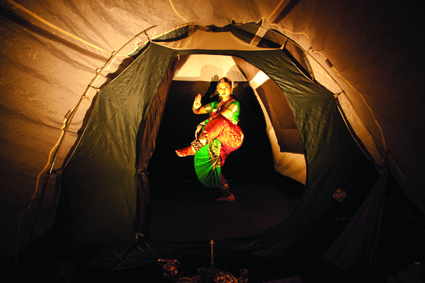
Radhika Krishnamoorthy, Private Dances
photo Jorge de Araujo
Radhika Krishnamoorthy, Private Dances
GENRE BENDING AND RISK TAKING WERE THE PROVISOS OF THE 2010 NEXT WAVE FESTIVAL WHICH RAN FOR OVER TWO WEEKS IN MELBOURNE. AUSTRALIAN EMERGING ARTISTS PUT THEIR BODIES UNDER DURESS, THREW OFF THEIR LAYERS OF SELF-CONSCIOUSNESS (AND CLOTHING) AND REWARDED THEIR AUDIENCES WITH INTIMACY, INSIGHT AND INTRIGUE.
private dances
Have you ever had someone dance just for you? Up close, you can perceive sweat glisten, sinewy muscles snaking in the spotlight, chest heaving. Exhilarated, yet coy, you make eye contact. Private Dances (curator, producer Natalie Cursio) ranges from traditional Korean dance to Private Parking—a performance in a van while you sit in the driver’s seat. It’s a large scale production incorporating 10 live performances, food, unexpected sets and six short films all viewed solo. Due to the random manner in which viewers are chosen to participate the audience takes in a variable slice of the action.
The Meat Market was converted into a softly darkened bar while tents—set up as if for children in a lounge room—provided just some of the unexpected venues for viewing film and performances with the unbridled joy of playtime. Dancer Atlanta Eke donned a gorilla suit to dance with you to a ballad. Alone, you think, until invited to sit in the annexe of the tent and watch the next person sharing a teenage dance hall moment to Cindi Lauper. Dancing stripped of the restrictions of a stage and the anonymity of a crowd became an intimate interaction. Underlying the evening’s fantastical entertainment was pleasure in its quiet voyeurism and feeling of gratitude. Private Dances was a gift to the audience, a rare opportunity to be treated like a royal guest in a Persian tent city. Not surprisingly, the show was a festival favourite and quickly sold out.
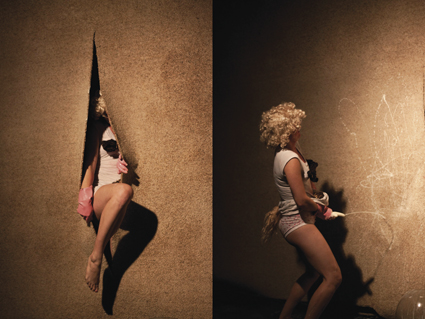
Sugar Coated, Hannah Raisin
photo Kim Ryan
Sugar Coated, Hannah Raisin
sugar coated
Hannah Raisin in Sugar Coated took a multidisciplinary approach in exploring gender roles and sexuality with a collection of film, sounds and live performance. A slight 24-year old with an unassuming bob, the recent VCA graduate handles her subject matter with fearless aplomb and speedy costume changes. She seems to intuit where the history of gender politics is at, taking back raunch culture from the pornographers and exploiters, interpreting it with artistic wit and a sensory explosion. This even includes scent: bait fish rained from her underpants in the opening act, leaving a lingering fragrance for the remainder of the show. In her investigations into domesticity and sexuality Raisin uses props ranging from fling-ups (textile representations of female genitalia) to soapy water to draw a reclining nude. In one video she pours milk over herself on a city street wearing just a transparent raincoat—much to the shock of middle-aged theatre goers. In the closing act she dons a bikini made of bath bombs, dousing herself with bottles of water while standing in a toy sea shell pool—a sadly bedraggled Venus. Raisin’s desire to push her body to often painful new places wins her fans but is also effective in conveying her contradictory messages of female angst and empowerment.
short message service
In a risk averse culture, The Short Message Service was an experiment in allowing audience control of two performers via text message. The show echoed Marina Abramovic ‘s 1974 Rhythm 0, which freely tested the relationship between artist and audience. Here though, the audience requests were channelled through gatekeepers who chose which text message instructions to relay via a handsfree set. The props consisted of a table and two chairs; no scissors, gun, rose thorns nor direct interaction here.
Phase 1 of the experiment began slowly; the audience was urged to send greetings for the two performers. These were trite enough to begin with; “Ni Hao, Herro.” Phase 2 required the audience members to involve their respective actors in moments of tenderness and tension. Verbal communication became action; Mish, the female actor, was instructed to disrobe and spent a good portion of the performance topless. She bore the abusive urges of the audience with the passive stoicism of Abramovic. Naked breakdancing and slapping of faces were some of the dark desires that were realised onstage.
After Rhythm 0, Abramovic stated, “if you leave [the] decision to the public, you can be killed…” She went on to mention the aggressive atmosphere created. Indeed there was also something vaguely reminiscent of the ‘71 Zimbardo prison experiment in this show; instead of security guards with batons the audience inflicted pain via mobile phones. As an experiment, SMS raised some pertinent points on technology and intimacy, in the process receiving a few laughs, though the possibility of text message RSI and the occasionally puerile outcomes made it a hard sell for an hour long show.
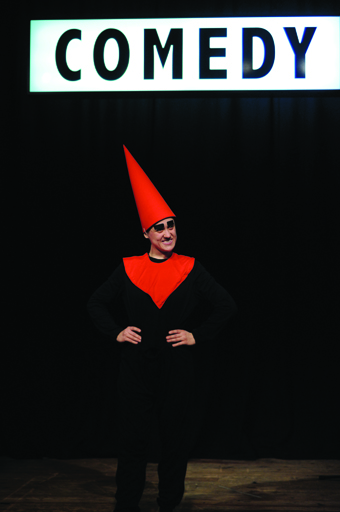
Frances Barret, A Comedy, Brown Council
photo Devika Bilimoria
Frances Barret, A Comedy, Brown Council
a comedy
Performed by artist collaborators Brown Council, A Comedy investigates Nietzche’s idea that maliciousness and absurdity are the basis of all laughter. The audience is guided through the well-established comedy canon: stand up, slapstick, spectacle and audience participation. Expectations are slowly dismantled and what we begin to see are uncomfortable, tortured performances from forced banana consumption to real slaps in slapstick routines. Not only do we sense the desperation of comedians for a laugh but the lengths they will go to achieve it. By the close of the show the once comical dunce hats that the performers and audience wear take on a sinister role. After her failed attempt to escape from rope bindings, a target is drawn on the face of a bound female performer and the audience is encouraged to hurl tomatoes. It could be a scene from Abu Ghraib; the conical hat and black sack clothing she wears are familiar images from the 2004 prison torture scandal. Unfortunately those pummelling the performer seemed to miss this reference and the premise of the show. To be fair, the constant encouragement for audience participation was quite manipulative and seemed to sanction this violence.
and that was the summer….
On a lighter note, And that was the summer that changed my life was a comedy where one could snort and guffaw without prejudice. Written and performed by Zoë Coombs Marr (of performance group Post), it’s a sharply observed monologue dealing with the acute embarrassment of teenage firsts—the transition from childhood love of dinosaurs and music camps to sexual awakening. That Marr unabashedly admits to her most excruciating moments is a cathartic experience for the audience. Dressed in an unflattering leotard with a parachute jacket, sometimes we even recognise ourselves in her. Before pity ever sets in, Marr cuts in with a boast—“I’ve crushed a lot of pussy”—and keeps the audience besotted with acerbic humour and the kind of daggy, alone-in-your-own-room creativity that sustains countless teenagers.
Peppered throughout are nostalgic musical interludes dating to that summer in the mid 90s when it all changed for her. In these, Marr performs Lucille Ball type facial contortions and uses an appliquéd brontosaurus on her leotard as a puppet. In her self-deprecating confessions are serious coming of age hurdles that lend poignancy to her story. Just as Frankie magazine elevated doilies and baking to fashion, Marr turns her flute playing, nose bleeding Sapphic alter ego into a high priestess of cool. The final musical number is a creamy chef d’oeuvre and a big payoff for the audience.
Next Wave Festival 2010: Private Dances, concept, curator, producer Natalie Cursio, Arts House, Meat Market, May 12-16; Sugar Coated, artist Hannah Raisin, Goodtime Studios, May 14-20; The Short Message Service, performers, collaborators Jackson Castiglione, Mish Grigor, co-creators, collaborators Leah Shelton, Lachlan Tetlow-Stuart: BlackBox, Arts Centre, May 14-22; Brown Council (Frances Barrett, Kate Blackmore, Kelly Doley, Diana Smith), A Comedy, Trades Hall, May 19-23; Zoë Coombs Marr, And That Was The Summer That Changed My Life, BlackBox, Arts Centre, Melbourne May 26-29
RealTime issue #98 Aug-Sept 2010 pg. 39
© Varia Karipoff; for permission to reproduce apply to realtime@realtimearts.net
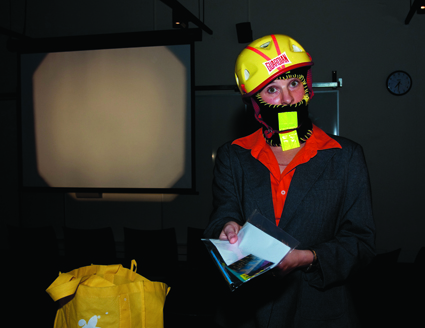
Paula van Beek, Dangerous Melbourne
photo Oliver Parzer
Paula van Beek, Dangerous Melbourne
WE’RE HAVING TEA AND BISCUITS IN A SEMINAR ROOM ABOVE MELBOURNE’S CITY LIBRARY. A PASTY FACED CHICK WEARING A PLAID SUIT AND ADIDAS RUNNERS STANDS TO ONE SIDE. TOO MUCH FOUNDATION HAS BEEN APPLIED TO HER FACE. HER EYES HAVE ABOUT THEM THE VAGARIES ASSOCIATED WITH NARCOTIC ADDICTION, AND HER ENTIRE BEING APPEARS TO TREMBLE. SHE GIVES THE IMPRESSION SHE MAY BOLT ACROSS THE ROOM AT ANY MOMENT AND HURL HERSELF OUT THE FIRST FLOOR WINDOW.
dangerous melbourne
But Dangerous Melbourne is an ironic take on the safety seminar. So performer Paula Van Beek instead situates herself before a projector while we the audience are paired off with one another. You know the corporate training drill. Name tags attached to shirts stating ‘Hello, my name is blah, blah, blah…,’ two 15-minute breaks either side of lunch and the assumed authority of an inane team leader who believes in her purpose with a missionary’s zeal. Van Beek advises us to open our eyes and become aware of Melbourne’s dangers, as she projects on a screen sign after relentless sign, each indicating an unreasonable fear of annihilation.
What I experience, however, is a slippage between the formality of the training seminar and the art of performance. Here, the boredom associated with corporate training dissipates revealing a quietly hysterical team leader who is as terrified of being shat on by a pigeon as she is of being pack-raped. Dissolute, Van Beek stands before the bright light of her projector. Contained by emptiness, stepping into the unknown is the most terrifying risk a human being can undertake.
i thought a musical was being made
A Melbourne landmark, the Greek restaurant Stalactites is best known for its chicken souvlakis rather than as a performance venue. We sit at pre-designated tables and a waiter soon delivers a plate containing spanakopita, kalamata olives, dolmades and other Greek goodies. A dude sitting directly across from me explains that he’s a vegan and that therefore I can eat as much of the food as I like. Thanks for that, but eating in a performance context is a sly form of audience participation; one that often has unforeseen consequences.
Filtering through my headphones is a sonorous mix of atmospherics and performance poetry. Through a window, it soon becomes apparent that a second event is also taking place, outside in Lonsdale Street. But I’m seated in such a way that I can’t see the action; which is quite interesting really: being prevented from seeing for yourself what others can see for you is an illuminating interpretation of the public-private interface—a distortion we experience everyday in our media dominated lives.
The music ends and we’re led back downstairs to where this performance began, outside in Lonsdale Street. Just as we have been prevented from—or allowed to participate in—watching others perform from an upstairs window, there now occurs a further elaboration of this collaborative awareness. As we shuffle around in circles and do silly things, others now watch us perform from the 1st floor of three buildings situated at the intersection of Lonsdale and Russell Streets. My sense of the sanctified individual and their place in a consumptive society is replaced by the multiplicitous proposition that as individuals we ignite when gazed at by other human beings.
and then something fell on my head
The stated theme of Next Wave 2010 is “No Risk Too Great.” Funny though, the one time I feel threatened is when traversing the technocratic badlands of Melbourne’s recently developed Victoria Dock to see And Then Something Fell On My Head.
Seated within the post-industrial Shed No. 4, I notice that a senior Victorian politician is also in attendance. We’re wearing mandatory dust masks, protective goggles, hard hats and coveralls, and for good reason. From high up on a scaffold, shadowy figures dispense with a multitude of coloured pencils, sheets of paper and empty water containers, while a submissive office worker moves toward us. It’s the forces of nature, thunder, rain and snow challenging the technocratic forces of habit: pencils, paper and purified spring water. And we the audience are also under threat. Until, in a neatly conceptualised projection layered across three sheets of cotton scrim, a video representation of the same office worker first unravels, then multiplies, while a developing awareness of the natural world dawns, along with its accompanying void.
Later, when inside the most uninviting unisex toilet I have encountered for quite some time, I quip to the senior Victorian politician that this show, perhaps, resembled a day in the life of the Victorian Parliament. “Yes,” he says, slightly embarrassed. “Lots of shit falling on your head from a great height.” Yeah, right…
a good death
And Then Something Fell On My Head was the most concentrated realisation of the troubling effect of technocracy and its consequent human frailties. But the attention to detail accompanying The Sisters Hayes’ A Good Death distinguished it from its peers.
It takes place in a wizened crypt beneath North Melbourne’s Mary Star of the Sea Church. There are tears of blood descending from forlorn eyes and the viscera of religious conviction represented by crimson braid. There’s a painting of a personal friend of the artists, a wigmaker resembling a glamrocker, who, for some obscure reason has been elevated to sainthood. During a penny arcade animation comprising a performance containing painstakingly constructed masks, I cringe when I see one of those bum shaped, 70s, blue plastic chairs. This, however, may be a considered choice. A good death exposes the mysterious mythologies and disturbed impulses that underpin the stories of Catholic sainthood. But these retellings occur in such an idiosyncratic way that the ominous tale of Catholicism instead assumes a playful irreverence, one that conveys a genuine respect for its source. Impressive in scope and impervious to my secular scepticism, A good death dies a thousand deaths as it subverts Catholic history, and reinterprets the birth of Christ.
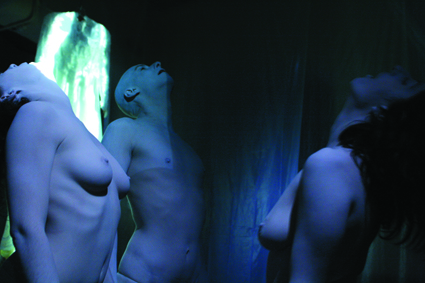
The Oak’s Bride, Red Moon Rising
photo Gareth Hart
The Oak’s Bride, Red Moon Rising
the oak’s bride
Situated near the corner of Bourke and Spencer Streets, The Donkey Wheel Room is a subterranean exemplar of a now disused World War II bomb shelter. The opening sequence of The Oak’s Bride is too familiar, as Butoh inspired representations of eternally rebirthing ghosts are now a performance cliche. But there’s a crafty director’s eye at play here, one that maintains an awareness of architectural space. In a second performance area, a woman adorned in an archaic dress occupies a now spatially charged window. She says nothing, she does not do that much, and what she does do is performed in a slow, meticulous manner. And in spite of a tendency for blockbuster inspired sound designers to neglect the power of silence, this image of a woman electrified by an architrave remains hypnotic. As a gateway into the third performance space and its mythological content, the same woman steps down, draws the audience’s attention toward a distant doorway, and its portent of death as feminine.
It’s a delightful transition, this dissolution of one performance and its blending with another. And it occurs to me that consistent with Next Wave’s “No risk too great” theme, the five shows I’ve seen have been defined, in various ways, by an absence of safe, conventional theatrical structure. Even so, The Oak’s Bride maintains a disciplined approach toward defining its images. On a far wall, several coquettish picture-frames are filled with black and white film, while the performers find solitude in an imbroglio of flesh contained by a huge vent rising upward into the outside world. With the dissolution of form and the disintegration of self there occurs the birth of that which, by definition, is yet to be known. Of the five shows, this ‘body melt’ exemplifies Next Wave’s underlying impulse.
2010 Next Wave Festival: Dangerous Melbourne, creator, performer Paula Van Beek, dramaturg Nicky Fearn, various venues, May 17-27; I thought a musical was being made, creators Jess Oliveri, Hayley Forward, performers The Parachutes for Ladies, cnr Lonsdale & Russell Sts, May 18-23; And Then Something Fell on my Head, choreographer Ashley Dyer, lighting Travis Hodgson, video Rachael Brown, writer, dramaturg Sime Knezevic, programmer Fred Rodrigues, Shed 4, Docklands, May 19-23; A Good Death, creators The Sisters Hayes, lighting Bronwyn Pringle, sound design Angela Grant; St Mary Star of the Sea Church, May 16-23; The Oak’s Bride, creators Ellen Rijs, Jeremy Neideck, Polly Sara, lighting Angela Cole; Donkey Wheel House, May 18-23
RealTime issue #98 Aug-Sept 2010 pg. 40
© Tony Reck; for permission to reproduce apply to realtime@realtimearts.net
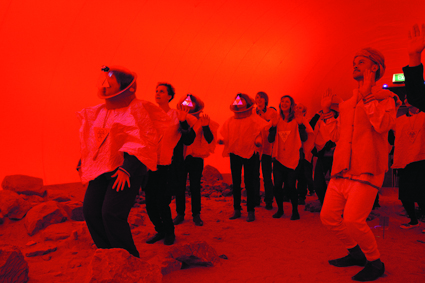
100 Proofs the Earth is Not a Globe, Tape Projects
photo Shea Bresnehan
100 Proofs the Earth is Not a Globe, Tape Projects
NEXT WAVE FESTIVAL IS RIGHTLY SEEN AS A MELTING POT WHERE YOUNG ARTISTS CHALLENGE TRADITIONAL CREATIVE APPROACHES AND METHODS OF PRESENTATION. THERE IS ALSO AN EXPECTATION THAT VISITORS WILL ACTIVELY CONTRIBUTE TO THIS DIALOGUE. ALTHOUGH THIS YEAR’S FESTIVAL CONTAINED NUMEROUS EXAMPLES OF EXHIBITIONS AND PERFORMANCES IN TRADITIONAL VENUES, MANY OTHER PROJECTS RELIED UPON NON-TRADITIONAL AUDIENCE ENGAGEMENT. THIS IS CHARACTERISTIC OF AN ORGANISATION THAT SUPPORTS YOUNG AND EMERGING ARTISTS, AND IT RESONATED PARTICULARLY WELL WITH THE THEME OF THE 2010 NEXT WAVE FESTIVAL, “NO RISK TOO GREAT,” ENCOURAGING NOT ONLY ARTISTS BUT ALSO VIEWERS TO STEP OUTSIDE THEIR COMFORT ZONES.
sunset over cardboard mountains
Sunset Over Cardboard Mountains, by artists Rachel Feery, Ed Gould and Lisa Stewart, proved a fitting beginning to my voyage through this year’s festival. While a number of Next Wave pieces broadly picked up on the idea that ‘risk taking’ is often the domain of youth, this work responded to the ways that children experience and negotiate the unknown, the scary and the risky through storytelling, role-playing and imagination.
An audience of 12, each member in their own individual cardboard box (cushions provided), sits inside a large tent-like structure. The lights go down, a live but unseen musical accompaniment begins and the tent fabric shakes, as if buffeted by a strong wind. From this point onwards the audience is treated to a low-fi performance of lighting, shadow and video effects which poignantly evoke common rites of passage. From confronting silhouetted ‘tree-monsters’ that appear during storms, to telling ghost stories by torchlight under bed sheets, to constructing fantastic machines and fortresses out of cardboard boxes and quilts, these childhood modes of play and initiation were all joyfully revisited by Sunset Over Cardboard Mountains in an immersive and often surprising performance.
100 proofs the earth is not a globe
The highly anticipated, ambitious 100 Proofs the Earth is Not a Globe from Melbourne-based collective Tape Projects did not disappoint. Tape Projects worked with the Victorian Space Science Education Centre at Strathmore Secondary College to develop 100 Proofs, shifting their artistic focus from visual arts projects towards a performative and experiential practice.
100 Proofs took viewers on a highly choreographed trip into a seamlessly constructed environment in which fantasy, fiction and alternate realities collided with rational and logical experience. The Space Science Education Centre was transformed each night into an otherworldly research facility, full of focused yet strangely attired inhabitants in a time warp. At the outset, the audience was divided into two groups (blue and red) and we were each assigned an alter ego. I became Raphael Constantinescu of the Personnel Department.
Being a member of the blue group, I was required to complete a number of pre-designated experiments. Armed with a lab coat and a clip-board Raphael Constantinescu was ushered through a series of tasks which included estimating the weight of a rock, sketching with a non-preferred hand, determining a ‘magic number’ through a series of calculations and observing and analysing the movements of a strange group of subjects (the red team). While the significance of these tasks was often unclear, in the context of the performance they took on a strange sense of urgency and purpose. By compelling the audience to act out roles as either scientists or subjects, 100 Proofs provided a thoroughly enjoyable and fascinating commentary on our understanding of scientific knowledge. As the work’s title implies, often our perceived reality is at odds with scientific truth. The minutiae and detail of scientific process and logic can obscure broader contexts and implications; science can go too far. At the same time, the imaginative possibilities of science are enticing and enthralling as science fiction rapidly turns into science fact.
evolution
Evolution by Safari Team (Blaine Cooper, Lillian O’Neil, Jon Oldmeadow) was yet another work inspired by scientific progress and imagined futures. By flagrantly opposing the supremacy of 19th century religious beliefs and institutions, Charles Darwin will forever be acknowledged as one of history’s greatest risk-takers, a figure whose ideas to this day remain controversial and passionately contested by the champions of Creationism and Intelligent Design.
A five-screen video installation, Evolution, located in ArtPlay in Birrarung Marr on the north bank of the River Yarra, responded to some of the ways that the general public are often introduced to and made familiar with scientific discoveries. The series of carefully composed images that repeated across the five screens seemed to be inspired by a warped view of natural history documentaries and science fiction films, mashed up into a dystopic vision of scientific endeavours.
I had high expectations for Evolution, but unfortunately it failed to live up to Safari Team’s delightful Molto Morte (2008), one of the highlights of the 2008 Next Wave Festival. Unlike 100 Proofs, which cleverly critiqued methods of scientific research and discovery, Evolution did not engage as strongly with the very real and fascinating contemporary dialogues around human evolutionary activity, such as the fact that humans can now actively control and dictate evolution through technological advances—evolution through ‘unnatural’ selection. The piece was certainly not narrative-based, however it needed a stronger overarching structure, or perhaps a soundtrack or some kind of aural accompaniment, to draw the compelling but disparate images into a more fluid conversation with each other.
Furthermore, the installation did little to enhance the artwork, making it appear too ambitious for an outdoor location. As well, time-based artworks are forever burdened with the necessity of having to engage viewers relatively quickly, and even then they don’t necessarily stay long. However, when the artwork is installed outdoors, after hours and during a festival that creeps into Melbourne Winter, the challenge is amplified.
doomsday vanitas
In this sense, Nicole Breedon’s Next Wave project, Doomsday Vanitas was a minimal but ultimately more successful example of a media artwork conceived for public space. Breedon projected hologram-like images of common objects onto buildings in Guildford Lane and surrounds. These were not complex images, yet as viewers discovered each successive projection amongst the alleys they were rewarded immediately, as the artworks’ simplicity and surprising beauty melded perfectly with their laneway environment. Rendered as gently rotating and glowing still-lifes, everyday items such as a water bottle, Swiss Army knife and an axe assumed an ominous quality within the urban environment, reflecting ongoing concerns to do with street violence and weapons culture.
film that will end in death
Perhaps the most literal exploration of the festival’s theme was Trevor Flinn’s Film that will end in Death. Based in Dunkeld in regional Victoria, Flinn identified and interviewed a number of people in ‘risky’ occupations—from lion taming and bull riding to wildlife rescue—questioning them about their relationship and attraction to risk. In the film, as in real life, Flinn has an endearing and engaging personality, which draws out candid admissions and stories from his interviewees. His dry sense of humour, wide-eyed enthusiasm and self-confessed ‘risk-averse’ personality make him the perfect foil for his subjects.
Interestingly, many of Flinn’s subjects spoke about their rather dangerous pastimes and jobs not so much in terms of ‘thrill-seeking’ impulses, but rather as almost normal activities in which inherent risks needed to be understood, mitigated and minimised. The hilariously blasé lion tamer Matthew Ezekial said that after a while “it’s just a job.” This matter-of-fact sentiment was reflected in the traditional documentary construction of Flinn’s film. It was a welcome and memorable interlude in a festival which, while always encouraging the provocative and the novel, also allows a space for audiences to engage with personal modes of storytelling and presentation.
2010 Next Wave Festival: Sunset Over Cardboard Mountains, Rachel Feery, Ed Gould, Lisa Stewart, Studio 246, May 14-21; Tape Projects, 100 Proofs the Earth is Not a Globe, Lee Anantawat, Cait Foran, Eugenia Lim, Tanja Milbourne, Michael Prior, Zoe Scoglio, Jessie Scott, Victorian Space Science Education Centre, May 19-28; Safari Team, Evolution, Blaine Cooper, Lillian O’Neil, Jon Oldmeadow, Birrarung Marr, May 13-30; Doomsday Vanitas, Nicole Breedon, various locations, May 13-30; Film that will end in Death, Trevor Flinn, Kings ARI, May 8-31
RealTime issue #98 Aug-Sept 2010 pg. 41
© Kate Warren; for permission to reproduce apply to realtime@realtimearts.net
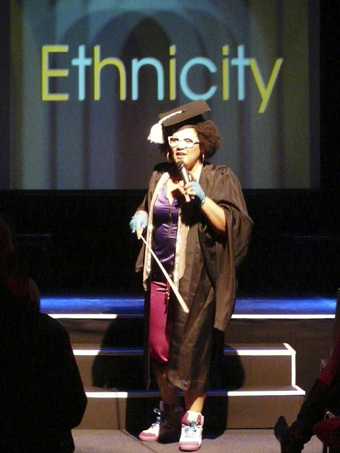
Candy Bowers, Who’s That Chik?, performing at National Multicultural Arts Symposium 2010
photo Andrew Dundon
Candy Bowers, Who’s That Chik?, performing at National Multicultural Arts Symposium 2010
CULTURALLY DIVERSE ART IS INSPIRING, INNOVATIVE AND MARKETABLE—AND IT NEEDS YOUR SUPPORT. THIS WAS THE CLEAR MESSAGE AT A RECENT GATHERING OF CULTURALLY DIVERSE PRACTITIONERS, EACH LEADING CONTEMPORARY ARTS PRACTICE ACROSS A RANGE OF ARTFORMS AND SPECIALISATIONS.
And yet that clear message is not so straightforward: needing your support means overcoming those persistent barriers that have confronted culturally diverse arts for decades. Identity, funding, leadership and the politicisation of its very vocabulary remain ongoing problems. All the while, the work becomes ever more sophisticated, attracts new audiences and tours internationally, joining that increasing array of Australian innovation that enjoys more brilliant accolades overseas than at home—or on our mainstages. So what’s still at issue? And how can cultural diversity lead contemporary Australian arts with widespread recognition?
Held in Adelaide and presented by Nexus Multicultural Arts with Kultour, the National Multicultural Arts Symposium was preceded by two days of performances and exhibitions, with Candy Bowers’ provocative Who’s That Chik? setting the tone (“a hip hop tale of a brown girl with big dreams”; http://whosthatchik.com). Culturally diverse artists framed the symposium, with the work and the practitioners speaking for themselves. This too was questioned at the outset: Who speaks? Who names? Need every artist and every work represent an entire community?
Names and their political appropriation have long confused the Australian community, and frustrated the practitioners whose work they label. Christian (Bong) Ramilo, Executive Director of Darwin Community Arts, saw little progress across two decades of advocating access, equity and representation. For Mirna Heruc, Manager of the Arts & Heritage Collections at the University of Adelaide (and former CEO of Nexus), “Sometimes labels have marginalised us, sometimes they’ve brought us to the centre, but nothing has changed.” Political decisions have seen successive governments adopt—and often, quietly reject—terms such as ethnic, multicultural, Aboriginal, Indigenous, cross-cultural, Community Cultural Development (CCD), disability, all abilities, Culturally and Linguistically Diverse (CALD), Non-English Speaking Background (NESB), diverse, culturally diverse, and even culture itself.
When these shifting terms translate into shifts in policy, culturally diverse practitioners are—like it or not—drawn into their politics, needing to identify with the current language to achieve recognition or secure financial support. For Heruc, the best approach to these names is to reject them entirely; multicultural arts organisations should facilitate pathways into the mainstream, presenting work without any framing label. “Our job is really to get rid of this multiculturalism business, and just focus on the arts.” She adds, however, “We’re not close to achieving this.”
Independent producer Kath Papas, former director of Ausdance Victoria, distinguished between three kinds of diversity that focus her practice: form, content and philosophy. This approach overcomes the fraught cultural labels, opening diversity itself to a space beyond othering. Papas made particular mention of disability arts as informing her practice. “There’s a lack of engagement from the dance mainstream,” she says, and while there’s plenty of talented culturally diverse artists, “who’s going to take them on?” Papas identified flexible infrastructure, networking and skilling up as key issues. Without these essentials, “we lose those artists because they get too tired—you can’t self-produce forever.”
Not all artists make a conscious choice to self-produce, while for others the torch-bearing work of speaking for an entire community is central to the art. Khaled Sabsabi, visual artist and Creative Producer at Casula Powerhouse, saw no distinction between CCD and his own artistic practice. Karl Telfer, Kaurna Cultural Bearer and visual artist, described reconciliation as the driver of all of his work. Such practice is never about aligning itself to funding categories. As Sabsabi put it, “Art leadership is a resistance against the way things are.”
Many speakers lamented the rise and fall of leadership organisations; touring and advocacy body Kultour remains the only national multicultural organisation. Yet all speakers agreed that leadership is about the work itself, and its articulation into the community. Bowers spoke passionately about a new space in which diverse artists see themselves represented in the faces as well as the programming of mainstream arts organisations. “Beyond being ‘championed,’ or ‘helped,’ we want to be paid for being artists. We want the resources, we want the recognition.”
So, how do you position yourself in the culturally diverse arts? Head on. In fact, it’s a proven strategy. Karen Bryant, Associate Director of the Adelaide Festival Centre, presented a powerful argument for diversity as a strategy towards financial sustainability and artistic success. “We’re no longer a series of buildings,” says Bryant, “we’re a facilitator—which means asking, and then re-evaluating.” Direct engagement is essential: programming is developed in close consultation with emerging and established communities. In this way, the Centre overcame its empty seats and its venue-for-hire image. The results are inspiring: a 33% increase in audiences in its first year, and 25% in the second.
Similarly, Adelaide Fringe’s 2011 Director, Greg Clarke, aims at international recognition as a culturally diverse festival by 2020. Clarke sees this as an artistic as well as a commercial strategy for engaging with a majority of Australians. With a strong record in culturally diverse policy as well as programming, Clarke says the Fringe has prioritised diversity quite simply “because it was mind-blowing.”
Communications consultant and editor Fotis Kapetopoulos’ statistics demonstrated just how marketable culturally diverse art is—both at home and overseas. “Our mainstream companies are caught up producing the same styles, but what we’re talking about is international.” Aaron Seeto agrees: “Internationally, diversity is our point of difference.” Seeto, Director of artist-run space Gallery 4A: Centre for Contemporary Asian Art in Sydney’s Chinatown, described the contemporary visual arts museum as “a self-replicating machine, a safe-house,” while contemporary culturally diverse work is “feeding into the international arena.”
Rather than engaging with and supporting this work, our own governments prefer to stick to the known. The major mass-marketing campaign in culturally diverse Victoria is Melbourne Winter Masterpieces, a showcase of well-known European artists from previous centuries. Kapetopoulos described the end of Sydney’s Carnivale as a cynical stroke: it was defunded by the NSW government at its peak demand and sustainability point because its audiences “had started to look too mainstream—it didn’t look like an ethnic festival.” Such ironies were not lost on a gathering of practitioners accustomed to being ‘othered.’
On the other hand, some mainstream arts organisations experiencing significant audience loss have been receiving funding boosts in recent years. Emphasising this particular irony, Opera Australia’s Artistic Director Lyndon Terracini used his morning keynote to ask the funding bodies in the room to “empower” his organisation through a funding increase. Opera Australia currently receives as much Australia Council funding as the other 900+ funded organisations and projects combined. Terracini, founder of Kultour member, Northern Rivers Performing Arts (NORPA) in Lismore NSW, spoke of new Indigenous and Asian initiatives: “I don’t want to play to an elite audience—I’ve never wanted that.”
With all speakers projecting a future Australia of increasing diversity, governments will need to direct subsidies to culturally relevant work that’s artistically exciting as well as economically sustainable. The undeniable reality of Australian multiculturalism as always already mainstream can no longer be avoided; changing labels simply exposes a political reluctance to accept that diversity will not remain ‘othered.’
Fundamentally, such barriers aren’t specific to the arts. They’re generational; they’re administrative; they’re political. Ironically, they’re cultural—in the word’s corporate meaning, describing entrenched practices in establishment organisations. Culturally diverse art is ready to lead contemporary Australian practice, further developing audiences here and overseas.
Candy Bowers knows it. “How can cultural diversity lead the Australian arts?—Get out of my way.”
National Multicultural Arts Symposium 2010, ?Diversity in the Arts: Theory + Action, May?19-21, 2010, presenter Nexus Multicultural Arts in partnership with Kultour
RealTime issue #98 Aug-Sept 2010 pg. 42
© Esther Anatolitis; for permission to reproduce apply to realtime@realtimearts.net
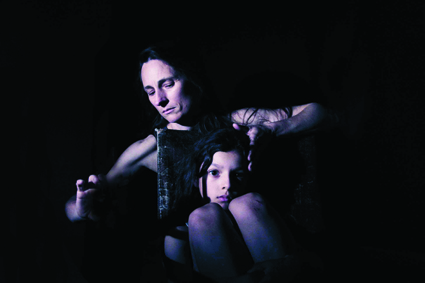
Deborah Kayser, Tomas Tsiavos, Exile
photo Daisy Noyes
Deborah Kayser, Tomas Tsiavos, Exile
“THE CREATIVE PROCESS IS QUITE LIKE OP-SHOPPING,” ARTISTIC DIRECTOR OF CHAMBER MADE OPERA DAVID YOUNG REMARKED TO ME BEFORE THE PREMIERE PERFORMANCE OF HELEN GIFFORD’S OPERA EXILE, “BECAUSE YOU CAN AFFORD TO TAKE RISKS.” AS WITH ALL RISKS THERE ARE STAKES TO BE WON OR LOST IN WHAT IS POSSIBLY THE WORLD’S FIRST OPERA PRODUCED FOR THE IPAD.
Using the familiar op-shopping strategies of combination and alteration, Euripides’ play Iphigenia in Tauris is rewritten, the history of Victoria’s Point Nepean on the Mornington Peninsula is revisited through the lens of gaming technologies and chamber opera is presented on a new platform. The outcomes of the project will not be known until its release and screening at ACMI in November. In the meantime the project’s collaborators from Australian new music organisations Aphids, Chamber Made Opera, Speak Percussion and Amsterdam-based media artists Champagne Valentine will be negotiating multiple priorities and balancing innovation with technical limitation.
Exile has lain dormant since its composition by Gifford as Iphigenia in Exile with the librettist Richard Meredith in 1985. The opera’s recent rediscovery by David Young prompted some closet archaeology by Gifford, uncovering reel-to-reel recordings of a women’s chorus recorded in a Kew apartment in 1986, an autoharp part recorded in 1989 in an old post office and a mandolin through which Gifford attempted to reimagine the timbres of Ancient Greek music. Gifford has not tried to faithfully reconstruct the music of Ancient Greece, but to rediscover it creatively: “People like to think that they can get an idea of Ancient Greek music from decoding carvings and etchings. That’s nonsense. You get more of an idea from listening to modern Greek music of a Demotic order. The timbres, the rhythms; I don’t think those things change so much over 2000 years. Though,” Gifford adds, “my music sounds nothing like Greek music today.” The artefacts were incorporated into the opera’s recent recording at the ABC’s Iwaki Auditorium that will serve for both a radio broadcast and the iPad application’s soundtrack.
The application will also be available for download on iPhone, prompting the question of the iPad’s significance to the work. “They remind me of Speak and Spells,” Aphids Executive Producer Thea Baumann admits, though Anita Fontaine of Champagne Valentine considers the large, higher resolution screen “a nice addition which contributes to the experiences we will create.” With Baumann flagging the “data-heavy layers of moving image” common to Anita Fontaine’s work, there is justifiable concern about the “limited processing power and lack of Flash support” that the iPad inherits from the iPhone. But Fontaine is confident in the project’s ability to overcome these limitations as “these kinds of challenges and constraints are something Champagne Valentine is accustomed to when developing bespoke interactive experiences.”
Rather than processing speed, the iPad’s audio may be the main obstacle to successfully mounting the opera on the platform. The multi-purpose ABC recording will reach Champagne Valentine in the form of a highly compressed stereo mix, making user-controlled manipulation of the composition’s parts, as in the company’s GPS controlled interactive musical game for the Tate Modern, more difficult to implement. Working closely with Champagne Valentine, Baumann anticipates that “one of the main challenges will be to make the audio just as luscious as the video.”
The video component of the work, filmed in consultation with Parks Victoria, engages with the natural environment and rich history of Point Nepean to reflect and comment on the themes of longing, claustrophobia and isolation in Gifford’s opera. Both visually and historically Baumann sees the landscape as “woven with paranoia and isolation,” likening the tone of Exile to the psychologically loaded game spaces of Quake and Half-Life first-person shooters. Baumann hopes to explore this likeness in Fort Nepean’s labyrinthine tunnel system: “The tunnels have a Greek architectural symbolism, simultaneously connoting the Minotaur’s labyrinth and gaming architectures.” By way of visual and aural analogy the southern Australian coastline’s sombre palette, eroded forms and bitter winds provide a desolate backdrop to Gifford’s aural palette, coloured with sparse mandolin, clarinets, clay flute and percussion.
Point Nepean has been the site of Victoria’s main quarantine station 1852–1980, Prime Minister Harold Holt’s disappearance and presumed drowning in 1967 and accommodation for Kosovar refugees in 1999. The area’s legacy of isolation draws Gifford and Meredith’s psychological portrait of Iphigenia into Australia’s grim colonial and immigration history. The protagonist is powerfully realised by soprano Deborah Kayser as she contemplates her effective exile from Greece to the role of high priestess at the temple of Artemis in Tauris (Crimea). Vilified by the townsfolk and wracked by self-loathing, “she feels as though she has been tricked into performing the duties of the high priestess: anointing shipwrecked sailors before sacrifice, or in the case of the high-born, cutting their throats herself,” Gifford explains. Iphigenia is left in her unenviable position after being saved from sacrifice at her father’s hand by the goddess Artemis in Aulis. In Euripides’ play Iphigenia’s brother Orestes is brought to her for sacrifice in Tauris, where they escape with the help of the goddess Athena. Gifford describes the serendipity and divine intervention in Euripides’ play as “cheating,” placing Iphigenia beyond the reach of Ancient Greece’s fickle gods, at the mercy of the Taurians and her memories. “Euripides’ play is a bit like a soap opera,” Gifford laughs, “he had to have a happy ending. But there were thousands of temples in the area, and those that did have human sacrifices needed priests and priestesses.” Drawn by the mournful song of a migrating seabird from her homeland (rendered on clay flute), Iphigenia walks on, or into, the ocean at the opera’s conclusion. “Whereas the poor soul fantasises walking with Orestes over the water, she is really, I think we can agree, walking under it.”
Exile shows us a world of Ancient Greek myth without gods. The secularised portrait of Iphigenia is made profoundly sympathetic at the expense of its dramatic context, turning Euripides’ melodrama into a personal tragedy. The composition should be given a renewed and poignant context in Point Nepean, where history may come into a creative synthesis with the possibilities of computer game narratives and technologies. The opera’s successful implementation on iPad, as on its other intended platforms, hinges largely upon Aphids and Champagne Valentine turning the opera’s recording from ABC’s Iwaki Auditorium and video component into an engaging interactive music video.
Exile, composer Helen Gifford, soprano Deborah Kayser, co-producers Aphids, Chamber Made Opera; studio recording, Iwaki Auditorium, ABC Southbank Centre, Melbourne, June 22
RealTime issue #98 Aug-Sept 2010 pg. 43
© Matthew Lorenzon; for permission to reproduce apply to realtime@realtimearts.net
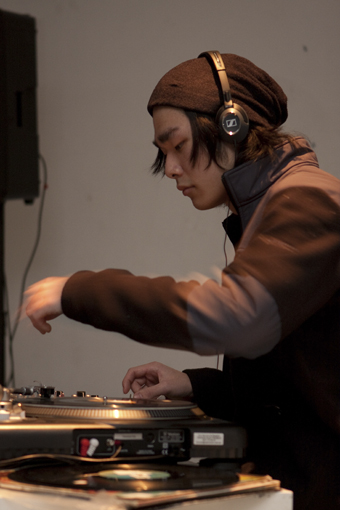
Jordan Dorjee performing at Refraction June 29, 2010 (co-curated with New Weird Australia)
photo Marnie Vaughn – see image note*
Jordan Dorjee performing at Refraction June 29, 2010 (co-curated with New Weird Australia)
THERE IS A RICH HISTORY IN AUSTRALIA OF VIBRANT AND GROUNDBREAKING HIGHER EDUCATION PROGRAMS THAT OFFER AN ALTERNATIVE TO THE MORE TRADITIONAL CONSERVATOIRE EDUCATION FOR YOUNG ARTISTS AND MUSICIANS. EXAMPLES INCLUDE THE LATROBE UNIVERSITY MUSIC PROGRAM THAT STARTED IN THE 1970S, THE FORMER DEGREE IN MUSIC AND ELECTRONIC ARTS AT THE UNIVERSITY OF WESTERN SYDNEY, CURRENT PROGRAMS SUCH AS RMIT AND QUT’S CREATIVE INDUSTRIES, WAAPA’S BACHELOR OF MUSIC TECHNOLOGY AND THE NEW UTS BACHELOR OF SOUND AND MUSIC DESIGN. OVER THE YEARS JULIAN KNOWLES (QUT) HAS BEEN INVOLVED WITH A NUMBER OF THESE UNIVERSITIES AND ARGUES THAT “THESE PROGRAMS HAVE BEEN CRITICAL TO BUILDING THE CULTURE AROUND EXPERIMENTAL MUSIC IN AUSTRALIA FOR 30-40 YEARS” BECAUSE THEY HAVE TRAINED PRACTITIONERS AND DEVELOPED NEW AUDIENCES.
Knowles explains that “those of us teaching in university programs in the 1990s were very active as practitioners in the scene and we brought students into contact with the network of festivals such as What is Music? and Liquid Architecture and the warehouse gigs that were happening in the more underground artist run spaces..[and we] brought practitioners from this scene back into the university by offering casual teaching appointments.” Indeed, it seems that the most successful educational programs in Australia have always involved engagement with the wider community, a feature of the La Trobe Music course, UWS and most recently RMIT. Articulating perfectly such an approach, which seems relatively common in Australia, Philip Samartzis (RMIT) claims that “the role of an institution is to facilitate opportunity and development by introducing students to an expansive range of ideas and practices that afford a greater appreciation of sound culture.”
Despite their success and involvement with the wider experimental music and sonic arts community in Australia such programs are often regarded as expensive and relatively niche and so have frequently been at risk. Knowles explains that “the 1970s was particularly active. There was some fallback in the late 80s and early 90s, then a significant increase in offerings from the mid 1990s onwards.” Still it is only a few years ago that the widely admired UWS Electronic Arts program was shut down and academics and students alike know they can’t be complacent about the future. Cat Hope (WAAPA) says that “there is not a good feeling amongst academics in Australia” because, while the area is vibrant and active within universities, constant instability and demanding teaching loads have the potential to effect the quality of the teaching offered.
Apart from concern about the future, issues currently of interest in experimental music and sound art include the increasing numbers of artists and musicians taking up PhD and DCA places, the focus of students on career pathways and the centrality of research to university funding models and activities.
paperwork
It is widely speculated that there has been an increasing number of artists and musicians taking up PhD and DCA places in the last few years but it is unclear what effect it will have on the development of experimental music and sonic art culture in Australia. Kirsty Beilharz (UTS) comments that “there has definitely been an increase in composers pursuing higher degrees which may be due to various conditions, such as the almost requisite PhD for academic employment, and returning to studies in the current economic climate, but also positive factors such as the increasing recognition and understanding of creative practice as research or as being significantly rounded by research.” Analysing this trend, Cat Hope thinks that the increase in PhD and DCA study among artists and musicians “will result in better articulation of artists’ ideas since some sort of record of arts practice has been absent from the experimental music scene for over 30 years.” She argues that “perhaps experimental music has more academic credentials now than before.”
exploration & employment
Despite the increase in numbers taking up research places, students on the whole seem to have an increasing focus on career pathways. Philip Samartzis believes “that institutions are now so invested in postgraduate research, students are generally thinking beyond their undergraduate program in order to develop strategies that will assist them upon graduation…For some this may lead to further education, but for many the ultimate goal is to practise as an independent artist.” Consequently, “it is incumbent upon program leaders and lecturers to ensure that students are provided with as much workplace integrated learning as possible so that students establish and grow their practice whilst at the institution.” Addressing this issue, Julian Knowles suggests that while it is clear that students have become more focused on their career pathways in the last 10-15 years, a really good program can meet such needs as well as satisfy students more interested in exploration. He says that he struggles with the ‘nostalgic’ notion of ‘the liberal arts education as an end in itself.’ “Being interested in the experimental arts does not mean that a student has no desire to work in a relevant field and it does not mean that academics can ignore or absolve themselves of the responsibility to help people establish viable practices.” Instead he claims it has been his experience that “many graduates from these programs have developed production skills in audio which have served them very well from an employment perspective.”
the research economy
Perhaps the most notable shift in tertiary education in Australia in recent years has been the increased emphasis on research in universities. The Federal Government has made a significant amount of funding dependent on each university’s research output. Understandably this has increased the focus of the institutions on research but beyond that it has made the issue of defining just what counts as research more crucial than ever and this is a problem for experimental music and the sonic arts in universities. Knowles explains that “the real issue is that the research assessment process does not easily recognise the sites for output or activity in the experimental music scene” because “major sites for experimental music research and output—artist-run spaces—are not considered ‘serious’ in the national assessment process, despite the fact that they host top national and international practitioners.” But he believes that, fundamentally, “there are fairly marked cultural and ideological differences between the most underground experimental musics and the institutionalised research economy.”
Samartzis feels that “the emphasis on research however has somewhat devalued undergraduate learning and teaching as more resources are directed to the post-graduate sector.” However, while he believes that “the undergraduate sector provides the biggest contribution towards the general development and wellbeing of sound culture, postgraduate research does offer the artist an opportunity to develop intellectual rigour whilst investigating rarefied areas of knowledge and practice.” Significantly, he points out that “the institutional model of research often results in an invaluable contribution to the field but it is no more important than less formal modes of practice and research generated by independent artists with no institutional affiliation.”
The focus on research that dominates the tertiary sector, the increased number of artists studying towards PhDs and the increased vocational focus of students, raises important questions for experimental music and the sonic arts. How can universities maintain strong undergraduate programs while increasing their research output? How can they develop programs that encourage students to be exploratory and still offer strong career opportunities? What effect will an increased number of research students have on the experimental music and sonic arts community in Australia?
In the meantime there is undoubtedly a great deal of activity in the tertiary education sector, reflecting the strength of the field in Australia. Indeed the most successful experimental music and sonic arts programs in Australia’s universities appear to be those that generate and facilitate activity in the wider community while meeting the needs of students and supporting the work of staff. Although a number of highly regarded experimental music and sonic arts programs have been shut down over the years there are still a significant number of respected courses on offer in this country, such as those at RMIT, QUT and WAAPA, and the launch this year of a new program at UTS demonstrates that even in the current climate of economic rationalisation such programs can not only survive but thrive.
*Image note: Jordan Dorjee is a BA student in Sound and Music Design at UTS. Refraction is a semi regular media art, music and sound event run by the UTS Sound collective “dedicated to the support, mentorship and development of student projects as they take their practice from the classroom to the community.” (Emily McDaniels, Refraction coordinator)
RealTime issue #98 Aug-Sept 2010 pg. 44
© Ben Byrne; for permission to reproduce apply to realtime@realtimearts.net
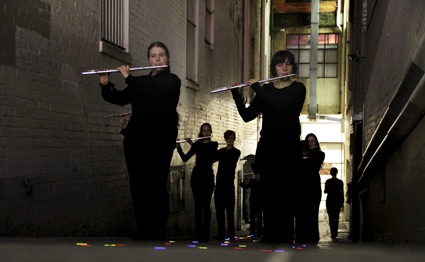
Super Critical Mass – Sub Mass 4, Burnett Lane
photo Lawrence English
Super Critical Mass – Sub Mass 4, Burnett Lane
BRISBANE’S ALBERT STREET MALL CUTS BURNETT LANE INTO A LONG END AND A SHORT END. THE SHORT END OF BURNETT LANE SLOPES DOWN BETWEEN A 7-ELEVEN AND A DUTY FREE, TO FINISH AT A CARPARK. THIS IS THE PUBLIC SPACE FOR SUB MASS 4, PART OF LIQUID ARCHITECTURE II—BUT IT’S BEEN PRIVATISED FOR THE NIGHT WITH A SEMI-CIRCLE OF SMALL BATTERY-POWERED FOOTLIGHTS PLACED AROUND THE ENTRANCE AND A COUPLE OF OH&S WITCHES’ HATS EITHER SIDE IN CASE PEOPLE DON’T REALISE THE DANGER FLAUTISTS PRESENT.
There’s a goodly crowd clustering around, waiting for the start. Four flautists emerge from the left hand side of a building at the bottom and start to walk slowly up the lane toward the crowd. They’re playing a soft drone and, as they move up the alley toward us, another group of four emerge from below, then another and another, until the alley is filled. When a row reaches the top they stop, turn, and walk down to the bottom to begin again. It’s a stately processional conveyor belt of flautists, pitch rising as they get closer and closer to the audience. Over 30 minutes the drone slowly breaks down to puffed bursts, then to a swinging gate effect as the pitches move from one group to another—a swinging sync that peters out, gets a pulse, peters out again.
It’s a beautiful piece, but there’s a problem. Late night shopping and the onset of dusk sees the Brisbane Mall a lively place. Seated on a platform, not a few steps away, a terribly sad woman strums an acoustic guitar and sings a dismal song about how one is often unaware of the value of what one has until it is gone. Further up the mall a retailer shares their enjoyment of jug band music with the public at large. So you can barely hear the performance. And you can’t see much of it either because of the narrow alley and the people clustered around trying to get best pozzie for whatever it is that everyone else is struggling to get best pozzie on.
The publicity blurb goes “As a listener you are invited to walk through the space or simply sit within the evolving sound-fields…This performance event, Sub Mass 4, draws you into the depths of Burnett Lane…” But it doesn’t and that’s a shame because if we had been allowed into the alley way and the space of the performers Sub Mass 4 would have been a great experience. On the other hand that’s fine because Sub Mass 4 is part of an exploratory/experimental program by the composers and the next night they perform the same piece in a very different setting where the audience and performers intermingled (which I missed, but apparently it worked a treat). I love this investigative approach to working—it seems a great addition to the take-it-or-leave-it model of art production as ‘revelation.’
Across the mall and down to the long end of Burnett Lane, runs Insitu: Sonore, sound installations for a few weeks in June, another Liquid Architecture 11 work. The long end is filled with trucks, bins, the arse end of shops selling Vietnamese koalas and plastic rulers covered with photos of Great Barrier Reef attractions or inset with the seven timbers of Australia.
And somewhere amongst all this is the sound of Janek Schaefer’s National Portrait. (Schaefer is the person who posted a voice activated dictaphone around Britain, picking up the stray utterances of various mail handlers.) I wander up the lane. I wander down, I wander up and down again. I hear the trucks, the air-conditioning ducts. It’s a great sounding lane. But no Schaefer. I ask upstairs at a newish art/design collective (Glow32) and they point to a little box above an awning. I go down and hang around trying to invoke the cocktail party effect that lets you hear your name whispered from the other side of a crowded room. Primed for Schaefer, primed for Schaefer—nup, nothing, a faint hint of a conversation maybe, then more nothing. This installation is way too quiet. Undeterred (well, a tad deterred) I come back a couple more times for more of the same.
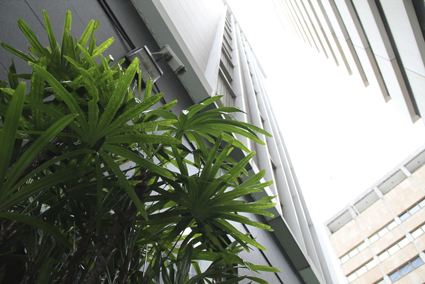
Inhabit Fiesta: Urban Jungle, Eagle Lane
photo Lawrence English
Inhabit Fiesta: Urban Jungle, Eagle Lane
Ah well, off to another lane for another sound installation, Urban Jungle, part of the Inhabit Fiesta Festival, where works by Chris Watson, Lawrence English and James Webb are up for the next few weeks. This is more the Brisbane I know, modern high rise, no street life at all. At one end the lane pokes between two buildings to make a smallish aperture onto the rest of the city. This bit is closed off to cars, and Lawrence English has arranged a small, slightly tacky, setup of fake grass on the ground, shrubs potted and plopped along the sides. Looks like a temporary beer garden. The wind shoots through the space, rustling the leaves—suitably ear-height through the choice of shrub. The movement of leaves as a signal of changes in the air. A pleasure of sound at multiple scales. A message from another, biological, world. Contrast with the usual background city rumble: acquired deafness, slightly elevated blood pressure.
At the other end of the lane there’s a building on the right with grilled-over holes cut into the first floor. The entire building surface is articulated with bursts of white noise. It’s like being in a forest when bell-birds sing out and you hear space activated through sound. This time it is the reflective surface of a building, flat and high up, whose distance and shape is perfectly realised through the time it takes for sound to reach the ear. I can’t remember enjoying a public sound work more, but no sign saying whose work it is. Because it isn’t anyone’s—this is just how the space sounds without any intervention at all. What a find—whilst listening for soundworks I’ve been taking a soundwalk instead.
Liquid Architecture 11, artistic director Nat Bates, Brisbane curator Lawrence English; Sub Mass 4, Julian Day, Luke Jaaniste, Janet McKay, June 25; Insitu: Sonore, Janek Schaefer, Leighton Craig, DJ Olive, Brisbane, June 11-27
Inhabit Fiesta: Urban Jungle, Lawrence English, Chris Watson, James Webb, Brisbane June 11-27
RealTime issue #98 Aug-Sept 2010 pg. 46
© Greg Hooper; for permission to reproduce apply to realtime@realtimearts.net
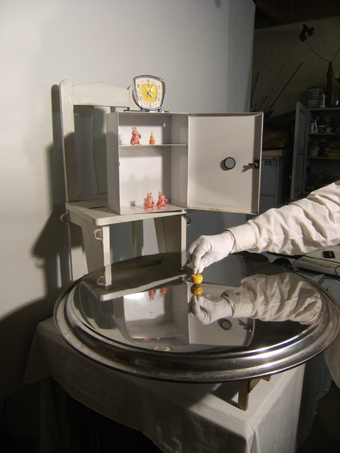
Tin Rabbit’s Life Chance, Ros Bandt, part of Constellation: A Durational Chamber Work
photo Ros Bandt
Tin Rabbit’s Life Chance, Ros Bandt, part of Constellation: A Durational Chamber Work
TWO EVENTS AT THIS YEAR’S LIQUID ARCHITECTURE SUGGEST THAT THE FESTIVAL IS MOVING IN A NEW DIRECTION. A CENTRAL THEME IN BOTH CONSTELLATION: A DURATION CHAMBER WORK AND CONCERT II WAS THE RELATIONSHIP BETWEEN SOUND ART AND PERFORMANCE, EITHER AS RADICALLY DISCRETE OR THEATRICALLY INTEGRATED.
Concert II was held at the 3RRR performance space, a new venue for Liquid Architecture. The studio is a Melbourne institution and an important platform for non-mainstream music and culture. In this concert, duo Lionel Marchetti (France) and Yoko Higashi (Japan) integrated sound art and performance in a most striking way. Producing various forms of feedback, covering extremities in volume and high and low frequencies, musique concrète composer Marchetti sustained an intense atmosphere.
In white body paint and wearing a kimono, Yoko Higashi accompanied Marchetti, performing Butoh inspired movement. Her dark demeanor and contorted gestures provided a backdrop to the centrally located Marchetti. These different modes of performance gradually became literally entangled as Higashi climbed onto the shoulders of Marchetti, who continued unperturbed as his role in the dramaturgy of the performance shifted.
Higashi also crossed over into the realm of sound art, picking up a microphone and speaking softly into it. Twirled around, it thumped loudly as it banged against her body. This wild and almost dangerous gesture complemented the dramatic and violent energy of the music beautifully. Overall, the theatricality and musical content of this performance worked together well to create a thrilling atmosphere.
Opening the program with a far more understated approach, Perth based ensemble Decibel performed three works by Alvin Lucier. Each of these explores the sonic possibilities created by sine tones as they come into physical contact with objects or sounds in space (see also RT97).
Performed by flautist and ensemble director Cat Hope, Still and Moving Lines of Silence in Families of Hyperbolas requires the performer to play a series of sustained notes, moving in microtonal increments. In this extremely stark work the imperfections of the flute were exposed against the purity of two sine tones. However the essence of this piece is the way these frequencies clash in the space to cause ‘beating’ patterns. This created rich sonorities in the dry acoustic of 3RRR’s performance space.
The next work, Music for Snare Drum, Pure Wave Oscillator and One or More Reflective Surfaces, was an exercise in sympathetic resonance. As a sine tone gradually descended in pitch, the snares of a drum and the resonant frequency of the drum itself, were made to sound, causing a further range of sound complexes to occur and interact.
As in the opening work, in Lindsay Vickery’s performance of In Memoriam Jon Higgins a series of sustained tones on the clarinet were exposed against the comparative purity of the sine tone. The effect was accentuated further by what sounded like a small amount of spittle in Vickery’s throat or the mouthpiece.
The extreme starkness of these pieces invited a contemplative mode of listening. None evolved beyond very limited parameters, which were revealed in their entirety in the first few moments. Rather than articulating events over time, Lucier invites the audience to bear witness to acoustic phenomena. This was reflected in Decibel’s equally stark performance mode, in which the dramaturgy was inherent in the sounds themselves rather than the performers’ actions.
Following the restrictive conceptual scores of Lucier was a far more visceral and spontaneous approach to performance. 12 Dog Cycle, comprising Alice Hui-Sheng (Taiwan) and Nigel Brown (Australia), gave what felt to be a largely improvised performance. Using a piano accordion and effects processing to produce a texture of drones, Brown essentially provided a vehicle and framework for Hui-Sheng’s vocal performance. Hui-Sheng demonstrated a remarkable repertoire of extended techniques, moving between moments of intricate, breathy subtlety, to almost grating loud tremolos and shrieks.
A restrained approach to materials enabled this duo to build to passages of convincing intensity. In a performance which meticulously took its time to develop, these moments held the greatest impact.
Another event on Liquid Architecture’s program exploring an intersection between sound art and performance was Constellation: A Durational Chamber Work. Curated by Madeleine Flynn and Tim Humphrey, this exhibition explored the notion of a musical work outside the confines of performance. Eleven composers were invited to submit works based on the theme of the Zodiac. The title refers not only to the Zodiac, but also to the way the eleven works co-existed in an interconnected web.
Empty seats and music stands were arranged around the gallery space, mostly in pairs upon small podiums. Each seat represented a composer and members of the audience were invited to sit, triggering a recording of the composer’s work. Accompanying each piece was an artifact. In many cases this was a notated score, however this was not necessarily the rule. Videos, installations and instruments were also used to create a physical presence for the musical work. Not only an exhibition, this event also featured daily performance “interruptions” in which all the works were heard.
One of the strengths of this exhibition is its representation of diverse composition practices. Ros Bandt’s Tin Rabbit’s Life Chance is a strikingly original work, blurring the line between artifact and performance. In this interactive sound installation the participant is instructed to put on white gloves and spin a top on a large metal plate. These actions are part of a small ritual, culminating in a back-flipping contest between three wind-up toy rabbits.
Rat Tea Ceremony by Anita Hustas is an improvised musical work with a theatrical framework. Musicians are invited to partake in a tea ceremony with fortune cookies. The message within the cookie is used as a catalyst for improvisation, providing a clear indication of how the piece will unfold dramatically, however they also reveal that the musical content is extremely variable. There is a recording of this work as part of the exhibition, however as the piece is to be performed by two, six or 10 players on any instrument they wish, this is only one rendition of a work that may take on vastly different guises.
Carolyn Connors’ work, RatOxTigerRabbitDragonSnakeHorseGoatMonkeyRoosterDogPig, also offers a framework for improvisation, in this case for two-12 performers. However, rather than being concerned with the creation of a theatrical setting, the signs of the Zodiac are used as a starting point for improvisation. Robin Fox’s Melanoma Study # 1, a framework for improvisation for EWI (electronic wind instrument) and any keyboard instrument, features a Max/MSP patch for the EWI and pitch modules to be performed on the keyboard instrument. In each of these works, it is interesting for the audience to become acquainted with aspects of the work that would normally only be revealed to the performer.
David Young’s Esaurita (Breakdown) also has aspects which are left to the performer’s discretion, however there is far greater detail in the work’s structure, an original form of notation using an old constellation map. Moving vertical lines on a video score indicate when performers are to play. Composed for flugelhorn and “slightly” prepared piano, the notation does not indicate exact pitch, however it does indicate the rhythmic placement of notes with even greater precision than traditional notation, making this work an extremely successful exercise in control and indeterminacy.
Although the works in Constellation were performed from time to time, aptly as “interruptions,” the exhibition successfully presented its commissioned compositions as artifacts which were encountered by the audience outside of the usual performance context.
Liquid Architecture 11, artistic director Nat Bates; Concert II, 3RRR, July 2; Constellation, a durational chamber work, curators Madeleine Flynn, Tim Humphrey; Red Gallery, Melbourne, July 1-17
RealTime issue #98 Aug-Sept 2010 pg. 47
© Simon Charles; for permission to reproduce apply to realtime@realtimearts.net
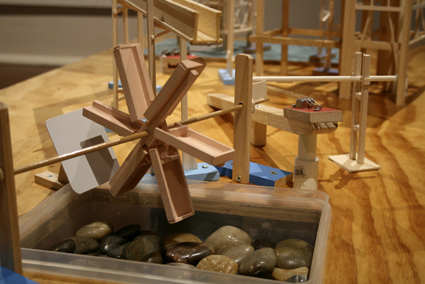
END (Ice Cold Drinks) detail of installation, Andrew Varano
see image note*
END (Ice Cold Drinks) detail of installation, Andrew Varano
BEING AN ARTIST DOES NOT REQUIRE ANY PARTICULAR QUALIFICATION. UNLIKE ACCOUNTING, LAW, MEDICINE OR ARCHITECTURE, WHICH REQUIRE SPECIFIC TRAINING, QUALIFICATIONS AND ACCREDITATION, TO BECOME AN ARTIST YOU JUST HAVE TO ESTABLISH A PRACTICE. BUT AS A RESULT OF THIS, ONE OF THE DIFFICULTIES ARTISTS FACE—PARTICULARLY EMERGING ARTISTS—IS THAT THEIR STATUS AS PROFESSIONALS IS OFTEN SOMEWHAT UNCLEAR. OVER THE LAST DECADE IN AUSTRALIA, THE NUANCES OF OPERATING AS A PROFESSIONAL ARTIST—RATHER THAN AN AMATEUR, OR HOBBYIST—HAVE BEEN THE SUBJECT OF QUITE A BIT OF DISCUSSION, NOT LEAST IN RELATION TO THE WAY THE AUSTRALIAN TAX OFFICE AND SOCIAL SECURITY AGENCIES DEAL WITH PRACTITIONERS IN THE SECTOR.
artstart: qualifications required
While the Labor Government’s ArtStart policy was originally oriented towards dealing with some of these issues, in its final form it has become little more than another funding program managed by the Australia Council aimed at providing start-up support for artists. In fact, far from seeking to resolve the issue of how an emerging artist might establish their professional status, the program has fallen back on a very simple test—the key eligibility criteria is that the applicant is a recent graduate from an appropriate educational institution. While this might seem to focus the grant program on emerging artists, the removal of the initially proposed age limit sees ArtStart grants being awarded not only to young undergraduates, but also to older artists who have recently completed PhDs, some of whom may well have been exhibiting for a couple of decades. While I may be wrong, I think this makes ArtStart the only Australia Council grant program that requires an artist to hold formal qualifications. It’s an interesting move, particularly in the light of debates in and around the contemporary art school.
rethinking art school history
In this context two of the key threads of debate revolve around the way the creative activities of artist academics are valued as research within the university context, and the gradual shift towards the PhD as the terminal degree in the visual arts. Rethinking the Contemporary Art School: The Artist, The PhD, and the Academy, edited by Brad Buckley and John Conomos, is one of a number of recent collections of essays to enter into the debate around this territory. While it is a book that is very clearly international in approach—it’s published by the Press of the Nova Scotia College of Art and Design and includes contributions which focus on the Art School in North America and Europe, as well as Australia—the tone set by the editors seems very much derived from their Australian context (both are senior artist academics at Sydney College of the Arts).
Certainly, their introduction to the collection is framed by the complex changes to the Australian higher education sector over the past two decades, and the awkward place of Australian art schools within that context. It’s a pity that Buckley and Conomos don’t begin their account of the Australian art college system a little earlier than they do as this would have allowed a more nuanced picture of just where ‘art colleges’ were located—from those that stood alone and those that were already within universities to those attached to Colleges of Advanced Education, Institutes of Technology and even the TAFE system. Instead, by starting their account with the Dawkins reforms of 1990, they suggest that many of the problems of today’s Australian art colleges are the result of the ‘shotgun weddings’ that saw many colleges forced into amalgamations with the existing research universities. As they note, “until then, colleges which granted degrees did not have a research culture as such,” with the art work that was produced by teaching staff being referred to as “professional practice.”
In the wake of the shift of the art colleges into the university system, artist academics found it increasingly necessary to recast their ‘professional practice’ in terms of the research paradigms operating within the new context. It was often a very difficult fit, with the issue made all the more challenging by the imposition of more limited frameworks for what ‘counts’ as research across the sector as a whole, as well as the linking of funding to research outcomes. Significantly, the development of research based higher degrees within the field—particularly the PhD—has also produced some tensions with existing paradigms. But what Buckley and Conomos don’t deal with clearly is what we might see as the ‘two speed economy’ of contemporary art, that tension between art as ‘academic research’ and art as it operates out there in the art world. Perhaps they don’t see a difference between the two.
a qualification too far?
For Buckley and Conomos, the university system is not only subject to criticism because of the inflexibility of its traditional paradigms and values, but also because of the way it has shifted away from these towards an “increasing emphasis on training rather than education (the latter as represented by critical debate, discussion, difference and nuance).” In other words, the university system is both too traditional and inflexible, and at the same time has become too instrumental, too focused on vocational outcomes, rather than open critical inquiry. But if the amalgamations forced by the Dawkins reforms had not happened we might well still have a split system, with the art colleges most often aligned (as they once were) with the ‘training’ side. In light of this, it is a pity that no mention at all is made of the direction art education has taken within the TAFE system, where certificates and diplomas continue to be cast explicitly in vocational terms. There is of course an interesting tension for artists who teach in both systems. In TAFE a teacher now needs a certificate IV in training and assessment, while to teach in a university, the key qualification is the PhD.
If these remarks give the impression that Rethinking the Contemporary Arts School has an overall argument, it needs to be made clear that this is not the case. It is, rather, a set of diverse pieces gathered around a very broad thematic. And the approach is very varied, from Edward Colless’ virtuoso piece on the ‘trick’ of teaching, to chapters that focus on case studies around the approach of particular institutions, such as those by Mikkel Bogh (the Royal Danish Academy of Fine Arts) or Juli Carson and Bruce Yonemoto (the Studio Art Department of the University of California, Irvine). Other contributors include Bill Seaman, Gary Pearson, Sara Diamond, Su Baker and Lauren Ewing.
art school as intersection
One strong thread through the book is the impact of ‘new media’ and the internet on how art is developing, and how contemporary art students think and work. This, and other factors, have impacted on the shape of the visual arts as a discipline specific activity. As Su Baker puts it: “contemporary art may no longer be a discipline in itself but rather a place where disciplines intersect and interact.” Amongst the contributors to this book there is a general consensus that art education needs to become more interdisciplinary, perhaps even more undisciplined. As Lauren Ewing argues, “art students should be able to browse the curriculum and take courses they qualify for anywhere in the curriculum.” But significantly, what her examples demonstrate is that the art school of the future may need to be part of a larger institution, a node within an academic network, rather than a stand alone institution.
Where does this leave the ‘traditional discipline’ skills and knowledge that once provided the backbone of an art education? Might they be in danger of slipping away, along with the particular things art students might learn from them? Putting what he describes as an “unfashionable position,” Gary Pearson, for example, argues “that art history and production skills training, both increasingly marginalised in today’s curricula, remain important pedagogical fields, but they do require continual revision and upgrading in content and mode of delivery.”
looking for professional practice
But perhaps there are also new areas to be consolidated and developed. While a lot is said in this collection about the educational value of student interaction with practising artists, there is little comment on the concrete demand for what is these days usually termed the ‘professional practice’ course. Often seen as something of a side issue, and relatively neglected, it is the perceived lack of attention to this area that seems to underpin the focus of the ArtStart grant program. In light of this it seemed ironic that as I read this book, Sydney College of the Arts was advertising a newly created position of Lecturer in “Visual Art Practice.” The appointee’s responsibilities are to be focused on developing curriculum at both undergraduate and postgraduate levels, “to provide student artists with the relevant and necessary professional and entrepreneurial skills to achieve their personal career goals and an understanding of the elements of contemporary art curatorship.”
While it might be possible to think of this as just another slip down the slope of vocational training, my reading of the essays in Rethinking the Contemporary Art School suggests otherwise. For in the increasingly ‘undisciplined’ context of visual art education, it is within the context of ‘professional practice’ that the institutionally embedded nature of contemporary art is brought into sharp focus, with an essential intersection of both ‘research’ and the market.
Rethinking the Contemporary Art School: The Artist, the PhD and the Academy, edited by Brad Buckley and John Conomos, The Press of the Nova Scotia College of Art and Design. ISBN: 978-0-919616-49-3
*Image note: Andrew Varano is a graduate of Curtin University. This work won him the inaugural Dr Harold Schenberg Art Prize ($20,000) presented at the opening of HATCHED National Graduate Show, PICA, Perth April 16.
The judges said of their choice: “This work stood out as being distinctive and innovative with conceptual rigour and a refined use of visual, aural and kinetic languages.” PICA Press Release.
RealTime issue #98 Aug-Sept 2010 pg. 48
© Peter Anderson; for permission to reproduce apply to realtime@realtimearts.net
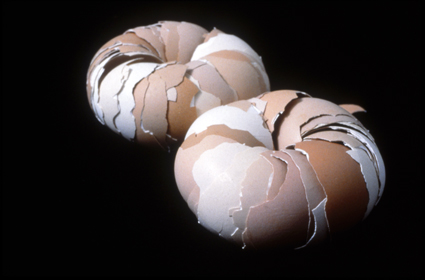
Bronia Iwanczak, Defence Rhythm, 1997
courtesy the artist
Bronia Iwanczak, Defence Rhythm, 1997
PLAIN SPEAKING RENEGADE ART CRITIC DAVE HICKEY TAGS IT “THE INVISIBLE DRAGON.” IT’S BEEN DEEMED “UNCONTROLLABLE” WHILE OTHERS HAVE WRITTEN OF ITS “MISADVENTURES.” PICK PHILOSOPHER ARTHUR C. DANTO’S BRAIN AND HE WILL TELL YOU ALL ABOUT ITS “ABUSE.” BEAUTY, AS MUCH AS IT PURPORTEDLY REMAINS A TABOO IN TODAY’S ART WORLD, HAS CERTAINLY HAD SOME IMPASSIONED WORDS PENNED IN ITS DEFENCE IN THE PAST TWO DECADES.
Conceptual Beauty: Perspectives on Australian Contemporary Art, a new book by Sydney visual arts scholar and writer Jacqueline Millner, doesn’t take to this debate with guns blazing. Rather, from the perspective of an attentive, perceptive and thoughtful critic who has observed the breadth of Australian art practice on the ground for the past decade and a half, there emerge some telling observations on the state of beauty in Australian art. Firstly, Millner identifies a substantial body of Australian artists making visually compelling artworks that challenge audiences to consider complex ideas, often of a political or socially engaged nature. Unlike their anti-aesthetic contemporaries, these artists care deeply about materials, craft and formal qualities. And, as it happens, many of them are women, some relegated to the margins of the local canon.
For these findings alone, Conceptual Beauty is a worthy addition to the critical landscape. Yet the book serves another function, too. A collection of previously published essays and articles (some from RealTime) spanning the mid-90s to the near present, the book offers insight into many of the driving concerns of recent contemporary art as well as a window into Jacqueline Millner’s development as an arts writer. As such, the author has not confined herself to the subject of beauty and, reflecting her diverse interests, the book is organised around the broad themes of nature, space(s), body relations, politics, history and, lastly, beauty. Yet even when the author is not directly dealing with this subject, much of her writing embodies a revisionist impulse that acknowledges the critical power of aesthetics.
Take her choice of cover image which offers a good clue to the type of beauty to which Millner is drawn. An installation detail from Bronia Iwanczak’s Defence Rhythm (1997), it shows two embryonic slug-like forms fashioned from fractured eggshells packed ever so delicately and self-entwining, giving rise to a tension between strength and frailty. There is charm and visual allure to be found in the artist’s resourcefulness, in her artisan-like attention to her materials and in her meticulous arrangement of these brittle cast-offs into patterns of soft tonal gradation from dark to light. They are indeed beautiful, in an unconventional way. Yet, Millner suggests, they speak also of the larger cultural climate of late modernity where “life continues, albeit in corrupted, hybrid forms, forged out of expediency from whatever is at hand.”
While Defence Rhythm is placed in the chapter on history, Iwanczak’s creations would also be at home in the primary essay in which Millner contextualises her main argument; “Conceptual Beauty: Aesthetics and recent Australian contemporary art.” Focusing on the practices of Fiona Hall, Tracey Moffatt and Rosemary Laing, Millner formulates “conceptual beauty” as describing “an artwork’s integration of intense attention, pleasure, and communication in a way that can bring about a momentary decentring of self in the viewer and evoke a ‘wealth of thought-emotion’ capable of creating the materials with which to construct new concepts and the socio-political arrangements that would correspond to them.”
The types of “thought-emotion” that artworks exhibiting conceptual beauty can give way to appear vary in Millner’s inventory. Robyn Stacey’s wondrous large-scale photographs of moth, insect and animal specimens normally hidden away in natural history collections, for example, provoke consideration of the interdependence between science and the visual in systems of taxonomy. Equally seductive are the super slick techno-human sculptural hybrids of Patricia Piccinini, underscored by ethical concerns over the manipulation of nature in the digital age. While the visceral delight to be enjoyed in the sensual and gloriously thick lashings of paint on Ben Quilty’s canvases form the material of a playful yet multi-faceted enquiry into the negotiation of masculine identity in Australian culture.
As noted, there is undoubtedly an emphasis on the practice of female artists at play here, and while male artists such as Mike Parr, Adam Geczy, David Noonan, Christopher Dean, Jonathan Jones and William Seeto are included, Millner is unapologetic about the gender imbalance. This stems partially from the author’s long running interest in feminist theory and art practice, as well as a natural attraction to the “strength of ideas” she finds in the work of Australian female artists. It would be unnecessarily heavy-handed to insist on equal representation of male and female artists, but given the long entrenched association of women with such areas as beauty, nature and the body, it is possible the inclusion of just a few more male artists who consciously employ the trope of beauty would have been effective in further challenging stereotypes.
The two-fold aim of the book to offer a snapshot of Australian practice from the mid-90s to now, whilst also putting forward an argument for the term “conceptual beauty” does pose structural challenges, too. For the most part these are skillfully handled but for one perplexing choice, the placement of the extended essay on Conceptual Beauty, the raison d’être for the book’s title, toward the end of the book. Perhaps this represents a gesture of humility on the author’s part, not wanting to impose an umbrella type theory over the entire volume especially when it doesn’t apply to every essay, leaving readings more open. Yet having skipped forward to this section, craving a deeper explication of Millner’s term, subsequent readings of preceding chapters did seem enriched.
Such phrases as ‘beauty is in the eye of the beholder’ tend to become clichés because they contain a distillation of truth. The strength of Millner’s contribution lies in her capacity to enact a journey into the mind of the ‘beholder’ with her thorough, and frequently elegant, assessments of the psychological processes that cleverly crafted objects can engender. Writing from a position of empathy, rather than provocation, Millner practices what she preaches by handling artists’ work with care. In this way, Conceptual Beauty speaks of a fairer critical benchmark where ideas and aesthetics may, at last, be equally weighted.
Conceptual Beauty: Perspectives on Australian Contemporary Art by Jacqueline Millner is published by Artspace, Sydney, 2010. ISBN 978 1 920781 41 5
RealTime issue #98 Aug-Sept 2010 pg. 50
© Ella Mudie; for permission to reproduce apply to realtime@realtimearts.net

Aleks Danko, Jude Walton, A list of positive things for later when things may not be so positive, Palm House, Adelaide Botanic Garden
photo Michael Zerman
Aleks Danko, Jude Walton, A list of positive things for later when things may not be so positive, Palm House, Adelaide Botanic Garden
AT MEDIEVAL FEASTS THERE WAS A PARTICULAR CLASS OF DISH CALLED SUBTLETIES. TRICKSY DISHES, THEY WERE MADE FOR EFFECT (MARZIPAN CASTLES, BIRDS IN A PIE) AND ALL ABOUT ILLUSION AND ITS DISSOLUTION. COLLABORATIONS BETWEEN MAKER AND AUDIENCE, THEY DEPENDED ON THE DINER’S WILLINGNESS TO RISK ENTERING THE UNKNOWN AND THE ILLUSIONIST’S CREATIVE SKILL. IN RETURN FOR BELIEF THE REWARD WAS SURPRISE AND DELIGHT. THIS TACIT CONTRACT LIES TOO WITHIN COLLABORATIVE PARTNERSHIPS. AS COLLABORATORS ARE TWINNED AND DOUBLED, SO RISK AND DELIGHT ARE INTIMATELY ALLIED. NO LIGHT THING, DELIGHT IS SHADOWED BY LOSS AND FOR THE DELIGHT OF WHAT IS GIVEN AND CREATED, COLLABORATORS CONTINUALLY RISK IT.
It’s not such a long way then from marzipan castles to Pip and Pops’ fantastical sugar landscapes, Farrell and Parkin’s gleeful animation or the joy of two poets talking on a bright cold day, for delight runs deep through Duetto’s rich offerings.
Twinning exhibitions with film and performance elements, the Australian Experimental Art Foundation’s exploration of the nature of collaborative partnerships, Duetto, ranges over a broad variety of collaborative forms and expressions. What emerges most strongly from this multiplicity is a sense of sustenance—of sustaining and being sustained by these ineffable and often alchemical relationships. While these may, as director Domenico de Clario writes, “resist any kind of articulation” (Duetto catalogue), the scaffolding is there to be sensed in the rhythms, synergies and patterns of the work.
Delight is immediate with Pip and Pops’ Three minutes happiness (2010), their grand, hugely detailed landscape composed wholly of coloured sugar, origami follies and craggy mountains. Its wealth of things (birds, lights, horses, rainbows) technicolour palette, scale and idiosyncratic sensibility fascinate. Yet it’s not simply whimsy with the landscape forms and arrangements owing as much to Japanese gardens, with their raked patterns and symbolism, as to the sensibilities of kawai culture’s cuteness. In the same way that Japanese landscapes draw the viewer into contemplation, the absolute superabundance of Three minutes happiness provokes wonder, drawing the eye in and through, revealing something gentler and deeper.
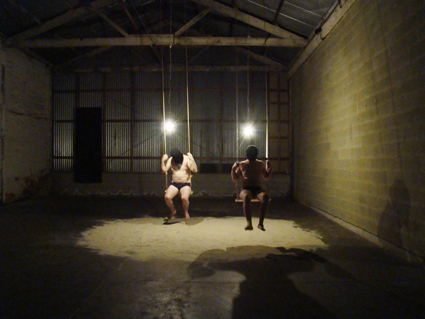
D&K, The stranger and his friend, Queen’s Theatre
photo Teri Hoskin
D&K, The stranger and his friend, Queen’s Theatre
Here collaboration emerges as ethical. Greg Burgess and Pip Stokes write of their relationship as “a form of healing care of the self and other” and their term “the architecture of kindness” seems an apt and expressive one for the structures of nurturing partnership and for the persistence of care that abounds in the works in Duetto. D&K’s performance The stranger and his friend (2010) involved the two men almost naked, hooded in black, slowly swinging and singing hymns beneath naked, single light bulbs. Haunting, it was also a work of great and unexpected tenderness.
Janine Antoni and Paul Ramirez Jonas’ two-screen video work Migration (1999) shows one artist endlessly stepping into the only just made footsteps of the other. Quoting Octavio Paz on the experience of love, “we are the theatre of the embrace of opposites and their dissolution,” the continuous production of the self, other and the collaborative third is embodied in this endless loop of making and dissolving footsteps.
This experience of being joined and yet individual is articulated as forms in space in Burgess and Stokes’ Sense (2009). Hollow beeswax blocks, the six-sided form referencing the cell and collective life of the beehive, are arranged in an open curve, like a half built tower. Neither open or closed, the curve creates a sheltering space defined by the tension between openness and enclosure. Not simply a work between two people, photographed in its original bushland setting, Sense extends collaboration into a healing relationship with nature.
The doubling of self and other moves through the spoken word poems of Aleks Danko and Jude Walton. Taking their audience on a rambling processional through the Adelaide Botanic Gardens they performed A list of positive things for when things may not be so positive (2010). An index of first lines borrowed from other poets—”musing on roses and revolutions,” “beauty and beauty’s son,” “and the winter’s cold bright tulips we do know”—grew into a singing duologue of lines bouncing back and forth between the poets, a gentle rhythm of the accommodations of each to the other’s thought. Enveloped jellyfish-like in raincoats in the Victorian Palm House, they gave us a couplet of longing (“I mist you,” “I mist you too”) as they lovingly sprayed water into each other’s faces. The rhythm of this nurturing partnership flowed through it all as play and humour.
Different sorts of collaborations take place in the works by Stelarc and Nina Sellars and Farrell and Parkin as they expand and mutate the possibilities of collaboration. Stelarc’s Ear on Arm (2010), seen as a giant sculpture and surgical photographs, is to be internet enabled with microphone and transmitter allowing remote transmission and input. Becoming many to one, Ear on Arm both diffuses the idea of collaboration as necessarily intimate and complicates it as the ear becomes the implanted collaborator.
As Stelarc morphs self into many, Farrell and Parkin merge in their kooky manga video Physiology of spite (2009/10). Stretching the possibilities of portraiture, Farrell and Parkin have mutated their images into cartoon beings. Seen first as themselves they mutate into winged creatures that spread flaming, highly coloured destruction. Against this unreal apocalypse comes the third creature made of their merged photographic selves, a golden ambiguous angel. This oddball take on the collective self embodies their practice, their joyful willingness to enter into the collaborative moment, recognising its generative possibilities and the surprise and delight therein.
Missing my own domestic collaboration, I couldn’t attend the World Cup tribute soccer match or Domenico de Clario and Stephen Whittington’s tribute to the eclipsed moon, Universe as Mirror (2010). But in a way the descriptions of these celebrations were enough. Delighting me in the telling, in my brain they became something other than what actually happened. Ideas connect and grow; every time a tiny collaboration.
AEAF, Duetto; Queens Theatre, Mercury Cinema and Adelaide Botanic Gardens, Adelaide, May 28-June 26
RealTime issue #98 Aug-Sept 2010 pg. 52
© Jemima Kemp; for permission to reproduce apply to realtime@realtimearts.net
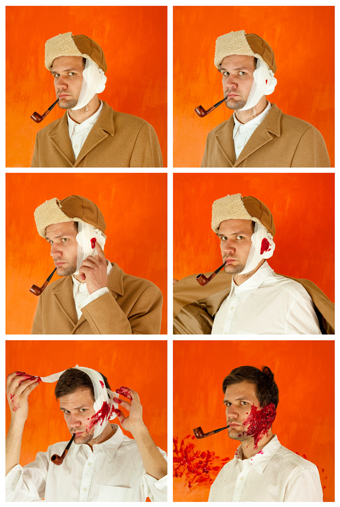
I, Goghbot, 2010, Reges Lobud, digital print
courtesy the artist
I, Goghbot, 2010, Reges Lobud, digital print
IN THE AUGUST-SEPTEMBER ISSUE OF REALTIME EACH YEAR WE TRY WHERE POSSIBLE TO FEATURE INTERESTING WORKS BY STUDENTS, RECENT GRADUATES AND EMERGING ARTISTS. OUR SEARCH TAKES IN UNIVERSITY WEBSITES AS WELL AS EVENTS SUCH AS THE HATCHED GRADUATE ARTISTS EXHIBITION HELD AT PICA EACH YEAR. MORE RECENTLY, WE’VE CAST OUR EYES OVER THE SHORT-LIST FOR THE NATIONAL YOUTH SELF-PORTRAIT PRIZE HOSTED BY THE NATIONAL PORTRAIT GALLERY IN CANBERRA.
That’s where we came across our striking cover artwork entitled I Goghbot, 2010 by Egres Ludob. It didn’t win the prize (that was awarded to Bridget Mac for her portrait masculine/feminine). In interpreting Van Gogh’s famous Self-Portrait with Bandaged Ear, Ludob says he “tried to envisage what the work would look like when adapted for modern trash culture which favours shock value and ultra-realism.” At the same time he wanted to “maintain a tongue in cheek criticism of trash culture. When historical works or events are reinterpreted in popular culture, for me they lose a lot of romanticism and mystique due to sensationalism.”
I, Goghbot is part of a series of works that Ludob is working on, based around a similar theme of selective re-imagination of historical works in a modern context.
I asked Egres Ludob’s alter-ego Serge Bodulovic about his educational trajectory which offers an example of the progress of the young working artist in the age of creative industries. He wrote, “I graduated from ANU in 2007 with B Comm (majoring in Marketing) and B Arts (majoring in Art History) degrees. I also completed a fashion design course in Milan after completing university.
“I had decided to study commerce, particularly marketing and advertising because it enabled me to combine creative expression with an educational background that could be utilised in any industry or endeavour. I also like the referential and humorous aspects of marketing and advertising, which I try to adopt in my work. Whether my marketing studies can be used in the traditional sense still remains to be seen. I had also wanted to study Fine Art, but was unable to do so while studying commerce, as the ANU did not offer cross-institutional studies between Fine Art and the Commerce faculty. So I switched my focus to a more academic study of art. My studies in Art History, including film have added to my passion for popular culture and allowed me to get an in-depth insight into the lives and times of artists and movements.”
As well as maintaining his own art practice and curating shows at the Canberra Contemporary Art Space and other galleries, Serge and his colleague Simon Gibson founded the designer boutique menswear label, Book Club.
“While there are clear overlaps between the two in a creative sense as both use the medium of photography, I personally treat them as two separate areas of endeavour, hence the use of an (admittedly poor) nom de guerre for my artworks. The reason why I separate the two areas of my life is due to the fact that with fashion design there are commercial realities that need to be addressed in order to have a successful label. With art, it is purely a means of self-expression, not based on commercial considerations. I also have more trepidation about showing my works as an artist as it’s a more direct representation of my creativity than fashion design, which is more removed as it deals with tangible, utilitarian objects.”
National Youth Self-Portrait Prize, Finalists exhibition, National Portrait Gallery, Canberra, on show to September 12. http://www.portrait.gov.au
RealTime issue #98 Aug-Sept 2010 pg. 53
© Virginia Baxter; for permission to reproduce apply to realtime@realtimearts.net
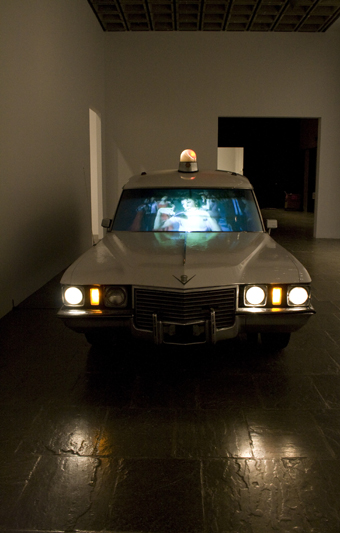
We Like America and America Likes Us (2010), The Bruce High Quality Video Foundation
BOTTLES AND JARS WRAPPED IN RED NET HOLD AMBER, JELLY-LIKE SUBSTANCES AND HANG ABOVE AND NEXT TO OLD ELECTRICAL DEVICES, STOOLS AND BOXES. A SLIGHT WOMAN STANDS AT THE WALL DRAWING A LARGE CHARCOAL GRAPH, ITS SHAPE TRACED IN CONFIGURATIONS OF ROPE AND NETTING. WITH LARGE CUSHION ‘DOUGHNUTS’ ON HER ARMS, WHILE PROJECTORS TURN ON AND OFF, SCREENING LIGHT AND SCIENTIFICALLY FORMED CIRCULAR SHAPES, SHE MAINTAINS A CONTINUOUS MONOLOGUE ON THE MATHEMATICAL CONCEPT OF THE LORENTZ ATTRACTORS (WHOSE CONTINUOUS MOVEMENT AROUND CERTAIN POINTS CREATES DOUGHNUT-LIKE SHAPES) CONNECTING HER ACTIONS TO THE INSTALLATION. THIS IS STRANGE ATTRACTORS, A FRENETIC PERFORMANCE PIECE AND UNCANNY INSTALLATION BY AKI SASAMOTO INCLUDED IN THE 2010 WHITNEY BIENNIAL.
Sasamoto’s sustained action and disorienting monologue created a language that underscored the experimental possibilities of intersection, confluence and the everyday nature of disjuncture. A little like a ‘happening,’ the physical and linguistic permutations of the performance seemed to foreground the trajectories of this year’s biennial and its media works in which the language of modernism—its reconfiguration—and the centrality of experimentation and abstraction were guiding aesthetics.
The ‘intermedia’ aesthetic of Strange Attractors found resonance through a confluence of spoken word and image in The Bruce High Quality Foundation’s video work. On a white Cadillac Miller-Meteor’s windscreen they projected a video created out of YouTube clips (think funny cat videos and babies throwing food), Hollywood movies (Ghost Busters, Frankenstein, Independence Day) and news media. The vehicle—designed to double as hearse and ambulance—provides an engaging viewing platform across which this stream of images, iconic and everyday, lulls us into a comforting visual rhythm.
The images fade in and out while a low female voice soothes us with descriptions of her/their relationship: “We like America. And America likes us. But somehow, something keeps us from getting it together. We wished we could have fallen in love with America. She was beautiful, angelic even, but it never made sense…America stayed simple somehow. He stayed an acquaintance, despite everything we shared. Just a friend.”
We Like America and America Likes Us (2010) makes clear references to Joseph Beuys’ I Like America and America Likes Me (1974). Both works deal with the cultural myths of America, reviving them, critiquing them, exposing them. But in this piece the centrality of human physicality is muted as the image/text confluence sculpts us into the work. It’s confrontational—the images in their strange juxtapositions demand some kind of imaginative work. It’s also ritualistic: the slow cadence and rhythmic relationship of the film clips to the voiceover recreates the open space of the white walled room (lined with large digital images of Lorrain O’Grady’s First and Last of the Modernists, 2010) into something more reverential, within which the large white motor vehicle serves as mausoleum and instrument of healing. Standing in this space evokes an intense feeling of collectivity: the voiceover, hushed, solemn, also disjointed, provides something like an architectural frame. The monologue layers over and insulates the soft flow of images, while threading us into its passage of time.
These works and the artists creating them spoke back to a history of modernism in which language—and its abstraction into the realm of the performative—was central. A floor below, Ärztliche Zimmergymnastik (2008), the video work of Jesse Aron Green, created another form of abstraction in the angulated movement of his performers. His work is based on a book of the same name by Dr Daniel Gottlob Moritz Schreber (1808-1861; his son’s self-documented hallucinatory nervous illness fascinated Freud) detailing a system of exercises designed for the maintenance and invigoration of a healthy body and mind. Green uses the book as a kind of ‘score,’ his revolving camera (slowly making a complete revolution of the room in 80 minutes) captures 16 men performing an entire catalogue of physical movements executed according to the 45 exercises created by Schreber. Green’s gridded arrangement, the pieces of its constructions—the wooded plinths the performers stand on—and the extended duration of his single shot camera work reference minimalism and structural film making, highlighting and critiquing the relationship between these modernist art practices, psychoanalysis and the ideologies of 19th century German physical culture.
Tracing this history, the work nonetheless maintained a remarkable lack of rigidity. I was struck by the coalescence of the bodies, the way arms, heads, feet moved in sequences that solidified into a kind of bodily legibility characterised by a silent fluidity. In the seamless rotation of the camera and its slow elucidation of the bodies on view, the aesthetic rigidity of these earlier art practices was brought into a more intimate plane. As I watched, for at least half an hour, this formal abstraction of the body into gesture seemed more akin to a poetic anthropology. Becoming aware of the exact motions, a fine attenuation of muscle, skin, bone in the thrust of an arm, the curve of a neck, the elongation of a foot, Green created the space for a heightened sensitivity to what I can only describe as a physiological collectivity of (self) awareness.
The expansion of the video screen into the space of the gallery was effective in Parole (2010), a multi channel video projection by Sharon Hayes. Each of four walls held a video screen, and the work itself was housed within the four walls of a Whitney white box. Once inside the ‘inner’ structure—composed of plywood, plank supports, PA systems and wall coverings—I sat and watched various scenes of public speech play across the four screens—news segments, speeches, public recordings, auditions—each of them connected through the inclusion of a mysterious, silent, red-haired figure. This figure records sounds—political lectures, erotic readings, a kettle boiling, the reading of a love letter—but never speaks. Her silence is translated into a constellation of facial expressions that keeps time with the work’s expansion across the space of its projection. It unfolds around me through a simultaneity of differing experiences, flow of emotions and snatches of recognition. Poetic yet highly simulated the work examines the alluring, and harmful, power of speech, the marginalisation of sexual minorities and in its haunting expansiveness provided a uniquely communal sense of personhood.
A few rooms on I came across Annotated Plans For an Evacuation (2009) showing artist Alex Hubbard modifying his Ford Tempo. Shot in static profile by a camera attached to the side of the vehicle, Hubbard’s alteration followed a deliberate plan in which the continual transformation of his car unfolded to a soaring soundtrack across a shallow depth of field that immediately entangled me within its small, tucked away space at the back of the gallery. The deadpan purpose of Hubbard’s automotive alterations led only to a process of sustained movement, poignant and painterly in its action. A haunting complement to the structural analysis of Ärztliche Zimmergymnastik this study in time transformed the screen into a canvas in which the banality of the everyday and the mechanics of the industrial are pictorially arranged into a series of precise colours, lines and angles. An animated form of assemblage, Hubbard’s alterations called attention to the textural work of video, its ability to elongate and compress our sensory perceptions.
In the sculpture courtyard transformed by Theaster Gate’s installations of shoeshine chairs—a wooden pavilion, and walkways lined with repurposed Wrigley gum boxes—I watch Derek Chan crouching over a large checkered square of calligraphy paper. He slowly markes off each square—a diary of thoughts—with a random series of signs, sometimes breaking off to speak with viewers and obstructing the completion of his patterns. A study in the informal practices of everyday interaction and the specificity of urban life, Chan’s performance of serialisation and introspection is an intriguing complement to the graphic loops of dialogue and objects in Strange Attractors. The new media ‘aesthetic’ in the mutual fascination with serialisation and patterning to screen the encounter between artist and viewer highlighted the ritualised gestures that animate our everyday interactions.
What emerged for me in these video and performance works were the collective possibilities of new media. Through the ‘intermediation’ of text, image and installation the expansive and elemental historical languages of modernism were refigured through forms of contemporary abstraction.
2010 Whitney Biennale, Whitney Museum, New York, Feb 25-May 30, http://whitney.org/Exhibitions/2010Biennial
RealTime issue #98 Aug-Sept 2010 pg. 54
© Anna Arabindan-Kesson; for permission to reproduce apply to realtime@realtimearts.net
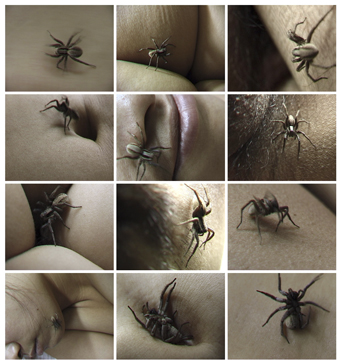
Looking, Looking, Looking for…, Kan Xuan (2001)
courtesy of the artist
Looking, Looking, Looking for…, Kan Xuan (2001)
GREETING US AT THE ENTRANCE TO THE GALLERY ARE TWO TRADITIONAL CHINESE LIONS. RATHER THAN BEING CARVED OF STONE, HOWEVER, THESE CREATURES ARE TRAPPED INSIDE SCREENS, THE LION ON EACH SIDE SPLIT BETWEEN TWO STACKED MONITORS. FAR FROM UNHAPPY ABOUT THEIR FATE, THESE LIONS ARE PLAYFUL, WINKING AT US, LIFTING PAWS AND SENDING OUT THE OCCASIONALLY PROVOCATIVE ROAR. THE WORK, ALWAYS WELCOME (2003) BY WANG GONGXIN, ONE OF CHINA’S LEADING VIDEO ARTISTS, OFFERS AN INVITING INTRODUCTION TO MU:SCREEN, AN EXHIBITION OF CHINESE VIDEO ART CURATED BY MARIE TERRIEUX AT THE UTS GALLERY.
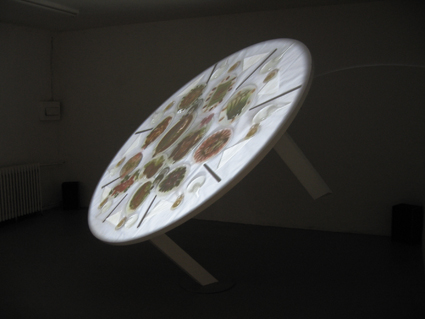
The Dinner Table, 2006, Wang Gongxin
courtesy the artist, collection of the Neilson Family, White Rabbit Collection, Sydney
The Dinner Table, 2006, Wang Gongxin
Wang Gongxin contributes another sculptural video work, The Dinner Table (2006). An oversized tabletop on a precarious 60-degree angle acts as the screen for the projection of a fully set banquet table. Gradually we begin to notice that the sauce from some of the plates is seeping across the table, but defying gravity, oozing upward. Before long, food and cutlery are all impossibly sliding up and over the edge, accompanied by soft crashes and clangs, until all that remain are the stained tablecloth and a few napkins, which are also whipped off, surprisingly from the lower side of the table. Wang’s challenge to viewers’ spatial perception is a potent metaphor for the provocations that art can offer to established ways of seeing—particularly resonant as he is one of the first artists in China to push beyond traditional mediums to explore video.
Zhang Peili is in fact recognised as the first Chinese video artist. The piece included here, Water—Standard Version from the Dictionary Ci Hai (1992), features a news presenter reading the full nine-minute definition of the word for water from a dictionary. As there is no translation offered, the experience for an English speaker is purely conceptual, but the correlation with works by Western artists such as Bruce Nauman is clear. As Peili is such an important figure, it would have been interesting to experience at least one other work of his (as we do with Wang) to get a clearer sense of his practice and of the beginnings of video art in China.
There appears to be a clear lineage between Zhang and Wang’s work—in the manipulation of temporal qualities and the concentration on live action—expressed in the work of two of the younger artists represented. In Kan Xuan’s Looking, Looking, Looking For…(2001), presented on a small screen, a tiny spider skitters over naked male and female bodies, exploring every crevice and orifice. Both playful and disturbing, the work has the ease and directness of approach that characterises a generation born into a media and technologically driven age. Similarly, Ma Qiusha’s A Beautiful Film (2007) suggests an artist immersed in a critical exploration of screen culture as well as contemporary representations of sexuality. She uses close-ups of pornographic images to create a hazy, romanticised vision of beauty, accompanied by endlessly scrolling movie credits.
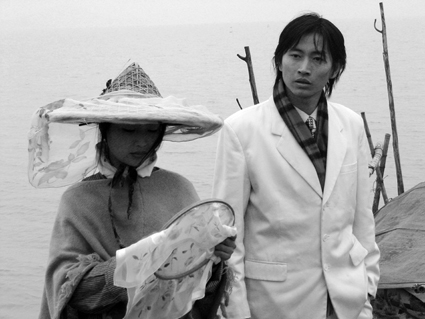
Liu Lan, 2003, Yang Fudong
courtesy of Shanghart gallery
Liu Lan, 2003, Yang Fudong
Yang Fudong, has recently been introduced to Australian audiences with his disturbing work East of Que Village (2007), presented as part of the recent Biennale of Sydney (RT97, p 46). A less harrowing experience, his work in this exhibition entitled Liu Lan (2003) is stunningly shot on 35mm black and white film (transferred to video) and focuses on a beautiful young fisherwoman on an eerily isolated lake where she is joined by a handsome man from the city wearing a white suit. It is a quiet, romantic vision of an impossible meeting occasionally undercut by the extraordinarily weathered face of an old woman, hinting at these as her memories or dreams. Under the veneer of idyllic beauty is a subtle sense of irony and social criticism that gives the work its intensity.
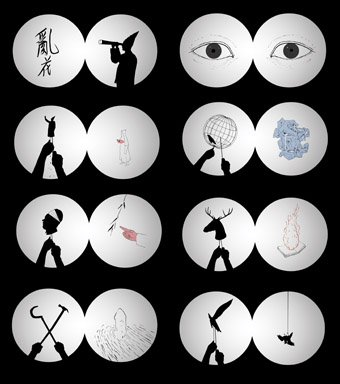
Flowers of Chaos, 2009, Wu Junyong; exhibited as part of Mu: Screen, UTS Gallery
courtesy of the artist
Flowers of Chaos, 2009, Wu Junyong; exhibited as part of Mu: Screen, UTS Gallery
Interestingly, three of the artists utilise drawing and animation. Most intriguing is Flowers of Chaos (2009) by Wu Junyong who, with his simple, almost naive line drawings, creates his own symbolic language to explore power, manipulation, repression and freedom in a strangely joyous way. Sun Xun’s People’s Republic of Zoo (2009) also explores these themes, with animal/human chimeras acting out symbolic power plays. Sun’s animation is a complex collage of styles reminiscent of William Kentridge—drawings, cutouts and actual video footage of shadow play—that bring to mind a dark, often opaque dreamscape.
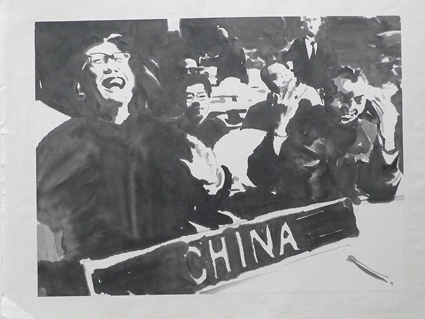
The Ink History, 2010, Chen Shaoxiong
courtesy the artist
The Ink History, 2010, Chen Shaoxiong
With four works presented, it is hard not to see Chen Shaoxiong’s Ink series as the centrepiece of Mu:Screen. Created from hundreds of ink drawings, these simple animations often involve just flipping through different scenes, or at most a close-up or pan within an image. It’s the accumulation of detail that makes these works so powerful. Across the four screens, we move from everyday life in The Ink City (2005) to the personal in The Ink Diary (2006), to a micro view in The Ink Things (2007), ending with the macro in The Ink History (2010), an epic exploration of Chinese history. Chen’s work is particularly poignant, not only in its subject matter—the methodology itself illustrates the tensions between old and new media.
The UTS Gallery was well transformed to house the substantial number of video works in this exhibition, although the issue of soundbleed presented a problem. While some works were well served by headphones, there were still four soundtracks mingling in the reverberant, tiled space. The effect was exacerbated in the use of video projectors as audio source for two works rather than placing speakers in close proximity to the actual projection. This meant that sound and image became quite dislocated and confusing, particularly in the case of Sun Xun’s work.
Marie Terrieux is a freelance art consultant, with her own company, Shuang Culture, advising collectors and institutions and working with established and emerging artists from China and the region. Her thorough knowledge of the Chinese art scene is evident in this exhibition, which includes illuminating contextual information on the website. Terrieux’s choice to present artists across three generations provided a fascinating introduction to an area of art-making only just beginning to make the same impression as other Chinese art practices on the international stage.
Mu:Screen, three generations of video art, curator Marie Terrieux, artists Wang Gongxin, Zhang Peili, Chen Shaoxiong, Yang Fudong, Ma Qiusha, Wu Junyong, Sun Xun, Kan Xuan; UTS Gallery, Sydney; June 1-July 9; www.utsgallery.uts.edu.au; www.muscreen.com
Wang Gongxin’s The Dinner Table (2006) was lent to Mu:Screen by the White Rabbit Gallery, Sydney which houses the largest private collection of contemporary Chinese Art outside China. www.whiterabbitcollection.org
RealTime issue #98 Aug-Sept 2010 pg. 56
© Gail Priest; for permission to reproduce apply to realtime@realtimearts.net
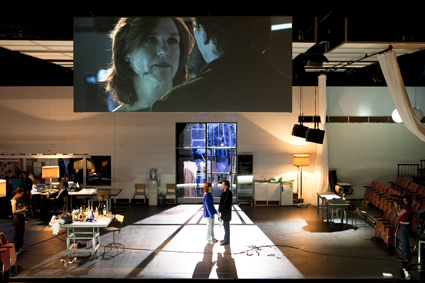
Opening Night, Toneel Groep, Melbourne Festival 2010
photo Jan Versweyveld
Opening Night, Toneel Groep, Melbourne Festival 2010
9.30AM, SYDNEY HILTON HOTEL SUITE: COFFEE, PASTRIES, FOUR MEMBERS OF THE PRESS AND BRETT SHEEHY. AN INTIMATE, 50-MINUTE BRIEFING ON THE ARTISTIC DIRECTOR’S PROGRAM FOR THE 2010 MELBOURNE INTERNATIONAL ARTS FESTIVAL. IT’S THE SECOND OF THREE BRIEFINGS THIS MORNING AND ONCE WE GET PAST A LUMPEN CELEBRATION OF THE 2009 FESTIVAL’S ECONOMIC SUCCESSES (“I KNOW IT’S NOT ABOUT THE MONEY, BUT FINALLY IT IS ABOUT MONEY”), SHEEHY’S POSITIVELY EFFERVESCENT.
A festival theme, “a motif,” he declares (conjuring images from his laptop onto the big screen before us), has emerged naturally from the well-spring of his discussions with Australian and international artists selected for the festival. “Spirit,” “mortality,” “transformation,” “transition,” “transcendence,” “ascension” and “epiphany” consistently bubble forth as the ever speedy Sheehy briskly uncaps his program. No mere froth and gas, there’s plenty of body here: a festival about “mortality and spirituality, not in a religious sense, but in terms of transition and transcendence.”
cassavetes’ opening night
The standout work in the program, and the one on which Sheehy lavishes most attention in this briefing is Toneelgroep Amsterdam/NTGent’s Opening Night by John Cassavetes, directed by Ivo van Hove whom Sheehy ranks as “one of the greats with Mnouchkine and Ostermeir” (whose works have appeared in Sheehy festivals). Van Hove is reproducing the 1977 Cassavetes classic on stage. As opening night of a new play draws near, an ageing actress faces emotional collapse after the death of a fan, “confronts her own mortality,” says Sheehy, “and comes out the other side with an epiphany.”
Sheehy explains that “over the last few years van Hove has been dissecting theatre and cinema and looking at the points of cross-over and diversion. Camera men and women, all professionals from the world of cinema, constantly feed the performance live by video [to screens large and small], creating a real time film of the performance throughout.” Cinema took much from theatre in its evolution and now “Van Hove is taking back from cinema certain of its achievements and putting them into theatre to create something new and fresh—the closeup, multiple points of view, sonic veracity. This is not new, directors have worked with video, but the way van Hove does it completely enhances the theatrical experience—every single scene is lit and blocked for both cinema and stage, for every seat, in real time in a work about a stage production.” One third of the audience is seated on the stage, ‘playing’ their theatre double.
For those of us who have admired Australian director Benedict Andrews’ virtuosic and integrated use of video in The Season at Sarsaparilla (RT78, p11) and Measure for Measure (p8), van Hove’s realisation of a film classic as a stage-cum-film work will, it’s to be hoped, engender further theatrical possibilities while offering a new understanding of Cassavetes’ unique vision.
hotel pro forma: tomorrow, in a year
There’s more hybridity abroad in the festival’s opera and music theatre offerings. Denmark’s Hotel Pro Forma, working to a score by Scandinavian electro-pop duo The Knife and the choreography of Japan’s Hiroaki Umeda, “creates a new species of electro dance opera.” Titled Tomorrow, In a Year, the opera celebrates the 2009 150th anniversary of the publication of Charles Darwin’s The Origin of Species. Darwin appears as a character alongside Time and Nature—our understanding of which he radically reconfigured—with singers and dancers in a spectacular aural and visual stagescape, reminding us of the transcendant sense of duration, variation and diversity Darwin bequeathed. (A laterally related work, epi-thet, by Melbourne composers Madeleine Flynn and Tim Humphrey [p47], offers audience members sonic and visual responses to their genetic makeup in terms of height, posture and movement in a work inspired by an ANAT Synapse Residency with Dr Shane Grey at the Garvan Institute of Medical Research in Sydney.)
heiner goebbels: sifters dinge
Heiner Goebbel’s Sifters Dinge (Sifter’s Things; RT86, p54) is performed not by singers and musicians but by programmed, up-ended pianos “over a massive dry ice pit to a soundscape that includes Malcolm X speeches”—an installation as performance, in a theatre, with an inevitable touch of the uncanny. Goebbels, a multimedia pioneer, was inspired by the pantheistic writing of a 19th romantic, Aldabert Sifter. Sheehy describes the work as “deeply political and, finally, a homage to nature.” Given that Sifters Dinge “is almost impossible to describe,” Sheehy wonders what kind of reviewer—music, theatre, visual arts—editors should send to experience the work in which “the pianos play, fog rises, rain falls, water bubbles, objects move mysteriously” [Press Release]. There’s original music by Goebbels, traditional chants from South America and Papua New Guinea, fragments of texts from Sifter’s novels, quotations from Claude Levi-Strauss, William S Burroughs and Malcolm X. Goebbels will speak about his work at the festival.
david chesworth: richter/meinhof-opera
Melbourne composer David Chesworth will premiere Richter/Meinhof-Opera (to a libretto by Tony MacGregor), “exploring the limits of representation and direct action.” To be staged at the ACCA gallery, the opera is inspired by German artist Gerhard Richter’s October 18, 1977, a series of paintings responding to the alleged suicides of jailed Baader-Meinhof Group members and accused at the time of “aestheticising terrorism.” Will the charge be repeated this time? This 45-minute work will musically and visually conjure a dark period in western democracy, one with immediate resonances, says Sheehy.
robert lepage: the blue dragon
Brett Sheehy says it’s usually anticipated that Canadian director Robert Lepage’s multimedia works will be “between four and seven hours in length, but The Blue Dragon is one hour 45 minutes: imagine all that theatricality and theatre magic condensed down into an absolute gem of a production.” This time Lepage focuses on three people in contemporary Shanghai: “a Canadian ex-pat who runs a gallery in the city’s art district, a young Chinese artist exhibiting at the gallery and a Montreal advertising executive in town to adopt a Chinese baby.” Sheehy sees the work as being about “the West grappling with the new China especially the Chinese artist.” Doubtless The Blue Dragon will display Lepage’s engaging theatre magic, but will it also feature the soap-operatics of Lipsynch (RT87, p3), with its crudely ‘transcendent’ treatment of a central female figure? And, the choreography of Tai Wei Foo (Singapore/Canada) aside, in what ways will Lepage choose to represent Chinese art?
australian art orchestra: soak+the hollow air
Paul Grabowsky and the improvising Australian Arts Orchestra frequently inspire with their cross-cultural collaborations. On this outing the focus, in two works, is multimedia. The Hollow Air brings together the AAO and shakuhachi player Riley Lee with “sound projection and real time digital manipulation using the visual programming language MAX/MSP.” Soak is described as “a live music and film experience…an extended ambient work, it slowly unfolds through compositional elements influenced by artists such as Arvo Pärt, Henryk Górecki, Brian Eno, Radiohead, Dust Brothers and Miles Davis.” Australian film artist Louise Curham will use a variety of projectors and screens to provide another layer of improvisation. The aim is, again, transformative, to create “an aural and visual exploration of sound that breaks down distinctions between musical genres and incorporates elements of ambient music, electronica, contemporary art music, jazz and rock” [Press Release].
thomas adès: in seven days …
Britain’s leading ‘contemporary classical’ composer, Thomas Adès will be in-residence at the 2010 festival. The American Calder Quartet joins Adès on piano to perform his Piano Quintet. Adès also directs musicians of the Australian National Academy of Music in a program of his own music and of “music close to his heart” by Rameau and Couperin. Michael Kieran Harvey, Anthony Pateras and musicians of the Academy will perform Thomas Adès’ Living Toys and the world premiere of String Quartet by Anthony Pateras.
The Melbourne Symphony Orchestra will play Adès’ violin concerto Concentric Paths, written for and performed by Anthony Marwood, and present the Australian premiere of In Seven Days Piano Concerto with Moving Image: “a collaborative work between Adès and video artist Tal Rosner…described by the artists as a video-ballet in seven movements that follows the Genesis tale of creation. The visuals and the music tell the story in a set of abstract variations, each new element—light/darkness, sea/sky, heavenly bodies, plants, creatures…” [Press Release].
akram khan, michael clark, hiroaki umeda
In Vertical Road, the multicultural Akram Khan Company (including Australian dancer Paul Zivkovich) will explore the pan-cultural phenomenon of angels who travel the road, as Sheehy puts it, “to heaven or whatever’s up there”, danced to a score by Nitin Sawhney in an investigation of “ascension.” Also the UK-based, Michael Clark Company will perform a new work (London premiere, October 3), come, been and gone, with Clark’s trademark mix of ballet and modern dance here set to the music of David Bowie and collaborators Lou Reed, Iggy Pop and Brian Eno. Sheehy describes the work as “an exploration of the musical world of the 70s and 80s and Clark’s own journey through it, with a moment of epiphany at the end.” Hiroaki Umeda, as well as choreographing for Opera Pro Forma, will perform two solos to his own computer, lighting and sound design. In Adapting for Distortion, “engulfed in computer generated sounds and optical effects, Hiroaki Umeda’s body seems to slowly fade away and go out of focus within luminous lines and spirals, until it is a mere vibration, a shadow of its real self.” In Haptic, Umeda works, minus computer, with light and colour. Evanescence and a sense of time standing still are central to the Umeda experience (RT 94, p38).
beckett, keene, ranters, jack charles, optimism
The Irish/French theatre company Gare St Lazare Players Ireland will perform The Beckett Triology, adaptations of the novels Molloy, Malone Dies and The Unnameable by Samuel Beckett. Sheehy describes the performance—a “solo marathon” by leading Beckett exponent, Conor Lovett—as “riveting; it flies by,” doubtless not before throwing us into a few existential black holes and racking us with laughter. Daniel Keene gets a Melbourne Theatre Company guernsey after all these years. Sheehy describes Life Without Me as “a cross between Sartre’s No Exit and Fawlty Towers: an eccentric fable about taking up residence and trying to move on.” In another work on the theme of transition, Melbourne’s Ranters Theatre further their successful, cool poetic modus operandi of recent years with Intimacy, “a performance about intimacy in the age of celebrity,” says Sheehy.
Ilbijerri Theatre Company will premiere the solo performance Jack Charles V The Crown, featuring the Aboriginal actor (the subject of the documentary, Bastardy, RT91, p24) “at the peak of his powers” and a script by John Romeril based on Charles’ life in crime, theatre and on the road—challenges faced with “constant and unswerving optimism.” Optimism against the odds is also the subject of eccentric Canadian writer-performer Jacob Wren and Belgian writer, philosopher and theatre-maker Pieter De Buysser’s An Anthology of Optimism. The pair asked 200 business people, scientists and artists about their inclination—optimism or pessimism?—and collated the results into a droll, “low-tech as you can get” two-hander lecture-performance which will also canvas local opinion: “What sort of meaning can optimism have today in this era of heightened terrorism awareness and global warming..?”
Cabaret, live art and weirder stuff will populate Finucane & Smith’s Carnival of Mysteries at 45 Downstairs with 30 artists curiously “commissioned to respond to the Mysteries of Innocence, Passion, Mercy, Forgiveness and Love.” In the tradition of sideshow alley, you’ll wander four sites and buy tickets for what grabs you: music, miracles, freakery.
more transformation, transcendence…
Look out for Australian recorder virtuoso Genevieve Lacey and UK filmmaker Marc Silver’s part concert, part film, part installation immersive bird flight experience, en masse. US video artist Bill Viola will be showing The Raft at ACMI and Fire Woman and Tristan’s Ascension at St Carthage’s Catholic Church in Parkville—a 20-minute loop drawn from Viola’s contribution to Peter Sellars’ New York production of Wagner’s Tristan and Isolde. It’s less intimate than Viola usually is, but is nonetheless engrossing. In Sydney it attracted large numbers for months in a Redfern church. Aboriginal photographer Bindi Cole will curate an exhibition titled Nyah-Bunyar (Temple) at the Arts Centre: “it’s about contemporary Koori spirituality in an urban culture.” Sheehy adds that “at ArtPlay Cole will explore traditional mourning ceremonies with children and their families.” The titles of other visual arts shows are also telling: Gertrude Contemporary’s Dying in Spite of the Miraculous and ACCA’s Mortality.
seven songs to leave behind
The final festival show, Seven Songs to Leave Behind, asks singer-songwriters to perform favourites from their own and others’ repertoires, including the one song they would like to bequeath to the future. The lineup includes Sinead O’Connor, John Cale, Meshell Ndegeocello, Rickie Lee Jones, Gurrumul Yunupingu, Leah Flanagan, Shellie Morris, Dan Sultan and Ursula Yovich. Aptly, for a festival with a free-floating sense of the spiritual, this concert-ritual should confirm a sense of sharing between artists and audiences including the festival’s unavoidable sense of mortality and offerings of moments of transcendence. Brett Sheehy wraps up the briefing jovially, declaring that “there’s more levity in this year’s program; last year was much darker.”
Melbourne International Arts Festival, Oct 8-23, www.melbournefestival.com.au
RealTime issue #98 Aug-Sept 2010 pg. 16
© Keith Gallasch; for permission to reproduce apply to realtime@realtimearts.net
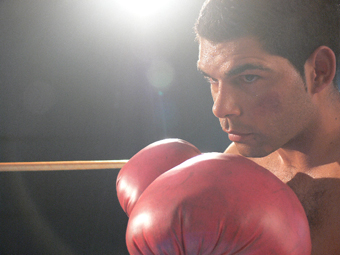
The Caretaker
THE SCREENING OF THE 2009 FILMS COMPRISING THE 11TH SERIES OF THE LESTER BOSTOCK INDIGENOUS MENTORSHIPS (NOW PART OF METRO SCREEN'S FIRST BREAK GRANTS SCHEME AS INDIGENOUS BREAKTHROUGH) WAS LAUNCHED BY THE MAN HIMSELF—A KEY PROGENITOR IN THE FOUNDING AND NURTURING OF AUSTRALIAN INDIGENOUS FILMMAKING IN THE 1980S AND 90S AT AFTRS AND METRO SCREEN. SINCE THE BOSTOCK MENTORSHIP'S INCEPTION IN THE 1990S 44 FILMS HAVE BEEN MADE AS PART OF THE PROGRAM.
Bostock, whose focus these days is on dealing with the challenges of disability in Aboriginal society (through the National Indigenous Disability Network), noted a long-term shift in Indigenous filmmaking from largely issue-based content to increasingly personal stories. However, he argued that “the only really political films” continued to be made by Aboriginals and with a distinctive filmmaking style.
Fault, directed by Martin Adams (mentored by Jason De Santolo), is immediately and cruelly suspenseful. An anxious, depleted man sits in a bleak room with a gun and the clack of a flip clock. 2:59. Cut to a laneway where we see him with a male friend. Cut to room. 3:11. The man looks suicidal. Cut to the man shooting his friend, accidentally, or so we think. There's a sharp knock on the door. We hear a gun shot. Cut to the man walking away with his friend, but time is out of whack—the man is now his younger self. At the moment of death he re-lives his lost friendship, even love perhaps. Fault is raw filmmaking, if spare and deftly edited. Its brevity and the focus on generating tension allow little room for character detail but its gritty mood (amplified by a grinding sound score between silences) and sense of loss is palpable.
Quarantine (director Tyrone Sheather, mentor Simon Portus) reveals a young couple in love, lolling on the grass beneath the looming stars, “together forever.” Their reverie is interrupted by a massive crash. The young man pushes through the bush to find a smouldering comet. As the couple approach it the world of nature evaporates into an enveloping whiteness out of which men in protective outfits with guns and hypodermic needles emerge. The couple flee, but shot and bleeding, they fall. One of the men announces the need to quarantine the area as soon as possible: the couple have been infected by an alien virus and duly eliminated to prevent its spread. Some of the effects are striking, other moments are awkward, the dialogue is stilted and the story lacks the touch of complexity that could have lifted Quarantine out of the morass of the sci-fi paranoia genre.
Stylishly shot in widescreen, Alanna Rose's The Caretaker (mentor Margot Nash) is an accomplished film which immerses the viewer in the world of the ageing Willie “The Kid.” Willie, critically not identified as such until the end of the film when he turns to reveal the lettering on his jacket, sits centre screen in a boxing ring in a darkened space, the spare, sharp light dancing with dust. Looking at old photographs which “come to life,” takes him back to his childhood. He and his brother, poor kids without a father, sneak into a boxing gym where they win the support of a trainer. Years later they crawl under a canvas into the world of tent boxing (a beautifully executed piece of editing in which we, with the boys, are confronted with a massive, gloriously red, beating drum).
Now grown up, the brothers are part of Australia's tent boxing world before it disappeared in 1971. Rain beats down as old Willie peers into his past. So far, we imagine The Caretaker to be in the tradition of the “could have been a contender” or “the down and out” school of boxing films. But the story here is even darker, one brother killing another with a calculated KO out of jealousy and ambition. Apparent nostalgia disturbingly mutates into real guilt. More than this, Willie, no longer a champion, has made himself look at his past.
While a couple of scenes are unnecessarily expository and the emotion is trowelled on at the end (an overlay of thunder and a good song with a strong hook), The Caretaker constitutes promising filmmaking from Rose and a strong cast and seriously expert crew. The film is dedicated to the memory of artist and filmmaker Michael Riley whose documentaries included Tent Boxers (1997). Alanna Rose has been awarded the 2010 Indigenous Breakthrough grant for $22,000 towards a film of up to 20 minutes and a range of support from Metro Screen.
Fault, writer, director Martin Adams, cinematography Fabio Cavadini, sound design, composition Grant Leigh Saunders, editor Peter Cramer, producer Jason De Santolo, actors Ken Canning, Scott Canning, Gio De Santolo, 4:50mins; Quarantine, director, writer Tyrone Sheather, cinematography Jack Anderson, sound Jason Dean, editor Peter Ward, producer Jack Anderson, actors Kay Cast, Dylan Underwood, 4:00mins; The Caretaker, writer, director Alanna Rose, cinematography Brandon Jones, production designer Brett Wilbe, editor Craig Savage & Oana Voicu, producer Jade Rose, actors Mick Mundine, DJ Mundine, Paul Sinclair, Kobi Hookey, Derek Walker, Tony Barry, Tony Ryan, Warwick Moss, 15:35mins; Lester Bostock Indigenous Mentorship screening, Chauvel Cinema, Sydney, April 20; www.metroscreen.org.au
RealTime issue #97 June-July 2010 pg. web
© Keith Gallasch; for permission to reproduce apply to realtime@realtimearts.net
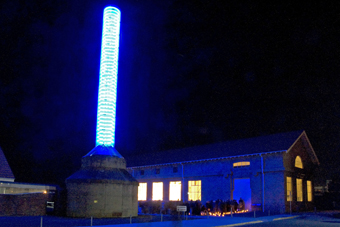
The Fitter’s Workshop
photo Peter Hislop
The Fitter’s Workshop
WALTER BURLEY GRIFFIN, THE ARCHITECT OF CANBERRA, ONCE WROTE THAT “A CITY IS FROZEN MUSIC.” ACCORDINGLY CHRIS LATHAM, THE DIRECTOR OF THE RECENT CANBERRA INTERNATIONAL FESTIVAL OF CHAMBER MUSIC, REFLECTED THE RELATIONSHIP BETWEEN MUSIC, ARCHITECTURE AND THE STRUCTURE AND FUNCTION OF THE HUMAN BODY IN A FESTIVAL EXPLORING DIFFERENT SPACES FOR PERFORMANCE AND DIFFERENT WAYS BODIES RECEIVE AND UNDERSTAND SOUND.
From Domenico de Clario’s all night piano vigil to a full performance of the Monteverdi Vespers, Latham placed concerts in venues ranging from the soaring atrium of the High Court to the angular, postmodernist foyer of the National Museum, to the low, sleek, domestic interior of the Swiss Embassy, a 1970s New Brutalist reverie in concrete and glass.
In this last venue, Swiss oboist Thomas Indermuhle illustrated the contiguity of these ideas on an intimate scale, showing how tonguing, rasping, buzzing, tapping and singing into the bore of the instrument can create a performance alchemy that makes wood sound like metal and the performance “feel quite vocal” to the performer.
Cordiality between performer and audience occurred even in the most vast of spaces, belying the fact that the majority of the 10 days of concerts were of unashamedly ‘high’ ambition and tone. The festival opened with the New Purple Forbidden City Orchestra—”China’s finest ensemble of traditional instruments”—with music “from the great dynasties of Chinese history” and poetry from the I Ching. These ancient ritual traditions unashamedly revere music as go-between of cosmic and material worlds. The nearly 30 concerts which followed honoured these aspirations in a series of prayers, praises and laments, trances, motets and incantations, the composer list—from Josquin, Aquinas, Bingen and Gesualdo to Beethoven, Bach, Mozart, Mahler, Messiaen and Takemitsu—reading like a who’s who of classical and pre-classical ‘greats’.
Of the living composers (for example, Ross Edwards, Sofia Gubaidulina, Rautavaara, Gorecki, Tavener, Sculthorpe), most aspire to a tone of epic reverence, with some (Sculthorpe and Edwards of course) also paying homage to landscape and western and indigenous histories. The sole minimalist on the program, Terry Riley, builds his work based on pitches and rhythms from ancient Indian traditions. His peers treat his work and the man himself as an inspiration and kind of saint.
If I have any lingering doubts about the festival, it would be the way its offerings resisted dark spaces. Even that Australian master of the macabre and the Grand Guignol, Larry Sitsky, was represented in more moderate incarnations, whilst Elena Kats-Chernin, her Motet wedged between several powerful, trance-inducing choral works by Arvo Part, played lightly on the edge of satire.
The festival’s ‘Gold’ theme reflects Latham’s focus on things precious, from water to gemstones to unguents such as frankincense and myrrh. Various rituals were at least referred to, if not performed: journeys towards marriage, to the underworld, to allaying death, or of the Magi. Some epic feats were achieved: from Mahler to Strauss and Wagner to Tavener within two days, under the baton of Roland Peelman, for the most part to very good effect and sometimes stunningly. Perhaps by focusing on ritual and beauty the festival asked its audience to focus its ears in very particular ways.
It was a canny move to program the Australian Baroque Brass to play and repeat its offerings in different spaces so that the audience could pay attention to variations in acoustics. A contemporary audience, already a little distanced from familiarity with the sounds of sackbut (literally “push-pull”—a predecessor to the contemporary trombone) and cornet brought curious ears to the short performances which, like a progressive dinner, moved from one type and size of building to another. We were treated to a kind of attunement, not just to what, but also to how we hear and give shape to interpretation.
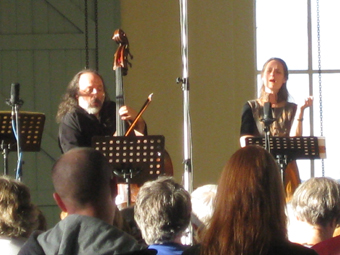
Jouissance, Kassia
photo courtesy of CIMF
Jouissance, Kassia
The Melbourne group Jouissance is exemplary in this aspect. The group creates dialogue between ancient chant and contemporary culture. Here their focus was the medieval Kassia, considered the first female composer whose scores are both extant and able to be interpreted by modern scholars and musicians. The group interacts with, rather than replicates, early work. Artistic director Nick Tsiavos says that studying postmodern theory in the 1980s made him think hard about contexts—what era we live in, what our own ears and experiences bring to any interpretation. The result is a performance philosophy that sees historical interpretation transformed by contemporary zeitgeist.
Tsiavos’s double bass sometimes breaks with jazz-influenced riffs; Peter Neville’s playing of contemporary, conical ‘Ausbells’ and simple, hung pieces of sheet metal carry medieval resonance but allow a sassy exploration of contemporary mood. Anne Norman brings her generous, elastically expressive shakuhachi into the fold (this is Byzantium via Japan), whilst Jerzy Kozlowski’s canonical bass resonates to our more secular sorrows. Deborah Kayser’s soprano breaks and dives and flutters in an extraordinary free-form exploration of, and improvisation around, the emotions of the mystic Kassia’s text. At certain moments, I am quite sure Kayser’s body has become a shakuhachi, mimicking its tonalities and technique (tonguing, fluttering, and shaking). This body and voice become the temple of Kassia’s prayers.
Significantly, Jouissance’s primary modality is improvisation, which was not a key element in this festival. Because this group is so practised in the art, it achieved alchemical transformations, which I would not say was always the case in the themed concerts such as “In Praise of Water.” It moved from composed mantras interspersed with improvised reveries, to one of Copland’s aching prairie-calls, to a very moving, but traditional rendition of Waltzing Matilda in a curious sequence that almost came off. By his third improvised interlude, Bill Risby developed some very interesting reflections on the preceding musical themes, yet I sat within an experience that felt thematically controlled, not musically released.
The standout in this very concert, however, by the festival’s resident composer, tells a different story. Ross Edwards’ The Lost Man (words by Judith Wright) is a delicate and demanding piece that sets up layers of listening in slow waves that build and recede and build again throughout. Edwards manages to gesture to the qualities and motions of water without pretending to make it. The piece harvested the piano; I heard it fill like a precious lake. Edwards writes about his compositional process as “an interplay of (materials) assimilated and interfused with sound patterns subconsciously gleaned from the natural world.” This suggests that for all his ideas, research and technique the composer allows something else to take over, relinquishing control.
It was good fortune the festival secured the Fitter’s Workshop, part of the 1920s Powerhouse Precinct in Kingston on the Lake foreshores of South Canberra—an enormous but welcoming, clear and fresh space of bright acoustic which many Canberrans hope to co-opt as a permanent performance venue. It was also exceptionally canny of Chris Latham to weave together the combined forces of amateur, professional and student choirs and orchestras—including the T’ang and New Zealand String Quartets, the Song Company, the Canberra Camerata, the forces of the School of Music, ANU—and other local professionals and composers, to weave a strong sense of support and community. The festival’s resources were bolstered by each concert having a personal sponsor from within the local community.
Much of the success of these concerts was due to the extraordinary abilities of Roland Peelman who could elicit both subtle and impassioned musical nuances from the professional and amateur instrumentalists, soloists and choirs, and somehow blend the voices. The grand finale of the Vespers, written in 1610, called for precise coordination between melismatic vocal lines and ostinato (provided by lute, contrabass and cello] and fine judgment in moving between different, complex groupings of voices, especially when in canon. The great unison “Amen” charged the room, as if the Age of Doubt, which began three centuries after its composition, never really happened.
In some concerts, but not most, one could feel the strain of attempting too much. Yet at their best, the combined forces achieved a translucent dignity—perhaps too the goal stated in Hexagram 16 of the I Ching: “harmony between Man, Earth and Heaven…a dance of Man with the Stars”.
Canberra International Festival of Chamber Music, May 14-23; www.cimf.org.au
RealTime issue #97 June-July 2010 pg. web
© Zsuzsanna Soboslay; for permission to reproduce apply to realtime@realtimearts.net
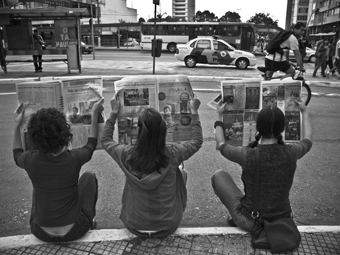
Out of Key(s), Opovoempé
photo courtesy of Opovoempé
Out of Key(s), Opovoempé
IN REALTIME 95 (“PERFORMANCE IN BRAZIL’S MEGA-METROPOLIS,” P42-43), CARLOS GOMES, A BRAZILIAN DIRECTOR BASED IN SYDNEY AND WORKING WITH THEATRE KANTANKA, REPORTED ON A RECENT VISIT TO SÃO PAULO, SURVEYING THE WAYS IN WHICH COMPANIES ARE ENGAGING WITH THEIR CITY, THEATRICALLY, POLITICALLY AND IN TERMS OF URBAN GEOGRAPHY. MELBOURNE ACTOR AND THEATRE MAKER JAMES BRENNAN RECENTLY VISITED THE CITY WHILE ON A KEITH AND ELISABETH MURDOCH TRAVELLING FELLOWSHIP. HE REPORTS HERE ON THE WORK OF THREE COMPANIES WHO CREATE WORKS IN WHICH THEY OCCUPY PUBLIC SPACE.
Whatever the country, theatre gives itself the mandate to claim space and to unravel that space in order to establish a relationship with those whom it seeks to make its public. I recently encountered three theatre companies in São Paulo, Brazil. What follows is an account of how each tackled public space, the audiences they found themselves ensconced with and the boundaries that marked their performances.
Compania Livre’s recent work was an adaptation of Dostoyevsky’s The Idiot, performed over three nights in SESC Pompeia, one of many SESC cultural sites found throughout São Paulo state (Serviço Social de Comércio is a non-government cultural network established in 1946 by the industrial sector). The site has a theatre space, but instead director Cibele Forjaz chose a large empty studio, adjacent to the theatre which has changed little since its past life as a steel drum factory. As one of Brazil’s most successful contemporary theatre directors, Forjaz has always had an appetite for unusual spaces. With her reputation she has access to a wide range of theatre venues in São Paulo, but continues to search out unconventional sites in which to house her visions.
In discussing The Idiot she said, “We wanted a space that held scene and public in connection…moreover, we required that as the spectacle developed, action could occur concurrently in several spaces.” This was achieved through a design which supported a number of overlapping performance areas, able to transform quickly, in keeping with, as Forjaz puts it, “the subjectivity of each character.” The success of Compania Livre’s well-integrated performance environment can also be attributed to the actors themselves. Accompanied by a musician and a small technical crew, they ran, sang, hovered, danced, washed and prayed the space into ever-new formations. When the work required the actors to articulate somewhat stylised moments, this was achieved with a sense of ease, as if an extension of their social selves rather than heightened performance personas. Furthermore when invited, the audience participated comfortably, contributing to an atmosphere of permission. In a characteristically Brazilian moment, audience joined actors as they sang a well-loved bossa nova song during the moving climax. Tears rolled on and off stage and in that moment I was a firm believer in “freedom inspires freedom.”
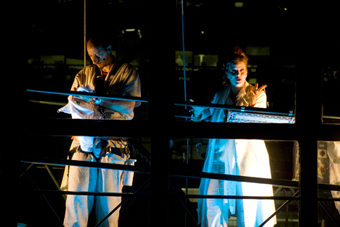
Kastelo, Teatro da Vertigem
photo Angelo Lorenzetti
Kastelo, Teatro da Vertigem
Another company which chose to forego the conventional performance space offered at another SESC site is Teatro da Vertigem (RT95, p42). This time, the design and overall effect served to distance audience and performer. Given that the work was an adaptation of Kafka’s The Castle, Kastelo, this did not seem inappropriate, since the work is marked by an inherent sense of distance. Kastelo was exactly the sort of work I was hoping to see in São Paulo—risky site-specific.
Performed on the outside of the SESC building by actors on moving window-cleaning platforms, the work was viewed by an audience seated on swivel chairs scattered throughout a disused office space on the fourth level of the building. The obvious risks of performing while suspended on cables were further emphasised by the actors, who, with an uncanny absence of apprehension, would jump off their platforms and hang from their harnesses. As the work developed, there was an increasing amount of head banging against the glass, sometimes done by swinging from a distance, which resulted in one of the actors dangling, upside down and bloody for long periods. Eliciting moments of empathy, ultimately Teatro da Vertigem was unable to bridge the gap between audience and actors. Like the protagonist, we also struggled to achieve meaningful contact.
Hand in hand with its commitment to exploring alternative arenas in which to perform, Teatro da Vertigem’s work has a strong social aspect. The company’s director, Antonio Araujo, listed projects which have engaged with locations in cities and rural areas and inside and outside various institutions. Recently the company commenced work on a project in Cracolandia (“Crack Land”), an area avoided by many São Paulo residents due to the high crime rate and drug use. As a consequence the work has the potential to offer new perspectives on an area with a strong negative ambience, inbuilt and palpable. As with many of São Paulo’ contemporary theatre works, the project will involve a significant period of research in Cracolandia itself.
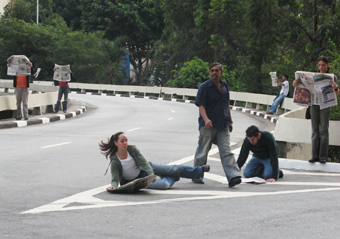
Out of Key(s), Opovoempé
photo Ana Carmen Foschini
Out of Key(s), Opovoempé
Opovoempé is a São Paulo theatre company whose agenda is focused directly on public space. Since its birth in 2005, the company has made a series of public interventions in locations including not just streets, fairs and squares, but also supermarkets, train stations and shop windows. Their works range from the overtly theatrical to the invisible, and draw on the legacy of cultural activism championed by the late Brazilian theatre maker, Augusto Boal. The company’s title (literally “people on their feet”) reflects its aims and “gives the idea of people moving, rather then riding or sitting. People in active existence or operation.”
The company states that their projects “aim to promote new relations between people and the space of the city, and are based in the exploration of the frontiers of the dramatic act.” With this premise they act to infiltrate chosen social settings to “subvert operating systems and alter the perception of participants.” Forty years ago such a statement may have made them a target for the Brazilian dictatorship, however these days their work resonates more as poetic provocation than political motivation and has received the support of the State Secretariat of Culture.
By offering new perspectives of shared space and interactions, Opovoempé illuminates the public lives of São Paulo residents and beyond. In doing so the company calls for vivid interaction with the spectator, to be “stimulated to perceive, see, imagine, interfere, create, act.” Such an active blurring of boundaries between art and life certainly fuels a fibrous artistic discourse and brings to mind the layered impact of Deborah Kelly and Jane McKernan?s powerful evocation of the Tiananmen Square protest, Tank Man Tango (RT93, p2-3).
With ever expanding public liability laws defining acceptable public activity, companies such as these three play an important role in questioning how we inhabit our environments and provide valuable stimulus for new perspectives.
I have always been intuitively committed to heightening the collision between theatre and life. Interacting with these companies in Brazil confirmed my belief in the critical need to deliberately exchange the space between the real world and theatre, in such a way as to confuse expectation. This may not only awaken the sleeper, but can also transform our cities and towns into places of social communion. By magnifying and directing performer ability to manipulate space, time and meaning, each of these companies illustrates the power of the individual to transform space and thought well beyond the walls of the theatre.
RealTime issue #97 June-July 2010 pg. web
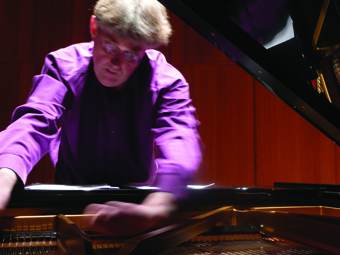
Roger Dean
photo Philippa Horn
Roger Dean
late night sonics
In the first of two collaborations with the vocal ensemble Halcyon, austraLYSIS presents Late Night Sonic Space in Sydney, July 31. Formed in 1970 and working with interactive and network technology since 1995, austraLYSIS has developed a number of innovative methods for controlling rhythmic, timbral and harmonic interaction. The program includes two purely electroacoustic works, one of them by Canadian composer Robert Normandeau; the premiere of Toy Language 1, composed by Roger Dean for mezzo soprano and Halcyon co-founder Jenny Duck-Chong, with live electronics; and a sound and text work called Clay Conversations 2, by Hazel Smith and Joanna Still (UK). There will also be the opportunity to converse with the creators themselves about their work after the concert. The program is presented by the New Music Network with the support of ABC Classic FM and takes place at the ABC Centre, Ultimo. austraLYSIS and halcyon, Late Night Sonic Space, Studio 227, ABC Centre, Ultimo, Sydney, July 31 10.30pm; www.newmusicnetwork.com.au
brodsky quartet, eddie perfect & topology
For some reason the Brodsky Quartet (UK) has surprisingly chosen to escape the northern summer for our winter. The quartet is playing a variety of concerts, though one of the most intriguing is the Songs from the Middle series of performances with Eddie Perfect and musicians from the Australian National Academy of Music (ANAM). Apparently it involves Eddie returning to his roots, and more specifically to the Melbourne suburb of Mentone, where entertainment includes the beach, the bowling club and, more recently, Bunnings. This bout of nostalgia has apparently been brought on by the arrival of a baby girl so perhaps the show will be a new father’s postmodern paean to working families moving forward. You can also see the Brodsky Quartet in concert with contemproary classical ensemble Topology, as part of the Brisbane Powerhouse’s OMG (Other Musical Genres) series. Topology have previously been described by Keith Gallasch as “a live working band with a casually theatrical and jazzy spontaneity.” (You can hear a sample of their work in RealTime’s first sound capsule here.) The Brodsky Quartet, Australian tour, July 22-Aug 8; The Brodsky Quartet, Eddie Perfect, and ANAM musicians, ANAM, Melbourne, July 25-26, Sydney Opera House, Aug 1, Brisbane Powerhouse Aug 6; The Brodsky Quartet and Topology, Brisbane Powerhouse, Aug 8.
sizzling new music at the bowling club
More music news…Ensemble Offspring first conceived of Sizzle as an alternative musical event for Sydney in winter, and better yet as a way of getting contemporary classical music out of the concert hall and into people’s Sunday afternoons. So each Ensemble Offspring member, Bree van Reyk, Veronique Serret and Jason Noble, is curating a musical event at his or her local bowling club (maybe Eddie could come). Noble started proceedings last month in Waverley, and van Reyk continued things this month in Petersham. For the final instalment next month Veronique Serret has invited The Noise improv string quartet, spoken word artist Eleanor Knox, CODA, visual artists and, of course, Ensemble Offspring, to play at the Camperdown Bowling Club. Ensemble Offspring and others, Camperdown Bowling Club, Mallett Street, Camperdown, Sydney, August 1
everyday crisis management
The phrase ‘human interest story’ brings to mind images of personal stories at the end of news broadcasts: babies, animals and, if you’re really lucky, baby animals—in short, everything you’re supposed to avoid in show business. That said, it’s also a catchy title, especially for a show that promises to investigate the relationship between the medium, the message and the mobilisation of empathy. Lucy Guerin’s latest show, commissioned by Malthouse Theatre and the Perth International Arts Festival, “explores our shared consumption of media news” and the “personal impact of the global crises delivered daily to our doorsteps” (press release). Like much of Guerin’s work, surveyed in RealTime’s Archive Highlights here, Human Interest Story combines imagery, gesture and sound to almost surreal effect. Created by an outstanding ensemble of dancers and collaborators and featuring design by Gideon Obarzanek (Mortal Engine), lighting by Paul Jackson and a very special newscast by Anton Enus (SBS), Human Interest Story premieres in Melbourne before touring to Perth. Lucy Guerin Inc, Human Interest Story, Malthouse Theatre, July 23-August 1; www.malthousetheatre.com.au; Perth International Arts Festival Feb 11-March 7 2011
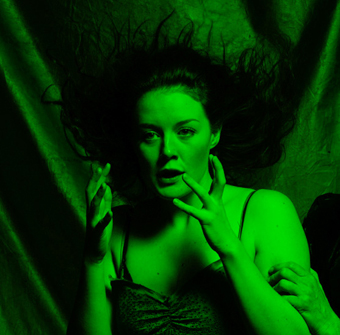
Jenny Kemp, Madeleine
photo courtesy of Malthouse
Jenny Kemp, Madeleine
contemplating madness
One issue that has often made the news over the past year is mental health, first when Professor Pat McGorry was appointed as Australian of the Year and then when Professor John Mendoza resigned from the National Advisory Council on Mental Health in frustration at the government’s efforts or lack thereof. Of course, themes of mental health and illness have a long history in art and theatre. One example is Jenny Kemp’s exploration of loss, longing and mania in her 2008 work Kitten. This month, this adventurous writer-director of dream like performance works mounts the companion piece, Madeleine, at Arts House, Melbourne. Madeleine is turning 19 and starting to show signs of schizophrenia. As she disintegrates mentally so too does her family, and together they are thrust onto the path to tragedy. Madeleine “brings the uncertain world of mental illness into presence, for contemplation. It provides a space within which these concerns can become a reality—a poetic reality of beauty, humour and horror” (press release). Jenny Kemp and Black Sequin Productions, Madeleine, Arts House, North Melbourne August 3-8 https://www.melbourne.vic.gov.au/ArtsHouse/
computer gaming on in launceston
If you missed Game On, the exhibition devoted to the history of video games curated by the Barbican and hosted in Australia by ACMI in 2008 (RT84, p.29), then you might want to catch Game On 2.0. This new exhibition is having its world premiere at the Queen Victoria Museum and Art Gallery in Launceston. While the new version includes several new pinball machines and arcade games from the past, it also shows off the Virtusphere, which is apparently “the best locomotion interface for virtual entertainment.” Game On 2.0, Queen Victoria Museum and Art Gallery, Launceston, July 3-Oct 3, http://www.qvmag.tas.gov.au/gameon/
live-in performance art
Anastasia Klose has been sitting in bed since July 9 and will continue to do so until August 8. If you want to see her, she is at the Australian Experimental Art Foundation, Adelaide. But she’s not just sitting, she’s also writing, typing her thoughts onto her laptop. These musings, which shift from the banal to beautiful and back again (“Staring…Checking phone,” “you must never admit to your mistakes, you must instead claim them, as if you intended them,” “The anxiety of a white screen. Here is my new performance. Sit for 5 minutes without typing. Starting now. 3.04”) are then projected onto the white wall behind her that also serves as a bed head. The performance, titled i thought i was wrong but it turns out I was wrong, is accompanied by an essay called In bed with Anastasia: intimate strangers, written by Larissa Hjorth. Anastasia Klose, i thought i was wrong but it turns out I was wrong , Australian Experimental Art Foundation, July 9-Aug 8 http://aeaf.org.au/exhibitions/10_klose.html
RealTime issue #97 June-July 2010 pg. web
© RealTime ; for permission to reproduce apply to realtime@realtimearts.net
Vinyl 7”, Independent Press, IP02
www.iebrisbane.com.au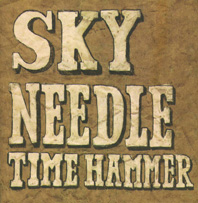
Sky Needle, Time Hammer
Fortuitously, Sky Needle’s 7″ vinyl disc Time Hammer arrived on my doorstep just after I was given a turntable (having been bereft of one for the last decade). While the group Sky Needle was not known to me (named after the Brisbane architectural folly built for Expo 88 and then purchased by millionaire hairdresser Stefan), two of its three members, Joel Stern and Ross Manning, are Brisbane experimental music stalwarts and they have found a kindred spirit in visual/sound artist Alex Cuffe.
Each plays a curious home made instrument—Stern on “latex pump horn,” Manning on “elastic dust shovel,” and Cuffe on “speaker box.” The result is a joyous, wonky kind of sound, curiously reminiscent of 80s post-punk, crafted into two reasonably tight tracks that are not so much funky as kind of…thunky.
This is a music in which the raw materials of the instruments (including elastic bands, a kitchen dust pan, old speaker housing and lengths of garden hose) are allowed to shine, introducing alternate harmonics and tasty timbres. The plunky twang of Manning’s dust shovel wraps around the chewy rubberiness of Cuffe’s speaker box, punctuated by the nasal honks of Stern’s footpump operated horns (a much more pleasing tonality than a stadium full of vuvuzelas).
Side A offers “Sweet 16 Snorks” which starts with driving buzzy bass notes that play in and around the higher string line, offset by staccato horn hoots and clanging pulses. This weighty intro quickly shifts into a higher, looser and lyrical interplay of strings and horn swoops, only to shift again into a third section of more agitated rhythms, handclaps and jangles. There is a real agility to the structural shifts in this piece, evincing the experience of the artists.
Side B gives us “The Stain” which offers a looser approach with minimalist rhythm figures, occasionally hinting at dissolution, which unevenly accumulate until an abrupt halt. I wish Time Hammer had been a 10-inch single so I could really see where “The Stain” might go.
Almost danceable and strangely cute, Sky Needle’s Time Hammer makes a fine start to my contemporary vinyl collection.
Gail Priest
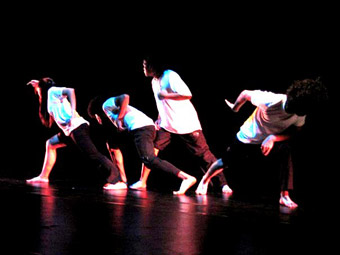
From Betamax to DVD
photo Phalla San
From Betamax to DVD
ONE HAND, BENT SEVERELY AT THE WRIST, PRESSES RIGIDLY AGAINST THE CHEST, WHILE THE OTHER IS LOWERED BUT ALSO ANGULARLY BENT AT EVERY JOINT. TORSOS ARE THRUST FORWARD, AND ALL THE WEIGHT OF EACH BODY IS DRIVEN INTO THE LUNGING FRONT LEG, WITH THE OTHER ALSO BENT AND SLIGHTLY OUTSTRETCHED BEHIND. THE HEAD IS TILTED TO THE SIDE, SEEMING TO LOOK AT THE AUDIENCE SIDEWAYS, AS IF WARILY ASSESSING HOW THEY WILL BE ASSESSED IN TURN. FROM THIS STANCE, THE SIX DANCERS IN JECKO SIOMPO’S FROM BETAMAX TO DVD PERFORM FAST, VERY PRECISE, UNCONVENTIONAL MOVEMENTS, STEPPING IN AND OUT OF COMPLICATED PATTERNS WITHIN INDIVIDUAL FLOOR SPACES, EACH TWISTING A KNEE SIDE TO SIDE AS THE FOOT IS LODGED FIRMLY ON THE GROUND. THEY STOP AS ABRUPTLY AS THEY STARTED, THEN BEGIN AGAIN, EACH SEQUENCE DICTATED, OR EVEN ACTIVATED BY, A VOCAL SIGNAL FROM ONE OF THE DANCERS, A YELP OR BARK OR A SHORT, SHRILL CRY.
Every now and then, one or more of the dancers breaks out of their staggered line with an outburst of emotion, a comment to a fellow dancer, another version of the same fast angularity or a completely different, exaggeratedly sinuous movement. But they all return to the original stance, sometimes of their own volition, sometimes to a reprimanding hiss from dancer and choreographer Jecko Siompo. From Betamax to DVD was premiered in 2009 and shot Siompo to stardom not only as a ground-breaking local choreographer, but also as one of “20 Young People in Indonesia Who Have Made History.”
Siompo was the first choreographer featured in the final program of the 10th Indonesian Dance Festival. The bill also included works by Eko Supriyanto and Vincent Sekwati Koko Mantsoe. The trio was a particularly interesting closing line-up: two very different works from major Indonesian choreographers and an invited dancer/choreographer whose work is also vastly different yet exhibits values evident in the preceding pieces. None of these are show-stopping, bravura numbers, which would be the case in a festival in the Philippines, where I’m from, which is why I think this line-up says much about Indonesian culture.
Siompo and Supriyanto’s works, although not similar at all, seem to represent what Indonesian contemporary dance is currently all about. While one is a stream of fast-paced, repetitive movement and the other often has barely any movement at all, they both appear to be manifestations of ideals evident in the previous day’s showcase of emerging choreographers. Indonesian audiences, I have found, appreciate the slow-moving contemporary pieces that make you think, and they are, I’ve been told, rather fond of discussing a work’s meaning after the curtain goes down. The rousing applause that followed all three final night works suggested this might be the case.
Eko Supriyanto’s Home: Ungratifying Life starts with the choreographer crossing the stage with an almost agonizing slowness. Halfway across, he adds a small crouch before the next step, a small lift of an extended leg before the next, a small twist of the body, and so on. All this time, he is enveloped in silence—or rather the annoying clicking of too many audience cameras in a frenzy to capture his every move. But he rest of the piece is “performed” to high-pitched singing and a deafening, incessant whine from the sound score, as different characters approach a wooden frame hanging front and centre—an old, weathered angel, two near-naked men, a man in a pink tutu and a girl walking a dog. They look out from behind the frame as if from a window, peering at the audience as we inescapably stare back. The man in the tutu, revealed to be the source of the relentless singing, pauses only to rudely ask, “What are you looking at?” From a choreographer who has danced for Madonna and appeared in films, Supriyanto is obviously questioning such scrutiny and what all the hoopla is about. What I find compelling is that the audience gets this.
It appears that younger dance practitioners in Indonesia also get what Supriyanto and Siompo are saying and are applying these ideals to their work. The Emerging Choreographers showcase displayed these aspirations. For example, I could see an impulse from the younger choreographers to pepper their works with Javanese poses and gestures, to the same degree that Siompo has drawn from his native Papuan dance forms and reconstructed them to create his own movement. There is also a need to provoke, as Supriyanto does, even if the challenges posted by the younger choreographers are not yet as mature—or as taxing for their audience.
But there are promising ideas, especially from Santi Pratiwi, whose Retorika Kerinduan adequately captures the disquiet of a village whose former inhabitants have all moved to the city for supposedly better opportunities, as well as Joko Sudibyo, whose Cekrek is an engrossing peek into the kind of drama that only goes on inside one’s family home. The movements in Retorika Kerinduan cleverly delineate the differences between village and city—getting away from the city is depicted by running around the ‘village’ at top speed while the ‘city’ captures the villagers with lethargy. Given more time for development, Retorika Kerinduan could be even more striking. In Cekrek, I particularly liked the sharp contrast between the four young boys, who all moved with fluid vitality, and the crying woman whose few moments of dancing were caricatured for comic effect. Perhaps I would have better appreciated the work if I’d understood what she was saying as blithered away to the audience in a local language. Nevertheless, the images had great strength.
In the case of From Betamax to DVD, which I first saw last year, the festival also provided the opportunity to see a work that has been further developed. I detected an increase in the tension between technology and tradition in the updated soundscape of spliced engine noise (cars, planes, machines) and electronics (network buzz, connecting modems) and the stronger responses of the dancers to the score. Perhaps Siompo was pushing this tension more to the surface, or I was more aware of it on second viewing.
Other changes were less successful, with the dancers showing more personality and given more opportunities to dominate Siompo in his role as the outsider. Last year, he was in control—the performers moving in unison and in staggered groups, but always returning to the line at Siompo’s barking command. In this “improved” version it doesn’t seem that the dancers appreciate his presence; one girl even breaks formation to shriekingly chastise him. Perhaps the dancers, some of whom are making choreographic ventures themselves, are becoming more confident, finding their own voices—their yelps and screeches here growing louder and more consistent, symbolic evidence that the Indonesian dance scene is expanding and strengthening.
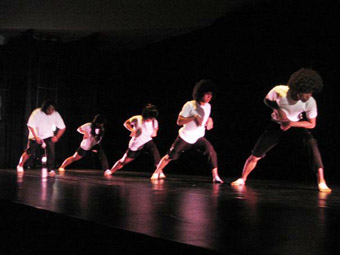
From Betamax to DVD
photo Phalla San
From Betamax to DVD
FROZEN IN TIME, FIVE DANCERS, IN PLAIN WHITE T-SHIRTS AND BLACK TRACK PANTS STAND IN A NARROW LANE OF LIGHT IN JECKO SIOMPO’S FROM BETAMAX TO DVD. A DIZZYING ELECTRONIC SOUND-SCORE REVERBERATES AROUND THEM. A QUICK TWITCH, HOP AND HIT FROM SITI AJENG SOLAEMEN AT ONE END GALVANIZES ANDARA FIRMAN MOEIS AND THEN JECKO SIOMPO (ALSO THE CHOREOGRAPHER) INTO MOVEMENT AT THE OTHER. SIOMPO JERKS OUT OF LINE AND MOEIS FOLLOWS ONLY TO BE HERDED BACK INTO PLACE.
With a loud yelp the dancers break into a litany of isolated movements: arm tuck, leg stamp, head jerk. At one count per movement, they dance at a bracing if predictable speed. The dynamic energy, vigorous dancing and clarity of movement in each shape is virtuosic and exciting, at first. But it continues in this vein for the rest of the piece, quickly shifting shapes at a fast and even rhythm, developing in a high impact but monotonous line—there is no climax, only abrupt stops and starts. It’s a long run-on sentence, barely punctuated by stillness and often underlined by yips and barks.
Yes, the dancers change formation and move in and out of the lane of light, but it’s basically different combinations of the same thing. However Siompo’s tackling a big topic: “the advancement of technology is a message from tradition” (program note), which is something you probably wouldn’t have understood if not for this one line synopsis. If the advance of technology is the move from one system to another, Siompo’s movements similarly change little to fit his theme. His movement language is a pronounced mixture of Papuan dance and hip hop, with the shapes inspired by Papuan animals (mainly the small kangaroo) and the rhythm consistently fast.
The driving force of Siompo’s movement dynamics and his use of universally recognizable sounds are part of his appeal to a global audience. These concrete sounds are also a major vehicle of communication in his work. The beep of electronics, the roar of traffic and the performers’ voices form a medley of the organic and synthetic. In this case the persistent switching of sounds is closely reflected in the changing dance formations, but the consistency of movement seems to indicate that although the world is constantly changing it remains essentially the same.
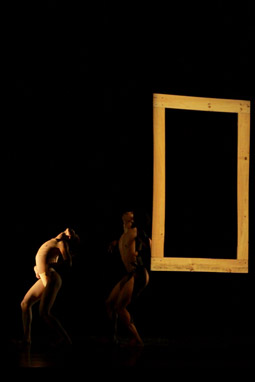
Home: Ungratifying Life
photo Phalla San
Home: Ungratifying Life
In contrast Eko Supriyanto’s Home: Ungratifying Life comprises startling images. Most of the music may be sung in traditional Javanese, a language that even in Indonesia few understand, but is overlaid with a high pitched, painful, piercing whine. The choreographer has cleverly blended east and west in his symbolism. Wearing a batik shirt and clunky boots, a long pony tail trailing down his back, Supriyanto walks very slowly across the forestage in a narrow beam of light. When he reaches the centre, he’s directly in front of a large suspended rectangular wooden frame. His arms move meditatively, fingers briefly flickering before his face. Then with his eyes looking straight through the frame, he backs towards the edge of the stage and falls into the dark auditorium.
In the blackness two white figures slowly appear to take shape, but they are one—a man in black with a pair of large, white feathered wings, perhaps a depiction of the angel of death, slowly walking to the frame. Here he stands for along time, his few moves a gradually morphing picture as he looks out into the audience—or is he framing himself? He retreats and two young men, wearing only jock-straps, bound into the light. Long arms flaying the air, they energise the previously quiet stage. Even in sculptural moments behind the frame and in rectangles of light their sinuous forms appear primal and strong, while their continual gazing upwards or long reaches down to the floor suggest an unseen spiritual realm.
The men are replaced by a woman walking quietly with her dog, displaying the strong bond between human and animal. They are accompanied by a man who, with his short cropped hair, thin moustache and gaunt body dressed in a neon orange tutu with frilly straps, makes a curious picture that is initially surprising but soon taken for granted. He sings but stops abruptly to provoke the audience, shouting through the frame “What are you looking at?” After which he calmly resumes his song and moves away into the darkness, the dog’s eyes following him, while the girl stands staring out of the frame into the distance, inexplicably serene. The dog seated by her side, without artifice, a symbol of domestication, is perhaps intended to remind us of our relationship with nature.
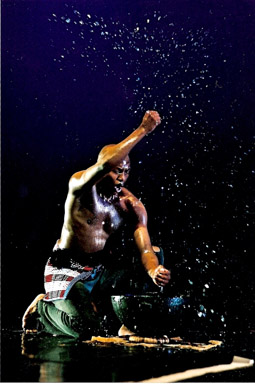
Vincent Sekwati Koko Mantsoe, Barena “Chiefs”
South African Vincent Sekwati Koko Matsoe’s Barena ‘Chiefs’ asks if power comes from the possession of symbols, like his ragged cape and stick, or if it’s inherent. Judging from the immense dynamism that he holds in check but releases at will it’s inherent in his case. His Afro-fusion (African and contemporary dance) style is emotionally expressive and physically demanding. Matsoe talks as he moves and the sounds of animals hooting and howling is underpinned by a strong beat that drowns out his voice, but the power in his furrowed brows and wide glaring eyes is clear. Later he droops as if defeated and drained, only to then grin widely as his feet and head move at a blur. Emotionally exhausted with him, I welcome Eric Satie’s soaring refrains that float over the stage, but instead of dancing to the melody, Matsoe confounds expectations by continuing with his own energetically rhythmic phrases. By ignoring the change in music he has kept the power and control firmly within his own body.
These three choreographers delivered humanistic and existential messages, each in an individualistic and surprisingly self-conscious manner. Each appears as the central figure in their own works, their bodies enabling the narrative. Siompo is the odd figure in From Beta Max to DVD, facing away from the rest of the group, a lag to his movements pulling him out of synch, exhibiting a rare awareness of the difference between himself and his younger counterparts. Supriyanto’s is the first body to peer through the frame at the pictures that slowly take shape on stage in his Home: Ungratifying life. His leap into the blackened auditorium aligns him with the audience and invites us to see through his eyes, which is also the function of his choreography. The crux of Beran ‘Chiefs’ is encapsulated in Matsoe’s on-stage figure, his body containing both symbolic and inherent power, his physical journey the vehicle with which the audience navigates the work.
In this closing performance for the 10th Indonesian Dance Festival—with its “powering the future” motto—these mature choreographers can be seen as representative of the ‘now’ of contemporary dance, examples for future generations of Indonesian choreographers to follow.
Excluding Boi Sakti, who last year announced his intention to stop choreographing, Siompo and Supriyanto are currently Indonesia’s biggest contemporary dance exports (the titles of both their works were in English and not culturally specific). If the selection of emerging choreographers for the festival is anything to judge by, young dancers and choreographers are getting the message loud and clear, showing marked tendencies towards high-art symbolism delivered at an elaborately slow pace or making an impact with a plethora of movement. But that’s to be understood, since learning often starts with mimicry. The real question is should there be more of it?

From Betamax to DVD
photo Phalla San
From Betamax to DVD
TO THE SOUND OF TRADITIONAL MUSIC AND IN GLOOMY LIGHT, THE FIVE YOUNG DANCERS—THREE WOMEN AND TWO MEN—OF THE JECKOSDANCE TROUPE LINE UP LOOKING TOWARDS THEIR LEADER, THE CHOREOGRAPHER JECKO KURNIAWAN SIOMPO PUI. THE SINGING CUTS OUT, REPLACED BY THE SOUND OF A STREAM. A GIRL AT THE BACK OF THE LINE MOVES FORWARD A FEW STEPS AND SWINGS HER RIGHT HAND. HER ENERGY SEEMS TO SWAY THE GIRL AT THE FRONT OF THE LINE CAUSING JECKO TO SWING BACK AND FORTH LIKE A ROBOT. HE SHOWS OFF HIS DANCE TECHNIQUE TO HIS TEAM, BUT THEY DON’T SEEM TO APPRECIATE IT. ONE CRIES OUT AND THEY MAKE THEIR OWN DANCE INSTEAD.
From Betamax to DVD is a multi-dance work that includes a synthesis of breakdance, acrobatic, robotic, traditional Papuan dance and animal movements—mimicking apes (bodies held low) and kangaroos (both hands held to chests), pushing and pulling each other to produce comic moments. Repeated, robotic action, also found in breakdancing, is common while other moves look athletic, as if the performers are preparing to run—a body bent forward, one leg stepped back, the other forward, bent at the knee,
The performers danced in line, broke from it and criss-crossed. But Jecko seemed to be trying to stay free of his colleagues. They tugged at his t-shirt, wanting him to join in, but he repeatedly pushed them away as if to resist modernity and its rapidly changing technology, to stay with Papuan tradition. Nevertheless he sometimes joined them, dancing in line, because there are some things you cannot avoid in a globalised world.
Dance movements switched fast to changes in light and sound, alternating between loud and soft: a mix of flowing water, car horns, helicopters, jet planes, computer sounds, electronic blips, waltz music, club music…This rush symbolized a rapidly changing culture where no one pays attention.
At the end, the dancers lined up again to face the audience, posing the same question: will Jecko accept modernization and leave tradition behind?
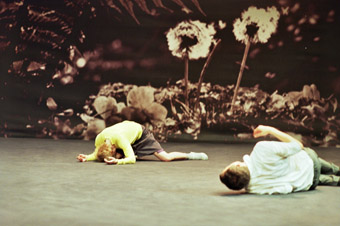
Maybe Forever, Meg Stuart, Philipp Gehmacher
photo Chris van der Burght
Maybe Forever, Meg Stuart, Philipp Gehmacher
IF YOU USED AN EXCITEMENT METER ON MEG STUART AND PHILIPP GEHMACHER’S CONCEPTUAL DANCE WORK MAYBE FOREVER, YOU COULD BE SURPRISED TO FIND THAT THE GRAPH YOU PLAN TO POST ON A WEBSITE, LIKE THOSE OF TWEET VOLUMES MANY SPORTS WEBSITES ARE USING, MAY LOOK QUITE FLAT. BUT THIS IS CONTEMPORARY PERFORMANCE IN WHICH, UNLIKE SPORTS EVENTS, WHAT’S HAPPENING DURING AND AT THE END OF THE SHOW MAY BE NOT SO IMPORTANT AS THE EFFECT ON THE AUDIENCE AFTERWARDS.
The stage of the Graha Bhakti Budaya auditorium is framed by semi-circular curtaining and is almost bare except for a low platform stage right, two microphones on stands, an electric guitar and a loudspeaker stage left, in addition to, upstage with a strong presence, a sepia photograph with two dandelions in focus against a background blur of trees. Stuart and Gehmacher begin with a slow duet amidst a brief series of low flashing lights. And that may be when the excitement graph rises to its highest. Stuart’s subsequent monologue—sweet sentences abruptly changed by the end clause “I take that back”—fills in the back story of a break-up.
What’s remarkable throughout the 80-minute performance is Stuart and Gehmaher’s frequent shifts to and from and blending of stage acting and dance, as well as from everyday to choreographed movement—the combination never risks being labelled pedestrian. One repeated gesture is what Stuart calls “long arms” in which the performers extend their arms and hands as high as they can to wave at each other. It’s like a special code that means something dear to the couple when they’re together but is painful after the split.
The same smooth mix of performing arts disciplines—in addition to life and art itself—is also evident in Niko Hafkenscheid’s live guitar playing and singing and Vincent Malstaf’s music and sound design. The music and lyrics are as melancholic as the performance, and since Hafkenscheid directly addresses us, they are sung for both performers and audience. After calling our attention to the performance at the start, Jan Maertens’s lighting design simply, and subtly, gives the limelight to the performers. His masterful touch shows at the final moment when the lighting delicately changes the photograph’s colour tone.
Heraclitus had it right two and a half millennia ago: change is the only constant. It just seems to me that when it comes to contemporary relationships, we change much faster than our patience.
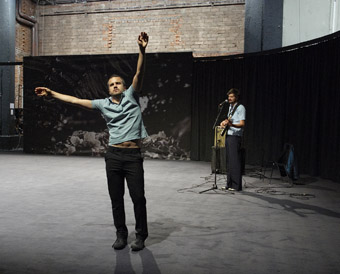
Maybe Forever, Philipp Gehmacher, Niko Hafkenscheid
photo Eva Wordinger
Maybe Forever, Philipp Gehmacher, Niko Hafkenscheid
What’s much more important than—I admit it—my failed romances is that in the 10th Indonesian Dance Festival it’s refreshing to watch a work by veteran artists who leave enough space for us to fully immerse ourselves in the work, add our interpretation to it and partake of individual journeys. After all, our experiences in failed romantic relationships vary. Monotonous can be engaging, mournful invigorating and mundane extraordinary. Such is life, and so is love.
One may argue that people go to performing arts events to experience what they cannot in real life—or, enough of early 20th century realism, please. In dance, they expect exceptional movement skills, for example. What they seem to forget is that sometimes we let life pass by without really thinking about it. Reconfirming that art is rooted in life, Maybe Forever allows us to do otherwise and hopefully, as we move on, not repeat a mistake, though knowing in the back of our minds that we probably will.
Maybe Forever is on a Southeast Asian and Australian tour, organized by the Goethe Institut, despite the fact that none of the artists are German (though Stuart is Berlin-based). Unfortunately, the only part of our country it crossed was the Gulf of Thailand last week on the group’s flight from Ho Chi Minh City to Singapore. Maybe Forever would have been a sizeable dance top-up for Bangkok audiences after the visit of Xavier Leroy last November.

Maybe Forever, Philipp Gehmacher, Niko Hafkenscheid
photo Eva Wordinger
Maybe Forever, Philipp Gehmacher, Niko Hafkenscheid
A COUPLE, TRYING TO SLEEP THROUGH THE EARLY MORNING, LANGUIDLY SEEK THAT PERFECT POSITION BUT FIND THEMSELVES SUBCONSCIOUSLY REACHING FOR AND GRABBING ONE ANOTHER, AND NOT-SO-SUBCONSCIOUSLY PUSHING EACH OTHER AWAY, OR JUST PRETENDING NOT TO RESPOND. PRETENDING TO SLEEP. PRETENDING THAT EVERYTHING IS ALRIGHT.
In Meg Stuart and Philipp Gehmacher’s Maybe Forever, the pair then sit with legs outstretched and backs to the audience, leaning to the side at the same angle, plagued by a weight that neither can ignore. The performance space is hazily semi-lit, reminding me of the way light creeps into your bedroom at dawn. There is little stylization in the way the couple suddenly grab each other and spread against each other full length only to discreetly remove themselves from contact to find another spot on the floor; but this push-and-pull feels like a dance.
The basic movement in Maybe Forever is built around a soft hunching of the shoulders, drawing the arms up and outward, or crossing over in front of the body, in a subtly awkward manner. Both Stuart and Gehmacher do this, sometimes together, sometimes by themselves, but regularly throughout the 80 minutes of the work. Audiences familiar with Gehmacher’s work will recognize this as his preferred style. I don’t know his purpose for such movement, but it feels very apt for Maybe Forever.
The movement I’ve described is first seen in the fourth segment of the work, when Gehmacher re-enters the stage, if hinted at by Stuart in the third segment. Right after the early morning ‘pas de deux,’ guitarist Niko Hafkenscheid croons a song to us with “maybe forever…” in the lyrics. Stuart enters, wearing a skirt and blouse under a thick leather jacket, faces the audience and speaks as if to a former lover: “Remember when I said I wish you were here? I take it back.”
She mentions many things she would rather take back from her relationship, and quite a few things that she decided she doesn’t want to take back after all. As she speaks, she makes one or two brisk movements with her arms to punctuate or even halt her sentences, echoing the work’s movement motif, if not always obviously. Each time she moves her arms, her jacket squeaks, suggesting that in these confessions Stuart is largely uncomfortable, just trying to give herself more room to breathe.

Maybe Forever, Meg Stuart, Philipp Gehmacher
photo Chris van der Burght
Maybe Forever, Meg Stuart, Philipp Gehmacher
As soon as she is done, Gehmacher enters, carrying another microphone stand, but instead of speaking, he abandons it for centrestage where he performs a solo, hunching his shoulders to direct the movement of his arms which rise and fall and cross, both limp and stiff, in front of his torso.
He joins Stuart, who is stretched out on an elevated platform on the left side of the stage and tries to lie with her. He gets up quickly, turns away and then returns. She moves away, turns back to give him a full embrace, falls away again. And so they continue their earlier duet more lucidly, with the push-and-pull more pronounced—and we finally see that this signifies an inability to embrace.
Later there are more serious attempts to embrace, more effort to make things work, but also more despair, and a stronger sense of sadness. Stuart walks offstage, away from Gehrmacher more than once. He ignores this the first time, follows her on the second instance, he does not go far enough, choosing to wallow in self pity, perhaps, by a concrete wall, shoulders hunched, rather than running to reclaim her.
Stuart returns, as if to give Gehmacher another chance, performing a solo as he stands alone in a far corner. By now, I feel quite agitated by this continuing dance of frustration, as if experiencing it myself. I find this quite brilliant; it’s not spectacular but it is definitive. I have to admit that all this time I am waiting for a happy ending, that I want the “forever” to be the inevitable, instead of merely possibile. But even after the pair find each other in a successfully complete and tight embrace, he then fails to register where she goes next, never mind that she is constantly looking back to him, beckoning.
In few words and little movement, a relationship and everything wrong with it has been transformed from private memory to shared experience. It is as if the audience has been on this journey with the dancer-choreographers, felt the same hope and frustration, the same love and loss of love. At the end, Gehmacher finally takes the microphone to haltingly tell us that he is “ready…now…to…” Obviously he is not ready after all, as he looks at Stuart—sitting calmly to the side and now in a bright orange dress—probably waiting for her to finish the sentence for him. But she doesn’t. She just looks back at him, with none of the previous sadness or frustration, not giving him another chance this time. I was not surprised at the eruption of applause as the lights went out.

Maybe Forever, Meg Stuart, Philipp Gehmacher
photo Chris van der Burght
Maybe Forever, Meg Stuart, Philipp Gehmacher
“….IT COULD BE HEAVEN/ BUT IF IT’S HELL THEN YOU CAN WATCH ME BURN” (OZZY OSBOURNE, “CENTRE OF ETERNITY). MAYBE FOREVER EXPLORES A FAILED LOVE, THE SLOW BURN OF A RELATIONSHIP YOU KNOW YOU SHOULD END BUT JUST CAN’T BRING YOURSELF TO. OVER 80 MINUTES, THE WORK IS LONG, SLOW PACED AND OCCASIONALLY AS CUMBERSOME AS THE CRUMBLING RELATIONSHIP IT IS ABOUT.
Choreographed and performed by Meg Stuart and Philipp Gehmacher, the work starts in the dark, with a brooding, evocative soundscape of electronic humming and clicking. After a long while, as low, flickering light grows unnoticed, two indistinct figures are glimpsed, reclining, sleepily shifting, and then touching and pulling at each other. The dark makes reading individual moves and contact more an act of imagination than of sight. As dawn arrives, we are lured inside a crumbling love story.
Suddenly the light is bright, revealing a small structure on the left, half bed half podium, giving the space the feel of a living room-cum-club. Curtains flank a large photographic indtallation at the back, depicting a fern and two dandelions, their luminous fuzz suggesting impermanence.
Meg Stuart launches into a repetitive recital of bittersweet and melancholic thoughts about the affair. “Remember when I said I couldn’t live without you?” she asks. “I take it back.” She takes back statement after statement, once manifestations of affection and passion. Her leather jacket creakes discontently with each of her movements and, gradually, words are overtaken by arm gestures which grow more and more abstract. Throughout Maybe Forever, arm movements and gesture convey much of the communcation between the two.
Philipp Gehmacher has a nerdy manner, awkwardly stumbling through a man-boy haze. He is stiff, speechless until the very end, unable to articulate his emotions. There are moving moments, for example when he stands at the very front edge of the stage, holding his arms high above his head as if waiting to be lifted up, his face bathed in a happy light of distant memories.

Maybe Forever, Philipp Gehmacher, Niko Hafkenscheid
photo Eva Wordinger
Maybe Forever, Philipp Gehmacher, Niko Hafkenscheid
The third person in the mix, singer-songwriter Niko Hafkenscheid accompanies the lovers on their journey, playing beguiling indie pop melodies on electric guitar, singing softly with a warm voice and modest manner. He seems to be the only unwounded soul in the drama, and as he suddenly speaks directly to the audience it becomes apparent that his melancholy music is never just for these lovers; their romance can’t even claim its own music.
There are moments of peace and harmony, Gehmacher sitting upright on the floor, Stuart lying down on her side, her head on his lap. Motionlessly, they listen to the singer playing the beautiful title song, watching the giant dandelions now glowing, lulling their broken hearts.
Soon the pleasure fades, and the tugging, caressing partners slip apart again. All their awkward grappling bears no fruit. In a world falling apart, bodily contact can only provide short moments of solace. Spoken texts and elusive song lyrics evoke sad obsession, futile hope mixed with painful awareness of failure: “Should we say our wishes at the same time so that we don’t hear each other?”
And as the woman tries to take everything back from the romance, and fails to do so, the music plays itself backwards, the melange of noises, voices and fragments of love songs airing an uncomfortable, frustrated longing.
In their character play of disjointed romance, the choreographers allow the work to have the time it needs. It’s not only the slow, meditative pacing that’s demanding for the audience, but also being witness to the agonizing and desperate disintegration of love and expectation. Maybe Forever, in it’s unhurried stillness, is scattered with broken physical exchanges manifest in gawky duets and solos, punctuated with short-lived moments of intimacy and passion. The complex movements of hands and arms caught in the ambivalence between self-protection and surrender are fascinating. These are bodies that have became foreign to each other.
At the end, the man stands alone on the stage. In loose, unskilled sentences, he acknowledges his loss and the impossibility of holding back the decay of love. He knows it’s over: “I have accepted the place I am in.” All three performers are now on stage, festively dressed, she in an orange, sparkling party dress sitting next to the singer with his shiny, deep-blue jacket; the man in black suit and bright yellow shirt, standing at a distance. They have given themselves a new beginning.

Maybe Forever, Philipp Gehmacher, Niko Hafkenscheid
photo Eva Wordinger
Maybe Forever, Philipp Gehmacher, Niko Hafkenscheid
NOTHING PREPARED ME FOR MEG STUART AND PHILIPP GEHMACHER’S MAYBE FOREVER. NOT THE INTRODUCTION BY DANCE SCHOLAR FRANZ ANTON CRAMER, LINKING THE DUO’S WORK TO 19TH CENTURY GERMAN IDEALIST PHILOSOPHY. NOT THE VIDEOS THAT HE SHOWED OF GEHMACHER’S WORK, IN WHICH SCATTERED FIGURES PERFORMED JERKY, APPARENTLY MEANINGLESS GESTURES WITH THEIR ARMS. NOT CRAMER’S DESCRIPTION OF STUART’S REHEARSAL EXERCISES (“IMAGINE THAT YOUR BODY IS DEAD”). AND CERTAINLY NOT REPORTS OF HOW BORED AND DISGUSTED AUDIENCE MEMBERS WALKED OUT OF THE GROUP’S PERFORMANCE IN VIETNAM.
All these established Stuart and Gehmacher’s work as cerebral, inaccessible and more than a tiny bit precious—”wilfully opaque,” in Cramer’s words. So I was stunned to find that Maybe Forever had an immediate emotional drive, a narrative about a pairing of man and woman—their impetus to come together as well as the forces driving them apart—as specific and heartrending as a play by Edward Albee.
The work begins with Stuart and Gehmacher lying centrestage before a large screen installation depicting ferns and dandelion clocks. The stage floor is laid with grey flocked carpet and circumscribed by a grey curtain on a rail. A small construction of shallow steps and a little ramp sit stage right, and a beige speaker, a guitar on a stand and a few chairs stage left. The effect is neat and spare but a little institutional, redolent of funeral parlours.
In the first scene the dancers remain largely on the floor, gaining momentum as they grab at each other, roll around, then fall apart. The second scene introduces the mediating third figure of folk rock singer Niko Hafkenscheid, whose melancholy rhythms defuse the sting of Stuart and Gehmacher’s physical encounters by translating their struggle into ballad form. Stuart enters wearing a blue leather jacket like the treasured remnant of a long lost boyfriend, and launches into a monologue of regret—“Remember when I said I would love you forever? I take that back”—punctuated by gesticulations of frustration.
Occasionally the work is quite snappy and responsive, but it is the slow thoughtful development of mood that predominates, and which so alienates some audiences. In between musical interludes, Stuart and Gehmacher meet in danced duets and perform their own solos, adding layer after layer to the tale of their interdependence, rejection, forgiveness and loss. At one point the curtain next to the screen is opened to reveal the bare bones of the theatre, and Gehmacher facing outwards, disconsolate and inconsolable. Stuart tries to embrace him, but the encounter, like so many others, fails.

Maybe Forever, Meg Stuart, Philipp Gehmacher
photo Chris van der Burght
Maybe Forever, Meg Stuart, Philipp Gehmacher
In the final scene, Gehmacher enters wearing a snazzy yellow jacket and tie. He speaks hesitantly into the microphone, as if composing and decomposing an uncertain eulogy in his head. “Losing you…made…me lose…so many things.” As he approaches his last line, Hafkenscheid and Stuart enter to sit stage left, Stuart resplendent in an orange sequined dress and white heels, like a bright promise of possibility. In the final moment, Gehmacher says, “Now…I…am ready….to say…” and without completing his sentence walks across the stage towards the seated couple, into the blackout.
Much has been written about the ghost in Meg Stuart’s work, and certainly Maybe Forever is crowded with references to the thing left unsaid, the elephant in the room never addressed, or the sense of loss. But to notice only these absences in Maybe Forever is to forget that they are only meaningful because what otherwise fills the blank is so powerful. In one instance, the two dancers stand next to each other facing upstage. Without looking at his partner, Gehmacher holds out a hand, and Stuart instantly grasps it, an automatic reaction to a gesture more psychically felt than physically observed. Gehmacher then abruptly walks away leaving Stuart standing. But while his head may be somewhere else, his body retains its memory. In puzzlement he looks down at his hand trailing behind him—had it been attached to something? There used to be a pressure there, of something warm and human, but now there is none.
A recurring motif in Maybe Forever is a dancer walking backwards making urgent come hither movements with both hands. When it first appears it is an empty gesture. The second time, Stuart responds to Gehmacher’s invitation by running towards him and jumping into his arms. This instant of connection lends understanding to the subsequent disconnection. When Stuart performs the movement again, we know what it means, and also what it means when the invitation goes unreciprocated.
In Cramer’s interpretation, when Stuart and Gehmacher physically meet, it feels so forced that it is a relief when they break apart. But without the instances of joining, although they may be awkward and unsatisfactory, the human figure alone is an empty cipher. “L’enfer c’est les autres” (“Hell is other people”), maybe, but they are also our only source of meaning, and Gehmacher and Stuart together are as skilled at building the sense of human connection as they are at suggesting its absence.

Maybe Forever, Meg Stuart, Philipp Gehmacher
photo Chris van der Burght
Maybe Forever, Meg Stuart, Philipp Gehmacher
IRREGULAR FLASHES OF DIM LIGHT ACROSS THE STAGE REVEAL AN ELECTRIC GUITAR, SPEAKER AND MICROPHONE STAND. THERE IS A SENSE OF LOSS AND ABANDONMENT HERE, INSTRUMENTS INCOMPLETE WITHOUT THEIR PLAYERS. A HALF-ROUND CURVE OF HEAVY BLUE-GREY CURTAINS PROVIDES AN UNUSUALLY SHAPED BACKDROP, WHICH AS THE FLASHING FADES TO DARKNESS AND THE LIGHT EVER SO SLOWLY GROWS AGAIN, WRYLY SUGGESTS AN EMPTY SMALL-TOWN CABARET LOUNGE.
A huge image of two dandelions blown in the wind is stretched wide in front of the curtains, echoing the sense of romantic longing that tends to linger in such an environment. Two figures are positioned centre-stage, sitting side by side on the carpeted floor with legs stretched out and backs to the audience. Slowly they recline in unison until lying submerged in their world. As the man apprehensively stretches his arm out to take the woman’s, their intimate interplay begins.
Awkward engagement and disengagement in Meg Stuart and Philipp Gehmacher’s Maybe Forever is at the core of this restless folding and unfolding duet. In every-day clothing they roll and struggle across the floor and stop for long periods, finding it difficult to make prolonged physical contact. The choreography has been given all the time and space it needs, allowing the work’s message to gradually and undetectably seep into the hearts of its audience like love-sickness. Penetrating insight into the nature of a steady declining relationship is delivered through the movement’s calculated clumsiness, which in its disregard of conventional dance codes provides an astonishing unpredictability.
Europe-based choreographers Meg Stuart and Philipp Gehmacher came together in 2007 to create Maybe Forever, which has been touring the world ever since and is performed as part of the main performance program of the 10th Indonesian Dance Festival in Jakarta. Although very different in their approaches to choreography, space and design, the two have arrived at a complementary meeting place that, unlike the disintegrating relationship they demonstrate, has proven to be a winning point of departure.
Stuart and Germacher are joined by Brussels-based singer-songwriter Niko Hafkenschield, whose shiny blue lounge jacket surreptitiously reinforces the tired pub-like environment. His sweetly melancholic series of indie-blues love ballads infuse the dancing with a fragile and delicate darkness. With his soft, vulnerable lilt he is a modern day angel of sadness—honest and open, almost unbearably so, in that his songs demand we be honest with ourselves.

Maybe Forever, Philipp Gehmacher, Niko Hafkenscheid
photo Eva Wordinger
Maybe Forever, Philipp Gehmacher, Niko Hafkenscheid
Stuart performs two text-based solos, each positioned at either end of the stage and spliced with abstract gestures, The first she presents in a skirt and heels, rather drab, the colour forgettable and the skirt awkwardly just-below-the-knee. She also wears a restrictive dark leather jacket, completing a rather incoherently assembled outfit. The loud squeaking of the jacket, amplified by the microphone, emphasizes the ongoing feeling of unease, of everything being not quite right. Interrupted by involuntary gestures and silences that drag her away from the microphone, her text (a repudiation of almost everything she liked about the relationship) is broken and incomplete. Right down to the very last detail, this is a tour-de-force of emotional struggle.
Gehmacher’s solo is performed in his signature style of timid apprehension, particularly in relationship to space. Shoulders inelegantly reaching for the ears and gawky transfers of weight as he walks from one position to the next create an uncoordinated language of movement that speaks volumes about his out-of-synch relationship with Stuart. It is almost as though he is embarrassed, self-conscious of the fact that there are people watching him. He pulls back the curtain and reveals part of the backstage area. Stuart enters and here they perform an ‘almost hugging’ phrase, manoeuvring around each other with difficulty, Gehmacher often failing to complete the touch. The cold black concrete of the theatre’s walls are exposed and so too is a cold and dying union.
The startling final act of the work plays out like a Lynchian memorial service, spooky enough to send shivers down my spine as I watch in disbelief. In a bright yellow shirt, black jacket and trousers, Gehmacher performs a final confession to the one he has lost about his failure to connect. He moves abstractly around centrestage and as he does so, a pre-recorded speech is laid over his performance, the text broken up, reversed and nonsensical. Without warning Stuart enters from the right in an intensely garish orange sequined dress, slinky and shimmering under the lights. We are caught off guard by this ‘over-excited’ outfit, which after the previous dowdy clothing makes an unsettling statement. Stuart takes a seat next to the musician’s speaker. He enters and stands behind her as if to claim her as his. Almost menacingly she simply sits and watches, looking ridiculously fabulous and no longer Gehmacher’s who is now out of his depth in this uncomfortable situation. And with a painstakingly slow lighting fade, this image is crystallized.
After seeing Maybe Forever I dreamt that I was having a conversation with the woman an ex-boyfriend of mine is seeing. She was crying hysterically, trying to make sense of their crumbling connection, demanding that I give her insight whilst simultaneously refusing to accept any advice I offered. For some reason this was all taking place on the sports field at my old primary school. This was an aptly surreal continuation of Stuart and Gehmacher’s performance which somehow managed to bleed further into my consciousness than I had hoped. Clearly, Maybe Forever affected me profoundly and like the memories of failed relationships will continue to stay with me, maybe forever.
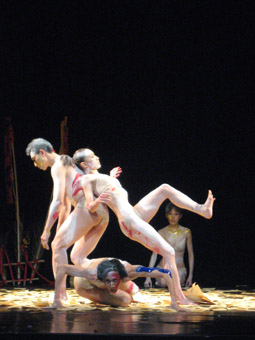
Middle
photo Phalla San
Middle
A MANDALA OF YELLOW SPIRIT MONEY COVERS THE CENTRE OF THE STAGE LIKE A YELLOW BRICK ROAD TO OTHER WORLDS. THREE ALMOST NAKED FIGURES STAND IN ITS MIDST, THEIR ENTWINED BODIES DAUBED WITH THE WHITE OF DEATH AND THE UNKNOWN. CLOSE BEHIND THEM, THE OBSCURED FIGURE OF A SHAMAN IS ENACTING AN ENIGMATIC RITUAL. GONGS AND BELLS CLASH. SUDDENLY, THE SHAMAN’S SHUDDERING HAND THRUSTS OUT BETWEEN THE CLOSE-PACKED BODIES, HIS SPLAYED PALM COLOURED A SHOCKING RED.
This exploration of the journey between this world and the next is Taiwanese choreographer Ho Hsiao-Mei’s short work Middle, performed by Cross Over Dance company on the last day of the 10th Indonesian Dance Festival. In a set rich with colour and texture—the paint on the performers’ smooth bodies, the yellow of the paper spirit money on the floor and the rough browns and reds of the wood and fibre constructions that the dances will shoulder on their spirit journey—Middle creates the dark, mysterious ambience of shamanistic ritual.
Taiwan has a strong tradition of shamans who connect with the spirit world, functioning as healers, diviners, mediums and exorcists. Some use self-mortification techniques, wounding themselves with symbolic implements and mopping up the blood with yellow spirit money (hence the use of red paint in Middle). Taiwanese shamans also employ stylised dance to establish a liminal sphere, a middle ground in which they and spirits may meet. Anthropologist David Jordan describes this as “an athletic ballet, magnificently rehearsed and enthusiastically performed.” Similarly, the shaman figure in Middle is unashamedly virtuosic, treating the audience to high leg kicks with strongly flexed feet, back arches and hand stands. Throughout his performance he stares fixedly into the centre of the audience, his mouth hanging open like the dark hole in a mask.
The other dancers, as pilgrims following the shaman’s lead, display a similarly impressive physicality. During one duet, a male and female dancer press their backs against each other, with one leaning forward and the other leaning back. They transfer their weight seamlessly until the dancer on top has one leg raised weightless in the air, entirely dependent upon the dancer beneath. To the sound of a chiming bell, the dancers slowly reverse their positions, creating a tipping see-saw that demonstrates absolute control.
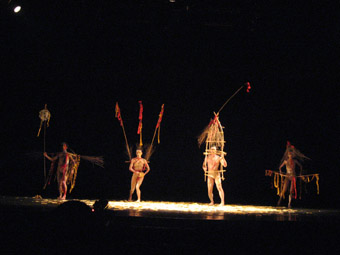
Middle
photo Phalla San
Middle
Middle clearly depicts the different stages of ritual, from separation from reality to the transitional traveling period. When a male dancer holds his partner under the armpits and swings her in a circle, the tips of her toes ruffle the spirit money, destroying the mandala and signaling the beginning of the next phase. The dancers head out of the circle to don extravagant costumes, whose frames suggest phantom hats, huts and warrior flags. Led by the shaman’s skeleton lantern, they pace around the edge of the stage. Every now and again they pause and look around, as if disturbed by the sound of unknown creatures assembling in the darkness.
The repetitive circumnavigation, the gathering gloom and the rhythmic clash of small bells lull the audience into its own trance. But unlike actual shamanistic rituals, Middle does not depict the ceremonial return out of liminality to reality. Having taken us to the threshold of the other world, the work abandons us. The dancers stop circling to stand in a line gazing out at the audience. Then the lights dim, and we are left alone in the darkness with all the phantoms they have conjured leering down at us.
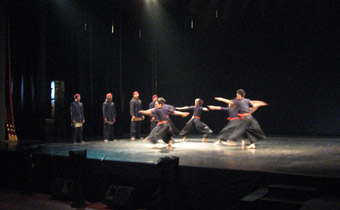
Seruan
photo Phalla San
Seruan
FOUR MEN STAND IN LINE SINGING AS THOUGH IN A TRANCE: “LA ILAHAILLALAH” (THERE IS NO DEITY WORTHY OF WORSHIP EXCEPT ALLAH). THEY WEAR RED CAPS, USUALLY WORN FOR PRAYING, AND BLACK SHIRTS THAT ADD A SPIRITUAL TOUCH TO THE PERFORMANCE. CENTRE STAGE, TWO DANCERS WEARING WIDE TROUSERS CALLED GALEMBONG MOVE TOWARDS THE SINGERS. THE FIRST JOINS THEM AND THE FIVE MOVE SWIFTLY SIDE TO SIDE. THE SINGING AND MOVEMENT GROW FASTER, THE OTHER DANCER JOINS IN AND EVERYONE MOVES IN A CIRCLE.
This moment is a crucial, symbolic part of the dance, blurring the boundaries between singers and dancers and heightening the spiritual mood. The singers and the dancers become one in a trance-like rhythmic state.
In another scene three people lie down in the centre, right and left of the stage. The central one is still as five chanting male singers surround him. He seems trapped, helpless, as though he cannot bear the weight of his “sins”—as the program indicates this work is about “the need for the return of lost conscience.” As the chant grows stronger, the other dancers rise up, but the first man does not move. The chanting perhaps reminds him of the causes for his state and what he must do to get back on the right path. This and the trance-like episode are the most captivating moments in Seruan.
Seruan elaborates the concern of the choreographer, Gusmiati Suid who died in 2001, about the dissolution of tradition and the disappearing influence of religion. Seruan is literally a calling to people to go back to their roots and not lose themselves to modernization. This dance work was revived for the opening program of the 10th Indonesian Dance Festival.
Along with Sardono W Kusumo and several others, Gusmiati Suid is one of the pioneers of contemporary dance in Indonesia. She uses the vocabulary of traditional West Sumatran dances in making her works, often combining them with Randai, a traditional theater form where the sound for a work is usually produced entirely with voice, hand clapping and the movement of the singers. Gusmiati Suid also included in her choreography aspects of Pencak Silat, a traditional martial arts with very dynamic movement, as well as Rantak, a folk dance originating in Minangkabau. This is why martial art footwork, with the legs widely spaced and hands moving swiftly as in combat, is seen from time to time in Seruan.
As well, the dancers often raise their hands, palms open towards the sky, as in Moslem prayer, symbolizing an appeal to God for the granting of wishes.
The dance also included elements of West Sumatran tradition. In the music we often hear the sound of Saluang in the background—a kind of traditional flute played using the pentatonic scale. For those who have been to the area of West Sumatra, the sound would remind them of the great mountainous area, the cool air and the vast paddy fields spread throughout the region.
Seruan ended optimistically. A man and woman take centrestage: both raising their hands as if towards God, answering to the calling of conscience and once again reconnecting with the highest form of being.
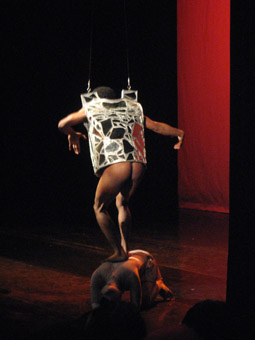
Merah
photo Phalla San
Merah
DIM LIGHTING BARELY DEFINES TWO ISOLATED FIGURES ON STAGE. THEY ARE A STUDY IN CONTRASTS, ONE FEMALE AND TIGHTLY SHEATHED IN WHITE FROM HEAD TO TOE, THE OTHER MALE, NAKED BUT FOR A LOIN CLOTH. STANDING AT OPPOSITE ENDS OF THE STAGE THEY DISTANTLY REGARD EACH OTHER.
This is Merah choreographed and performed by Asri Mery Sidowati, a recent graduate in dance art from the Institut Kesenian Jakarta and one of Indonesia’s emerging choreographers. The unsophisticated work shows a respect for tradition but fortunately does not take the hackneyed route of putting it on a pedestal and placing it in an antagonistic relationship with modernity. Instead we see a valiant attempt to make traditional elements part of her language of expression and not the object. The slow pace of movement and defined silhouettes in Sidowati’s choreography combined with the sound of traditional drums in Arif Susanto’s music provide a tribal, earthy feel, while tradition is also glancingly referenced in her costume. Inspired by Topeng Panji Indramayu (a traditional mask dance) the outfit tightly covers the performer’s body from head to toe, designed as a mask but making her an almost amorphous mass.
From the beginning this ever present masked figure introduces a menacing element of uncertainty. Fading light effectively hides Sidowati from view, revealing only the male dancer, Serraimere Bogie Y Koirewoa, frozen in a proud posture—but the knowledge of her presence remains. Soon the lights subtly illuminate her white silhouette in a flamingo-like stance, arms above her head, one foot raised to knee height. With no other distinguishing features, Sidowati’s image is a mystery that heightens the sense of foreboding.
Slowly a low drum beat reverberates to your core and a sprinkling of sounds evocative of the jungle permeate the senses, while the white backdrop is dappled with irregular shaped patches of light radiating out like the leaves of a tree. The shadows speckle Koirewoa as he wriggles, his dexterous fingers creating a mass of writhing worms that in the mottled light appear to multiply and grow, like nature itself.
The stage brightens revealing muscles so tautly held that Koirewoa appears almost skeletal as he gradually unfolds his limbs. His control and focus amplify each small movement into a luscious image. Jutting his neck out and rolling his shoulders back, he strains forward, nose leading like a beak; his elbows pulled back forming wings he becomes a preening bird. He then morphs into one ready for battle as his arms stretch out, fingers pointing high, preparing to charge. The white figure tentatively tries to copy him, seeming soft in comparison as she raises her arms.
Seeing these two ‘birds’ contrasted, one original and the other a poor imitation, I’m reminded in a flash of Hans Christian Anderson’s The Nightingale. This is a fairytale of an emperor who trades his live nightingale for a mechanical copy, only to find that the machine is far inferior and cannot bring him the same comfort. By presenting a face-off between the natural, embodied in Koreiwoa’s bared body and the artificial, represented by Sidowati’s obscured shape creates a binary opposition, the choreographer underscoring human indifference to rapid climate change and a deteriorating environment.
An angry red seeps into the backdrop as the two figures move towards each other. In slow motion Koirewoa creeps around Sidowati and then clings to her mid-section like a vine. He seems to engulf her, and yet he is powerless as she revolves, carrying him. Having moved the action to her side of the stage, Sidowati, the champion of the ‘artificial’ is winning, as the growing buzz of electronic sound testifies, drowning out the tribal drumming. To crown it all a hard armor-like vest descends, hovering above the pair. Covered with a mosaic of sharp edged shards of mirror, it glints harshly in the light, its patterns a mockery of the dappled ‘tree of light’ that earlier framed Koirewoa.
Completing the take-over, Sidowati offers herself as a platform for Koirewoa to climb up and don the vest. He rises high up, precariously perched on her back, and her control is admirable as she steadily holds the crouched position. Once in the vest, Koirewoa transforms into a mechanical bird; his arms jerk and flail robotically. Then he opens the his vest and we observe a spreading of wings, his twisting torso sending out spikes of light, piercing the stage and blinding the audience—creating a sad distortion of the first ‘tree’…the synthetic has wiped out the organic.
In Merah the choreographer’s intention to show the gradual eradication of the natural world is simply and perhaps too directly stated, the thematic opposition and its development appearing somewhat naive. However, while not intellectually challenging, the evocative sound score, effective lighting and the physical elements of the production, not least Koirewoa’s expert control, can be appreciated.
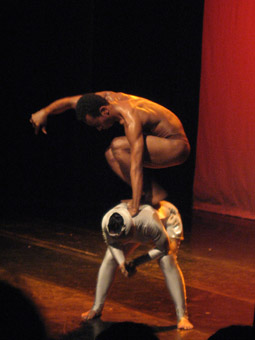
Merah
photo Phalla San
Merah
WHEN THE LIGHTS BLACK OUT IN INSTITUT KESENIAN JAKARTA’S TEATER LUWES ON THE SECOND NIGHT OF THE INDONESIAN DANCE FESTIVAL, AN ENVELOPING DARKNESS BLANKETS THE ENTIRE SPACE. IT’S EVEN MORE SUFFOCATING AS WE AWAIT MERAH, THE SECOND WORK ON THE PROGRAM. SOUNDS THAT YOU WOULD NORMALLY HEAR IN A FOREST OR JUNGLE IN THE DEAD OF NIGHT PIERCE THE DARKNESS. BUT WE SEE NOTHING, EVEN AS THE FAINTEST SLIVERS OF LIGHT GLOW ON THE STAGE.
The dancers are only very slightly illuminated by a smattering of light on the cyclorama that simulates moonlight shining through thick leafy branches. Because we had been in the darkness so long, I was not even sure if the second dancer, situated in an upstage corner, was indeed actually there; he seemed to blend into the cyclorama so much that my still-adjusting eyes were convinced that he was merely an image projected on the screen.
The other dancer, whom we later discover is Merah’s choreographer, Asri Mery Sidowati, stands at the opposite corner, nearer the audience. She is covered head to ankle in a shiny, metallic body suit. In contrast, the dancer upstage, who is not a hologram after all, is stripped down to the briefest of briefs. As he jaggedly moves to the sound of crickets and birds rustling through the night, it becomes obvious that he is meant to be of the earth—a primal version of man—while the figure wrapped in metallic cloth, who very slowly yet continuously moves her cradling arms in patterns around her body, might very possibly be otherworldly, a spirit but also possibly an alien. Given the costuming and my lack of knowledge of Indonesian mythology, it is difficult to determine which.
The male dancer has the more interesting movements: flexing and undulating, posturing sporadically in between, darting, flicking his fingers, shoulders and head almost as if in reaction to the sudden chirp of a cricket. After an eternity of this minimal movement from both figures, they edge towards one another, until they stand side by side with their feet wide apart. Together, they pull their heads back into a circular sweep, the man with his back to the audience, shoulders rippling with muscles as he does. Shortly after, they enter a common sphere, the man reaching for the wrapped figure and slowly wrapping himself around her midsection so they become one—an image sustained a little too long but allowing time for speculation. The man is not afraid of this otherworldly being, who, in return, readily accommodates him. After the performance, I overhear that she represents Mother Earth, but this didn’t occur to me at all since she moved into his space, merely visiting the world that he inhabited.
I see her instead as an external entity, and the male figure’s act of attaching himself to her as an exercise in empowerment, a kind of calling upon divine forces for strength. He climbs up on her back and is immediately garbed in a mirrored vest—a triumphant acquisition of power, exhilarating and uplifting, the glass shards flashing light over stage and audience. This invocation of a deity ends in triumph and frees man from the overwhelming, suffocating darkness with which the work began.
Later, however, I read the program notes and am entirely confused. It seems that Asri choreographed Merah as a commentary on Global Warming; the correct reading of the work would then be that grasping Mother Earth and stepping on her would be some form of abuse that she endures and even allows. The mirrored vest can then be read as an explosion of sorts—if we step on Mother Earth, we must be ready for the consequences. However, the work did not translate this threat clearly and, as I’ve pointed out, the tone of the ending was more inspiring than ominous.
Audiences may take whatever they wish from a particular work, and whether Asri likes it or not, her message will not always come across as intended. I applaud Merah’s journey from darkness to light, from gloom to triumph, and the slow, measured, unremitting pace that it took to get there.
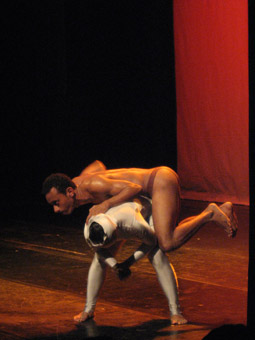
Merah
photo Phalla San
Merah
AT THE BEGINNING OF ASRI MERY SIDOWATI’S MERAH (RED), THE STAGE IS IN TOTAL DARKNESS UNTIL SEVERAL DIM LIGHTS ALLOW A GLIMPSE OF TWO FIGURES. WE SEE AN ALMOST NAKED MAN IN A LOIN CLOTH AND WOMAN WEARING A TIGHT DARK OUTFIT WRAPPED AROUND HER BODY FROM TOP TO ALMOST TOE, THE DESIGN MAKING IT IMPOSSIBLE TO SEE HER FACE.
In the background there’s a sound like a cricket, adding to a heightened sense of quiet. It’s as if we are being drawn into a jungle, but serenity brings with it a terrorizing kind of solitude. The stage is dark again. Gradually the sound changes to a kind of a heavy mumbling while scattered rays are slowly projected on the backdrop, like sunlight peeking through forest trees, but again suggesting stillness.
Originally a 2006 graduation piece, Merah was made during the hype of Al Gore’s documentary, An Inconvenient Truth. It tries to take us into the vortex of global warming, rain forest destruction and other environmental crises, although the elaboration of the work’s theme is not quite clear.
The almost naked man bends at the knees and crosses his hands in front of his chest, mimicking the flapping wings of a bird and symbolising hope or, perhaps, the birth of life itself. At first this ‘bird’ flies slowly and then faster and higher, so high that the man must let it go.
In another scene the stage becomes almost red, as if something bad is taking its course. The man squats as if great pressure is being imposed upon him, his hands pulled back, his face in grinning as if in pain. He bends lower and lower, moving slowly, meticulously transforming his pose, making the working of his muscles visible—a movement tradition rooted in the dance of Topeng Panji (Panji Mask) of West Java.
Towards the ending of Merah, the man wraps his body around the woman like a belt or a snake which she accepts with strength and without complaint. She bends as a vest descends, partially covered with broken mirrors. The man climbs onto her back and slips into the garment, scattering light through the theatre.
For the choreographer perhaps the male figure represents the human species while the woman is nature, bowing to man and subject to destruction. All aspects of the performance—its stillness, the low lighting and slow movement—conveyed haunting imagery if not making the work’s meaning finally clear.
![S]h]elf](https://www.realtime.org.au/wp-content/uploads/art/36/3671_giang_shelf.jpg)
S]h]elf
photo Phalla San
S]h]elf
IN THE MILD BLUE LIGHT OF THE DIM STAGE, TWO YOUNG WOMEN IN WHAT LOOK LIKE SWIM SUITS CRUISE ON WHAT APPEAR TO BE SHORTENED SURF BOARDS FRINGED WITH BLUE LIGHTS. SPINNING, GLIDING SOUNDLESSLY ON THE FLOOR, IT LOOKS LIKE AJENG AND ANGGIE ARE FLOATING IN A SWIMMING POOL, ENJOYING THEMSELVES ON A STARRY NIGHT.
S]h]elf, a collection of loosely bound short episodes, opens the second night of the 10th Indonesian Dance Festival. Next, the protagonists are busily quarrelling. Exchanging extra-large t-shirts they are soon entangled. Awkwardly bound they mouth Barbie doll interactions of the “I love you, but I hate you too” and the “Get away, but don’t leave me alone” kind. Welcome, say the program notes, to the world of South Jakartan, affable, middle-class youngsters.
Another scene has Anggie moving slowly from the periphery to centrestage, stopping after each little step, upper body leaning, shaking uncontrollably. Only her feet and fists are held firm, as if she wants to run away but can’t. She grimaces: is she crying or laughing? Is she drugged? It takes her an eternity to reach the front of the stage. Looking straight at the audience, she burps. “Give me a break. To hell with your social conventions,” she seems to say. In another episode, Ajeng turns a roll of toilet paper into a mock camera, ‘shooting’ the dozens of people in the audience whose cameras have produced endless clicking ever since the performance commenced.
Performed by Ajeng Soelaiman (born 1984) and Andara ‘Anggie’ Firman Moeis (born 1986), and choreographed in collaboration with Fitri Setyanigsih (born 1978)—all rising stars of the Indonesian dance scene—the work is fun, unfussy and has an air of ironic coolness. The set consists of two mobile glass revolving doors and metallic cubic frames hanging low from above, suggesting the worlds of entertainment and shopping. The performance is a self-portrait; drawing on their own lives the women play themselves, and they do so convincingly, with touches of self-irony.
What does it mean to be female, young, well-off and sophisticated in a Muslim society? At one point, Ajeng uses lipstick to draw a heart on glass, but her hand slips and the drawing becomes a confused mess of lines. Later, she stands in front of a glass door, facing the audience, in full evening dress. Radiating an amiable elegance, she bends to one side as if is about to dance. The music is a soothing, chill-out waltz. Gracefully, she raises her hand and gives the audience the finger. Or is the glass frame actually a mirror, and is she signalling self-disgust?
Whether rebellion or self-examination, it’s a fleeting gesture. At the end of the work, the two young women stand around a table of wine glasses, as if at a party. While Ajeng plays with two glasses, bored, pouring wine from one to another, Anggie, in a continuous slow motion loop, drains the dark content of each glass in a mouthful, throws the empty over her shoulder and reachs for another. There is no loud smashing of glass, no emotional crisis, no theatrical breakdown, just the embracing comfort of boredom. It’s the end of the party. Too tired for anything wild, the pair choose to stay in air-conditioned comfort, souls numb, surrounded by broken glass and broken hearts.
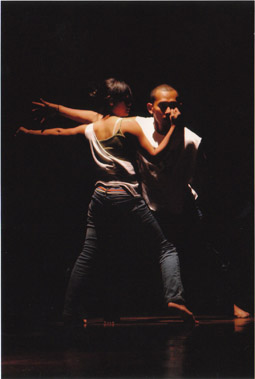
The Young
IN THE FINAL MOMENT OF THE YOUNG, A BOY AND A GIRL FACE EACH OTHER, BOTH WEARING A SNEAKER ON ONE FOOT, A SNEAKER ON ONE HAND. IN THE SILENCE YOU CAN HEAR THEIR PANTING. STRIPPED OF THEIR GRASPING AND POSTURING, THEY SEEM TO ACTUALLY SEE ONE ANOTHER FOR THE VERY FIRST TIME. THEN, TOO QUICKLY, THE LIGHTS CUT OUT.
To get to this final point of undemanding honesty, the dancers in Muslimin Bagus Pranowo's duet have to scrabble through a thicket of teenage angst. In a scene as bleak and empty as a nightclub after closing time, the two battle for the many pairs of sneakers littering the dim stage. The girl, performed by Maharani, wears the drainpipe jeans so favoured by the young. Hard eyed and hard mouthed, she gives as good as she gets. Being the first to wear one sneaker on her foot puts her in command. Wearing two sneakers, she assumes a tough-guy nonchalance, folding her arms and leaning on the boy as if on a sidewalk lamp-post, he bending in acquiescence.
The fast, aggressive movement, accompanied by a choppy and harsh electronic score, full of loud squawks and scratches, did not allow much leeway for subtle emotional expression. Nevertheless, the boy, performed by Muslimin, comes off as the more indecisive and piteous character, undermined by sexual frustration. Early in the work, he reaches through the girl's legs from behind and grabs her crotch, a gesture of aggressive lechery that she completely ignores. Later he fends the girl off and goes for a shoe, only to suffer sudden performance anxiety. When the girl lies on her back, sneakered feet in the air, he performs a short solo of agony; it is deliberately unclear whether he lusts after the girl or the shoes. When he finally does claim his own pair of sneakers, they fail to make him happy; rather than acquiring a sense of confident adulthood (feigned or not) as the girl did, he continues with the jumping, rolling, charging movement as if nothing has changed.
The sneakers are objects of fetishization, whose overt use—to protect feet—is overshadowed by their symbolic value: the possession of coveted material goods, the construction of an individual identity, maturity or sexual attractiveness. When they first encountered the shoes, both boy and girl were similarly perplexed. They seemed not to know what they were for, wearing them on their hands and pressing them to different parts of their bodies. What should be a display of bad breeding (proximity between shoes and heads in Asian cultures being extremely rude) is rendered instead as a moment of quiet intimacy. With the shoes to separate them, the pair touch each other as they otherwise cannot. Simultaneously, the thumping score descends into radio static, displacing the scene from the pressure of normal life. Suddenly realising what they are doing, the dancers freeze, then break away.
The movement vocabulary of The Young is appropriately transnational, almost unplaceable, but more similar to Western contemporary than any Indonesian cultural dance. Only one moment locates the movement within a distinctly Indonesian idiom. The two dancers crouch, proffering a sneaker with both arms fully extended towards the audience, their heads ducked down between their shoulders. In this stance one might present an offering to a king, especially if one had done something very wrong and was appealing for forgiveness. Oh, figure of authority, the dancers seem to plead, take away these shoes, this source of rancour and unhappiness that tortures us! But it is only a moment quickly washed away in an unrelenting wave of movement.
At 25 years of age, Muslimin already shows an easy ability to manipulate a variety of cultural movement vocabularies. The video projection element in The Young, however, was too diffuse and brief to have much impact, but the performers were confident and skillful, and the work explores a tightly coherent theme with insight and maturity. As part of IDF 2010's opening night, The Young is a strong representation from its namesake cohort as well as an illustration of the festival theme “Powering the Future.”
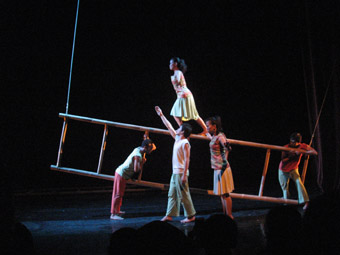
5,6,7,8
photo Phalla San
5,6,7,8
THE 10TH INDONESIAN DANCE FESTIVAL PROGRAM OF WORKS BY FIVE EMERGING INDONESIAN CHOREOGRAPHERS FOCUSED ON PERSONAL ISSUES INTERTWINED WITH THE VALUES AND NORMS OF INDONESIAN SOCIETY. THE CHOREOGRAPHERS COME FROM ART UNIVERSITIES AROUND INDONESIA: THE JAKARTA ARTS INSTITUTE (IKJ), ISI YOGYAKARTA AND UNESA IN SURABAYA.
Nur Sekreningsih Marsan’s 5,6,7,8 elaborates one person’s journey and their relationship with others. With ladders as the principal stage properties, the dancers are often placed in challenging circumstances. One part of the work requires two dancers to walk along the narrow length of the side of a ladder, the delicate balancing reflecting the difficulties faced in relationships.
Cekrek (Click) by Joko Sudibyo opens with a scene where a woman wearing a blue kebaya top and batik cloth sits down in the middle of a group in dim blue light. Her hair is pulled back and rolled into a big bun. It’s a look preferred by most Javanese mothers when posing for a family photo. Four young men wearing long sleeved white shirts stand before her. Slowly and gracefully, the woman stands. Gently moving to the right, she performs the subtle hand gesturing of Javanese dance. But as soon as she leave the stage, the four boys move about dynamically, the mood shifting from tradition to modernity.
This shift and its reverse occurs several times in Cekrek: in the next scene another man appears, bare-chested and wearing a batik sarong. He moves in traditional Javanese fashion with special precision and fluidity while the four boys circle around him. He then performs a duet with the woman in the blue kebaya before exiting. If she is an idealised mother the man appears to be a missing father figure.
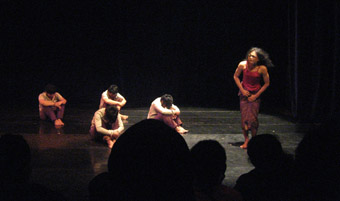
Cekrek
photo Phalla San
Cekrek
Next, another woman appears. Wearing a red tank top and batik skirt, she weeps with over the top exaggeration, complaining how hard she works and that the men in the family have done nothing to improve its condition. She represents the real life mother who is often frustrated by the family hardships.
Near the end, the idealized mother reappears, putting an abrupt halt to a chaotic situation. The real mother contains herself. The four boys tuck in their shirts, poke each other as though wanting to show the mother who’s to blame, and solemnly form a line with their mother. The idealized mother slowly sits and pulls out a camera. Without being commanded they all smile comically and wave politiely as their picture is being taken. One big happy family.
Cekrek very simply suggested the importance of the mother in a family. Her nonchalant presence is crucial, creating harmony while her absence yields chaos—a belief firmly held by most Indonesian families. The successful fusion of traditional and modern movement and its simple imagery made the dance a delight to watch.
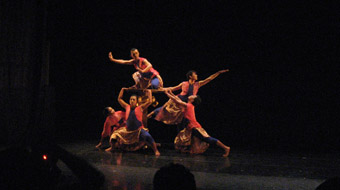
Gayaku
photo Phalla San
Gayaku
Shinta Maulita’s GAYaku focused on homosexuality. This piece couldn’t be more appropriate considering the current situation in Indonesia where the gay and lesbian movement is gaining momentum.
GAYaku opens with three men and a woman seated in a circular formation beneath another man sitting on top of a round platform. Squatting cross-legged, he flexes his right arm, making a gestures like those of deities in Hindu temples, while the other dancers circle him.
Live gamelan playing thickens the traditional ambience, with a male singer chanting in Javanese “a woman should be with a man; how it would be when a man decided to pair with a man, and a woman with a woman?”
GAYaku depicts the joyous decision of the men to embrace their sexual identity. Four men gather again in a circle, this time wearing glittering bamboo hats commonly used as rice baskets. They shake their bodies coquettishly, while forming a circle facing each other. One gestures as if applying make-up, his other hand holding an imagined mirror.
The festivities move into over-the-top celebration as the dancers invade the auditorium, shaking their bottoms. This “We’re gay and we’re proud!” mentality reflects life in many big cities in Indonesia where more and more men and women daringly come out, ‘boasting’ their gayness.
The last two works in this program were Retorika Kerinduan by Santi Pratiwi and Bunglon by Serraimere Boogie. The first is about urbanization, and the yearning to return to village life, while the other elaborates on the ability to adapt. Bunglon involved Papuan costume and a merging of Javanese and Papuan movement.
Overall this showcase of works by emerging choreographers demonstrates the effectiveness of dance education in Indonesia. It is also refreshing to see that tradition plays an important part in the work—having strong roots is always a good place to start.

5,6,7,8
photo Phalla San
5,6,7,8
WHAT? WHY? HOW? THE EMPTY STAGE IS A BLANK SLATE WHERE FIVE YOUNG INDONESIAN CHOREOGRAPHERS (FROM ART UNIVERSITIES AROUND INDONESIA: THE JAKARTA ARTS INSTITUTE (IKJ), ISI YOGYAKARTA AND UNESA IN SURABAYA) MAKE THEIR MARK. AMIDST MUSICAL CACOPHONY AND THE BLUR OF LIGHTS, LIKE ANYONE IN THE EARLY STAGES OF DEVELOPMENT THESE EMERGING ARTISTS SEE PATTERNS, QUESTION STEREOTYPES AND TRY TO FORGE IDENTITIES.
5,6,7,8
In the language of the dance world 5,6,7,8 means prepare. And you should, when a cycle of beginnings commences the moment the lights reveal two men bursting into explosive kicks and jumps to the creaking sound of straining wires. A ladder, over which the men move quickly and deftly, lies inertly on the floor beneath their feet.
In Nur Sekreningsih’s 5,6,7,8, sound loops shift from the resonances of traditional instruments to running notes on the piano to concrete sounds and back again. This musical history is mimicked by the dance movements, rotating between traditional, contemporary and folk, a formal construction that underpins the work’s theme: the cycles in relationships.
The dancers cover the space well with energetic leaps, conveying a strong sense of motion and interaction. Set higher and higher—on its side, sloping, suspended above the shoulders—the bamboo ladder allows varying forms of engagement and framing but is also a hindrance. The dancers are entertaining when they jump through the rungs or hang from the ladder’s uprights but, unfortunately, the increasingly precarious ‘tightrope’ act, performed at each level of the ladder’s positioning, misses the mark. The spectacle of the balancing act as the performer teeters on the edge of the ladder detracts from the image of the dancer as forward-looking—she is more tentative than progressive. Nor is it clear how this image of isolation relates to the cyclical nature of relationships.

Cekrek
photo Phalla San
Cekrek
cekrek
Exploring how family dynamics can affect identity, Cekrek is the poignant and humorous highlight of the showcase. Choreographer Joko Sudibyo’s choreography is an expert fusing of styles in which the wide stance, flexed feet and soft arms of Balinese dance combine with a jazzy influence evident in undulating bodies and quick rebounds off the floor. The all male cast confidently perform the steps, exuding a youthful precociousness that makes me smile.
Posing for imaginary portraits, four youths, neatly dressed in short sleeved, white collared shirts and brown trousers—a typical school uniform—freeze each time the lights flash. They are oblivious to the mother figure kneeling directly in front of them, her back to the audience displaying perfectly coiffed hair pulled back in a low bun and the blue lace of a Kebaya (blouse).
This woman rises gently and moves off-stage, the performer’s masculinity barely discernable, so delicate and poised are his movements. The eyes of the boys are glued to her as she exits but her absence releases them into a series of body waves—head, chest, belly, hips, lifted in successive sequences. They horse around, pushing and gesturing, isolated heads moving quickly from side to side, pointing (mostly with the middle finger), jabbing and thrusting, painting the air around them—their movements still suggestive of traditional dance. The boys appear to revel in their independence.
Is the bare-chested dancer who enters next a memory of an absent male authority figure? The four crouch around him as his back and extended arms move in sinuous ripples, as if jolts of electricity run through his veins. The ‘mother’ returns to the stage, and he dances with her in a strange duet, the relationship appearing to be that of human and ghost. He navigates the space around her, never making contact as she, seemingly unaware of his presence, makes her slow progress across the stage to exit. Then he too disappears.
Another female character enters, also a male dancer, this time with long wild hair, a pink tank top—showing off chorded muscles—and a traditional long cotton skirt tightly wrapped around the legs. This woman is a caricature, like a soap-opera mother. Unlike her silent counterpart, she wails melodramatically, stops abruptly turns to the audience, says she’s been “crying for three days” then resumes her squawking, half-dancing, half-sobbing around the stage.
Trying to shame the boys into reaction, this single mother (the program note explains that the woman is the family’s breadwinner) pulls her hair into a mad tangle, tossing and flicking it every which way, shouting in Bahasa that she deplores their ingratitude, for never thinking about her or the family. She yanks their heads back as she scolds and cajoles, but they ignore her, remaining inert, eyes closed. Later they gather behind her as she continues to jabber, pointing and gesticulating; naughty children mimicking a scolding parent.
Somehow order is restored when the genteel Kebaya-clad mother returns: the boys shuffle away, straighten their clothes and line up with the wild-haired mother. Suddenly, the genteel mother whips out a camera. Pasting on cheesy grins, cranky mother and sons pose for a portrait—the illusion of a happy family.
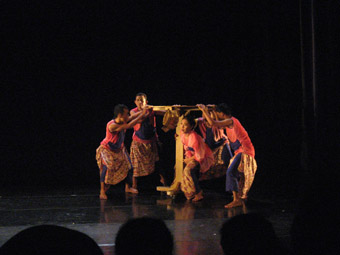
Gayaku
photo Phalla San
Gayaku
gayaku
This night’s program seems to be a re-contextualising of traditional Indonesian dance forms within a modern framework. Nowhere is this theme as clear as in GAYaku which starts quite traditionally—a man sits cross-legged, meditating on a shoulder high table under which people sit like ancient sculptures. From the edge of the stage traditional musicians play a haunting gamelan melody and chant in eerie unison. The dancers move through the strong poses characteristic of males in Javanese dance.
Part-way through, round gold, helmet-like hats with a protrusion on the crown are worn, then playfully cupped against chests, thrown in the air and turned upside down like bowls—Freudian symbolism perhaps of dual sexuality. Exploring the freedom of new gender identity, the male dancers perform traditional Javanese female movements; using soft fingers, vainly admiring imagined reflections, taking tiny, demure steps, they move the work to its campy ending.
To reach this freedom there must first be a moment of crisis. In the program note, female choreographer Shinta Maulita, writes, “I try to love the person I am supposed to love…but I can’t.” This might indicate that GAYaku is about Maulita’s frustrations, but it’s about much more. In a pair of duets, a male dancer partners Maulita. As they face each other, legs wide apart and hands outstretched, this traditional Javanese dance movement becomes the basis of missed kisses as the dancers’ faces bob and weave. The key image is of Maulita cradled, like a bride about to be carried over the threshhold. Lips almost meet but her partner’s eyes shift away, an expression of anguish and regret on his face. A male-male duet ensues, the dancers circling each other, legs moving closer but bodies stretching away in hesitation. In the end they embrace, faces frozen inches away from a kiss. Maulita’s work has brought the audience to the brink of a transition but by not taking the final step she keeps the work in the realm of pretense, and leaves the rest to the imagination.
In GAYaku, traditional movement becomes sexually charged: a basic shoulder roll, usually delivered slowly and with care, becomes a seductive shimmy; the wide legged walk with gentle hip sway turns into a booty shake as the dancers gyrate to the rhythm of the music. Finally, moving among the audience they blatantly flirt and tease, questioning and inviting.
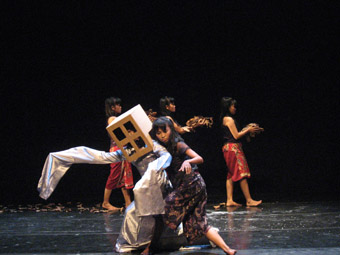
Retorika Kerinduan
photo Phalla San
Retorika Kerinduan
retorika kerinduan
Retorika Kerinduan is Santi Pratiwi’s discourse on increasing urbanization and the inability to assuage a longing for the old village life. A body is lit in the centre of the stage, no head or legs, just a back, naked but for streaks of metallic gold paint, pushing and heaving to ominous grating sounds. It is a man struggling to rise; distorted arms pushing outwards, he appears to be hatching from an egg. From deep in his throat come strangled sounds as he gasps for air. Kneeling in a semi circle, three women slowly bow their heads to the ground and, returning to the upright position, ritualistically repeat the movement. Perhaps the choreographer suggests that the worship of money is suffocating.
Near the middle of the work an image of human devolution appears. Almost as a footnote to a series of martial arts inspired, middling lunges and quick jabs, three dancers enter at varying heights, ranging from upright Homo Erectus to crouching monkey. The final image is of a silver robed figure with a cardboard box—shaped to represent a sky-scraper—on his head, a woman at his feet. Behind him the trio of women move as if in a funeral procession, dropping brittle brown leaves, mourning encroaching urbanisation.
bunglon
The final work, Bunglon (Chameleon), is an oblique criticism of the hypocrisy and Machiavellian attitudes of opportunists in politics and entertainment expressed through a mashing of cultures. The dancers are adorned with feathery headpieces and similar arm-bands. In a nod to hip-hop couture they hike up one pant leg and near the end of the work add a sneaker, while painted flames—vibrant tribal-like tattoos—lick up the sides of their exposed calves. Serraimere Boogie Yasson Koirewoa’s choreography is a reflection of this blending—hip-hop grooved traditional dance gestures. The images are not particularly symbolic but the permutations of movement formations suggest the easy adaptability of a reptilian species.
The movement language of the works in this program may not have been particularly original and I’m bemused by the overabundance of images and occasional mixed metaphors. Most of the pieces rambled in their search for cultural and individual identity, but this is a forgivable short-fall in the work of young choreographers. They were well served by a high level of physicality and commitment from all the dancers. These choreographers are off to a good start in defining their styles. Perhaps I was impatient only because youthful confusion is catching.
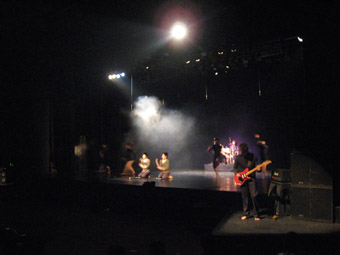
Darkness Poomba
photo Phalla San
Darkness Poomba
DARKNESS POOMBA BEGINS WITH TWO MEN STANDING STILL IN LOW LIGHT. ONE PLACES HIS HAND ON THE OTHER’S FACE; HIS COUNTERPART RESPONDS WITH THE SAME GESTURE. THE INCREASINGLY FAST ACTION BETWEEN THE TWO IS ACCOMPANIED BY THE STRONG VOICE OF A SINGER OCCUPYING THE SAME SPACE AS THE AUDIENCE. HE PERFORMS A TRADITIONAL WORDLESS SONG USED FOR FESTIVE OCCASIONS AND ALSO BEGGING. SUDDENLY, STRONG LIGHT REVEALS DANCERS RESPONDING WITH LIVELY MOVEMENT TO POWERFUL RECORDED MELODIES AND THE LIVE SINGING. BRIGHT LIGHT ALTERNATES WITH SOFT AND THE DANCERS MOVE SLOWLY TO THE FORCEFUL RHYTHMS OF THE SINGER. AT THE END LIVE ELECTRIC GUITAR, BASS AND DRUMS COMBINE WITH THE POWERFUL DANCING TO GENERATE A GREAT SENSE OF EXCITEMENT.
This is Darkness Poomba the last of four contemporary dance works performed to celebrate the opening of “Powering the Future”: the 10th Jakarta International Performing Arts Festival (IDF). The audience cheered, clapped and rocked to the 11 young dancers, musicians and vocalists from South Korea directed by choreographer and composer Kim Jae Duk who also performed as dancer, musician and singer. The combination of elements was dynamic and vigorous—while my hands were busy taking notes, my head and torso unconsciously swayed.
Beneath bright lights, the dancers committed body and limb to fast moves, shaking and leaping in a combination of modern dance, breakdance and acrobatics alternating with slower movement. From the moment the dancers were joined by the guitar players and drummer the work became larger and more dramatic. While the stage was filled with dynamic dancing, the choreographer joined the singer in one aisle of the theatre, singing and playing a mouth organ, while the two men who opened the show repeated their slaps and grabs at speed in the other aisle. The audience clapped and swayed, screaming their satisfaction.
The perfectly synchronized dance movement in Darkness Poomba and the beautiful and powerful live music made for an attractively dramatic and dynamic work. Although titled Darkness Poomba, the strong lighting not only distinguished between scenes but also suggested a brighter spirit.
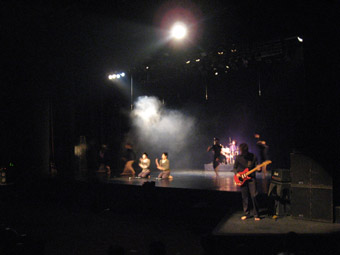
Darkness Poomba
photo Phalla San
Darkness Poomba
AN EERIE, LOUD NOISE WAS HEARD DURING THE INTERMISSION FOR THE OPENING DAY’S MAIN PERFORMANCES AT THE 10TH INDONESIAN DANCE FESTIVAL (IDF). PERHAPS IT NOT ONLY SIGNALED THE AUDIENCE TO RETURN TO THEIR SEATS, BUT ALSO HINTED THAT KIM JAE DUK PROJECT’S DARKNESS POOMBA FROM KOREA WOULD LOOK AND SOUND VERY DIFFERENT FROM THE INDONESIAN CONTEMPORARY DANCE WORKS IN THE FIRST PART OF THE EVENING.
As the house lights dimmed and the curtains parted, we saw an electric guitar and bass on either side of the front of the stage, and upstage centre a drum set—to the delight of many dance audiences who prefer live to canned music. No musicians though. As two dancers moved downstage centre, we became aware of a singer behind a microphone in the house right aisle. The lyrics were in Korean, we thought, and that’s when some of us couldn’t help ignoring them, despite the singer’s vivacious hand gestures. And so music might suddenly become noise. Later on, the musicians took their places and, for a brief moment, the dancers stopped moving, giving the focus to the music.
Most of the time, though, the performance was multi-focus, attempting as it did to involve the audience—one dancer came down from the stage and up the house right aisle to sing and play instruments, while another two used the left aisle as their main stage. We were encouraged by the performers to clap along, and many of us did, and that’s perhaps when we felt we might have forgotten some dance-going etiquette. Then again, such restraint was established by Western classical ballet companies, and this is Korean contemporary dance.
Darkness Poomba is an example of how a unique intra-cultural experiment has led to engaging contemporary performance. This is thanks, in major part, to the fact that the choreographer and composer Kim Jae Duk has found, and emphasized, links between contemporary dance and an ancient singing tradition, Poomba—in which rhythm plays a stronger role than lyrics which, as a Korean tourism website explains, don’t mean anything. Although the performance was explained in the festival’s printed program as “composed of 70% of dance and 30% of music”, the union of the two was such that it became “100% of contemporary performance” which reminded us of the relationship between dance and music, and how artists have been trained concurrently in many disciplines thoughout the history of many performing arts traditions.
It’s perhaps also another reminder that although many Asian contemporary choreographers look to European and American counterparts, sometimes they can just look back to, and ‘re-search,’ their past. It may also be confirmation that although ‘modern’ equates with Western in many Asian countries, ‘contemporary’ is totally different.
Presented at an international festival, Darkness Poomba may also trigger our curiosity about the Poomba tradition. As the tourism website suggests, we can visit the National Pumba Festival every year in the town of Eumseong, to see and hear how the actual traditional street performance with funny make-up and costumes, or Lightness Poomba if you will, lifted up Korean spirits in poverty-stricken times.
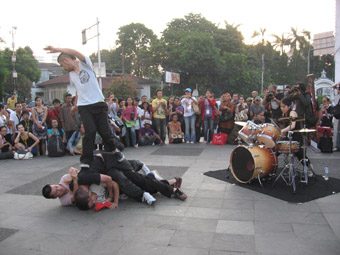
Contact Gonzo and Sayaka Himeno, public space
photo Phalla San
Contact Gonzo and Sayaka Himeno, public space
A few hours earlier, it was a young Japanese group contact Gonzo’s street dance performance that served as the soft opening—and a fitting one indeed—for the four-day festival. As about 100 people gathered around Plaza TIM, at the entrance to the host institution, noise from a bustling Jakarta street provided ambience that thematically fit the highly physical performance that was reminiscent of the street fights that takes place daily in many cities around the world. This was complemented by exuberant drumming, on a drum kit, by a female musician who, interestingly, rarely glanced at the four male dancers chasing and attacking—without actually hurting—one another. And occasionally we heard water bottles dropped and rolled around the cement floor. And unlike in Poomba, this soundscape didn’t set the rhythm of the dance, but rather added to the street ambience and the meaning of the piece.
Of course, many of us are still delighted to see contemporary dance works set to European classical music played to a live audience on CD, but, as a connotation of the term ‘contemporary’ suggests, there are also many other possibilities. After all, unlike theatre which is usually associated with, and powered by, spoken word that limits overseas exposure, contemporary dance speaks with body movements and music, or, as in these two cases, noise.
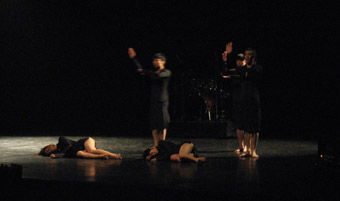
Darkness Poomba
photo Phalla San
Darkness Poomba
TWO MALE DANCERS IGNITE KIM JAE DUK’S DARKNESS POOMBA WITH A DUET PERFORMED BENEATH SEVERE TOP-LIGHTING. IT’S A FAST AND FURIOUS EXCHANGE OF ANGULARLY CHOREOGRAPHED MOVEMENT, HANDS MECHANICALLY GRASPING FOR EACH OTHER’S FACES AND BODIES REGIMENTED IN A FORWARD FACING STANCE. CREATING AN ILLUSION OF A ROBOTIC PAIR OF SIAMESE TWINS, THE TWO STYLISH YOUNG MEN ARE JOINED BY FIVE DANCERS CLAD IN CHIC BLACK SHARPLY ENTERING TO JOIN THIS MACHINE, EXPANDING ON THE GOTHIC ENERGY THAT HAS BEEN GENERATED.
A spot picks out a man standing with a microphone in one of the aisles. Ears and eyes are immediately drawn to this powerful presence and we are captivated as the space swells with his chanting of the traditional Korean Poomba (a wordless street song associated with both begging and festivities), evocative of desperation and yearning. Manipulated reverberation suggests that we are all inside a cold and mysterious vault of some sort, suspended between hallucination and reality. The performer displays extraordinary command of his instrument, and his sensitive commitment to the dancers on stage helps them to devote themselves to the dark abrasiveness of the space.
Later in the work, a dance with metallic dinner trays between the two male dancers who opened the piece brings an oddly domestic sensibility to the abstract world that has been established. The trays become percussive instruments as well as hats and items of clothing. The chorus of dancers behind them acts as a strata of strange shadows that morph from one contained image to the next. The dance is realised with crisp articulation and un-wavering performance energy as if the dancers are teasing out the dark underbelly of this work with a quiet ferociousness.
The darkness of this rich work is both deeply set in the bones of the performance and ironically woven into its surface. Even when the whole audience claps and sings in delight when the work turns into a rock concert, the haunting atmosphere never lets up. In fact it is in these ‘light’ moments that the gothic undertone is somehow heightened, demonstrating a sophisticated approach to the creation of atmosphere. Funereal organs and regular smoke machine emissions are both parodic and unsettling.
When choreographer and dancer Kim Jae Duk joins the vocalist in the auditorium and two electric guitarists play at either end of the stage, the traditional lilt of the Poomba becomes the wailing power of a rock concert, the guitars providing the metallic grit for the transition. The audience too has been transformed, from theatre spectators into a rock stadium crowd.
In a return to the opening duet, the two dancers perform a gradually accelerating version of the robotic Siamese twin dance down the aisle towards the stage. This phrase cleverly functions as the peak of the work, causing a kind of ‘Mexican wave’ effect on the crowd, evident in a vocal eruption. After the excitement has subsided, a gentle, virtuosic harmonica solo is performed by Kim Jae Duk, cleverly returning us to the work’s opening eeriness. As the creator lays his final delicate mark, the piece closes.
Not one sense is privileged over another in this haunting re-contextualization of the traditional South Korean melody of Poomba. In a truly interdisciplinary and multi-layered work, audience members are taken on a strange and unexpected voyage through the realms of contemporary dance, traditional song, stadium rock and festive reggae. Perhaps seeming schizophrenic and disjunctive in nature, this collage of performance genres is in fact executed seamlessly. Darkness Poomba is a work that manages to constantly transform our environment before we have even noticed, each new world functioning as a critique of the one that has come before.
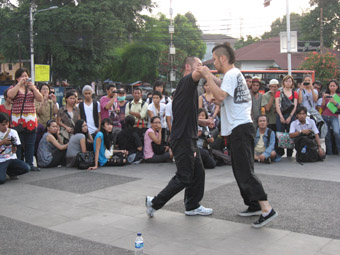
contact Gonzo, Public Space
photo Phalla San
contact Gonzo, Public Space
FIGHTING ERUPTS ON A CONCRETE PLATFORM ON THE EDGE OF A BUSY JAKARTA STREET, FOUR MEN GRAPPLING WITH EACH OTHER, PILING BODIES INTO PRECARIOUSLY PERCHED PYRAMIDS, CONSTANTLY INVADING EACH OTHER’S SPACE, SLAPPING AND PUNCHING. THIS IS NO ORDINARY STREET BRAWL BUT A PERFORMANCE BY JAPANESE COMPANY CONTACT GONZO THAT PUSHES THE PERFORMANCE BOUNDARIES BOTH PHYSICALLY AND LITERALLY. AT ANY MOMENT THE PERFORMERS COULD SPILL INTO THE WATCHING CROWD, AN IMMINENT DANGER THAT FORCES THE AUDIENCE TO PHYSICALLY ENGAGE IN THE WORK AS THEY DODGE AND RECOIL IN ANTICIPATION.
This work was one of the two international offerings that contributed to the youthful exuberance of the 10th Indonesian Dance Festival. The other was Korean Kim Jae Duk’s Darkness Poomba, bombarding the senses with a fusillade of fast movement combined with loudly belted lyrics and a beat that had the audience swaying and clapping.
Equally engaging, the two performances could not have been more different in execution and philosophy. Contact Gonzo doesn’t employ many theatrical tricks for its street performance, just the performers, an unamplified drum kit and simple props—water bottles, caps and disposable cameras. Although part of a dance festival, the physical language used cannot be comfortably labeled; it more closely resembles sport than dance in its raw action and response. In contrast, Darkness Poomba employed a full range of theatrical devices; strong lighting states to highlight the action, sleek costuming to show off the dancers’ physiques, sound amplification and a self-conscious breaking of the spectator-audience divide.
Kim’s youthful energy as performer, composer and choreographer, drives the piece, particularly when he commandeers the microphone showing off his strong voice or plays soulfully on his harmonica. Self-described as 70% choreography and 30% music Darkness Poomba is both rock concert and contemporary dance performance, crafted to get the blood pumping and body bouncing. This is a “re-mix” of Korean Poomba music, a throw-back to when the country was impoverished and street singers roamed around to entertain in exchange for food and money, singing the meaningless but rhythmic word “Poomba.”
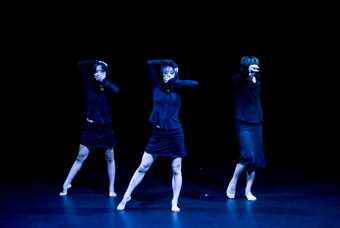
Darkness Poomba
photo Phalla San
Darkness Poomba
The work opens with two dancers lying limp in the centre of the stage. Suddenly they spring up, two young men, hair flopping over their eyes, dressed like dancerly beggars in earth-tones, they survey the audience then launch into a series of complex gestures, covering and uncovering their faces, then each other’s, hands threading through one another, then twining to catch hold and push their heads down. Imprisoned within the dark confines of the stage and the low groaning of the music, this depressed tone is short-lived because when the same sequence repeats some time later, it maintains the needlepoint accuracy yet, forced on by the driving beat and hyped up rock concert atmosphere it builds into a lightning speed that has the audience cheering.
Towards the end of the work the initial male pair re-appear moving metal dinner trays and bowls around with quick, concise movements and playing them as percussive accompaniment. Then like savage dogs they tear into imagined food, their beggarly appearance and hunger a reference to the history of Poombas.
The evocative, gestural movement vocabulary of the two sets them apart from the rest of the company, as Kim’s choreography for the black-clad dancers is a cross of liquid, contemporary movement and the aggressive energy of hip hop, that demonstrates strong ballet training without using a balletic vocabulary. The dancers are all long legs with broken torso lines and body distorting gestures that sharply accent the music and punctuate the strong beat.
Their figures perfectly synchronised, the dancers move as precisely as a well oiled machine. Bombarding the audience with speed of movement that denied emotional engagement, the physical prowess of the performers was admittedly inspiring. One male jumped high, smashing his leg into the air and completing a full revolution before landing, but did this stunt serve any other purpose than to wow the audience? The choreography was kinesthetically pleasing but not emotionally engaging.
It was the music that carried emotional resonance, particularly in the hoarse cries that emanated from the singer. This took on a life of its own as it travelled around the theatre, originating in one corner of the stage then moving to another, blaring and retreating like an auditory game of hide and seek. Later in the the work, a drummer sat centrestage, two guitarists flanked the stage and three dancers ran into the auditorium. They appeared to be escaping audience scrutiny but actually carried it with them, enlarging the performance space, if taking focus off the dancers remaining on stage.
One particularly powerful moment involving the pair of floppy-haired Poombas highlighted the challenge to the confines of the space. They threw themselves to sprawl flat against a side wall and then slowly peeled off. This was an undeveloped, token exploration of the space, part of an apparent mish-mash of images and ideas. However, in the spirit of entertainment that comes with Poomba, every moment was crafted to please, as when all action came to a stand-still and the drummer had his moment in the spotlight with a vibrant solo.
Contact Gonzo takes similar advantage of the power of energetic rhythm. From the first clang of the cymbals, the drummer is a dynamo of energy, going to war with the drum set. Echoing this aggression the dancers actually trade slaps, the smacking sound they create making the audience wince.
Aptly named after a style of journalism that is part fiction, part fact, in their performed battles Contact Gonzo negotiate a fine line between play and reality. Looking like young lion cubs in a mock hunt, they balance between careful control and risky stunts. With little formal dance training to share between them there is no polished technique, but a primal language of expression emerging from their improvised performances, making the action raw and naked. The construction of the movement revolves around the vigilance of the performers, highlighting the image of the hunt as they circle each other or attack with a sudden lunge or a slap only to be countered with paw-like swipes.
By conventional standards this performance may not be considered aesthetically pleasing, but like the journalistic style it is named after, it favours gritty delivery over polished accuracy. And the fact that this could escalate to violence at any minute makes it riveting. The unpredictability manifests in many ways, a randomly thrown bottle, water splashing around or the appearance of a disposable camera. At one point they give the camera to a group of watching boys and pose. The overlap of the two groups (performers and spectators) makes a touching picture when juxtaposed with playful violence.
Finally the drumming builds to a climax, forcing the dancers to increase their level of physical engagement until with a final crash of the drums the actionl freezes, and although the dancers still eye each other, alert and on their toes, the performance is over by common consensus as the audience breaks into applause. Contact Gonzo’s Yuya Tsukahara may have deliberately rebelled against theatrical conventions, but like Kim his focus is on involving the audience.
Here are two shows that travel very different paths to the same outcome: one taking full advantage of the effects a theatre offers, the other peeling production back to minimum, yet both create an immediacy that turns observer into participant. The explosion of energy that comes from the speed, risk and bone jarring sounds that these artists produce evokes a visceral response in the audience body making these works inescapably engaging and affecting.
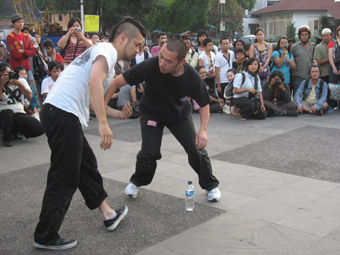
contact Gonzo, Public Space
photo Phalla San
contact Gonzo, Public Space
THE STREET FIGHT BUILDS SLOWLY. TWO YOUNG MEN IN STREET CLOTHES SLOWLY GROW AGITATED, PUSHING EACH OTHER, MOVING IN CIRCLES, EACH AGGRESSIVELY EYEING THEIR FIGHT PARTNER, BUMPING, STAYING GLUED TOGETHER FOR LONG PERIODS LIKE WRESTLERS. SOON TWO MORE MEN ENTER THE ARENA, AND WHAT STARTED LIKE A HARMLESS GAME—LIKE KIDS HANGING AROUND A TRAIN STATION, MEASURING THEIR STRENGTH OUT OF BOREDOM—HAS MOVED ONTO THE EDGE OF A REAL CONFRONTATION WHICH COULD GET OUT OF CONTROL AT ANY MOMENT.
The afternoon street performance by contact Gonzo provided a remarkable un-official opening for the 10th Indonesian Dance Festival. It caught me completely off guard. Expecting something of a hip-hop or breakdance show on the street, which might be even fused with a dose of traditional dance—the kind of thing offered later in the evening program just before the politicians delivered their opening speeches—I was hit by surprise.
The men move in and out of the fight, the physical intensity rising and ebbing with heavy breathing, water drinking, resting and watching followed and heightened by punching, slapping and wrestling. As the male fight continues, the ‘Greek’ chorus is a solo percussionist, aptly enough, a woman. Her intense drumming somehow gives the riot a dramatic element, turning it into a coherent struggle.
Contact Gonzo is a Japanase performance group that has been slowly gaining international attention. Before forming the group in 2006 and inventing the performing method of the same name, their members had been doing inspiring things like rolling down hills, catching falling leaves or jumping from the tops of telephone booths. With Gonzo meaning “bizarre, unconventional or extreme”, the performers transformed the technique of “contact improvisation”, incorporating the bumping of soccer, Sumo-inspired wrestling and a little known Russian martial-art called Systema with the ordinary kicks and punches and hits and spits from the street. Each performance is completely improvised, if with a few rules about what’s allowed and what’s not. There seemed to be some hidden communication or timing pre-arrangement with the drummer since without eye contact, she was in synch with the building up to and ending of the climaxes.
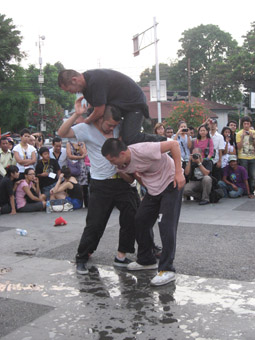
contact Gonzo, Public Space
photo Phalla San
contact Gonzo, Public Space
Some of the most beautiful moments occur when all four performers pile up on each other like a rugby scrum, frenetically interacting, agonizing, scanning the situation and making decisions about the next move in split seconds. The acting is so realistic that it reminded me of sessions of male bonding, most recently seen in the movie The Hurt Locker: violent, macho men horseplaying until emotions get out of hand and the unexpected happens. Meanwhile, the drummer is absorbed in her playing, working madly on her set, turning out sheets of sounds, which provide almost a physical stage for the men.
Contact Gonzo blurrs a few lines. Is it a staged show or does the aggression become real as the show progresses? In the middle of the tumult, somebody at the bottom of the pile grabs a disposable camera and shoots the performance. Here the artists criss-cross the delicate line between absorption and reflection. And are the audience mere spectators? Sometimes the turbulence moves dangeroursly close to the watching crowd. At one point, one performer falls at the feet of a group of street kids, who instantly take charge, grab the plastic camera and shoot.
The speed and rawness of contact Gonzo takes one’s breath away. As the performance comes to its end and the men rise to their feet and the drummer relaxes, I feel like I’m being released from an intense concentration, the kind you normally have when anticipating the unexpected.
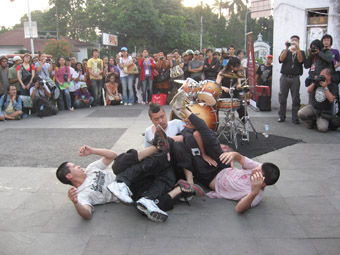
contact Gonzo, Public Space
photo Phalla San
contact Gonzo, Public Space
FOUR YOUNG JAPANESE MEN CASUALLY ENTER THE STAGE WHILE THE HOUSE LIGHTS ARE UP. THEY ARE WEARING T-SHIRTS AND TRACK-PANTS AND HAVE PERFORMANCE PASSES AROUND THEIR NECKS. ONE IS CARRYING A BACKPACK, OTHERS HAVE WATER BOTTLES AND THERE IS A VIDEO CAMERA ON A TRIPOD. THEY COULD WELL BE MISTAKEN FOR BACKSTAGE HELPERS PREPARING THE STAGE FOR THE NEXT ACT, BUT AS THEY EMPTY THEIR POCKETS, SET OBJECTS ON THE GROUND AND BEGIN TO WARM UP, IT BECOMES CLEAR THAT THEY ARE NOT. THEY ARE CONTACT GONZO, A JAPANESE DANCE GROUP.
For a few minutes they pace, lunging, stretching arms out every now and then, not in a dancerly fashion but as though about to run a 100m sprint. The physical and mental preparation generates suspense—the audience wondering what the heck is going on.
Eventually two of the men connect, not in the sense of contact improvisation where physical connection is utilized to explore movement, but rather as in sport or combat. They push and tussle, climbing on top of one another, every now and then dropping away to reposition, grab a drink of water or take a photo with a disposable camera. Gradually the battle escalates and without warning one strikes another in the face, the sound of palm to skin cutting through the air and triggering horrified gasps from the audience. The shock is amplified as suddenly from behind a backlit cyclorama a drummer improvises wildly. Crashing, banging, attacking, showing the drum-kit who’s boss, her huge, ominous shadow is an intriguing backdrop to the onstage male brawn.
An everyday performance paradigm coupled with the invitation to raw violence instils an immediate sense of the unconventional. Contact Gonzo take their name from the rebellious Gonzo journalism made famous by American journalist Hunter S Thompson. The exposure of what is normally hidden from an audience—the warming up, setting up, drinking—parallels the raw and un-edited subjectivity of the Gonzo style of writing, in which grit is favoured over polish. Thompson documented his own actions while immersed in journalistic projects, a reflexive technique also evident in Contact Gonzo’s use of cameras on stage.
As the performers wrestle, a cell-phone rings in the audience. A number of people nearby show their disgust with forceful shushing, but one of the performers reassures them, “No it’s okay. It’s okay.”
More violent slaps to the face are thrown from every which way, more piles of bodies rise up, tumble and loudly crash to the floor. At times the fighting looks like a casual urban realization of traditional Sumo wrestling. Contact Gonzo battle on, but to what end? A highly charged testosterone display gratuitously taking advantage of theatre space to flex a bit of muscle? There is no emotional narrative here. The performers just are. They fight.
It’s no surprise to me that this young team of performers are currently being invited to perform in festivals all over the world, despite the work appearing to be more an uncontrollable event rather than a finely-crafted performance. It is clear however that this group has a precise agenda, and their unique antics ensure that they stand out from the rest of the program.
Contact Gonzo is a highly innovative ‘dance’ company who unabashedly challenge established theatrical norms. Representative also of a contemporary consciousness in which violence and technology are mutually implicit, I’m sure their work will act as an interesting reference point in critical dance discussions for years to come.
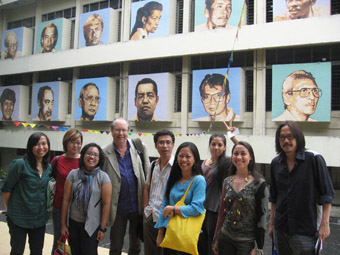
l-r: Devi Fitria, Melissa Quek, Dinyah Dinyah Latuconsina (Cultural Program Assistant), Keith Gallasch, Giang Dang, Joelle Jacinto, Cat Ruka, Bilqis Hijjas, Pawit Mahasarinand
photo Phalla San
l-r: Devi Fitria, Melissa Quek, Dinyah Dinyah Latuconsina (Cultural Program Assistant), Keith Gallasch, Giang Dang, Joelle Jacinto, Cat Ruka, Bilqis Hijjas, Pawit Mahasarinand
THANKS TO AN INVITATION FROM FRANK WERNER, REGIONAL HEAD OF THE CULTURAL PROGRAM DEPARTMENT AT THE GOETHE INSTITUT INDONESIA, I WAS DELIGHTED TO ATTEND THE 10TH INDONESIAN DANCE FESTIVAL (TITLED “POWERING THE FUTURE”) IN JAKARTA TO RUN A REVIEW-WRITING WORKSHOP FOR THE INSITITUTE IN RESPONSE TO FOUR DAYS OF EXHILARATING DANCE FROM INDONESIA, TAIWAN, JAPAN, KOREA AND EUROPE.
Amidst the festival hubub, new cuisine experiences, nerve wracking city traffic and World Cup tensions (after all, our host was a proud and anxious Goethe Institut), the workshop team saw shows, discussed and wrote (late at night or early in the morning), read each other’s reviews and shared knowledge and opinions.
The workshop participants were a fascinating mix: some had professional dance and producing experience, some were already reviewing, running blogs or contributing to magazines and newspapers, others were starting out.
Cat Ruka from New Zealand is a dancer, performance artist and the editor of Yellingmouth, an Auckland-based dance review blog. Melissa Quek from Singapore is a choreographer, a teacher at LASALLE College of the Arts
and a freelance dance reviewer for The Business Times. Joelle Jacinto from the Philippines is a dancer and a freelance writer with many years of experience. She is editor-in-chief of Runthru, a bi-annual dance magazine and website. Bilqis Hijjas creates, performs, produces, teaches and writes about contemporary dance in Kuala Lumpur, Malaysia and runs a residency for choreographers at the private arts centre Rimbun Dahan. Devi Fitria is a Jakarta-based journalist who works for the Indonesian art magazine ARTI and an online history magazine, HISTORIA. San Phalla lives in Phnom Penh, holds degrees in Southeast Asian Studies and archaeology and works as a researcher for Khmer Arts, a Cambodian classical dance company that tours the world. Dang Giang, from Vietnam, is a writer and cultural and social activist.
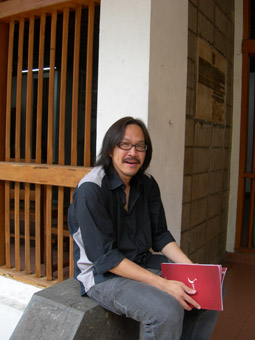
Pawit Mahasarinand
photo Keith Gallasch
Pawit Mahasarinand
Parwit Mahasarinand, a theatre lecturer and dance reviewer since 2000 for The Nation English language newspaper in Bangkok, was a very welcome addition to the workshop after he’d delivered a keynote address (“If we write more—Observations on contemporary dance criticism in Asia”).
Dance scholar, archivist and writer Franz Anton Cramer (Paris/Berlin) delivered two talks, one on the ethics and aesthetics of criticism and the other an invaluable and subsequently hotly debated introduction to the works of Meg Stuart and Philipp Gehmacher who were performing Maybe Forever in the festival.
The aim of the workshop was to improve the capacity of reviewers to vividly evoke the works they experience for their readers. Good reviewing (whether or not it consciously includes social, political and economic perspectives and passes critical judgment) cannot work effectively without this skill. Openness, strong recall, rich vocabulary, a structured response, the careful delivery of judgment, these were the workshop focus.
I was pleased that all participants willingly and bravely committed themselves to a challenging task—to respond very quickly to new dance works while focusing on writing skills and being subjected to criticism. As you read the reviews posted here do keep in mind that they were written under pressure and with limited time for editing and polishing. Despite these demands there are fine examples of vivid and thoughtful writing to be found in the 23 reviews that came out of a mere four days of what appeared to be happy labour. It was particularly pleasing to see increased attention not just to movement details but also to music, sound, set design, lighting and the ways in which, in this era of hybridity, various forms mix and meld.
The festival provided challenges for all of us in the workshop. Many works drew on traditional dance, customs and beliefs, sometimes leaving us guessing as to specific meanings while fascinated with what we seen. It’s doubly difficult given that the works are themselves contemporary interpretations or re-workings of traditional forms. Sometimes one of our number had an answer, or we googled one, provisonally, knowing that a dance festival like this one can only serve as an introduction to unfamiliar forms. Inevitably we debated the advisability of reviewing works where we lacked cultural understanding—would we misrepresent what we saw or were we encouraging interest and a sense of inquiry?
![l-r: Giang Dang, Phalla San, Joelle Jacinto [outside theatre]](https://www.realtime.org.au/wp-content/uploads/art/37/3701_gallasch_idf3.jpg)
l-r: Giang Dang, Phalla San, Joelle Jacinto [outside theatre]
photo Keith Gallasch
l-r: Giang Dang, Phalla San, Joelle Jacinto [outside theatre]
Other issues discussed included the significance, or not, of English language dance reviewing in Asia, a shortage of good editing, and a certain reviewer caution about being judgmental—verbal opinions were often tougher than those that appeared in print, said a number of participants.
From the too real street fighting of contact Gonzo to the contemplative account of a relationship breakdown in Maybe Forever and on to a range of works that engage simultaneously with traditional Indonesian forms and contemporary ideas (about homosexuality, globalisation, identity, climate change), you’ll discover in our workshop reviews an Indonesian dance festival engaged directly with the role of dance as art, and as life.
It’s hoped that the workshop will further the bringing together of dance artists and writers in the region.
The initials of the workshop writers will link you to their reviews of the following works:
Kim Jae Duk Project, Darkness Poomba [South Korea]: PS, CR, MQ, PM
contact Gonzo [Japan]: CR, GD, PM, MQ
Gusmiati Suid, Seruan [Indonesia]: DF
Asry Mery Sidowat, Merah [Indonesia]: JJ, MQ, DF
Muslimin B Pranowo, The Young [Indonesia]: BH
Jecko Siompo, From Betamax to DVD [Indonesia]: PS, MQ, JJ
Eko Supriyanto, Home: Ungratifying Life [Indonesia]: JJ, MQ
Vincent Sekwati, Barena ‘Chiefs’ [Indonesia]: MQ
Shinta Maulita, GAYaku [Indonesia]: DF, MQ
Ajeng Soelaiman, Andara Firman, S]h]elf [Indonesia]: GD
Cross Over Dance Company, Middle [Taiwan]: BH
Meg Stuart, Philipp Gehmacher, Maybe Forever [Berlin/Vienna]: BH, CR, GD, JJ, PM
Joko Sudibyo, Cekrek [Indonesia]: MQ, DF
Closing Night Performance: JJ, MQ
Emerging Choreographers Program: MQ, DF
You can see all 23 reviews at 10th Indonesian Dance Festival: Goethe Institut Regional Critic Workshop
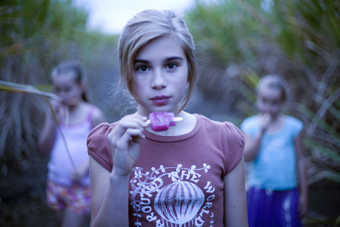
Lily Bell-Tindley, Lou
THERE’S BEEN MUCH CRITICISM OF THE AUSTRALIAN FILM INDUSTRY IN THE PAST FEW YEARS FOR DEALING WITH DEPRESSING ISSUES, PRODUCING KITCHEN-SINK DRAMAS AND BLEAK FAMILY SCENARIOS THAT (APPARENTLY) PEOPLE ARE RELUCTANT TO WATCH. WHILE I DISAGREE WITH THIS ASSESSMENT (I AM DRAWN MORE OFTEN TO THE DARK SIDE THAN THE LIGHT, AND THINK FILMS LIKE BEAUTIFUL KATE OUTRATE I LOVE YOU TOO), IT SEEMS THE FUNDING BODIES ARE MOVING TO ADDRESS IT, SO WHAT WE HAVE INSTEAD SEEMS TO BE A WAVE OF COMING-OF-AGE TALES SET IN RURAL TOWNS, CONTEMPORARY BUT BATHED IN THE GOLDEN LIGHT OF NOSTALGIA, WHERE FAMILIES LIVE IN WEATHERBOARDS WITH VERANDAHS AND CHILDREN YEARN FOR MISSING PARENTS.
I’ve recently seen The Boys are Back (Scott Hicks), The Tree (Julie Bertucelli) and now Lou, written and directed by Belinda Chayko. It seems a shame for the local industry that these themes are so obvious because, while all three films stand alone as decent offerings, seeing them bunched up means there’s a feeling of deja-vu—hey, haven’t I visited this place before?
Belinda Chayko is a Brisbane writer/director who, like Shirley Barrett, has taken 10 years to release her latest feature, after making City Loop in 2000. In the meantime she has worked on TV projects and won an AWGIE for writing Saved (Tony Ayres, 2009), about a young Iranian refugee held in detention and his advocate.
Set in cane country, the film focuses on Lou (Lily Bell-Tindley) who lives with her young single mother Rhia (Emily Barclay) and two sisters. Like Charlotte Gainsbourg’s Dawn in The Tree, Rhia is struggling to keep it together after the father leaves (in this case he just nicks off) and pines for her new lover, as the girls hover and judge. Over the Christmas holidays their lives are disrupted when Rhia’s father-in-law Doyle (John Hurt) is suddenly dumped on the household (Rhia finds she can earn money by letting him stay).
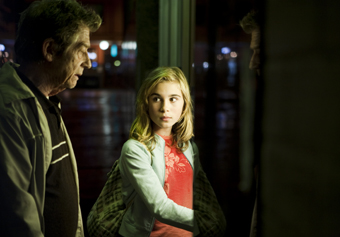
John Hurt, Lily Bell-Tindley, Lou
It’s quite a coup to have Hurt (one of the most outstanding actors working today); his scenes with Bell-Tindley elevate and enliven the story. Bell-Tindley's like a young Abbie Cornish (strong and understated, there’s no cute kid antics here) and she easily holds her own with Hurt. Together—Doyle has Alzheimer’s and sees Lou as his departed wife, Annie—they form a kind of old-fashioned romantic bond that’s subtly directed by Chayko. Barclay, as always, is both tough and fragile. There’s an ordinariness about her that I respond to but she has that ability, like Toni Collette, to transform into anyone.
What I found confusing about the film (and perhaps this is the nature of the disease itself) is the inconsistency in Doyle’s character. He is introduced at the family dinner table as belligerent and angry, swearing profusely and unpredictable. Someone who won’t have a shower, who’s “starting to stink!” At a dinner that Rhia has carefully cooked for her new man, Doyle spits the food over the table: “This is the most disgusting thing I’ve ever eaten!” But we never see him like this again. As his relationship with Lou develops he becomes almost a Hallmark card of sweet good-naturedness, someone that she can trust, a regular grandfather who can take the girls to the beach on the bus (albeit with the occasional bout of jealousy as Lou/Annie becomes interested in a local boy who delivers the paper).
Then suddenly, at the climax of the film, only then, Doyle starts to speak in the spin cycle so familiar to anyone who’s lived with dementia. He begins to repeat phrases—”are we going home by bus?”— until Lou realises her dream of escape has evaporated. It feels like the disease is being worked in around the plot, making false moves. The film is also let down by a few clichéd scenes that seem out of character. When Rhia discovers Lou wearing make-up, she slaps her: “Get that lipstick off your face, you look like a skank.” I’ve encountered this scene in so many films but the extremity of the reaction in this case doesn’t ring true. A number of other scenarios might have worked better. It’s about pausing with the writing and taking a different tack from the predictable one. Also black-and-white is Doyle’s case manager Mrs Marchetti (Daniella Farinacci), an unsympathetic character treating the family with disdain. Surely not all bureaucrats are like this. God help us if they are.
Shot in Murwillumbah, the film looks gorgeous (cinematography by Hugh Miller, who also shot David Caesar’s Prime Mover), as this genre tends to, with the glowing night-sky of burning canefields, the retro interiors, the sensuous dancing of a young girl in a red dress wrapped in golden light. The mood and the rhythm are languorous, conjuring a hot summer holiday, where you drift from one day to the next. It’s a delicate film and I can imagine it will do well on the international film festival circuit. People were raving about it as we came out of the cinema. But I’m looking forward to a new wave of Australian films. I want to be challenged and shocked. I want to be thinking, “God, I’ve never seen anything like this.”
Lou, writer, director, producer Belinda Chayko, producers Tony Ayres, Helen Bowden, Michael McMahon, cinematographer Hugh Miller, editor Denise Haratzis, production designer Pete Baxter. Lou is in limited release around Australia.
RealTime issue #97 June-July 2010 pg. web
© Kirsten Krauth; for permission to reproduce apply to realtime@realtimearts.net

Self portrait: From the outside, inside and beyond, 2009 (oil on canvas), Juan Ford
courtesy the artist
Self portrait: From the outside, inside and beyond, 2009 (oil on canvas), Juan Ford
WHAT HAS BECOME OF THE GENRE OF PORTRAITURE IN THE DIGITAL AGE? WHAT ACTUAL WORKS HAVE ARTISTS MADE IN RESPONSE TO THAT VAGUE LIST OF USUAL SUSPECTS WE ALL AUTOMATICALLY REEL OFF WHENEVER CONTEMPORARY MEDIA TECHNOLOGIES ARE MENTIONED: SOCIAL NETWORKING SITES, MOBILE PHONE CAMERAS, 3D SCANNERS, RAPID PROTOTYPERS, TOMOGRAPHY, AND ON-LINE AVATARS? PRESENT TENSE AT THE NATIONAL PORTRAIT GALLERY ANSWERS THAT QUESTION WITH A DIVERSE COLLECTION OF STRONG WORKS BY 27 WELL-ESTABLISHED AUSTRALIAN AND INTERNATIONAL ARTISTS, WHICH ARE INSTALLED WITH INTELLIGENCE AND WIT.
It’s good to see a show of photography and digital media which has been fully thought through and tightly selected by a proper curator, Michael Desmond, who has a broad knowledge and an international horizon. This show is a refreshing change from those loose surveys ‘around’ themes which appear to be chosen mainly for their convenience, or even worse, those ubiquitous but lazily conceived competitions which we get too often.
A good way of looking at Present Tense as a whole is that it is about the interaction of new technologies with the traditional methods of portraiture—painting, sculpture and photography—which already have their own pre-established ‘grammars.’ Thus we have Australian Jonathan Nichols’ flat, though engaging, paintings of young girls, each with a slight air of ambiguous familiarity. But wait, these aren’t paintings of the girls themselves, but of their Facebook thumbnails. The tug we feel is not towards their offering of themselves to us as individual viewers, but to the generalised gaze of the worldwide social network.
In another breathtaking remodalisation of an old technology, both Chuck Close (US) and Aaron Seeto (Australia) work with daguerreotypes, that primeval photographic process where all of photography’s uncanniness seems to manifest itself most magically. From a 21st century perspective, Close’s daguerreotyped heads and bodies remind the viewer somewhat of holograms. And as viewers move their head from side to side to get the right angle, and the image wells up from the visual depths like a surfacing whale, that familiar tingle up the spine they get, that simultaneous feeling of proximity and distance, is no longer configured historically—back into the depths of the mid-19th century—but existentially, from one human presence to another. In contrast, Aaron Seeto’s daguerreotype translations of right-click grabs from web reports of the 2005 Cronulla Riots make a more overt, even arch, point about the permanence and impermanence, the legibility and illegibility, of historical memory when it is entrusted to the oceanic swirls and currents of the internet.
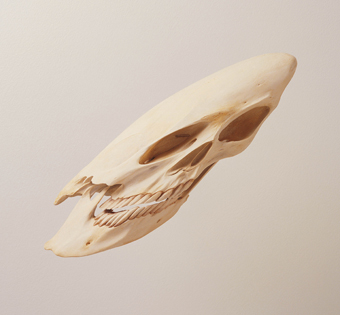
Skull, 2000, Robert Lazzarini resin, bone, pigment
courtesy of the artist and Deitch Projects
Skull, 2000, Robert Lazzarini resin, bone, pigment
The viewer has to do fair bit of head wiggling in this show. Installed across from the daguerreotypes there are two anamorphic skulls, both referring to Holbein’s famous vanitas intervention at the lower edge of his 1553 portrait of The Ambassadors. In a diptych the painter Juan Ford (Australia) bravely confronts an X-Ray of a skull. From our point of view, in front of the diptych, the skull is safely distorted and in another space. But, we realise, from his point of view within the diptych it would be restored to its correct, archetypal shape of warning and fear. The American Robert Lazzarini’s anamorphic skull is a life-sized three-dimensional sculpture made of actual bone material embedded in resin. As we circle warily, it fleetingly looms out of its anamorphic parallel universe and into our own.
In a similar way, the faces of Justine Khamara’s (Australia) angry and surprised parents suddenly pop out at us when we stand directly in front of the bulging aluminium constructions on which their flat images have been printed. It is the viewer’s exact position at the apex of the constructions which animates them, seemingly jolting them out of some kind of two-dimensional repose.
This show foregrounds the fundamental image-making actions which have now become proper to contemporary portraiture. It’s no longer just the snap of the camera’s shutter or the incremental description of the painter’s brush, but is also the trundling progress of the flatbed scanner and the circular pan of the 3D scanner.
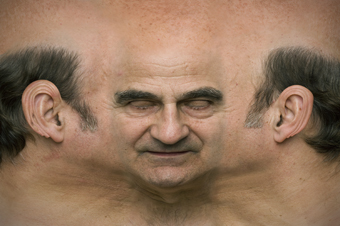
Stretched skin, 2009, Stelarc, type C photograph
courtesy of the artist and Scott Livesey Galleries
Stretched skin, 2009, Stelarc, type C photograph
Stelarc (Australia), in classic techno-narcissist style, stretches the skin of his head across a flat acrylic table measuring 1.2 by 1.8 metres, to invite us to delectate on every one of his pores and bristles. The German artist Karin Sander makes exact, three dimensional, indexical sculptures of her subjects at one-fifth scale by using three-dimensional scanning and rapid prototyping technology. What are these mini-them’s? Three-dimensional photos? Optical clones? Plastic avatars? Whatever they are, one isn’t enough. I found myself wanting the artist to be true to her namesake, August Sander, and methodically create an army of miniature German people.
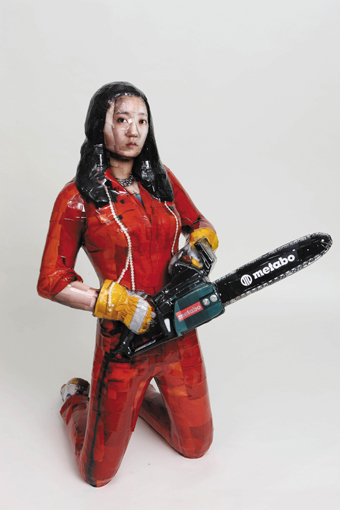
Metabo, 2009, Osang Gwon c-prints, mixed media
courtesy of the artist and Arario Gallery, Seoul
Metabo, 2009, Osang Gwon c-prints, mixed media
In contrast to the indexical, technologically produced three-dimensional portrait, the Korean artist Osang Gwon takes hundreds of small photographs of every inch of her young, punky, Korean subject and glues them on to a hand-carved life-sized Styrofoam figure in a loose collagistic style. This produces a strong but unstable sense of the physical presence of her subject, as if her skin and clothes, and indeed her whole persona, is on the verge of peeling away with nothing left beneath.
There are plenty of hits of humanist sympathy to be had from this show. In 2008 the Dutch artist Geert van Kesteren collected mobile phone shots SMS-ed out of Iraq and Syria. Enlarged, framed and gridded up the wall, these ephemeral and off-the-cuff images become a monumental document of geo-political conflict where snapshots of happy family gatherings and friends at play sit insouciantly beside shots taken out of the windows of moving cars of dead bodies by the road or the interiors of burnt out houses.
The masterful Dutch photographer Rineke Dijkstra provides the emotional centre of gravity for the show. Her simple nude photographs of startled young mothers clutching their newborn babies like bags of shopping about to burst remind us again of the power of the straight photo. But her stunning two-gun video installation, The Buzzclub, LiverpoolUK/Mysteryworld, Zaandam NL, also from the mid-90s, confirms the pre-eminence of the video portrait. Dijkstra has, presumably, momentarily pulled young off-their-faces clubbers straight from the dance floors and put them in front of her video camera in a bare white space off to the side. But the laser lightshows and the doof doof are obviously still going on inside their skulls. As they continue to work their jaws and jig robotically we get full voyeuristic access to them and, even though their interior individualities have temporarily gone AWOL, we nonetheless feel an extraordinary tenderness for them welling up.
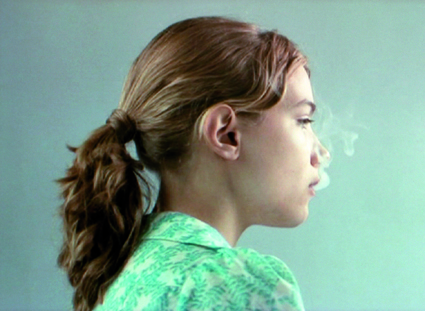
Ghost in the Shell, 2008 (video still), Petrina Hicks
courtesy the artist
Ghost in the Shell, 2008 (video still), Petrina Hicks
The theme of interior and exterior slowly emerges as a thread in this show. For instance Scott Redford videoed fellow Australian artist Jeremy Hynes performing a private, improvised homage to Kurt Cobain by writing his name on a cigarette and inhaling its now transubstantiated smoke deep into his lungs, before sobbing with genuine loss and longing. In a sucker punch for the attentive reader of the catalogue we learn that Jeremy Hynes was himself killed in a road accident a few months after the video was shot. Across the way from this projection is another Australian piece, Petrina Hicks’ Ghost in the Shell, where we silently circle around a pure, innocent young girl—or perhaps she rotates before us? Then, ever so discreetly, ever so elegantly, a tendril of smoke or mist escapes from between her lips. Her spirit? Her soul? Just her ciggy smoke? She continues to rotate without answer.
In the end this is a humanist show, about ghosts more than shells. It argues that despite all of the cold digital technology in the world portraits are still about the promise of finding the warm interior of a person via their exterior. The show’s inclusion of some three-dimensional ultrasound images of foetuses in the womb could have easily been over-the-top and obvious in its point about our intimate adoption of new imaging technologies. Until we see one intrauterine image of twins in which one foetus is caught sticking its toe into the eye of its sibling. A rivalry which, we think to ourselves, will no doubt continue for the rest of their lives.
Present Tense: An Imagined Grammar of Portraiture in the Digital Age, curator Michael Desmond, National Portrait Gallery, Canberra, May 14-Aug 22; www.portrait.gov.au/site/exhibition_subsite_PT.php
This article first appeared online, July 12, 2010
RealTime issue #98 Aug-Sept 2010 pg. 38
© Martyn Jolly; for permission to reproduce apply to realtime@realtimearts.net
australians win rolex arts awards
Congratulations to composer Ben Frost and dancer Lee Serle on being chosen for a year of mentoring in the Rolex Arts Initiative. Each year the program awards six mentorships to outstanding emerging artists working in dance, film, literature, music, theatre and visual art. This year, rather remarkably, two of the six awards were given to Australians. In the music category, Frost, a 30-year-old composer, producer and musician originally from Melbourne but now based in Reykjavik, will be mentored by the composer Brian Eno. You might have heard Frost’s music in the Chunky Move productions Glow, Black Marrow and Mortal Engine, or his album Steel Wound. In the dance category, Lee Serle, who is 28, will be mentored by renowned American choreographer Trisha Brown. He graduated from the VCA in 2003 and has appeared with Lucy Guerin Inc and in Chunky Move’s Mortal Engine, I Want to Dance Better at Parties, Two Faced Bastard and I Like This. His choreographic credits include A Little Murky and I’m in Love.
Given the pair’s connection with Chunky Move, artistic director Gideon Obarzanek is understandably delighted. Though Frost and Serle are Australia’s third and fourth Rolex protégées, they are the first from the live arts categories as well as the first Victorians. The previous Australian winners were both novelists from New South Wales: Julia Leigh, mentored by Toni Morrison in 2002-03 and Tara June Winch by Wole Soyinka in 2008-09. Frost and Serle will each be mentored across a year and in addition will receive US$25,000 and be eligible for a further US$25,000 to create a project in the subsequent year. Rolex Mentor & Protégé Arts Initiative
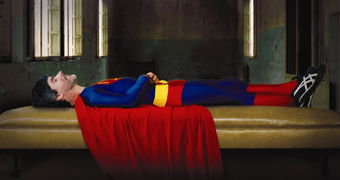
Paolo Castro, Superheroes
photo RODEO
Paolo Castro, Superheroes
everyday heroes & superheroes
Everyone loves a hero, flawed or otherwise. If you prefer them humble and homemade, then you’re bound to be pleased by NightTime State Wide: Everyday Hero. Like previous NightTime programs (see RT78 and RT91). Everyday Hero is an evening of short, live artworks curated by Lara Thoms and, this time, Jess Olivieri. Created by emerging and established Sydney artists such as John A Douglas, Renny Kodgers, Julie-Anne Long, Jason Pitt with Jade Dewi, Natalie Randall, Justin Shoulder, Anna Tregloan with Rita Kalnejais, and David Franzke and Alice Williams, the evening explores a range of everyday heroes: stay-at-home mums, unconventional fathers, child starlets, and even yourself (you get to try on a superhero costume). If you missed them in June at Performance Space, then you can see these heroes in action at Tamworth Regional Gallery (July 31), Lake Macquarie City Art Gallery (October 16), and Orange Regional Gallery (September 4).
Further south, in Adelaide and then Melbourne, theatre company Stone/Castro is going one better with their new show Superheroes. It begins with six characters in a rest home on the road to recovery and perhaps the road to salvation, or maybe domination, depending on which way they turn. Their battle for supremacy in this new, rather unlikely, territory serves as a microcosm for a larger “reflection on the complexity of globalisation, the future, violence, and war” (Press Release). Director Paul Castro, originally from Portugal but now based in Adelaide, is building a solid reputation on the back of productions such as Regina vs Contemporary Art (see RT89) and with No Strings Attached Theatre of Disability’s Tom the Loneliest (see RT88). NightTime Statewide: Everyday Hero, Performance Space and Hazelhurst Regional Art Gallery, curated by Jess Olivieri and Lara Thoms, Tamworth Regional Gallery, July 31, Lake Macquarie City Art Gallery, Oct 16), Orange Regional Gallery, Sept 4. http://www.performancespace.com.au. Stone/Castro, Superheroes, Space Theatre, Adelaide Festival Centre, Adelaide, July 20-24, www.adelaidefestivalcentre.com.au; Arts House, Melbourne Aug 11-15; http://www.melbourne.vic.gov.au/ArtsHouse
wollongong starfuckers
From heroes to stars …Wollongong isn’t a place you’d typically expect to find Starfuckers but then Malcolm Whittaker and Laura Caesar aren’t your typical stars: Whittaker is performance artist and collaborator with Team MESS (see RT90), and his partner Caesar is a primary school teacher and “arts and craft enthusiast.” Starfuckers is a durational performance of four hours (you come and go as you choose) which “deconstructs and (literally) reconstructs a ridiculously long list of lovers into an increasingly tangled scene of arts and crafts and diary dialogue.” It’s about how we represent relationships culturally, how we respond to those representations personally, and how those responses in turn shape our interpersonal relations. Presented by the new entrepreneurial arm of the Merringong Theatre Company, the Independent Producers Program, Starfuckers plays for two nights only. Bob Peet Studio, Illawarra Performing Arts Centre, Wollongong, July 23-24; http://merrigong.com.au/shows/stars.html
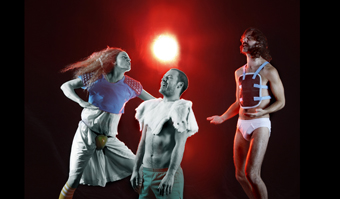
Kristy Ayre, Timothy Harvey, Luke George, NOW NOW NOW
photo Jeff Busby
Kristy Ayre, Timothy Harvey, Luke George, NOW NOW NOW
luke george: dancing in the moment
In Luke George’s NOW NOW NOW at Melbourne’s Dancehouse, the choreographer and two fellow dancers will attempt to address a paradox shared by performers and audiences: “We seek to be in the moment, yet through the pursuit of this, we move further and further away from it.” George began his career with Launceston’s Stompin (where he was also artistic director 2002-08), trained at the VCA and has worked with Phillip Adams’ Balletlab, Jo Lloyd, Chunky Move, Itoh Kim, Miguel Gutierrez and Deborah Hay. He has choreographed for Stompin, Back to Back and Arena theatre companies, and his independent work LIFESIZE (seen at Dance Massive in 2009) was short listed for an Australian Dance Award. In NOW NOW NOW he will be joined by dancers Kristy Ayre and Timothy Harvey with design by Bluebottle 3 and dramaturgy by Martyn Coutts. George writes, “My aim is to magnify audience/performer relationship and question the ‘realness’ of performance and how we are in the world. In NOW NOW NOW the performers are not characters representing a greater humanity or society—we are ourselves and this performance is a genuine attempt at the question, ‘can we be in the moment?’ and we invite an audience to experience that with us.” You can read Sophie Travers’ interview with Luke George about his career and vision in RealTime 98, August-September. NOW NOW NOW, Dancehouse, Melbourne, July 28-Aug 1; www.dancehouse.com.au
fact, uk: the reoriented gaze
Liverpool’s Foundation for Art and Creative Technology (FACT) is currently staging an exhibition titled Persistence of Vision. Featuring eight contemporary artists, including AVPD (Denmark), Julian von Bismarck (Germany), Julien Maire (France) Mizuki Watanabe (Japan) and Melik Ohanian (France), the show investigates “the relationship between vision, memory and media.” (Intriguingly, the exhibition appears to anticipate the theme for next year’s Performance Studies International conference, which is called Camillo 2.0: Technology, Memory, Experience. Camillo 2.0: Technology, Memory, Experience, Performance Studies International #17, Utrecht, the Netherlands, May 25-29 2011; http://psi17.org/) In one installation, In-Between Gaze (2010), Mizuki projects an out of focus image onto a wall. When the viewer uses a magnifying glass to bring the image into focus, a live video showing the viewer holding the magnifying glass appears in the focused part of the projection. In this way, “viewers not only see themselves, but also see themselves seeing.” The work by AVPD is similarly playful: “a disorienting installation using mirrors and corridors to explore the role of memory in our visual perception and orientation in a given space.” Persistence of Vision, FACT, Liverpool, UK, June 18-Sept 5; http://www.fact.co.uk/about/exhibitions/2010/persistence-of-vision
situating abramovic at artspace
Amelia Jones, author of Body Art/Performing the Subject (1998), Irrational Modernism: A Neurasthenic History of New York Dada (2004) and Self Image: Technology, Representation, and the Contemporary Subject (2006) among other books, comes to Artspace on July 13 to speak on “Performance as Improvisation: Aesthetics, Live Art, and the Problem of History.” The presentation will investigate “what happens when performance gets put in the frame of aesthetics.” More specifically, it examines Marina Abramovic’s Seven Easy Pieces (2005; http://www.seveneasypieces.com), where the artist re-enacted six 1970s performance art works (on the seventh day she rested) at the Guggenheim Museum in New York. Jones uses this performance as a “pivot” point in order to “argue that making ‘performance’ as ‘art’ is a category confusion that produces a range of contradictions, opening up a gap between aesthetics and the vicissitudes of the improvisational or the live event.” No doubt there are additional layers to the argument in view of the recent Marina Abramovic retrospective at MoMA, where numerous performers “re-performed” some of her early works (you couldn’t see it live, see it online at the exhibition website; http://www.moma.org/interactives/exhibitions/2010/marinaabramovic/index.html). No bookings will be taken for this event and places are limited, so get to Artspace early to avoid disappointment. Amelia Jones, “Performance as Improvisation: Aesthetics, Live Art, and the Problem of History,” Artspace, July 13, 6.30pm, http://www.artspace.org.au/public_lectures
RealTime issue #97 June-July 2010 pg. web
© RealTime ; for permission to reproduce apply to realtime@realtimearts.net
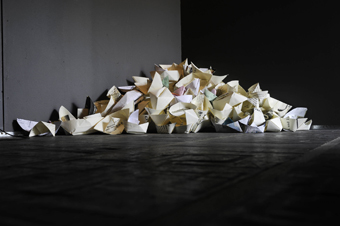
In Search of the Inland Sea, 2009, Norie Neumark, Maria Miranda
photo Adam Hollingworth
In Search of the Inland Sea, 2009, Norie Neumark, Maria Miranda
MEMORY FLOWS IS AN ONGOING PROJECT OF THE CENTRE FOR MEDIA ARTS INNOVATION (CMAI) AT THE UNIVERSITY OF TECHNOLOGY SYDNEY (UTS). UNDERTAKEN BY A LOOSE COLLECTIVE OF UTS STAFF AND AFFILIATED ARTISTS (OFTEN IN COLLABORATION), MEMORY FLOWS EXPLORES THE IDEA OF WATER AND ITS RELATION TO MEMORY, UTILISING SOUND, VIDEO, PHOTOGRAPHY AND SCULPTURE. SINCE ITS INCEPTION THERE HAVE BEEN SEVERAL PUBLIC OUTCOMES SUCH AS AT LIQUID ARCHITECTURE 2009 WITH THE PROJECT CULMINATING IN AN AMBITIOUS EXHIBITION PRESENTING 13 WORKS AT THE NEWINGTON ARMORY CURATED BY NORIE NEUMARK, DEBORAH TURNBULL AND SOPHIA KOUYOUMDJIAN.
The Newington Armory itself is quite a curious place—an eerie post-colonial ghost town left standing amidst the industrial sprawl of Silverwater (right next to a high security prison) on the mangrove fringed Parramatta River. On weekends it’s frequented by families as a leisure park with bike riding and roller-skating along the riverbanks. Approaching the Armory site it’s impossible not to contemplate the role of rivers in our ecosystem, the impact of modern civilisation on the landscape and the hidden histories of Sydney, and indeed Australia. Inside the exhibition, it is the works which approach these ideas more obliquely which prove to be most intriguing.

Diffusion, 2010, detail, Neil Jenkins, Roger Mills
courtesy of the artists
Diffusion, 2010, detail, Neil Jenkins, Roger Mills
Neil Jenkins and Roger Mills’ Diffusion (2010) draws you into a darkened space with the staticy sounds of running water made from hydrophonic recordings of the Parramatta River. The sounds issue from eight speakers hanging from the ceiling, each a beautifully crafted object: a wooden cube with an intricate structural diagram of a chemical pollutant laser-cut through one panel. Lit from within, the patterning gives each surface the appearance of a delicate lace-like screen. In the middle of the circle of speakers, textured images of water are projected, rendered mysterious by the intense detail. Moving around the work you experience a range of timbres of water sounds, often harsh and angular, reflecting the aggression of chemical infiltration, yet the beauty of the objects in the space is beguiling. (View video footage at http://www.eartrumpet.org/images/diffusion.mov)
Drawing Water (2009) by Jacqueline Gothe and Ian Gwilt is also evocative, comprising a large floor projection of gently undulating shapes—an abstract interpretation of the twists and turns of rivers from a topographical perspective. The image itself is not animated, yet it scrolls from left to right creating a disorienting sense of flow. The top down view and the interplay between stasis and movement create a sensation of the elusiveness of the shape of water.
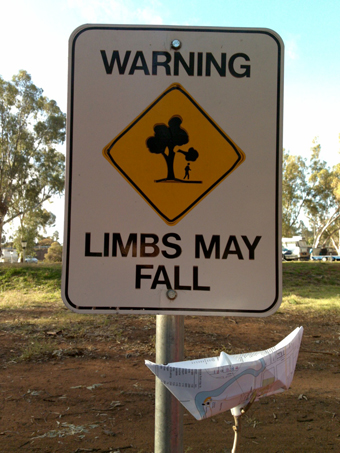
In Search of the Inland Sea, 2009, video still, Norie Neumark, Maria Miranda
courtesy of the artists
In Search of the Inland Sea, 2009, video still, Norie Neumark, Maria Miranda
Co-curator Norie Neumark contributes a work made with long-time collaborator Maria Miranda, In Search of the Inland Sea (2009). Neumark and Miranda’s work frequently uses offbeat humour to approach serious issues (see the review of their Talking about the Weather). In this instance the idea of the elusive inland Australian sea which captivated early settlers is explored through a series of vignettes. The spine of the work is a road trip that the pair undertook retracing the explorer Sturt’s original journey down the Murrumbidgee and Murray Rivers. However they have substituted a small paper boat for Sturt’s impractical whaling vessel. Mobile phone video footage of the journey is presented on a small screen but the road trip narrative is complicated by a soundtrack which draws on the spoken description of the plot of a Japanese horror film, about creatures emerging from murky waters to abduct people. On another screen we see hands folding pages from an old book on Sturt into small paper boats while the voice over, rather than reading from the book, describes the look of the pages and the typography, hinting at the absurdity of colonial formalities. A pile of paper boats also fills one corner of the space beneath the screens. On yet another small screen an endless strip of outback road is accompanied by slowed down voices describing an action scene from Mad Max illustrating 20th century interpretations of the Australian landscape. Through the accumulation of these quirky juxtapositions, we get a sense of the complexity of the fantasies and fears of a non-Indigenous relationship with the Australian outback.
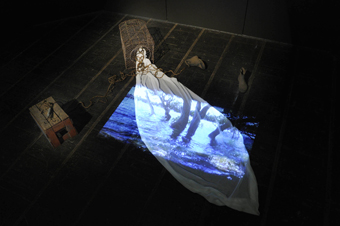
Cleanse, 2010, Megan Heyward
photo Adam Hollingworth
Cleanse, 2010, Megan Heyward
Several works used a more narrative approach to the thematic, recounting recollections of rivers and local waterways. The most stylish of these was Megan Heyward’s Cleanse (2010) which explores her childhood memories of the Parramatta River. Filmic-style video is down-projected onto a swathe of cloth issuing from a fishing trap. Scattered across the space are objects found around the river—old boots, fishing tackle, a wooden crate—which frame the viewing space. These memory fragments are intriguingly rich with a sense of the past, implying an innocence but also an ignorance in our past interaction with the ecosystem. Other works using documentary approaches, such as Shannon O’Neill and Jennifer Teo’s Waterfront Utopia (2010), Clement Girault and Victor Steffanson’s video component of Live Flows (2009), and to a lesser extent Ian Andrews’ Shifting Sands, are certainly accessible and informative if too illustrative for my taste, lacking complexity in the handling of their subjects.
While there was some similarity of approach, the standout works illustrated a range of stylistic and conceptual explorations on the thematic, and the venue choice added strong site-specific resonances to the exhibition. Perhaps more importantly Memory Flows introduced thought provoking and well-executed media art to a large general public.
Memory Flows, curators Norie Neumark, Deborah Turnbull, Sophia Kouyoumdjian; a project of Centre for Media Art Innovation, UTS, Sopa programming Tony Nesbitt; artists Ian Andrews, Chris Bowman, Chris Caines, Damian Castaldi, Sherre DeLys, Clement Girault, Jacqueline Gothe, Ian Gwilt, Megan Heyward, Nigel Helyer, Neil Jenkins, Solange Kershaw, Roger Mills, Maria Miranda, Norie Neumark, Shannon O’Neill, Greg Shapley, Victor Steffenson, Jes Tyrrell, Jen Teo; Newington Armory, Sydney, May 15-June 20; http://memoryflows.net
CMAI director Norie Neumark will be leaving UTS in July to take up a new position at La Trobe University.
RealTime issue #97 June-July 2010 pg. web
© Gail Priest; for permission to reproduce apply to realtime@realtimearts.net

l-r: Devi Fitria, Melissa Quek, Dinyah Dinyah Latuconsina (Cultural Program Assistant), Keith Gallasch, Giang Dang, Joelle Jacinto, Cat Ruka, Bilqis Hijjas, Pawit Mahasarinand
photo Phalla San
l-r: Devi Fitria, Melissa Quek, Dinyah Dinyah Latuconsina (Cultural Program Assistant), Keith Gallasch, Giang Dang, Joelle Jacinto, Cat Ruka, Bilqis Hijjas, Pawit Mahasarinand
THANKS TO AN INVITATION FROM FRANK WERNER, REGIONAL HEAD OF THE CULTURAL PROGRAM DEPARTMENT AT THE GOETHE INSTITUT INDONESIA, I WAS DELIGHTED TO ATTEND THE 10TH INDONESIAN DANCE FESTIVAL (TITLED “POWERING THE FUTURE”) IN JAKARTA TO RUN A REVIEW-WRITING WORKSHOP FOR THE INSITITUTE IN RESPONSE TO FOUR DAYS OF EXHILARATING DANCE FROM INDONESIA, TAIWAN, JAPAN, KOREA AND EUROPE.
Amidst the festival hubub, new cuisine experiences, nerve wracking city traffic and World Cup tensions (after all, our host was a proud and anxious Goethe Institut), the workshop team saw shows, discussed and wrote (late at night or early in the morning), read each other’s reviews and shared knowledge and opinions.
The workshop participants were a fascinating mix: some had professional dance and producing experience, some were already reviewing, running blogs or contributing to magazines and newspapers, others were starting out.
Cat Ruka from New Zealand is a dancer, performance artist and the editor of Yellingmouth, an Auckland-based dance review blog. Melissa Quek from Singapore is a choreographer, a teacher at LASALLE College of the Arts
and a freelance dance reviewer for The Business Times. Joelle Jacinto from the Philippines is a dancer and a freelance writer with many years of experience. She is editor-in-chief of Runthru, a bi-annual dance magazine and website. Bilqis Hijjas creates, performs, produces, teaches and writes about contemporary dance in Kuala Lumpur, Malaysia and runs a residency for choreographers at the private arts centre Rimbun Dahan. Devi Fitria is a Jakarta-based journalist who works for the Indonesian art magazine ARTI and an online history magazine, HISTORIA. San Phalla lives in Phnom Penh, holds degrees in Southeast Asian Studies and archaeology and works as a researcher for Khmer Arts, a Cambodian classical dance company that tours the world. Dang Giang, from Vietnam, is a writer and cultural and social activist.

Pawit Mahasarinand
photo Keith Gallasch
Pawit Mahasarinand
Parwit Mahasarinand, a theatre lecturer and dance reviewer since 2000 for The Nation English language newspaper in Bangkok, was a very welcome addition to the workshop after he’d delivered a keynote address (“If we write more—Observations on contemporary dance criticism in Asia”).
Dance scholar, archivist and writer Franz Anton Cramer (Paris/Berlin) delivered two talks, one on the ethics and aesthetics of criticism and the other an invaluable and subsequently hotly debated introduction to the works of Meg Stuart and Philipp Gehmacher who were performing Maybe Forever in the festival.
The aim of the workshop was to improve the capacity of reviewers to vividly evoke the works they experience for their readers. Good reviewing (whether or not it consciously includes social, political and economic perspectives and passes critical judgment) cannot work effectively without this skill. Openness, strong recall, rich vocabulary, a structured response, the careful delivery of judgment, these were the workshop focus.
I was pleased that all participants willingly and bravely committed themselves to a challenging task—to respond very quickly to new dance works while focusing on writing skills and being subjected to criticism. As you read the reviews posted here do keep in mind that they were written under pressure and with limited time for editing and polishing. Despite these demands there are fine examples of vivid and thoughtful writing to be found in the 23 reviews that came out of a mere four days of what appeared to be happy labour. It was particularly pleasing to see increased attention not just to movement details but also to music, sound, set design, lighting and the ways in which, in this era of hybridity, various forms mix and meld.
The festival provided challenges for all of us in the workshop. Many works drew on traditional dance, customs and beliefs, sometimes leaving us guessing as to specific meanings while fascinated with what we seen. It’s doubly difficult given that the works are themselves contemporary interpretations or re-workings of traditional forms. Sometimes one of our number had an answer, or we googled one, provisonally, knowing that a dance festival like this one can only serve as an introduction to unfamiliar forms. Inevitably we debated the advisability of reviewing works where we lacked cultural understanding—would we misrepresent what we saw or were we encouraging interest and a sense of inquiry?
Other issues discussed included the significance, or not, of English language dance reviewing in Asia, a shortage of good editing, and a certain reviewer caution about being judgmental—verbal opinions were often tougher than those that appeared in print, said a number of participants.
![l-r: Giang Dang, Phalla San, Joelle Jacinto [outside theatre]](https://www.realtime.org.au/wp-content/uploads/art/37/3701_gallasch_idf3.jpg)
l-r: Giang Dang, Phalla San, Joelle Jacinto [outside theatre]
photo Keith Gallasch
l-r: Giang Dang, Phalla San, Joelle Jacinto [outside theatre]
From the too real street fighting of contact Gonzo to the contemplative account of a relationship breakdown in Maybe Forever and on to a range of works that engage simultaneously with traditional Indonesian forms and contemporary ideas (about homosexuality, globalisation, identity, climate change), you’ll discover in our workshop reviews an Indonesian dance festival engaged directly with the role of dance as art, and as life.
It’s hoped that the workshop will further the bringing together of dance artists and writers in the region.
The initials of the workshop writers will link you to their reviews of the following works:
Kim Jae Duk Project, Darkness Poomba [South Korea]: PS, CR, MQ, PM
contact Gonzo [Japan]: CR, GD, PM, MQ
Gusmiati Suid, Seruan [Indonesia]: DF
Asry Mery Sidowat, Merah [Indonesia]: JJ, MQ, DF
Muslimin B Pranowo, The Young [Indonesia]: BH
Jecko Siompo, From Betamax to DVD [Indonesia]: PS, MQ, JJ
Eko Supriyanto, Home: Ungratifying Life [Indonesia]: JJ, MQ
Vincent Sekwati, Barena ‘Chiefs’ [Indonesia]: MQ
Shinta Maulita, GAYaku [Indonesia]: DF, MQ
Ajeng Soelaiman, Andara Firman, S]h]elf [Indonesia]: GD
Cross Over Dance Company, Middle [Taiwan]: BH
Meg Stuart, Philipp Gehmacher, Maybe Forever [Berlin/Vienna]: BH, CR, GD, JJ, PM
Joko Sudibyo, Cekrek [Indonesia]: MQ, DF
Closing Night Performance: JJ, MQ
Emerging Choreographers Program: MQ, DF
You can see all 23 reviews at 10th Indonesian Dance Festival: Goethe Institut Regional Critic Workshop
Goethe Institut Indonesia, Regional Dance Critic Workshop, June 14-18, held during the 10th Indonesian Dance Festival, “Powering the Future”, June 14-17
This article first appeared online July 12, 2010
RealTime issue #99 Oct-Nov 2010 pg. web
© Keith Gallasch; for permission to reproduce apply to realtime@realtimearts.net
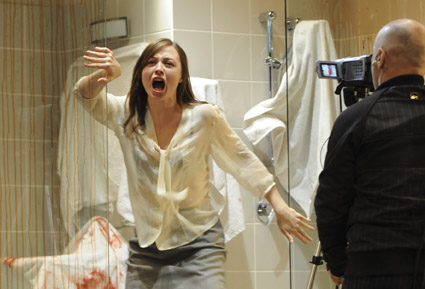
Robin McLeavy, Arky Michael, Measure for Measure, directed by Benedict Andrews
photo Heidrun Löhr
Robin McLeavy, Arky Michael, Measure for Measure, directed by Benedict Andrews
SHAKESPEARE’S MEASURE FOR MEASURE HAS LONG BEEN REGARDED AS A ‘PROBLEM PLAY.’ IT’S A CLASSICAL COMEDY IN MANY RESPECTS, FOCUSED ON LOVE AND EVERYDAY SEXUAL MORES, LOADED WITH HIDDEN IDENTITIES, SUBSTITUTIONS AND COMICAL MISCALCULATIONS AND IS RESOLVED WITH A WELTER OF MARRIAGES INDICATIVE OF SOCIAL RENEWAL. HOWEVER, THE PLAY’S TONE IS SURPRISINGLY DARK FOR A COMEDY, IF NOT BLACK, ALTHOUGH BENEDICT ANDREWS’ PRODUCTION FOR COMPANY B SOMETIMES APTLY PAINTS IT SO. WHILE THE THREAT OF DEATH IS NOT UNCOMMON IN COMEDY, IT’S USUALLY TREATED LIGHTLY, BUT HERE SHAKESPEARE MAKES ITS LIKELIHOOD PALPABLE. THE SUFFERING OF THE PRINCIPAL CHARACTERS IS PAINFULLY ACUTE AS THE LAW TURNS UNJUST AND A CRUEL INEVITABILITY TAKES OVER—TRAGEDY IS IMMINENT.
Measure for Measure (1604) is snared by the dark side of politics. That’s not unusual for a comedy of the first decade of 17th century London, but here state power is enacted with such severity and in such an un-comedic vein that the play teeters uncomfortably between genres. This is especially so at the end when Shakespeare attempts to balance the return of justice with the demands of comic resolution. This complication is amplified in the final act by a deus ex machina who is the principal cause of the near tragedy. Consequently, while it makes fine fodder for literary debate, Measure for Measure is not frequently produced and the directorial challenge to achieve a unity of vision is formidable.
However, while the ending of the play remains forever problematic, the relationship between serious drama and comedy is, for the most part, dynamic. Disturbed by a rise in sexual licentiousness among his citizens, the Duke of Vienna (Robert Menzies) absents himself, leaving the city in the hands of a trusted deputy, the morally respectable Angelo (Damon Gameau) who immediately commences a series of brutal prosecutions at all levels of society. Prostitutes, bawds, officers of the law, citizens and politicians are suddenly thrust together. Measure for Measure is kin to the satirical Jacobean city comedies of the 1600s—urban, licentious and laced with droll seriousness, as when the bawd Pompey (Arky Michael), forced to become an executioner’s assistant, decries the ‘mystique’ of haughty executioners. The Provost (Steve Rodgers) concurs in a retort to the offended executioner, “Go to, sir, you weigh equally [with bawds]: a feather will turn the scale.”
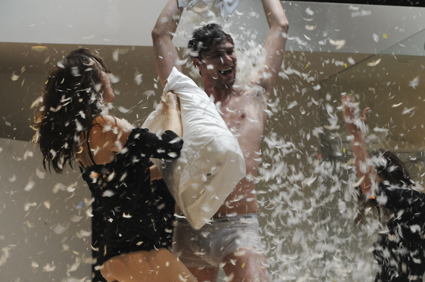
Robin McLeavy,Toby Schmitz, Maeve Dermody, Measure for Measure
photo Heidrun Löhr
Robin McLeavy,Toby Schmitz, Maeve Dermody, Measure for Measure
Comedy and drama are at one in the play’s struggle to balance personal freedom and the demands of law, not least when power is being abused. Angelo decides to execute Claudio (Chris Ryan) who has impregnated his fiancée, Julietta (Maeve Dermody). Angelo then demands the sexual favours of Claudio’s sister, Isabella (Robin McLeavy), a novice nun, in return for her brother’s life, a bargain he has no intention of honouring. Benedict Andrews keeps the comedy rude and raw, even grossing it up with an early group sex and pillow fight scene (the world awash with feathers for the remainder of the first half of the play) and later with Lucio (Toby Schmitz) engaging furiously in frottage and penetration with a tiger lily. It’s as if to say, yes, the city is depraved, but which is the greater evil—general licentiousness or the abuse of power?
The sense of a coherent world is made more concrete by having all of the action occur within one intensively surveilled room. As it revolves it becomes other spaces (nunnery, cell, office) but its commonality is produced by the space reducing cameras hand-wielded or secreted in ceilings by the mass media or the state and the Duke’s personal surveillance in his guise as a man of the church manipulating the action. The result is a closed, dangerous world where everything is bared and controllable.
The revolving room is framed either side by large screens which provide close-ups of the characters and medium shots of character groupings, offering alternative layers of comment and emotional intensity. The sense of portraiture is particularly strong (the printed program reproduces Giorgio Agamben’s essay “The Face”). Flickering into focus, still, listening faces appear like paintings—Isabella as if rendered by Vermeer. At other times the images are hard—the over-lit pornography of interrogation and intrusion. Actors take turns at operating cameras, standing mid-action, ignored by the characters they’re filming and eventually by the audience, so familiar is the idiom, its power neglected at our peril. We peer at faces, looking as we do in portraiture for some kind of truth or essence and with increasing uncertainty.
The interplay of live action and its immediate screening is engrossing, even in a small theatre where you often have to choose where to direct your attention (especially if you’re sitting close to the stage—not an ideal position). Some moments become almost entirely cinematic, one of the most affecting being when Isabella tells her doomed brother that she cannot rescue him from death. In low blue light the stage is almost dark, brother and sister initially either side of a glass wall, her face reflected over his, amplifying the sense of kinship at the same time as a terrible moral divide. Ryan and McLeavy, advantaged as well by head microphones, play the scene with a low key, nuanced intensity. Sean Bacon dexterously live edits the camerawork with an air of improvisation while simultaneously, assured artistry is evident in every carefully framed image right down to the panning shots across fallen feathers as scenes are bridged.
As usual with Benedict Andrews there’s a bracing thoroughness in the way he takes a conceit, gives it body and weaves it through his productions, just as Shakespeare does with metaphor and its embodiment. The video shooting is seamlessly integrated into the action—Isabella huddles in a cupboard, aiming a camera at herself; the arrested Claudio spits into the lens; the death row prisoner, Barnadine (Colin Moody), face-painted with blood and faeces after trashing the hotel holding room he’s been locked in, leers into the surveillance camera—he knows he has an audience. We watch characters going to the toilet, being subjected to urine tests and genetic swabbing as a matter of course. When the Duke steps out of the surveillance frame it’s a shock—he needs greater distance from his world than a disguise can allow. It’s also preparation for the very final moment of the production: it had the audience cheering and, in a way, answered at least one ‘problem’ inherent in the play—but you need to see that for yourself.
McLeavy is excellent as Isabella, making the most of the young woman’s alternations between hesitation and determination, above all marking her surprise, right to the end, at the world in which she has found herself. Her sudden, angry insight into the wrong done Claudio by Angelo is powered by logic—no wonder he is taken by her. Yet, she cannot fully understand her brother’s anguish at her refusal to surrender to Angelo. (Another of the play’s ‘problems’ is that although she aids the outing of her nemesis, it is eagerly at the ‘expense’ of another woman going to Angelo’s bed in her stead.) Frank Whitten makes a fine Escalus, an older statesman trapped between Angelo’s dictatorial actions and his own sense of fair play. Arky Michael is a sympathetic, funny Pompey and the sense of desperation and panic among the bawds is convincing as the law is forcefully enacted.
I was less certain about Damon Gameau as Angelo. Except for the moment Angelo speaks with sheer surprise at his attraction to Isabella (running a hand over an erection), the portrayal seemed oddly neutral—as if Angelo is all enigma, a man not to be gauged except by reputation. Where was the personality, evidence of the will that could frighten the populace and compromise fair men like Escalus? Robert Menzies as the Duke was at his best in the long final scene, fiery, fast, in control, cruelly if logically playing out a game to trap Angelo. His anxious, machinating and sometimes shocked friar was less convincing—could there have been more to the Duke and his friar self than the stolid interiority that emerges from time to time in Menzies’ performances, as in his Brutus for Andrews’ Julius Caesar for the Sydney Theatre Company.
Toby Schmitz’s Lucio is a highlight—all at once an exemplar of the city’s debauchery, a loyal friend to Claudio (it’s Lucio who persuades Isabella to act) and an otherwise obtuse judge of personalities and situations. Schmitz creates a tunnel vision personality, cocky, rude and stylishly contemporary, while making remarkably easy sense of Shakespeare’s language.
Although not entirely convinced by the accounts of the Duke and Angelo, I nonetheless found Andrews’ production to have a marvellous cogency in its sense of a self-contained world, amoral but soon painfully intent on achieving a balance between law and justice. The Duke’s city has real problems which are presented with apt rawness, visually and loudly. At other moments, Measure for Measure is played and intimately projected with the requisite delicacy, if always underpinned with urgency. Andrews and his collaborators make Measure for Measure a play for our times, bringing to the stage the invasive cameras of news media and surveillance as the latest tools of power, cruelly distorting prisms that nonetheless, and quite ironically, allow us here to see further than we usually might.
Company B Belvoir, Measure for Measure, writer William Shakespeare, director Benedict Andrews, designer Ralph Myers, costumes Dale Ferguson, lighting Nick Schlieper, composer, sound Stefan Gregory, video design, operator Sean Bacon; Belvoir Street Theatre, Sydney, June 9-July 25
This article first appeared online July 12
RealTime issue #98 Aug-Sept 2010 pg. web
© Keith Gallasch; for permission to reproduce apply to realtime@realtimearts.net
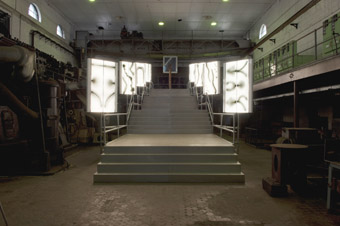
Faraday Cage, 2010 Installation view of the Biennale of Sydney 2010, Power House, Cockatoo Island, courtesy the artist and Gallery Koyanagi, Tokyo
photo Sebastian Kriete
Faraday Cage, 2010 Installation view of the Biennale of Sydney 2010, Power House, Cockatoo Island, courtesy the artist and Gallery Koyanagi, Tokyo
HIROSHI SUGIMOTO IS AN ARTIST WHO USES PHOTOGRAPHY TO EXPLORE AND REALISE CONCEPTS ARISING FROM HIS WIDE-RANGING INTERESTS SPANNING ART, SCIENCE, LANDSCAPE, MATHEMATICS, BELIEF SYSTEMS AND ARCHITECTURE
He uses large-format cameras to create portraits of ideas—often to record light events over long time spans—creating revelatory images otherwise unavailable to human perception. For example, the brief but entire life of a candle or the duration of a movie projected on a cinema screen. In sculptural and architectural forms, he uses materials such as plaster or aluminium to explore the potentialities of shadows and abstract geometries.
For the 17th Biennale of Sydney, Sugimoto devised Faraday Cage, a new site-specific work located inside the decommissioned power station at the western end of Sydney Harbour’s Cockatoo Island.
Here and now, in the early 21st century, Cockatoo Island presents a unique palimpsest of maritime industrial activity and technologies, at once embodied and entombed in a utilitarian accumulation of remnant architectures watched over by the emblematic rusting carcasses of eerily figurative monumental cranes. Across, over and through this savagely cut and gouged sandstone mound, untold kilometres of cables, pipes and conduits trace the entire trajectory of the Industrial Revolution. And all of these systems, devices and machines required power to function—provided in stages by the muscles of men and horses, the circulatory energy of steam and fantastic, mysterious, elemental electricity.
After a long wander down a bitumen road between a towering sandstone quarry cliff and a narrow deepwater dock, the approach to Faraday Cage is via a short oversized tunnel carved through the island’s sandstone body. Behind a giant’s ribcage of angular steel trusses, roughly hewn stone walls drip with seeping rainwater. Rounding a bend, a small accidental atrium space serves as outdoor ante-room to the power station proper. Massive monochrome-grey triple-height wooden doors stand closed at the entrance. Faraday Cage is inside.
Common to the industrial vernacular, a much smaller secondary door is cut near ground level into one of the two huge swing-doors. Reminiscent of the experiential commencement of chanoyu, the Japanese tea ceremony, visitors must stoop to enter the building containing the artwork. There’s a brief moment of instinctual care taken as one steps over this awkward threshold, bent toward the floor. On standing upright again, the shadowed, cavernous space of the defunct power station interior is revealed.
High up, a massive gantry crane sits motionless. Hugging one wall on a raised walkway is a procession of tall metal cabinets adorned with rows of white dials and black switches. An open stairwell of rusted steel descends to an ominous dark void. Down there, the relentless sound of a strong flow of water—an underground stream? Huge iron tubes like taut muscular arms, spherical mesh cages, Frankenstein throw-switches, precision rows of bakelite dials, warning signs—everything here is about containment and flow of enormous pressures and deadly forces. This is energy bondage fetishism born of engineering necessity. Over there, worn wooden workbenches with careless assemblages of abstract metal shapes, rusted drums, stained walls, stained puddles…it is a space filled powerfully with absence. And to this redundant post-industrial setting, Sugimoto introduces various interventions, asserting a different potential.
Of immediate visual impact, the artist has contrived a grand, temporary stairway delineated by steel-pipe bannisters to dominate the central void. Ascending dramatically away from the viewer, it is punctuated with a series of four broad metal platforms, each flanked by a pair of large vertical light-boxes displaying exquisite, luminous examples of Sugimoto’s recent experiments in producing photography with (not of) static electricity.
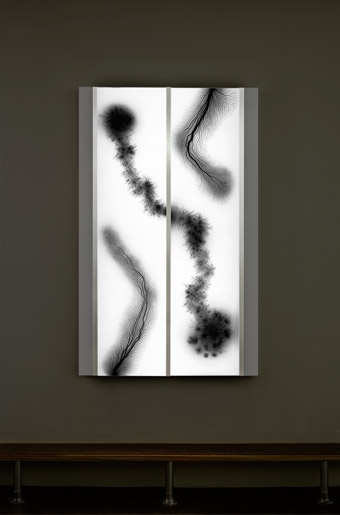
Hiroshi Sugimoto, Lightning Fields Illuminated 003 | 2008 black-and-white film with light box
courtesy the artist and Gallery Koyanagi, Tokyo
Hiroshi Sugimoto, Lightning Fields Illuminated 003 | 2008 black-and-white film with light box
These glowing dendritic monochromes serve as symbolic portraits of the friendship between two 19th century ‘natural philosophers.’ Michael Faraday and William Henry Fox Talbot. Faraday’s investigations led to the industrial development of electricity, while Fox Talbot invented calotype photography and used it as a medium for artistic expression. They were both progenitors in the maelstrom of invention that was the Industrial Revolution—within which legacy we now reside.
Atop the stairwell, which commingles industrial make-do with mnemonic tropes from grand theatre foyers, banal hotel lobbies and aristocratic homes, stands a crude wooden column. Astride this column, above the heads of visitors, is an extraordinary menacing figure—an emanation of elemental power, of lightning’s hair-raising cohort, Raijin the Japanese deity of Thunder. Leaping across time and space from 13th century Japan, this arresting polychrome wooden incarnation expresses the energy of thunder as a bulging, squat, blood-red daemon, fierce mouth agape, green-glass eyes madly staring, oversized golden loin-wrap swirling as he runs across the sky beating great invisible drums with double-headed mallets clenched in brutish fists.
This astounding sculpture—so beautifully conceived and skilfully executed—represents a deity with obscure origins in both Indian Hinduism and Chinese Taoism, adapted into Japanese animist traditions and finally into Buddhism as one of the many protectors of Kannon (Avalokitesvara), the 1,000-Armed Bodhisattva of Infinite Compassion. Long before, Raijin attempted to frighten and menace the Buddha, but after becoming a protector of the dharma, he is said to have saved the islands of Japan from invasion by Mongolian forces in 1274. He stood atop the clouds hurling spears of lightning down upon their fleet.
But 13th century Raijin is not the only deity invoked within the charged atmosphere of Faraday Cage. Sugimoto effortlessly reaches back and forth across time, bringing diverse ‘cultural warriors’ together on the stage of his contemporary art practice. If Faraday and Fox Talbot are tangentially evoked, another ‘giant’ of a different order is made unmistakably apparent.
Near the entrance is a well-known photographic portrait of Marcel Duchamp, elucidating an explicit and appropriately tongue-in-cheek reference to the readymade quality of this amazing building/space. The glass in the frame has been damaged by what appear to be a few light hammer blows, and it’s attached to an old two-wheeled hand-pushed goods trolley. Duchamp—and the weight of his conceptual baggage—has been literally wheeled out and parked in the space.
Nearby and behind, camouflaged within the tangle of decommissioned industrial debris, is a Faraday Cage apparatus, named after Michael Faraday’s invention of 1836. This esoteric example of the device incorporates a common metal bird cage, symbolically referencing the capture and taming of elemental forces for human amusement. The Faraday Cage hides there, apparently dormant but silently accumulating immense and invisible power, until periodically discharging its pent-up electrical energy with startling, noisy arcs of blue-white miniature lightning.
The overall effect is of a strange, dimly lit cathedral-like space. It is at once a homage to and mutation from its original purpose, becoming a place for the generation of speculation on art, science and technology, and for the temporary worship of harnessed elemental forces. Perhaps it includes one which is everywhere apparent in this part-industry, part-art hybrid tableau—the elemental force of the human imagination. The imagination to portray epic deities to explain the terrifying indifferent fury of natural forces. The imagination to radically investigate those same forces and derive different explanations in substitution of deities. The imagination to devise technologies to cage and tame and apply those forces. And the imagination to conjure and realise utterly different forms of art—a urinal as sculpture, electricity as a photograph, decayed post-industrial hulk as contemporary art space.
Hiroshi Sugimoto’s Faraday Cage points directly to this cascade of minds falling through time, sparkling with erratic energies.
Hiroshi Sugimoto, Faraday Cage 17th Biennale of Sydney, Cockatoo Island, May 12-Aug 1
This article first appeared online, June 28, 2010
RealTime issue #98 Aug-Sept 2010 pg. 34
© Gary Warner; for permission to reproduce apply to realtime@realtimearts.net
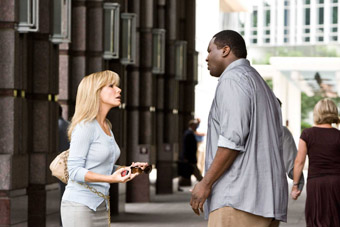
Sandra Bullock, Quinton Aaron, The Blind Side
photo courtesy Warner Home Video
Sandra Bullock, Quinton Aaron, The Blind Side
INTRIGUED BY THE PUBLICITY AROUND THE BLIND SIDE, THE AMERICAN FILM, BASED ON A TRUE STORY ABOUT A WEALTHY, SOUTHERN, WHITE, REPUBLICAN FAMILY BECOMING THE LEGAL GUARDIANS OF AN AFRICAN-AMERICAN YOUTH, BIG MIKE, FROM THE VIOLENT, DYSFUNCTIONAL PROJECTS ON THE WRONG SIDE OF MEMPHIS, I DROVE THROUGH FLOOD WATERS TO THE YARRAVILLE SUN CINEMA TO SEE WHAT HAD BEEN DONE WITH THE STORY.
I viewed it in the light of my script for the feature film, Call Me Mum (see RT74) on a similar, Australian subject—the fostering of a Torres Strait Islander by a white woman, in this case myself. The pure, naïve, ‘missionary’ story The Blind Side told was exactly what I did not, could not and would not tell in Call Me Mum. How could it be, written in the context of the Bringing Them Home report and the Stolen Generations narratives?
I found The Blind Side very problematic on a number of levels. The simple narrative and two-dimensional characters meant the meat was removed from the bone in favour of the heart-warming and feel-good; the most interesting story was that told by the actual family photos screened under the end credits. The film would have sunk without trace except for Sandra Bullock’s Oscar-winning performance as Leanne Tuohy which, to me, as a white foster mother, seemed emotionally inspired—her task-oriented attitude, her closet compassion, her moral/ethical toughness, her emotional restraint. She refused, as I know I did, to ‘enjoy’ an emotional smorgasbord at her adoptive son’s expense. What bonded Leanne Tuohy and Big Mike was not pathological maternity playing itself out through interracial adoption, it was that both exhibited a high score in ‘protective instincts.’ Anyway, The Blind Side got me thinking, again, about the way the white adoptive/foster mother is represented in the few Australian films that deal with this subject of interracial adoption/fostering.
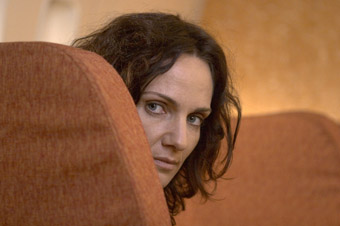
Catherine McClements as Kate, Call Me Mum
So, in the light of my construction of the white foster mother in Call Me Mum, I watched those films again—Chauvel’s iconic Jedda, Tracey Moffat’s ‘remake’ of Jedda, Night Cries—A Rural Tragedy, Anne Pratten’s short AFTRS film Terra Nullius, Andrew Bovell’s story for Anna Kokkinos’ Blessed, Baz Luhrmann’s Australia.
Sarah McMann, the white mother in Jedda—pale, scrawny, pathetic, the sickening prototype of the ‘do-gooder, mission manager,’ pathologically depressed after the death of her baby—takes the orphaned Aboriginal child Jedda as a replacement and determinedly tries to ‘tame’ her Aboriginal ways. Sarah teaches Jedda to bathe, read, play the piano, speak ‘well.’ She tries to stop her associating with the Aboriginal station workers and encourages her relationship with the ‘mission Black’ head stockman, Joe, who narrates the film. The Aboriginal child, Jedda, suffers at the hands of failed maternity.
In Night Cries Sarah McMann returns to the screen as a deathly white, geriatric, wheelchair bound invalid (played by Agnes Hardwick) being cared for, in her final days, by a frustrated, voluptuous Jedda (Marcia Langton), in a white, nurse/domestic’s uniform. Dialogue is replaced in the film by a haunting soundscape—amongst the animal cries, ‘corroboree, drum and didgeridoo’ sounds, cracking whips, laughter, the noise of a distant train are the poignant raspings of the dying Sarah and, finally, the extended, heartbreaking weeping of Jedda curled foetally beside the corpse of her dead ‘mother’ on a railway siding platform.
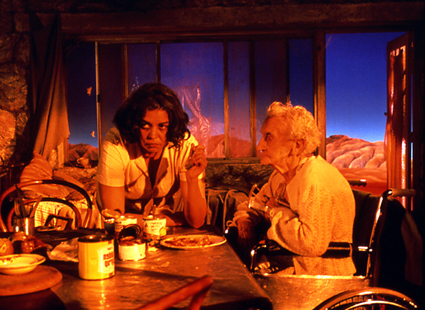
Sandra Bullock, Quinton Aaron, The Blind Side, photo Ralph Nelson, courtesy Warner Home Video; left – Marcia Langton, Agnes Hardick, Night Cries, Tracie Moffat
courtesy Ronin Films
Sandra Bullock, Quinton Aaron, The Blind Side, photo Ralph Nelson, courtesy Warner Home Video; left – Marcia Langton, Agnes Hardick, Night Cries, Tracie Moffat
The mother here is a classic study of the Kristevan abject—ghastly white and wasted, the skin of her scrawny hands and feet old and scaly, emotionally and psychologically absent yet powerfully demanding in her helplessness and finally, a corpse. The film shifts gears from ‘a rural tragedy’ into the horror genre. The abject here is complicated by race and yet Jedda’s grief is real, affective and, in some way, accomplishes a reconciliation.
But that monstrous, old Sarah McMann, she’s one of the unholy undead. She won’t bloody well stay down—because she ain’t dead by a long shot. There she is again, geriatric, demented, pitifully hungry for love—white, white, white skin, hair, nightdress—haunting the well-heeled, leafy, leafy, leafy Melbourne suburbs and the silver screen in Blessed. Abject in her pathologically starved maternity, Laurel Parker denies her adopted Aboriginal son Jimmy access to his birth mother, hiding the humble present she leaves at the door for his 13th birthday; secreting it away behind her volumes of Marx (Karl not Groucho) in her well-stocked bookcase. This time Jedda/Jimmy challenges this ‘mother,’ although it’s still not dialogue; she’s good and dead, and there’s no reconciliation. At the morgue to identify her body he denies her once, twice. “She’s not my mother,” he says to the morgue attendant. “No, this is not my mother.” She has been killed as a direct result of this thwarted craving for maternal love when, in her senile delirium, she embraces and kisses a young thief she mistakes for Jimmy. Thus Bovell proves his racial ‘goodness’ through an unproblematic demonising of the adoptive, white mother—a real soft target.
Alice, in Terra Nullius, does dialogue with her adoptive mother, again reprising the ‘taming’ versus ‘Indigenous instincts’ arguments. The construction of all these Sarah characters is pretty much covered by the discussion between Doug and Sarah McMann in Jedda: “Still trying to turn that wild little magpie into a tame canary, Sarah? Well you won’t do it by shutting her windows at night to keep out the cry of the corroboree, dance and didgeridoo and you won’t wipe out the tribal instincts and desires of a thousand years in one small life.”
Luhrmann’s Australia does, to some extent, progress the discussion in the construction of Lady Sarah Ashley. Nicole Kidman presents us with another Sarah McMann but this is a more contemporary Sarah, finally out of the 50s, and one more in keeping with the adoptive/foster mothers I know. Despite some reservations about her young Aboriginal charge Nullah going walkabout, despite wishing, vaguely, to teach him ‘manners’, despite her inability to have children herself, her adoption and maternity are not constructed as something missionary, pitiful and pathological. It has more in common with Bullock’s Leanne Tuohy in its heightened empathy and task-oriented drive. Nullah is not a blank, needy orphan to be ‘loved’ either. Sarah Ashley responds to Nullah’s agency. He says to her, any number of times, “I will sing you to me.” The two mothers, Nullah’s birth mother and Sarah Ashley, combine forces to protect him from being taken to the mission by the ‘coppers’ at the behest of his violent white father. Finally, Kidman’s Sarah understands and accepts Nullah’s need to go walkabout with his grandfather and she waves goodbye.
How are race and child protection perceived in this country? The voices of adoptive mothers of Indigenous children go unheard. We, with our experience of interracial adoption/fostering, are treated as virtually non-existent except as abusers and thieves. All the parents I know are more like Sarah Ashley and have gone to extraordinary lengths to find and link their Aboriginal or Islander child with their birth families and are acutely aware of the needs of the child to have access to, and knowledge of, their Indigenous heritage and culture. A number have adopted or fostered through Aboriginal agencies yet are still cast as Sarah McManns. (I tried to voice some of this in Call Me Mum.) Most importantly, we know first hand the effect the singular, overarching ‘stolen’ narrative can have on a teenaged child searching for an identity as all young people do. I showed this in Call Me Mum when foster son Warren is cajoled into repeating the ‘stolen’ story by a journalist.
One academic who has researched the subject is Denise Cuthbert. She found that white mothers “have been rendered not only silent but their experiences are virtually unspeakable in the present context” (“Holding the Baby: Questions Arising from Research into the Experiences of Non-Aboriginal Adoptive and Foster Mothers of Aboriginal Children,” Journal of Australian Studies, December, 1998). Proving the point, Damien Rigg, in critiquing Cuthbert’s work, decries “her failure to adequately consider the potential need for some stories to remain unspoken” (“White mothers, Indigenous families, and the politics of voice,” Australian Critical Race and Whiteness Studies Association Journal, e-journal, Vol. 4, No.1, 2008). But the constant theme in Australia, and we hear it particularly from Nullah, is that knowing and telling your ‘story’ is the most important aspect of any culture.
To tell these stories we need to find ways to live in the complexities of the ethical paradox, cultivate a political sophistication, not reinscribe some Australian Good, not fall into the blind spot of assumption as Andrew Bovell does. Our cultural products, such as film, need to speak “against the grain of the good and its incumbent fantasies” (Jennifer Rutherford, The Gauche Intruder: Freud, Lacan and the White Australian Fantasy, 2000). They must acknowledge, explore and articulate the blind spot. Listen to all the stories, not just the socially and politically sanctioned ones.
This article first appeared online June 28
RealTime issue #98 Aug-Sept 2010 pg. 28
© Kathleen Mary Fallon; for permission to reproduce apply to realtime@realtimearts.net
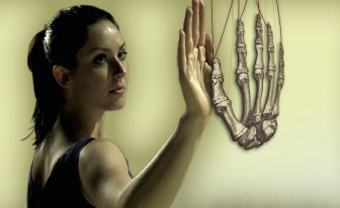
Rachelle Hickson, Reading the Body, Sue Healey & Adam Synott
SUE HEALEY AND ADAM SYNOTT’S READING THE BODY APPEARS ON A SUSPENDED SCREEN IN THE CENTRE OF THE IO MYERS STUDIO, DRAWING THE VISITOR INTO THE DARKENED SPACE. ATTENTION IS HELD BY ITS ELEGANT JUXTAPOSITION OF A MOVING FEMALE PERFORMER (RACHELLE HICKSON) OVERLAID WITH SKELETAL ANIMATIONS THAT ATTACH THEMSELVES TO THE DANCER’S BODY.
New Zealand poet Jenny Borholt’s text provides more layers: “The body as intention. It means well. Is full of good intent. Body as desire.” It’s a fittingly elusive and alluring entrée to the experience of GESTURE, part of ReelDance 2010, a screen-based exhibition running across the UNSW Kensington Campus and, according to the notes, “exploring the performance territory between dance, the everyday and dramatic body.”
Curator Erin Brannigan writes, “Choreography can play with our knowledge of gestural performance, occupying the space between walking and dancing, action and elaboration, communication and expression…These works take the choreographic manipulation of gesture further by spreading the performances across screens, dislocated spaces, manufactured locations and defamiliarised temporalities.”
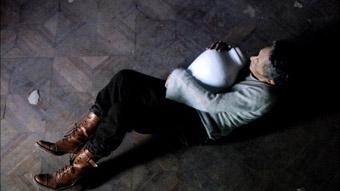
Anna Mittel, Promise of Fallen Time, Isabel Rocamora
Isabel Rocamora’s video Promise of Fallen Time beckons from a curtained corner of the studio, compelling us to follow the full 19 minutes of its sombre scenario. We are led inside a derelict building, which might be an antechamber to the underworld. A slightly built but powerfully intense performer (Anna Mittel) advances tentatively through this grey world. Her movements are minimal but precise, appearing at times almost involuntary. She encounters a man (Enric Majo) and together they navigate the surfaces of this place (a derelict palace in Barcelona as it turns out), appearing sometimes to be propelled along its walls. Where they’re heading is unclear but the sense of foreboding is palpable, enhanced by the sound of a soft gong and whirring, thrumming chords. A door opens to reveal a young boy with a large dog. The frame freezes. The world turns and we begin again with the two dancers in another place, another time. I head for the light.
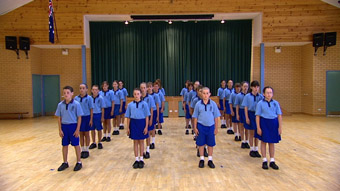
Assembly, Kate Murphy
Positioned in a triangle of monitors above head height as well as on a single monitor over the lift, Kate Murphy’s Assembly takes its place in the West Foyer of the Australian School of Business.
Twenty-four children in school uniforms stand in four rows inside a school hall. From time to time their arms move sideways or clutch at their hearts, hands inscribe crosses on their chests. The rhythms of the children’s gestures and their wobbly stillness fit neatly into the fabric, subtly shaking the bland edifice they occupy
I read in the program that these children are moving in response to “reflection exercises” being read from prayer cards that are used daily in the Australian Catholic primary school system: “Close your eyes and imagine that you are being held closely, tenderly in the arms of a most loving person…Whisper in your heart, “I am surrounded by God’s loving protection.” I shiver.
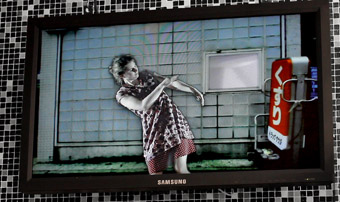
Vivaria, Sam James, installation view
Sam James’ Vivaria presumably takes its title from those places where animals or plants are kept for observation or research. Installed against a “pixellating” wall of black and white mosaic tiles, Vivaria displays the cream of Sydney’s contemporary dance species—Linda Luke, XX, Peter Fraser, Lizzie Thompson and Martin del Amo—each displaced into and onto an array of architectural spaces. The video works within its own grid, a gradually rotating cube with each facet revealing another setting, another performer. Gesturing at internal states, the dancers move as if feeling their way in the dark. Meanwhile buildings transform around them. Their setting renders tentative gestures more dramatic. An arm is caught inside or has it colonised concrete? “A co-joining of impossible spaces and bodies elicits the dancer as a hybrid creature—anthropomorphic like Descarte’s Animal Machines,” writes James. The work is richly textured, at turns elegantly pensive and playful, a meditation on the competing presence of bodies and the built environment.
To experience Vivaria in full requires standing for 26 minutes halfway up the stairs—not something that comes easily to students in the School of Busy-ness who are more likely to accumulate a vision of the work in fragments. I imagine Vivaria functions quite well in this way too. One student asked me why I’m so immersed. “Are you searching for the meaning?” he asks and I imagine one could do worse these days in the School of Business.
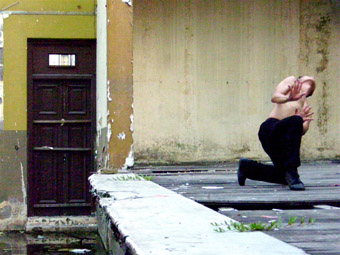
Tony Yap, Melangkoli – Sen Siao, Sean O’Brien
Sean O’Brien’s Melangkoli Sen Siao is housed on the 3rd floor of the Robert Webster Building where the two-screen work is installed in the tight reception area of the School of English, Media and Performing Arts. Earphones in place, listening to Madeleine Flynn and Tim Humphrey’s score, I sit inches away from office workers to be transported to the steamy streets of Melaki (Malaysia) and Yogjakarta (Indonesia) where dancers Tony Yap and Agung Gunawan are enacting intensely passionate rituals of grief in response to interior and exterior landscapes, sites that are “key to the performers, to their bodies, to their memories.” In this small, contained space I feel entirely displaced.
GESTURE offers many such disconcerting breaks in the continuum, a series of small shocks that open the mind to the world beyond surfaces. It’s a pertinent provocation and a gift to that increasingly fluid and fast moving entity called the student body.
–
GESTURE: Performance/Film/Dance,ReelDance Installations #04: Reading the Body, choreographer, filmmaker, editor Sue Healey, digital artist Adam Synott, music Darrin Verhagen, animation Adnan Lalani, cinematography Judd Overton, performer Rachelle Hickson, Io Myers Studio; Promise of Fallen Time, director, choreographer Isabel Rocamora, featuring Anna Mittel, Enric Majo, photography Nic Knowland, sound design, Jem Noble, Io Myers Studio; Samuel James, Vivaria, dancers Martin del Amo, Lizzie Thomson, Peter Fraser, XX, Linda Luke, sound Gail Priest, consultant Paul Gazzola; Assembly, Kate Murphy, Australian School of Business; Melangkoli—Sen Siao, writer, filmmaker, editor Sean O’Brien, choreography, dance Agung Gunawan, Tony Yap, music Madeleine Flynn, Tim Humphrey, Robert Webster Building; University of NSW, June 15-19
RealTime issue #97 June-July 2010
© Virginia Baxter; for permission to reproduce apply to realtime@realtimearts.net
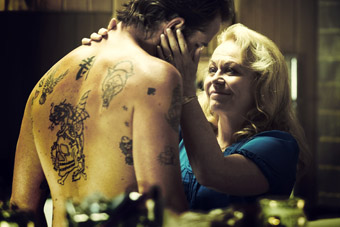
Sullivan Stapleton and Jackie Weaver, Animal Kingdom
FROM THE OPENING SCENE, ANIMAL KINGDOM GRABS YOU BY THE SCRUFF OF THE NECK AND GIVES YOU A GOOD SHAKE. UNRELENTING, IT PULLS YOU IN TO A MOTHER’S DEN OF A SUBURBAN UNDERWORLD, WHERE YOUNG CRIM BROTHERS FIGHT EACH OTHER AND A BUNCH OF RATBAG COPS TO SURVIVE.
David Michôd (formerly mild-mannered editor at IF Magazine) is a VCA graduate with connections to the Edgerton brothers, having co-written a number of shorts with Joel and Nash before directing his breakthrough Crossbow (2007), which won the Melbourne International Film Festival award for Best Short Film with screenings at Venice, Sundance and Clermont-Ferrant. The development process for Animal Kingdom was a slow boil, taking nearly 10 years to craft the screenplay (based loosely on Melbourne crime stories) and every frame settles into your psyche, with a muted violence and sense of unease; a brilliant psychological drama.
Michôd couldn’t have hoped for a better ensemble to bring his take on corruption and crime in Melbourne’s suburbs in the 80s to life. All performances are note-perfect. With its positioning of men always on the brink, coiled and ready to spring, set around a quietly manipulative mother, the film recalls Rowan Woods’ The Boys. It also acts as an antidote to the hyped up razzamatazz of Underbelly, a show that dumbed down as it left Melbourne becoming less interested in character as it wore on to its second and third series. Animal Kingdom works on another level entirely. Michôd is not so much interested in the stylistic shoot-em-up and tits’n’arse life of the petty crim as in the internal spaces negotiated in a family where criminality has become entrenched, the degree of loyalty within when things become compromised, the lull when every character has begun a moral slide.
Rather than a seedy-glam look at the crimes, we’re thrust into a world in transition where the men themselves sense a shift: Barry (Joel Edgerton), settled with wife and child, wants to escape the game altogether while Craig (Sullivan Stapleton) is too caught up in the paranoia of his speed-haze to be able to read situations readily. And no-one does menace like Ben Mendelsohn. As ‘Pope’, he’s mesmerising, and every time his blue-grey Hawaiian shirt comes into frame (and it’s often what you see before his face), the tension both on screen and off escalates and the audience squirms. His ability to intimidate is not about large outbursts of violence but quiet moments of stalking. Using cat-and-mouse tactics, he tries to goad the truth out of others (accusing Luke Ford’s Darren of being gay because of the type of drink he pours), in a tone that belies his desperation to be the head of the family, the one to turn to as confidante: “Any time you want to talk to someone,” he intones smoothly, as they move past him and head out the door.
Newcomer James Frecheville as 17-year-old Cody, thrown into the family after his mother OD’s, is large and immobile, his face registering not much—an asset, he soon discovers. He looks older than his years but his sensitivity is revealed in the way he treats his girlfriend Nicky (another impressive debut performance from Laura Wheelwright) and longs to be a part of her family.
Reigning over these tall and physically imposing men is the diminutive ‘Smurf’ (Jacki Weaver), her cute nickname covering for a woman who will do anything to protect her brood. There’s a faint whiff of fear in the air as she manipulates her men with cuddles and long, lingering kisses on the mouth, positioning her body in a way that suggests she still sees them as small boys (and their behaviour can be reduced at times to that too). As ‘J’ says in voiceover, his uncles are men who—at the heart of it—are afraid, but too scared to show it. In a nice twist, only the cop, Detective Leckie (Guy Pearce), does not live in a world ruled by fear (although his colleagues, on the take, clearly do).
Animal Kingdom is a brilliant and exciting feature debut for David Michôd. The film’s title cleverly reminds you that, stripped of their clothes, their bravado, their posturing, these men are like lost creatures, products of their environment; it’s do or die. The complexities of character, the evocation of an era, the subtle acting, the deliberate camera, the sense of a community dying out—these all signal a director of great natural skill with an intimate knowledge of filmmaking (and the ability to relay this to his cast and crew) making Animal Kingdom one of the most dynamic films of recent years, and one for repeated viewing.
Animal Kingdom won the Dramatic Jury Prize for World Cinema at the Sundance Film Festival and is currently in national release.
Animal Kingdom, writer, director David Michôd, producers Liz Watts, Bec Smith, director of photography Adam Arkapaw, editor Luke Doolan, production designer Jo Ford, composer Antony Partos, sound designer Sam Petty
This article first appeared online, June 28
RealTime issue #98 Aug-Sept 2010 pg. 29
© Kirsten Krauth; for permission to reproduce apply to realtime@realtimearts.net
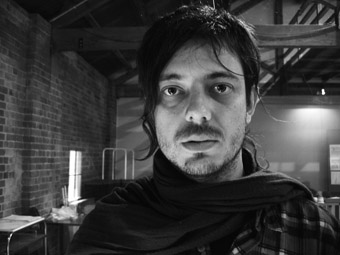
Benedict Andrews
photo Pia Johnson
Benedict Andrews
Benedict Andrews has proven himself to be the most consistently interesting and challenging theatre director in Australia. His totality of vision creates immersive theatrical worlds that seamlessly merge passion, intelligence and a heightened visual sensibility.
Most satisfying is the rigour with which Andrews and his collaborators generate design, media and character motifs which evolve and mutate with a frightening logic (the drinking in Who’s Afraid of Virginia Woolf? becomes a flood of ice and spilled liquids underlining emotional abjection; the glass wall between performers and audience in Eldorado fluctuates between windows on the home and a world at war—one nightmarishly unspecified).
Marked physicality—whether realised as utter stillness (Cate Blanchett as Richard II in The War of the Roses) or panicky desperation (everyone in Moving Target)—is characteristic of the director’s work, again with a strong pictorial, even choreographic awareness.
A sense of immediate contemporaneity is also evident, not least in plays chosen from the past. In Andrews’ production of The Season at Sarsaparilla 1960s Australia is meticulously evoked but as if seen through the eyes of Reality TV’s Big Brother, with cameras installed within the set to provide close-ups both amusing and chilling. The director’s account of Shakespeare’s Measure for Measure for Company B takes this surveillance motif even further. The sense of a shared present is also evident in Andrews’ engagement with violence—whether in his realisations of the psychotically closed worlds of Mr Kolpert or Fireface or the unidentified wars offstage in Eldorado or The City or the explicit ones in The War of the Roses.

Robin McLeavy, Arky Michael, Measure for Measure, directed by Benedict Andrews
photo Heidrun Löhr
Robin McLeavy, Arky Michael, Measure for Measure, directed by Benedict Andrews
Facilely criticised in some quarters for being party to a ‘director’s theatre’, in “Directors + playwrights: the living & the dead,” Andrews took exception to an attack on young directors by playwright Louis Nowra: “I work with living writers and dead ones. I do not breathe some sigh of relief as Louis Nowra might imagine when working on a classical text as if I were suddenly free to dance on the playwright’s grave. Each project is demanding and all consuming and I enter it with questions and fantasies I want to explore with the community of people I work with and the audience who will watch our work.”
Benedict Andrews was born in Adelaide in 1972, graduated with First Class Honours in Bachelor of Arts from Flinders University Drama Centre, directed locally, including a stint as artistic director of Magpie2 for the State Theatre Company of South Australia. Magpie, formerly a Theatre in Education company, was now boldly targetting the 18-25 year-old demographic but Andrews had barely made his nonetheless palpable mark before Australia Council funding was withdrawn (Murray Bramwell, “A future or a blown youth?,” RT 23, p9, not yet available online).
In 1996 Andrews wrote for RealTime (RT 16, p6, not available online) about the experience of seeing works by Robert Wilson, Pina Bausch, Peter Stein and Robert Lepage, as well as Polish and Japanese performance, at the Edinburgh Festival and Fringe. In 1998 he was awarded the Gloria Payten & Gloria Dawn Fellowship which he used to travel to Europe as well as New York. His New York report for RealTime (“Looking for Elsewhere,” RT 30, p34) included a vivid account of the hard-edged performance style of the work of Richard Maxwell—perhaps an influence. What Andrews’ writing revealed was a young Australian theatre director’s welcome and rare openness to new forms and diverse performance languages.
Andrews went on at various times to work as assistant director to Neil Armfield, Michael Gow and Jim Sharman and was appointed resident director of the Sydney Theatre Company 2000-2003. Since then he has created productions for Malthouse, Sydney Theatre Company and Company B. He directs annually in Australia and at Berlin’s Schaubuhne am Lehniner Platz (see reviews of his Berlin productions of Sarah Kane’s Cleansed and David Harrowers’ Blackbird) and presently lives in Reykjavik, Iceland.
Andrews will direct King Lear at the National Theatre of Iceland in Reykjavik in December this year and the Monteverdi opera The Return of Ulysses for the Young Vic and English National Opera in London in 2011. His production of Mozart’s The Marriage of Figaro for Opera Australia is now scheduled for 2012. According to an article in the Sydney Morning Herald, Andrews also has film projects in mind and is to have his poems published in Blast magazine.
In the same interview, Andrews said of Measure for Measure, “I want to stage it like a psycho-sexual thriller, like a David Lynch film…the play is very much concerned with desire and law and strange doubled realities, with another reality seeping through another reality” (June 2, www.smh.com.au/entertainment). Our review of Measure for Measure will appear in the July 12 RealTime online edition and in the RT 98 print edition.
A substantial list of reviews of Andrews’ productions appears below along with an interview and two examples of the director’s writing. One of these is an introduction to the work of Christoph Marthaler, a European opera and theatre director greatly admired by Andrews and written in anticipation of the staging of Marthaler’s Seemannslieder for the 2007 Sydney Festival.
Benedict Andrews has created many memorable works, not all of them perfect but sharing a boldness of vision and a recognisable evolving personality. His productions of Marivaux’s La Dispute (in Timberlake Wertenbaker’s far from funny version of the comedy), Mr Kolpert, Fireface, Who’s Afraid of Virginia Woolf? and Caryl Churchill’s Far Away seem as vivid in my recollections as when I saw them. But it’s The Wars of the Roses and, above all, The Season at Sarsaparilla that have made the deepest mark, for the scale and fidelity of their vision. The hugely popular production of the Patrick White play and its critical success laid to rest the “directors’ theatre” debate. As James Waites has argued (see full article) it revealed the work to a be a classic of Australian playwrighting and the production worthy of an international audience.
There’s much more that could be said of Benedict Andrews—about the influence of contemporary performance, of media culture, of German theatre (via English engagement with German plays but also directly and in collaboration with German artists) and the evolution of a very particular design sensibility (working with a small, recurrent group of designers), at first glance very European, but as in The Season at Sarsaparilla, totally and radically responsive to our sense of the past as viewed through the present.
Keith Gallasch
artist website
www.benedictandrews.com
reviews
degrees of pathos
keith gallasch: marius von mayenburg’s fireface, 2001
the arts of ageing, the limits of vision
keith gallasch: beatrix christian’s old masters, 2001
tough nights at home
keith gallasch: david gieselmann’s mr kolpert, 2002
benedict andrews: self, style &vision
keith gallasch: calderon’s life is a dream, 2002
beckett-land: spirit and letter, stage and screen
keith gallasch: beckett’s endgame, 2003
once upon the here and now
keith gallasch, caryl churchill’s far away, 2004
sarah kane in berlin
adam jasper smith: sarah kane’s cleansed, 2004
sydney performance: killer logic
keith gallasch: julius caesar, 2005
two ways of looking at blackbird
daniel schlusser, david harrower’s blackbird, 2006
strange words, alarmingly familiar
keith gallasch: marius von mayenburg’s eldorado, 2006
shocking symmetries
keith gallasch: albee’s who’s afraid of virginia woolf?, 2007
another time now
keith gallasch: the season at sarsaparilla, 2007
adelaide festival: the games art plays
keith gallasch & virginia baxter: moving target, 2008
the war within, the war without
keith gallasch: the war of the roses, 2009
violations: sex, history, form
keith gallasch: martin crimp’s the city, 2009
interviews
the luminous nightmare of marius von mayenburg
keith gallasch: benedict andrews on el dorado, 2006
inside looking out
keith gallasch talks with marius von mayenburg, 2008
writings
directors + playwrights: the living & the dead
benedict andrews replies to louis nowra, 2001
christoph marthaler: in the meantime
benedict andrews on a great european director, 2006
related article
wunderkind mysteries
john bailey: melbourne performance, 2010
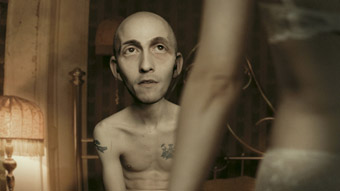
Metropia
JACK SARGEANT IS THE AUTHOR OF A NUMBER OF KEY BOOKS ON ‘OTHER’ CINEMAS. THERE’S DEATHTRIPPING: THE EXTREME UNDERGROUND AND THE SEMINAL BEAT WORK NAKED LENS: BEAT CINEMA, BOTH OF WHICH HAVE BEEN REPRINTED THREE TIMES IN ENGLISH, WHILE NAKED LENS HAS BEEN TRANSLATED INTO RUSSIAN AND JAPANESE. SARGEANT HAS ALSO EDITED BOOKS ON ROAD MOVIES AND PUNK ON FILM, AND WRITTEN ESSAYS ON ANDY WARHOL, DRUGS ON FILM, THE TRANSGRESSIVE PERFORMANCE ART GROUP COUM TRANSMISSIONS ON FILM, 9/11 DOCUMENTARIES AND MUCH MORE.
I first met Sargeant in 2000 when he brought the Beat film retrospective to the Brisbane International Film Festival (BIFF), one of the festival’s many incredible programs over the last decade. He met Richard Sowada, who “was instrumental in bringing me to Australia.” Sowada, now Head of Film programs at the Australian Centre for the Moving Image (ACMI), had been the founder of the REV fest, now the Revelation Film Festival, one of Australia’s most important screen cultural events. Sargeant spoke to me about life in his third year at the festival.
A festival programmer today has to juggle a lot of different things—what’s the most interesting thing about working on REV for you?
It’s interesting, because it has to embrace different, simultaneous discourses. There’s the ‘underground’ thing, but that is more of a minority interest. You also have to make sure people come and you screen larger films. I’ve always got to be programming for that combination. For example, this year we’re showing Mike Kuchar’s film, Sins of the Fleshapoids, a work which will be unknown to many people, and is pure 60s underground cinema. On the other hand we’re showing a documentary about The Doors called When You’re Strange. It’s different because it doesn’t have Ray Manzarek talking on about the past. Instead it’s got hitherto unseen footage and music all the way through. That’s a lot more of an accessible film, a more recognisable festival title, and I imagine other festivals will pick it up too. For me all kinds of films are important in the mix.
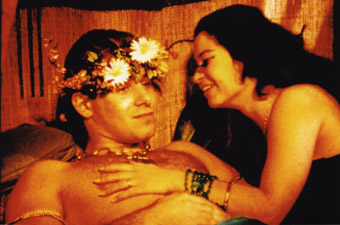
Sins of the Fleshapoids
Because REV was started without much money and with passion rather than commercialism or other agendas at its heart, it’s always had its own identity. I realise it’s a very privileged position in which I am working. It’s a great film festival: it has a high degree of mutability. We’re not really mainstream, not really indie, not really underground, but we enter all of these areas. The festival is a form of hybrid work. It’s an advantageous position to be in. We have a great audience who come and enjoy the festival, people who are open to film and every year there are new people coming, which is great. It has a presence in Perth as part of the culture there.
Tell me about your work on the Magickal Songs, Mythical Histories and Fictitious Truths program for the 2010 Biennale of Sydney?
I found out there was a meta-thematic running through the Biennale based on Harry Smith, who I’ve written about. Fairly early on I discussed a list of films that would go hand in hand with these themes drawn from Harry’s work, which, if you are familiar with it, offers a perfect starting-point for so many different cultural possibilities. It’s been a great experience, to devise a screenings program around Smith and exciting to extend it to include experimental performers such as Lawrence English and Noko, as well as films like the Ira Cohen documentary Kings With Straw Mats, the doco In The Realms of the Unreal about Henry Darger and Craig Baldwin’s Mock Up On Mu. And there’s the Nick Zedd film, War is Menstrual Envy—I’m pretty sure it’s never been screened in Australia before. It’s a psychedelic punk avant-garde film, pure mayhem and a beautiful piece of art cinema. I just thought it’s about time that film got seen and framed in a different context.
When I first met you at BIFF, film festivals were seriously carnivalesque affairs where a lot of fun and discussion was had, inside and outside the cinema. How have festivals changed? What’s the role of fun in all this?
A festival exists to show film and get people to think and share their experiences about cinema. As soon as people move away from that, I think there are problems. When I write about films or program them I try to frame them the way I see them. I don’t think film should be framed the way the marketing people of a film company want us to see them or the way certain theorists or historians have framed them. Of course, I don’t necessarily want people to agree with me. I want them to know why I think a film is interesting and go from there. It’s important as a curator to put one’s imprint on things. That said, I argue with the people involved in REV. It’s not like they all bow to my taste. Obviously people have different tastes. Part of the process of curating is negotiating, defending, justifying decisions, sometimes even with myself. If I am passionate I will argue down to the last minute about why I think that a film is good. It’s not that other people’s opinions aren’t valid. It’s that, I think, as a curator or as a writer on culture, that’s what you have to do, you have to stand up for things you like.
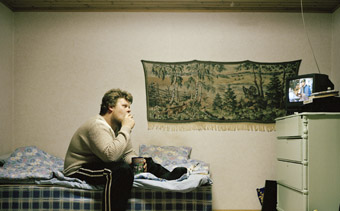
The Living Room of the Nation
It seems one of the things you stand up for is diversity—your programming has always tended to combine lots of different genres and approaches. Why’s that important?
I think it’s important to have a range of genres and styles and themes going on, it’s important to get that scope, not just be doing the same thing, or variations of the same thing. The ideal is to have diversity, not predictability. To be moving in all directions at once. What was the term Trans Media Exploration used? Quaquaversal. Trans Media were a 60s commune and art group; Genesis P-Orridge, later of Throbbing Gristle and Psychic TV was involved with them for a while. I like the idea of embracing the ‘quaquaversal.’ Or ideas like becoming. Those concepts of how to be fluid and flexible and move through an infinite number of possibilities.
Is that close to a philosophy of programming?
Philosophy is a bit of a problem for me, because if you seriously have a philosophy then I believe that you’ve got to destroy it. As soon as you have just one way of doing something you become conservative. And you have to avoid conservatism, and avoid your own conservative tendencies that allow you to fall back on the familiar or the safe. I think people become too cynical. It’s important to retain that freshness, that excitement and interest about things, to keep coming to them anew.
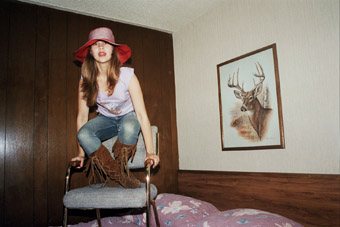
Joanna Newsom, The Family Jams
When was the last time you found something interesting that you never thought you’d be into before?
All the time. Because I’m always looking to find new things, new areas of interest. I’m always looking for new kicks, you know? I get bored easily and always want to find new stuff to amuse myself. I’m always finding things I like because I’m always looking for things.
I think one needs to approach one’s work with a kind of fury. By which I mean an intensity. It’s important to avoid being lazy and not engaging. It’s also essential to realise that just because you can see one minute of something on YouTube doesn’t mean you’ve seen it, there’s so much more out there.
I’m really interested in the things that are excluded, for example recently when people were talking about Australian cinema, I was interested in what was left out of the definition. As soon as I know there’s something they’re not telling me, I always want to know what it is. (See Sargeant’s “Australian Film: A Wider Screen,” RT95)
I think it’s important to remember that culture is like an iceberg: the little bit that peeks above the surface is what everyone’s talking about. But what’s interesting is what’s under the surface. Interestingly, on some icebergs there’s even more under the surface than usual; sailors call these icebergs growlers. To me that is the perfect metaphor; there’s this huge thing growling underneath and this is what I want to know about. Most people just stick with what’s above the surface. But knowing what’s out there, wondering about it all the time, makes me want to look deeper.
* * *
advance notice
Jack Sargeant tells us that his 2010 Revelation Film Festival will include Mike Kuchar’s Sins of the Fleshapoids; a Philip K Dick-style science fiction animated feature, Metropia; an Irish post-apocalyptic melodrama, One Hundred Mornings; a Russ Meyer double bill; a WA feature, The Sculptor; the hip LA coming of age film, We Are The Mods; The Family Jams, a documentary about alt.folk, Joanna Newsom et al; Living Room of the Nation, a poetic visit to six Finnish living rooms; Double Take, the much acclaimed and witty experimental examination of Alfred Hitchcock and Cold War Politics by Belgian artist Johan Grimonprez; and the documentary Reporter, about a committed US newsman in the Congo.
Revelation Film Festival, Perth, July 8-18; www.revelationfilmfest.org
RealTime issue #97 June-July 2010 pg. 21
© Danni Zuvela; for permission to reproduce apply to realtime@realtimearts.net
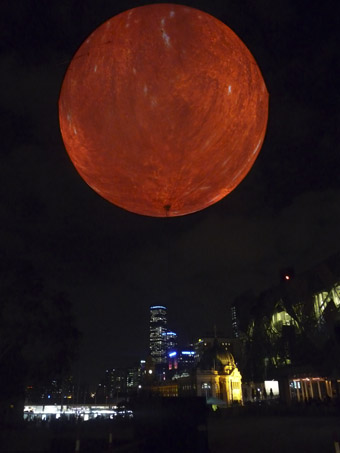
Solar Equation by Rafael Lozano-Hemmer for The Light in Winter, Federation Square
courtesy Federation Square
Solar Equation by Rafael Lozano-Hemmer for The Light in Winter, Federation Square
As we pass from Spring to Winter and the Winter Solstice approaches this is an edition inflected with change. The photograph on this page is of Rafael Lozano-Hemmer’s giant creation for Melbourne’s The Light in Winter festival, Solar Equation, a work which will hover over Federation Square for a month. The artist describes it as “a piece for the sky”, mathematically monitoring changes on the surface of the sun. You can interact with its equations (see interview). Other changes are marked by the final showing of the National Review of Live Art in Glasgow and our review of James Waites’ Whatever Happened to the STC Actors’ Company?. Pierrot Bidon, the founder of Archaos has died and we celebrate his re-making of circus. Elsewhere we congratulate Lawrence English for 10 years of ROOM40, report on changes in dance touring strategies and music commissioning tactics. Chirstinn Whyte notes radical shifts in dancefilm thinking at Moves 10 in Liverpool, Mike Walsh at the Hong Kong Film Festival sees Chinese feature films searching for new formulae and Jana Perkovic wonders if Live Art will take in Australia. Is more change on the way? Our annual arts and education edition and report from the Next Wave Festival in RealTime 98 will have something to say about that.
RealTime issue #97 June-July 2010 pg. 1
© Keith Gallasch; for permission to reproduce apply to realtime@realtimearts.net
{$slideshow} Here we offer a mini-gallery of performance strategies for dealing with that unruly entity—the audience. Takers for Rotazaza’s Wondermart look afresh at everyday places (see review). In IRAA’s The Persistence of Dreams: The Sandman, an audience of one invites a group of friends to join them at their home to be bound and blindfolded as Roberta Bosetti recounts a dark bedtime story (see review), while Hole in the Wall participants are moved about in four rooms on wheels (see review). In Oil Can, at Sydney’s 4A Centre for Contemporary Asian Art, passersby are invited to climb into one of 15 oil cans to stand motionless alongside the artist Tatsumi Orimoto, for 30 seconds, which they obligingly do. Read about Oil Can here.
RealTime issue #97 June-July 2010 pg. 2-3
© RealTime ; for permission to reproduce apply to realtime@realtimearts.net
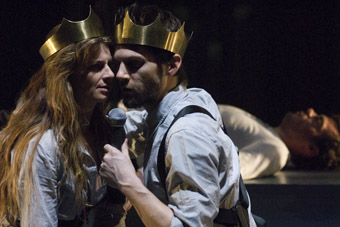
Amber McMahon, Cameron Goodall, Brett Stiller, Vs Macbeth, STC & The Border Project
photo David Wilson
Amber McMahon, Cameron Goodall, Brett Stiller, Vs Macbeth, STC & The Border Project
THIS YEAR’S ADELAIDE FESTIVAL WAS AWASH WITH DIALECTICAL ENTANGLEMENTS: CULTURES MELDING, DISCIPLINES MERGING, TEXTS COLLUDING. THE ARTIST TAKES THE GIVEN AND MAKES IT NEW OR, IN SOME CASES, NEWISH.
vs macbeth
In Vs Macbeth, the given is William Shakespeare. And the new is danger. The Sydney Theatre Company’s Residents and Adelaide’s own Border Project teamed up for this new work that sought to reimagine Macbeth through the accidents that have made it the superstition-laden “Scottish play” that it is. The conceit is honourable. After all, the dangers of theatre can be very real. Performing it and witnessing it can be like walking along a cliff top backwards. Yet, this production never raises a solitary hair.
The problem is not in conception, but in realisation. From the outset, there is an undeniable whiff of Occupational Health and Safety, from the high visibility jackets to the yellow hazard tape. Yes, they mark the space as perilous, but they are also measures designed to dampen the unexpected and to ward off danger. If anything, they mark this theatre as eminently safe and flag in fluorescent clarity the fact that we should be prepared for things to go safely awry. When paintball guns are brought out for every death scene, so too is a cumbersome protective curtain of cyclone fencing meant only to protect the front row from pink shrapnel. Suspense? No, thanks.
The lack of tension in the space is only compounded by the bathos exerted by a series of interruptions—a missed entrance, a hurt hand. The sporadic nature of the interruptions suggests an unwillingness to commit wholly to the conceit, though it must be said that some of the actors commit themselves to the text beautifully. Indeed, it is the half-heartedness of the reimagining which is most problematic. The central melody here is still Shakespeare’s voice but the counterpoint is little more than an embarrassed suggestion of revolt, leaving even the erstwhile iconoclasts in the audience yearning for tights and doublets (the lycra-hungry had to head to Back to Back’s Food Court for their fix (RT 92, p42).
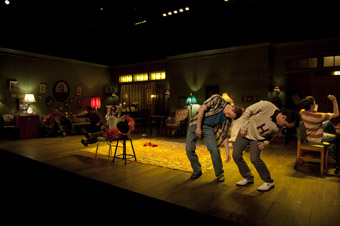
The Sound and the Fury, Elevator Repair Service
photo Matt Nettheim
The Sound and the Fury, Elevator Repair Service
the sound and the fury
Fittingly, there wasn’t an inch of spandex to be seen at Elevator Repair Service’s staging of April Seventh, 1928, the first part of William Faulkner’s novel The Sound and The Fury. The company is familiar to these shores. Last year’s six-hour Gatz [RT91, p43], saw them transpose the entirety of The Great Gatsby to the stage. In that work, the dialectical frisson between the forms of prose and theatre was a little elusive—the vastness of Fitzgerald’s text was inflected by the joy of reading it rather than the thrall of deconstructing it.
In The Sound and The Fury, a newer work, there is a sense that director John Collins and his ensemble are developing their modus operandi. Again the text is read from the novel but this time not its entirety. Again the text swirls about in a non-literal mise en scène but seeks now to represent the world of the novel rather than an anonymous backdrop. And again the narrative voice propels the text forward along with dialogue but this time it is complemented by projected surtitles that swing our attention in a different way to the written quality of the language. These changes, along with the more stylistically demanding source, serve to make this a far more complex and concentrated production than the sprawling, durational transparency of Gatz.
Remarkably, despite its complexity, the sense of theatrical storytelling and its grounding in prose is rarely lost. The disorienting carousel of actors and characters manifests the chronological jumps of Faulkner’s prose but also produces a fractured perspective, a kaleidoscopic confusion of glimpses into the Compson household that are as rowdy and shabby as the characters themselves. Amongst this kinetic frenzy of staging and the odd Woosterish dance interlude, Collins has wisely left room for moments of transcendent stasis, when the text, projected, is allowed to speak for itself. Yet these moments work not only because of the strength of Faulkner’s writing but also because of the strength of the theatrical text around it—Hegelian synthesis at its finest.
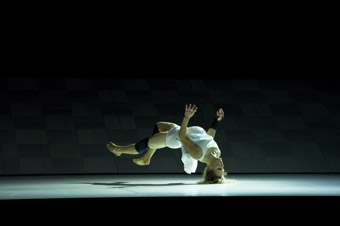
Be Your Self, ADT
photo Chris Herzfeld
Be Your Self, ADT
be your self
Across town at Her Majesty’s, Australian Dance Theatre was premiering its latest work, Be Your Self, an investigation of the body-mind compact inspired by the work of 18th-century Scottish philosopher David Hume. As director Garry Stewart notes in the program, Hume’s A Treatise on Human Nature suggests that humans are “nothing but a bundle or collection of different perceptions, which succeed each other with an inconceivable rapidity, and are in a perpetual flux and movement.” This quotation is almost a pithy précis for the show itself.
It begins with a clinically white and vast stage. As a dancer slowly and meticulously begins to ripple movement up from the floor, through the feet and into the legs, another performer speaks an impressively detailed, thorough and ceaseless description of the neurobiological processes involved in what the dancer is doing. It is an inspired overture that deftly introduces the two disciplines that inform this work: science and dance. The former is taxonomical and exhaustive, the latter expressive and essential. If we were to think of them linguistically, science is the langue and dance the parole.
Unfortunately, the promise of the beginning is not maintained throughout. The piece itself sets out to be somehow analogous to the erratic nature of our human thoughts and physicality, but it feels instead like a physical illustration of the text we heard at the beginning without further development or consideration. The rhythms are punchy, the soundtrack is banging, the lights are in full wizardry mode but the result is a continuation of the clinically detached aesthetic of the start, without any of the discoveries that merit the scientific method, making for a surprisingly joyless experience.
Nevertheless, there is consolation to be had in the uber-athletic performances of the ensemble. The ADT dancers are surely some of the most muscular in the world and their broad shoulders and tendency towards explosive piston-like movement is displayed here to great effect. The set by New York architects Diller, Scofidio + Renfro is largely circumstantial until the very end, when a wide ramp set at 45 degrees is rolled to the front of the stage. As carefully designed animations are projected onto the surface of the ramp, isolated sections of bodies emerge through its weave, swimming in a protean liquid of colours and swirls. It is an assured finish and a striking image, but it is simply the final element in a “collection of different perceptions” that, combined, paint a very cold, distant and unwelcoming sense of what it is to be human.
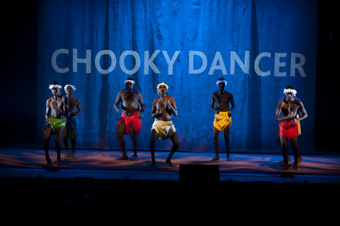
Ngurrumilmarrmeriyu (Wrong Skin), Chooky Dancers
photo Matt Nettheim
Ngurrumilmarrmeriyu (Wrong Skin), Chooky Dancers
ngurrumilmarrmiriyu (wrong skin)
A much warmer, though hardly uncomplicated vision of humanity was to be had at Her Majesty’s a fortnight later with the premiere of Ngurrumilmarrmiriyu (Wrong Skin), which teamed Elcho Islands’ Chooky Dancers with director Nigel Jamieson.
The Chooky Dancers, like Justin Bieber, Susan Boyle and the Back Dorm Boys, came to fame on YouTube. In a dark gym hall they danced to a remix of Zorba the Greek in a unique hybrid of dance vocabularies—part Yolngu, part hip hop, part disco, part Busby Berkeley. The cultural provenance of their performance is breathtakingly complicated, but unadulterated joy and immediacy are the key to its appeal. Existing in a geographically isolated community that, thanks to modern telecommunications, can consume an entire world of creative influences, the Chooky Dancers made manifest postmodern intertextuality not as an ironic exercise in form but as a fundamental expression of self.
Jamieson’s attempt to build on the Chookies’ self-expression and foster it into a piece of theatrical storytelling is an unenviably difficult but worthy undertaking. The director chooses to use the complex Yolngu moiety laws as the basis for a forbidden-love story, with overt references to West Side Story along the way. This gives him a straightforward narrative hook on which to hang various dance sequences and video montages of life on Elcho Island, but it also imposes a stifling rhythm on proceedings and creates a strange tension: are the performers co-creators or merely the subjects of the work? Occasionally, it even reveals the technical shortcomings of the dancers when they are required to step out of their own style. At other times though, the show is a brilliant populist work that sheds light on an oft-overlooked part of our country, and the charisma and pleasure of the performers is disarming and contagious. Indeed, whether it be the Zorba or a riff on a Bollywood dance scene, the most engaging moments are those in which the mechanics of the theatre step out of the way and allow the Chookies to simply do their thing.
–
2010 Adelaide Festival: Sydney Theatre Company & The Border Project, Vs Macbeth, writer William Shakespeare, director Sam Haren, designers Sam Haren, Matthew Kneale, costumes Mel Page, lighting Govin Ruben, composer David Heinrich, video Richard Back; Odeon Theatre, Feb 26-March 6; Elevator Repair Service, The Sound and The Fury (April Seventh, 1928), text William Faulkner, director John Collins, design David Zinn, lighting Mark Barton, sound Matt Tierney, costumes Colleen Werthmann, projections Eva von Schweinitz; Dunstan Playhouse, March 11-14; Australian Dance Theatre, Be Your Self, concept, direction, text Garry Stewart, choreography Garry Stewart and ADT, design Diller, Scofidio + Renfro (DS+R) Architects, lighting Damien Cooper, sound Brendan Woithe (colony nofi), video Brenton Kempster (ZuluMu Design + Post), costumes Gaelle Mellis; Her Majesty’s Theatre, Feb 20-28; Ngurrumilmarrmiriyu (Wrong Skin), writer-director-designer Nigel Jamieson, associate director, movement Gavin Robins, film & video design Scott Anderson, video producer Mic Gruchy, lighting Trudy Dalgleish, composers & sound designers Basil Hogios, David Page, performers The Chooky Dancers; Her Majesty’s Theatre, Adelaide, March 11-14
See RT 96 for reviews of Ligeti’s Le Grande Macabre and the London Sinfonietta at the Adelaide Festival
RealTime issue #97 June-July 2010 pg. 4-5
© Carl Nilsson-Polias; for permission to reproduce apply to realtime@realtimearts.net

Xiao Hei, SXSW 2010
courtesy the artist
Xiao Hei, SXSW 2010
SOUTH BY SOUTH WEST IS A WINDOW INTO WHAT’S HAPPENING NEXT, ACCORDING TO THE WHISPERS OF THE SOCIAL MEDIA HYPE MACHINE. HOPING TO GET A LOOK THROUGH THAT WINDOW, I FOLLOW THE WHISPERS TO AUSTIN, TEXAS.
First, some terminology. South By Southwest is more usually written SXSW and pronounced ‘South By.’ It’s a 23-year-old umbrella event encompassing several specialist media sub-events. It attracts, they say, 25,000 people every year. It has an enormous program, comprising exhibitions, film screenings, panels, yet-to-be-classified online happenings and a huge number of showcase concerts.
In some art forms—music, film and interactive media—the event has a serious global profile. I’m here for the latter. SXSW has become the favoured venue for turning your latest networked interaction venture into an instant fad using the power of champagne and a well-spruiked launch. It’s where you go to meet up with Big Names, to make it clear that this season’s innovations include you. It’s here the myopic vision of the American public just might snap into focus on your new idea. If you work in locative and networked worlds you might, like me, recall it as the place where Twitter debuted; where geosocial networks hold treasure hunts; a hotbed of geocaching where augmented reality-layers quilt the city. A place where cyberpunk technoaesthetic fantasies precipitate from the hyperbole-supersaturated air. An embassy of the American future towering in the present.
In Australia, where we have our own special kind of myopia, it isn’t on the map. SXSW may tower in the US, but it is invisible over the Pacific horizon. Sheer geographical accident plants me in the path of the wagon train to Texas in the lead-up to the festival. I don’t resist, head spinning with half-remembered buzz and rumour, and futuristic hype. I fire up the browser and see what’s scheduled. There are endorsements from the Cocteau Twins, Village Studios and a half-dozen Silicon Valley startups on the festival’s web-page, dammit! What could go wrong?
The first SXSW project to engage me can be found without joining the throng in Austin. London-based Reality Jockey (RJDJ) have packaged up a custom mobile app for the occasion called Hijack SXSW using your phone’s microphone input to create indecipherable algorithmic remixes of the audio content of your environment. An accompanying website helps attendees share generative remixes of the sounds of festival events. The soundscape algorithm is painstakingly produced, harmoniously incorporating every conceivable input from motion sensor to GPS. It’s beautiful, mysterious and no doubt transgresses intellectual property rights; in short, it has everything to make it a viral hit at the kind of festival that I wish I were at. It’s a promising start—and incidentally, just the latest in a long line of interactive pieces from the mobile interactive music startup, which freely distributes tools to assist reactive music composers.
Unfortunately, while RJDJ makes SXSW look good from afar, the experience of actually walking through the door is less alluring. The dizzying hype of SXSW is matched by the vertiginous expense of entry: at US$1350 for a full ticket it’s closer to the price of a high-level professional conference than an arts event. It’s either a sign of arrogance or a promise of excellence to charge as much as the Sri Lankan per-capita GDP for a week-long event. It’s also a pretty steep rate for Americans in the midst of severe recession. Coming overland to Austin, my train rolls across a landscape of alienation and poverty. Trailer parks, bail-bond loan offices and abandoned strip malls, sun-baked and silent desert prisons, public toilet queues clogged with doped-out drug users. I’m no expert in the political economy of the USA but I cannot help see the abysmal income divide here.
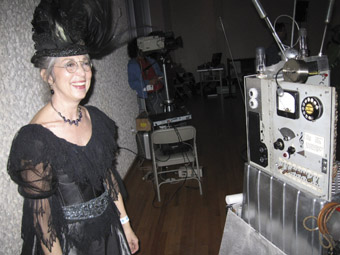
A steam punk fairy godmother at Plutopia
photo Dan MacKinlay
A steam punk fairy godmother at Plutopia
My first few physical encounters with the festival are unexciting: performances that claim to be ‘innovative’ because they play music with synthesisers as well as guitars; a ‘game art’ exhibition that is nothing but framed concept sketches for a manga-themed shoot ‘em up; and fliers telling you to sell your music in Guitar Hero. Soon enough, I gravitate to the fringes, where the interesting things are hiding—like Plutopia, a one-night anarchic, psychedelic counterculture celebration. The whole thing is cloistered away from the Convention Centre crowd at the Mexican American Cultural courtyard by the river. On one side, a local produce shop and on the other, microbreweries and distilleries. In the middle, roving troupes of steampunk designers, circus performers and dorkbot delegates showcase their wares. A bustled Victorian grandmother hawks interstellar neutrino machines made from washing machine parts. Geeks in labcoats are tending a giant glowing brain. On the main stage sits Chinese artist Xiao He in a straw hat, working up a variegated soundscape of custom digital delays and reprocessed vocals in one of my favourite performances of the whole program.
Futurist Bruce Sterling delivers a curious and rambling keynote speech for Plutopia, surveying digital fabrication, internet-facilitated regional cooperation and the potential for social media in sustainability. His opening statement crystallises the concerns that have driven me to the periphery of SXSW: “Tomorrow I’m speaking at SXSW, which is sponsored by Pepsi and Chevy. Tonight I’m speaking at Plutopia, which is sponsored by steampunk fairy godmothers who make cool stuff out of junk.”
Outside, the logos of those particular corporations are tessellated into ambient infomercial wallpaper across every surface. Branding saturates everything: presentation screens, the festival guidebook, social network sites, the pavement, passing cars, electrical outlets. It is a preview of a dystopian future of complete advertising domination, which is to say: something like living on the present-day internet. I feel like I have entered the world’s largest corporate marketing focus group. It is so suffocatingly intense that it’s hard to find space for anything not strictly commercial.
Back at the convention centre, stuff does manage to happen in the gaps between gimcrack promotions: panels featuring various Web 2.0 luminaries, trade shows, screenings. Queues for the overbooked sessions are long and entry is uncertain. When I manage to get into something it tends to be a presentation by a harried refugee from some shaky startup whose primary concern is not innovation in form or content but how to market their existing content in the middle of an economic downturn. Making your projects profitable is nothing to sneer at, of course, but as one panel after another turns into a group counselling session to allay fears of falling into the poverty chasm, I begin to wonder if there are any messages here other than boom year nostalgia.
The Austin Museum of Digital Art has at least harnessed the power of nostalgia for good. Their entry into SXSW is themed around naïve video art, 8-bit animation and digital primitivism hearkening back to the Reagan administration. A multi-headed video setup displays shifting mixes of single channel video works by Gangpol & MIT and Mato Atom. There are a number of excellent live performances, including a rhythmic aural streetscape by Pierce Warnecke. The stand-out is Austin local Party Time! Hexcellent!, who generates live visuals using custom software on an original Nintendo Entertainment system. Her minimalist algorithms and grimy television colour palette eclipse the hypersaturated phosphor colours of her peers as she patiently details her pictographic language in blocky squares and arrows. Compelling.
Eventually I wind up at a launch for the new book by Virtual Reality and reactive gaming pioneer Jaron Lanier, where the man himself eulogises the media business models of the past. Occasionally he punctuates an argument about the vacuity of modern digital arts by playing nameless woodwind instruments and challenging people to Google them. I don’t wholly agree with Lanier’s thesis—his book supposes that the digital status quo reifies and depersonalises creative labour, and that Web 2.0 practice is wiping out the potential for dignity in artistic life or individually expressive aesthetics. After five days of SXSW, however, I can’t remember why I disagree.
Lanier eloquently sums up the insecurities of his audience of digital creatives. Here we sit, self-identified digerati, at a festival made for people like us, and yet the day’s highlights comprised the chance to shove our business cards at a dwindling crop of future employers and mourn for lost security. We are here looking for the future; many of us feel we have been pivotal in building it, and yet we seem to have done ourselves out of the dividends. But if Lanier makes these regrets and fears explicit, the festival feels reactionary in many other implicit ways—the perennial dominance of good old fashioned rock music, the retro technology, the frenetic commercialism crowding out the art. This party might rock like it’s the height of the boom of half a decade ago, but its grip on that vanished past is fearfully white-knuckled.
SXSW 2010, Austin, Texas, March 12-21, http://sxsw.com
RealTime issue #97 June-July 2010 pg. 6
© Dan MacKinlay; for permission to reproduce apply to realtime@realtimearts.net
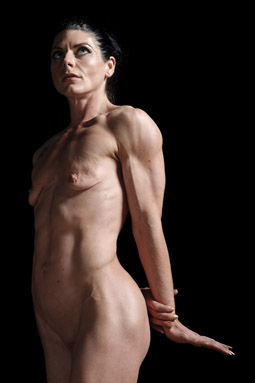
Francesca Steele, Routine
courtesy the artist
Francesca Steele, Routine
THE BELL THAT SOUNDS THE BEGINNING OF THE 30TH NATIONAL REVIEW OF LIVE ART ALSO SOUNDS THE BEGINNING OF THE END: THIS IS THE FESTIVAL’S FINAL INCARNATION IN ITS CURRENT FORM. THE BELL IS SWUNG BY JÜRGEN FRITZ, WHO, LIKE ALL THE ARTISTS IN THIS YEAR’S PROGRAM, HAS PLAYED A PART IN THE FESTIVAL’S HISTORY (HE IS ONE OF THE FOUNDING MEMBERS OF DURATIONAL PERFORMANCE GROUP BLACK MARKET INTERNATIONAL).
Fritz moves slowly at first, the bell making only dull thuds as his arm travels mere inches from his side, and it is several minutes before his swing has accelerated enough for a clear note to ring out. Gradually, carefully, the swings build in energy, until for 30 minutes or so he is swinging exuberantly, ecstatically, joyfully shaking the sweat from his forehead. As a squad of Scottish pipers join in, Fritz surrenders his whole being to the single act of ringing the bell, wildly swinging for love and country and art and folly.
It’s a perfect beginning to the festival, a gesture that both celebrates and says farewell to the NRLA. But at the same time, what is alluring is that it is only a gesture, one that Fritz repeats in different contexts and different cities (for example, in Brisbane in 2008, RT88). It is not for anything or because of anything, but simply the pure, repetitive action: it has a what and a when but no why. Over the five-day festival, densely packed with overlapping performances running from morning until late in the night, my memory accumulates many similar moments: gestures that are beautifully, powerfully meaningless. David Richmond touches his hand to his heart, extends his pinky finger, and raises it in the air. Sheila Ghelani turns to her audience, looks them in the eye, and licks her sugar-coated lips. Iona Kewney hurls and coils her body as dynamically and articulately as a pianist might move her fingers. Lee Wen, clutching a pair of pig’s feet, lowers his twisted frame to lap milk from the floor.
On this anniversary occasion, these gestures are like gifts rather than proclamations. They do not ask me to agree or disagree with them, but are invitations, offerings that I may choose to accept or refuse. Adding live video to a layering of film-within-film, Stephen Partridge’s hands dance furtively and playfully with images of themselves from the past. In the palm of my own hand, Helen Paris from Curious shows me a film in which she lies in the sea on an inflatable raft. Enclosed in a glass display case, Alastair MacLennan blows up balloons and makes gentle traces with his hands, wafting them effortlessly like a bat’s flight slowed down to a visible tremble. For hours he sits, his eyes closed, the case filling up with white balloons. The gesture of blowing up balloons is like an offering of breath, a wasting of space in honour of our being together.
Appropriately for the 30th anniversary, balloons are one of the recurring motifs of the festival. In another durational piece, Elvira Santamaría Torres methodically gathers air into white bin bags, bundling them together to float through the Arches’ vast spaces. At the end of his 30-hour occupation of one of the smaller performance spaces, Michael Mayhew leaves behind a glorious forest of multi-coloured balloons, several of which are carried out by spectators and continue to haunt the remaining events.
Alongside these intimate gestures are, of course, others on a bigger scale: more spectacular, more theatrical, more sensational. And accompanying these are some of the logistical problems that have unfortunately become familiar features of the NRLA over the years. Arriving at the box office at the advertised time to sign up for Ron Athey’s Self Obliterations, I’m told that all the slots were allocated two hours ago. As one of several hundred spectators gathered around Kira O’Reilly’s Untitled (syncope), I catch nothing but brief glimpses of her quivering and teetering body. Through a small window in the door, I peer at Yann Marussich’s Brisures and witness his slow, painstakingly beautiful emergence from a box of broken glass—but I know my experience is nothing like that of those who were at the front of the queue and who are now immersed in a carefully orchestrated world of light and throbbing sound.
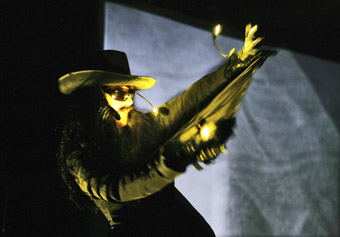
Julia Bardsley, Aftermaths
Some of the other larger-scale events at the NRLA are restagings of works presented at other festivals; for example, Julia Bardsley’s AFTERMATHS and Forced Entertainment’s Void Story both premiered at London’s SPILL 09 (RT 91). The proliferation of other platforms for this kind of work is probably one reason why the NRLA is closing down in its present form. In the early 1980s there weren’t any other opportunities for work like this to be shown in the UK, and the NRLA evolved from the artist-initiated Performance Platform to be a regular event. Now there is SPILL and a reinvigorated LIFT in London, regional festivals such as Birmingham’s Fierce and Newcastle’s Wunderbar (RT95), artist-led initiatives such as the itinerant Forest Fringe and Bristol’s Residence, and regular support for Live Art from fixed venues such as Bristol’s Arnolfini, the Bluecoat in Liverpool, Cardiff’s Chapter Arts Centre, London’s Chelsea Theatre and the Colchester Arts Centre.
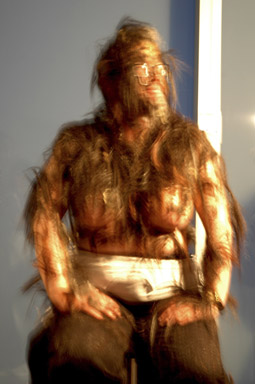
Oreet Ashery
courtesy the artist
Oreet Ashery
And yet, at this final NRLA, I’m aware of the kind of work that is uniquely possible in an environment such as this. It’s hard to imagine a different setting for work such as Oreet Ashery’s Hairoism, in which, over several hours, Ashery’s helpers glue scraps of hair to her shaved head in order to reproduce the characteristic hair styles and facial hair of a series of prominent male figures in the Israeli/Palestinian conflict. Because it is organised toward the production of precisely conceived images, the live element to this work might seem incidental, as if only the final product matters. But it is the live production of the images that makes this work so powerful: Ashery’s fixed, glassy stare and her wonderfully particular, sedentary body; the overwhelming barrage of documentary footage and news clips that fill the room; the silent presence of her deliberately caricatured helpers, collecting hair samples from the wandering audience; and, in fact, the material presence of the documentation of the image in the form of polaroids and simultaneous video feed of Ashery’s body-in-formation.
Likewise, the festival has always been a supportive environment for one-to-one performances, and one of the most powerful examples this year is Francesca Steele’s Routine. From the publicity information I learn that she has been training as a bodybuilder for over a year as her artistic practice. As I queue for over an hour for my five minutes with her, I have a pretty strong suspicion about what the encounter will be. This turns out to be exactly right: on entering the space, I am welcomed onto a small platform by a naked and silent Steele. Inches away from me and staring into my eyes, she moves her radically transformed, de-feminised body through a series of poses that display her lean musculature. Despite knowing exactly what to expect from the work, and despite my familiarity with these kinds of intimate artistic experiences, I leave the encounter palpably shaken, an unknown and untraceable energy working away inside my stomach and trembling in my hands and fingers.
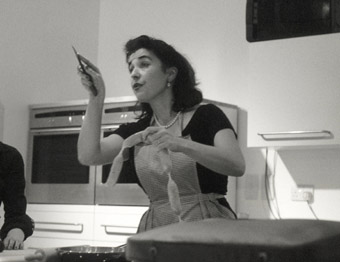
Marica Farquhar
courtesy the artist
Marica Farquhar
Finally, one the most moving and life-affirming events of the festival is Marcia Farquhar’s The Omnibus. Farquhar announces that she will honour the NRLA’s 30 years by ruminating, non-stop, for 30 hours about the last 30 years of her life—during which time she raised her children, struggled with depression and returned to art school as a mature student. (Okay, so it didn’t actually turn out to be 30 hours; initially she planned to invite audience members to stay with her overnight in the theatre, but Health and Safety regulations dictated that members of the public had to vacate the building between 2am and 10am.)
Farquhar’s previous performances have been marked by her meandering, unabashedly self-critical and open-ended monologues. This durational format pushes her to a new extreme. Instinctively, she produces an extraordinary mash-up of two different etiquettes: that of a host in a social situation, and that of a performer in a theatre event. As audience members come and go, she interrupts whatever story she is in the middle of to bid each person goodbye, and cheerfully greets each new guest as if at a dinner party. Trying to catch each newcomer up on what the project is about and what has already been discussed, she is constantly stuttering, winding back to the beginning of the event, forgetting what she was talking about, and reconstructing the thread of the event even as it unravels.
As with the commemorative agenda of this final NRLA, there is a risk that simple nostalgia will dominate. But Farquhar grasps at distant memories, and the more recent past of this particular event, not in order to save the past from being lost but in order to be here now, together. And, despite announcing that she has no plans for a big finale at the end of the 30 hours, we find ourselves stumbling into one: on our feet, singing along to her Sex Pistols original 45 in unison: “No future, no future, no future for you.”
National Review of Live Art, The Arches and Tramway, Glasgow, March 17-21
RealTime issue #97 June-July 2010 pg. 8-9
© Theron Schmidt; for permission to reproduce apply to realtime@realtimearts.net
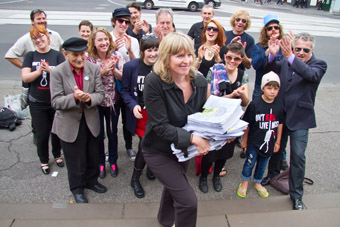
Save Live Music in Melbourne – a petition with 22,000 signatures calling for the the delinking of live music and “high risk” licencing conditions, delivered to the Victorian Government April 7
photo www.carbiewarbie.com, with thanks
Save Live Music in Melbourne – a petition with 22,000 signatures calling for the the delinking of live music and “high risk” licencing conditions, delivered to the Victorian Government April 7
IT IS A COMFORTING THOUGHT THAT AUSTRALIANS ARE GREAT AT ENTREPRENEURSHIP AND SMALL-SCALE INNOVATION, BUT LET ME SUGGEST WHAT WE DO EXTREMELY BADLY: LONG-TERM AND LARGE-SCALE STRATEGIC PLANNING. IF SUSPICION OF GOVERNMENT INTERVENTION IS RIFE, IT MUST BE BECAUSE WE HAVE VIRTUALLY NO EXAMPLES OF A WELL-THOUGHT-THROUGH, AMBITIOUS AND SUCCESSFUL STRATEGIC INTERVENTION. FOR EVERY INNOVATIVE ECO-BUILDING AND LANEWAY FESTIVAL, WE HAVE A FAILING PUBLIC TRANSPORT NETWORK OR A FORGOTTEN CARBON EMISSIONS SCHEME.
One-person innovation has traditionally been the domain of artists—this is the thinking behind many a ‘creative industries’ policy. The corollary is that artists are perceived as situated outside large systems (ministries, policy frameworks) as subcultural rebels, creating on the geographical, economic and social margins, needing no infrastructural support for their ephemeral creations.
Yet, looking at Australian arts in urban terms, another picture emerges. My research finds almost every arts venue in Melbourne since 1991 clustering in loose clouds around public transport, state art centres and educational facilities, and moving around to avoid the worst of the real estate boom—in music, design and performing arts alike. It is tempting to attribute artistic success solely to individual genius, but there is in fact cultural infrastructure in place, which includes schools, low rents and central locations, on which every artist relies, and this infrastructure is what cultural policy can begin to protect.
the importance of breeding places
It is common in artspeak to talk about defunding artistically irrelevant institutions, as Gavin Findlay does (RT96, p8), but it is actually the uncertain funding of institutions that emerges as a bigger problem. For small- and medium-sized companies, flagship buildings to perform in and independent programming venues are a vital link to peers, critics and audiences. Convinced of art’s ephemerality, we forget the importance of ‘breeding places’: spaces and events that yield exposure, attract audiences, house archives, provide education and build social centres for the fleeting world of the arts. They serve their role best when their location and program times are unchanging and predictable—because then they can become meeting points, exchange points, networking points.
When we speak of the ‘independent’ artist, we sometimes forget how much artists depend on each other. Our few remaining theatre archives, the only memory-keepers we have, are tied to institutions with longevity (STC, Dancehouse, arts centres, state libraries); while VCA, Dancehouse or La Mama in Victoria, or Performance Space and TINA in NSW, are actual incubators of ‘scenes’ (social capital, an aesthetic, training), ensuring continuity to the arts. We can myopically boast a long list of important places and events that have ceased operating, from Pram Factory to the Green Mill dance festivals. Our lack of regard for ‘breeding places’ is best exemplified by the treatment of Performance Space, possibly the most important space for contemporary arts in Australia. A living incubator of innovation since the 1980s, having nurtured dozens of our most important performers, it has still not been recognised as a cultural flagship, let alone endowed with a permanent space of its own or operational autonomy within CarriageWorks.
The arts can and do punch back—but only if the issue can be sold in more than artistic terms. As I’m writing this, Victoria’s liquor licensing laws are being tweaked to save The Tote, a ramshackle music venue, from closure. Politicians were more worried about the voting preferences of the 200,000 protesters than the cultural significance of The Tote, granted; but the 200,000 saw The Tote as an indispensable part of Melbourne’s culture, not a den for a handful on society’s margins. However, this hasn’t come out of nowhere: at least since Espy, the iconic music pub in St Kilda, was threatened with closure in 1997, live music has been promoted as a key part of Melbourne’s ‘cultural’ specificity. Yet there must be a better way to protect cultural incubators than with rallies.
culture as a given
For many arts practitioners, the debate on the national cultural policy may look suspiciously like yet another thing to complicate already-fuzzy KPIs—but it would be unwise to limit the discussion to arts funding, because it is about more than that. To admit to a ‘culture’ is to say that there are things that we do that are important and worth protecting, because they make us who we are, regardless of their economic, health or social outcomes. In a sense it is irrelevant whether ‘culture’ includes media (as in Germany), is defined as “anything that stimulates closeness” (as in Croatia) or is left undefined (as in many European countries that nonetheless have robust cultural policies). It is primarily a principle of protection.
Artists should understand the power of words. At the moment, one of these is ‘economy.’ Being good or bad for the economy, vaguely defined, is argument enough to defend or shelve a policy. Agreeing that we have a ‘culture’ would allow a whole new string of arguments to be made and, with due respect to David Throsby, defend the arts not on the grounds of its goodness for the economy, community or health, but simply as important for our culture.
Of course, arts policy in Australia already assumes ‘culture’: funding of opera is otherwise inexplicable. But let me give you a sense of what else ‘culture’ might protect: in the 1990s Amsterdam initiated Broedplaats (“Breeding Places”), a squat protection policy, recognising them as incubators of creativity. “No Culture Without Subculture” was the mayor’s rallying cry. Formation of ‘alternative cultural centres’ is common throughout Europe, with a kind of light heritage overlay protecting use, rather than the form, of a building. Palach, in Croatia, has been an alternative music venue/gallery/café/performance space since 1968. It has had its dull phases, of course, but a new generation of bright young things inevitably emerged, taking over the same central location and benefiting from access to facilities, a ready-made audience and previous generations of artists. Similarly, the Save the Espy campaign in Melbourne could not rely on existing state laws to protect the beloved music pub: it didn’t qualify in terms of architectural, community or social heritage. After a prolonged fight, Espy was ultimately saved in 2003 because the local council managed to install sufficient protection on the grounds of local ‘cultural’ significance.
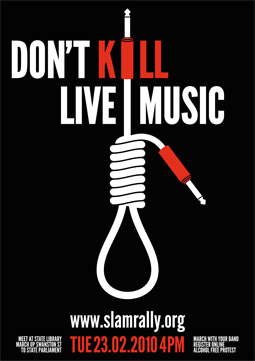
Save Live Music in Melbourne (SLAM) poster
cutting across policy areas
Another intervention that only national cultural policy can achieve is the nurturing of systems, interventions that cut across policy areas and require departmental collaboration on the federal level. Many have been picked up in the submissions to Peter Garrett’s cultural policy discussion website: simplification of artist work visas, greater support for regional and overseas touring (having no national culture, Australia has no sustained cultural diplomacy either). To this I would add improvements to arts education, understanding the importance of subcultures and integration of arts institutions into the urban fabric—giving them centrality, advertising, public transport. What was the point of investing millions in CarriageWorks, I wonder, if it is still sitting next to an underdeveloped train station, in a dark street, untouched by a single useful bus line? A comparatively cheap intervention into public transport would have quadrupled the returns on the enormous investment. Instead, one of Sydney’s most central performance venues manages to remain hidden to most of its population.
But what I would like to see most is some meaningful form of social security for artists. In most countries with ‘culture’, artists benefit from tax exemptions and reductions, access to free health insurance and pension funds, and different forms of income support that usually don’t require active job seeking. It is a measure that gives artists some modest existential certainties, but it’s also an intervention that the Australia Council for the Arts cannot initiate on its own.
art without culture…?
Judging from the way we mangle our strategic policies, there is no reason to assume Garrett’s national cultural policy will get everything right. But defining ‘culture’ as an intangible, but protectable and nurturable good is the first step towards building systems, structures and strategies that ensure longevity for what we’ve got. We need culture if we want to remember, and be remembered ourselves; if we want our art to matter. Without ‘culture’, we’d have no culture wars, true, but also no values, meaning, sense. Without culture, nothing differentiates the arts from any other unprofitable industry. And without culture, there is literally no subculture.
Jana Perkovic is working at the University of Melbourne on an ARC-funded research project titled “Planning the Creative City”, studying the geographical clustering of independent arts in Melbourne, Sydney and Brisbane, and the relationship between arts policy, demographics and urban planning. She writes for RealTime on contemporary dance and performance in Melbourne and Europe.
RealTime issue #97 June-July 2010 pg. 10
© Jana Perkovic; for permission to reproduce apply to realtime@realtimearts.net
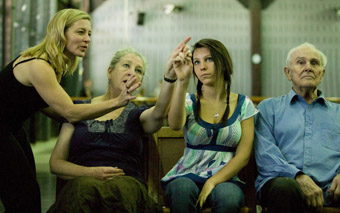
Kate Champion in rehearsal with cast members from Force Majeure’s The Age I’m In
photo Lisa Tomasetti
Kate Champion in rehearsal with cast members from Force Majeure’s The Age I’m In
THERE IS SOMETHING IN THE AIR IN AUSTRALIA CONCERNING AUDIENCE ENGAGEMENT. THE AUSTRALIA COUNCIL FOR THE ARTS’ PUBLICATION OF “MORE THAN BUMS ON SEATS: AUSTRALIAN PARTICIPATION IN THE ARTS,” IN MARCH THIS YEAR, PICKED UP ON A DESIRE FOR MORE PROFOUND ENGAGEMENT WITH THE ARTS FROM AUDIENCES ACROSS THE NATION.
Arts Queensland’s bold Coming to a Stage Near You strategy for performing arts touring, launched in 2009, combined with its Regional Stages partnership with the Australia Council, is pioneering a ‘demand-driven’ model for regional touring. And the Roadwork performing arts consortium which I reported on in “Australian Dance, Unseen at Home” (RT95 is supporting a 12-venue national touring circuit for “adventurous” dance and theatre productions.
I spoke to John Baylis, Associate Producer at Performing Lines, to better understand whether this ‘push’ for two contemporary performance productions per annum through the network was going to be met with a ‘pull’ from their audiences. Baylis responded, “Having established the network and sent our first production out [Force Majeure’s The Age I’m In], the next challenge is to make sure that tours are successful locally. We do not want tiny audiences and for venues to lose confidence in the audience appeal of adventurous work.” He spoke about the Roadwork Audience Engagement Plan, recently commissioned from freelance consultant Angharad Wynne-Jones, who ran innovative audience engagement projects during her directorship of the LIFT festival in London, 2004-2008. For Roadwork, her brief was to create a long-term audience engagement plan which would take the $60,000 the Australia Council funding makes available for marketing each year and leverage it into a powerful and sustainable program of activities for the venues to tailor and share.
Baylis described how network members had been enthused by the 2009 Australian Performing Arts Centres Association (APACA) conference at which American consultant Alan Brown of Wolf Brown talked about his study of the impacts of live performance and his vision for a new language and methodology for evaluating arts activities. Brown’s “Assessing the Intrinsic Impact of a Live Performance” investigates the impact of an entire arts system, the cumulative impacts or ‘value footprint’ of an institution on its community and the impacts of a single performance on an individual. In a private workshop for the Roadwork venue managers, Brown was able to elaborate upon the practical implications of his discoveries. The presenters were keen to put his ideas into action and soon after agreed to tour Lucy Guerin Inc’s Untrained, a production with huge potential for audience development due to its integration of two non-professional local ‘performers’ in many of the venues in which it is presented.
Wynne-Jones’ plan is also influenced by US thinker, Diane E Ragsdale, whose address to the Arts Marketing Association of the UK, “The Excellence Barrier”, makes pithy warnings such as “Don’t conflate Money or Attendance with Impact” and recommendations which include “Let people in on the action” and “Be a concierge: filter and make recommendations.” Wynne-Jones writes “For engagement to happen, significant behaviour change (from production, presenting and consumption to engagement) needs to occur in artists, presenters and audiences, including more engagement with artists before the work is created; more entry points and interactivity options for audience members to self-manage their experience and to connect with each other as a social network; and for the audience to be regarded by presenters and artists as collaborators in the experience.”
Wynne-Jones cites an initiative from one of her other areas of activism, climate change (specifically the Castlemaine 500 project) to illustrate her philosophy for change. “One of the most effective ways to change behaviour has been identified as being involved in small groups, taking actions and supporting one another in that action and sharing reflections and learnings (as opposed to mass marketing educational campaigns or policy directives).” Wynne-Jones began the formulation of her plan by consulting six performing arts companies who have all toured regionally with some degree of success. PVI Collective, Urban Theatre Projects, Force Majeure, Lucy Guerin Inc, Version 1.0 and Back to Back displayed an eagerness to embrace her ideas and to invest their resources in audience engagement activities. John Baylis, Stephen Champion (Bathurst Memorial Entertainment Centre), Kar Chalmers (Performing Lines, previously with the Old Fitzroy Theatre) and Rick Heath (Push Management) added their perspectives. Aware that the venues in the consortium have diverse resources and needs, the plan offers a menu of possibilities. Having voted upon their preferred recommendations, the consortium members will meet in May 2010 to decide which of the favoured initiatives will be implemented.
Many of the proposals in the plan require no financial investment, although there is always a degree of people power involved, from artists, venues and the community. Local artists are often engaged as intermediaries between the touring companies and the community. Strategies that segment and target community groups are not innovative in themselves, yet the plan is novel in its structured commitment to engaging with these groups with long-term consistency and respect for their authority in local matters. Quirky proposals include a suggestion that venues host a dinner with the “big or talkative cheese in town for the company on the pre-tour road trip.” Another suggests, “Local audience members and artists take the company members on a guided tour of the hidden secrets of the town (best op shops, swimming spot, graffiti, bar meal etc).” More obvious ideas about workshops and post-show talks are given impact by the underlying principal that the company visits each venue with sufficient lead time to begin the process of engagement with the eventual production, and that the groundwork for these interactions is laid and maintained by the venue. An “engagement coordinator” position in each venue is recommended and comprehensive strategies for evaluating the success of the initiatives and sharing results as a network run throughout the plan.
The Roadwork consortium presenters have responded positively to the plan and many have expressed their appreciation of the opportunity to spend face to face time discussing these matters together. Several of the venues have already begun this process of deepening their interaction with audiences. At Illawarra Performing Arts Centre, Simon Hinton’s team films vox pops in the foyer on opening nights, posting the videos of audience reactions to the show on YouTube. Lewis Jones of The Empire Theatre in Toowoomba has been using Arts Queensland’s Regional Stages funds to support an extensive program of workshops with touring companies. Anne-Marie Heath of the Civic Theatre in Wagga Wagga has engaged with Bangarra Dance Theatre in a week of workshops culminating in a community dress rehearsal for the local Indigenous community and educators.
While there are reservations amongst some about the plan’s many social networking recommendations or the resources required to implement certain ideas, there are also suggestions that indicate a second stage of investment in this process will be welcome. The presenters are interested in longer term relationships with artists and many are keen to explore three to five year residencies. In Queensland, with its new democratic model of audience-driven programming, Lewis Jones says, “Should we be looking at a deeper strategy where we are proactively seeking works that resonate with our regional audiences? Or even better are created in a regional area?”
These responses to the Roadwork Audience Engagement Plan indicate that presenters are as invested in animating their venues and engaging their audiences in profound arts experiences as artists are in creating them.
RealTime issue #97 June-July 2010 pg. 13
© Sophie Travers; for permission to reproduce apply to realtime@realtimearts.net

Flowers of Chaos, 2009, Wu Junyong; exhibited as part of Mu: Screen, UTS Gallery
courtesy of the artist
Flowers of Chaos, 2009, Wu Junyong; exhibited as part of Mu: Screen, UTS Gallery
mu: screen, three generations of chinese video art
If you’ve been following RealTime+OnScreen’s continuing account of Chinese feature films, documentary and the work of artist Wang Jianwei in RT96 (p41), you’ll want to see MU:SCREEN, Three Generations of Chinese Video Art. This important show includes works by the pioneers of the form in China, Zhang Peili and Wang Gongxin. The other six artists represented in Beijing-based Marie Terrieux’s program are proteges of the older artists and recent graduates of the first video departments, set up in Hanghou and Beijing art academies as late as 2003. MU:SCREEN, UTS Gallery. Level 4, 702 Harris St Ultimo, Sydney, see www.utsgallery.uts.edu.au for times.
rescue carriageworks now!
Jana Perkovic, writing about the development of an Australian cultural policy (p10), says of Performance Space: “A living incubator of innovation since the 1980s, having nurtured dozens of our most important performers, it has still not been recognised as a cultural flagship, let alone endowed with a permanent space of its own or given operational autonomy within CarriageWorks.” This complaint resonates with growing concern about the artistic direction and management of CarriageWorks.
Headed “Rescue CarriageWorks Now—Lobby for a relevant CEO!” the following statement has been circulating via Facebook since the resignation of the centre’s first CEO, Sue Hunt: “This group has been formed to solicit support in lobbying for strong contemporary arts sector based leadership to take the reins of CarriageWorks and steer it back to its original purpose of supporting, cultivating and presenting quality contemporary arts.” The lobby leaders argue that “mainstream inspired leadership” has resulted in commercial and bureaucratic imperatives” and “a complete void in the appreciation of real sector needs…” rescuecarriageworks@hotmail.com
constellation: a durational chamber work
Melbourne composers and sound designers Madeleine Flynn and Tim Humphrey have collaborated with an intriguing spectrum of artists engaged with music and sound, commissioning works from Ros Bandt, Carolyn Connors, Rohan Drape, Robin Fox, Sebastian Harris, Anita Hustas, Neil Kelly, Graeme Leak, Kate Neal, Wang Zheng Ting and David Young. Each piece is a response to the artist’s year of birth in the Chinese zodiac. Performances are cumulative: on the first day one piece, working up to all of them on the last day. The compositions gradually become part of a greater work with many dimensions: objects, scores, instructions, installations and video.
The artists describe the gallery space as “set like an emptied chamber orchestra with desks and a small grand piano. Each orchestral desk has a chair and music stand representing a composer. When seated at the desks, visitors can access a recorded version of the work that each composer has written.” The compositions are scheduled to be performed live by Flynn and Humphrey “on piano, prepared piano, flugel, laptops, modified midi wind controller, toy piano and windup toy rabbit…” All performances are free of charge. Constellation is produced in association with Red Gallery, New Music Network, Arts Victoria and Liquid Architecture. For information on the artists and their creations visit http://madeleineandtim.net. Constellations, Red Gallery, 157 St Georges Rd, Fitzroy North, Melbourne, July 1-19, www.redgallery.com.au; www.liquidarchitecture.org.au
the rabble, cageling
The Rabble return to CarriageWorks for their third season there since 2006 to perform Cageling, an impressionistic, surreal even, response to the nightmarish world of the oppression of Spanish women poetically conjured in Lorca’s play The House of Bernarda Alba. In an interesting move, Melbourne actor (and director) Daniel Schlusser is cast as Bernada, the tyrannical mother. The show, which premiered to a spectrum of strong responses in Melbourne in May, has been devised, designed and directed by Emma Valente and Kate Davis. The Rabble, Cageling, Carriageworks, Sydney, June 24-July 3
RealTime issue #97 June-July 2010 pg. 14
© RealTime ; for permission to reproduce apply to realtime@realtimearts.net
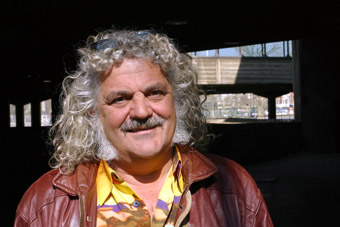
Pierrot Bidon
photo Philippe Cibille
Pierrot Bidon
FITTINGLY, THE LAST ACTION OF PIERROT BIDON WAS TO GIVE THE PEACE/LOVE SIGN WITH THE LEFT HAND, AND THE THIRD FINGER UP WITH THE RIGHT.
A larger-than-life showman and director, Bidon is rightly credited with revolutionising the stagnant artform of traditional circus into the post-industrial, often edgy and certainly evolving artform that we have today.
From travelling Cirque Bidon (1975) to the small villages of France and Italy with horses, gypsy caravans and an open-air show, to the formation of Archaos in 1986, he led the way. As a tightrope walker he was already deconstructing the form—playing with the contract between performer and audience that had previously been sacrosanct in circus. Miked up, he would provide a personal, almost contemptuous, commentary on audience expectations of a ‘death defying feat’ and how he could, so easily, feed their appetite for proximity to close calls and disaster.
Archaos, subtitled Cirque Revolutionnaire and Cirque de Caractere, was a complete assault on the senses. It was a radical evolution: the smell of greasepaint, sawdust and animals replaced by petrol, oxy-acetylene torches, burning rubber and pyrotechnics. No sequins, spangles or red noses, but crash helmets, corrugated iron and boiler suits. No horses, lions or elephants but motor bikes, juggled chainsaws and fork lift trapeze rigs with a rock ’n’ roll, Mad Max/punk, apocalyptic aesthetic that was loud, in your face and literally explosive.
“ We are the animals” he declared, a simple statement that set the city fathers aquiver. Publicity was always as entertaining as the show and intended to rattle cages. “It’s our mission to shock society. I’m here to shoot society in the head,” said Bidon. Cars fell in half as he arrived for the assembled press. There were motorbike stunts over stationary traffic in an unsuspecting city. Daring stuff, but mostly it was mischievous and cheeky, albeit with the underlying and ever-present threat of anarchy.
Post Archaos, Pierrot set about helping those less fortunate—the streetpeople who inspired him. In the shanty towns of Brazil, street performance workshops led to the creation of Circo Madrugada. In 1998, in Conakry, Guinea, he created Cirque Baoboab, a circus spectacular that toured extensively with jugglers, dancers, acrobats and a West African beat.
The Archaos tour to Adelaide and Melbourne in 1990 had an enormous and enduring influence that changed circus in Australia forever. “We are free,” he claimed and then showed us the possibilities. The blinkers were off. Archaos inspired a new generation of circus performers and created a climate, both here and overseas, where new circus could flourish. We reap the benefits with a popular, burgeoning form that can traverse genres while respectfully and proudly remaining ‘circus.’
For fearlessly leading the way with astounding skill, artistry and thrilling showmanship, we salute you, Pierrot. Peace, love and third finger up!
Janine Peacock
After the expansive experience of working with Archaos on the 1990 tour to Adelaide and Melbourne, Janine Peacock travelled the world with Australian and French companies. In 2009 she was awarded an Australia Council-Community Partnerships Creative Producer Initiative and is now operating as a facilitator for independent artists and projects under the banner Loose Canon Art Services.
RealTime issue #97 June-July 2010 pg. 14
© Janine Peacock; for permission to reproduce apply to realtime@realtimearts.net
WE ALL KNOW THAT CINEMA, LIKE MOST THINGS IN CHINA, IS EXPANDING RAPIDLY AND THAT THIS EXPANSION IS NOT AN EASY THING. FILM IS AN ARENA IN WHICH GOVERNMENT REGULATION, MARKET ECONOMICS AND CREATIVE EXPRESSION FREQUENTLY COME INTO VOLATILE CONTACT.
A broad division has recently emerged between the medieval epics beloved of commercial filmmaking (think Zhang Yimou’s films) and low budget, socially oppositional films (like Jia Zhangke films). While the latter form has been vitally important, lately it has seemed to congeal into a formula in which sleazy, chain-smoking slackers in dingy urban backwaters encapsulate filmmakers’ critique of the spiritual void of the market economy. This year’s Hong Kong Film Festival provided rich material for a contemplation of the ways in which Chinese cinema is struggling to refresh this critique.
sun spots
Sun Spots by Yang Heng is another of the long take, distant framing tableau films which follow in the footsteps of Hou Hsaio-hsien and Jia Zhangke (Jia’s cinematographer Yu Likwai is listed as associate producer). The intriguing thing about the film is its wilful incommunicativeness. It doesn’t tell a story so much as establish figures expressive of their surroundings. In the opening shot, a man lies on the road after a motorcycle accident in front of a bulldozer: a stricken figure in a stricken landscape. Another tableau indicates that the chain-smoking in these films simply reflects the surroundings where chimneys constantly spew out smoke.
Not only are scenes mostly wordless, but the characters are often framed with their backs to the camera. At key moments, such as the final shot, they simply disappear into the depths of the frame. These tactics are not new; in fact you associate them with Mizoguchi in the 1930s. In those films they were employed as distancing devices that functioned to push you back out of the melodrama, but here they are part of a larger indifference or refusal. Just as the characters drift along in a world lacking purpose, this film offers us nothing more than two hours of repeated action which points to no deep interior psychologies on the part of the characters. The point is that there’s no point—that’s all there is. In America this might turn into Easy Rider, but here it just wallows in its own sense of social torpor.
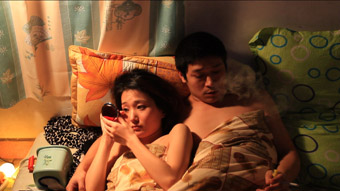
The High Life
the high life
Sun Spots and Zhao Dayong’s The High Life shared the main prizes at the HK festival. The High Life similarly starts out from the standard Jia Zhangke story. The familiar cast of characters is present: the small-time lowlife, the slutty girlfriend, the neighbourhood boss. However, the opening scene gives us an indication that things might not be so simple: a group of women in a prison work at sweatshop labour while one of them recites an increasingly bizarre and incendiary poem.
It’s another hour before we return to this location and these characters but the scene is emblematic of the film’s strategies. Characters enter and then leave the narrative, frustrating our attempt to approach contemporary China in exclusively personal terms. It is worth comparing this to the structure of Zhao’s previous documentary Ghost Town (see Dan Edwards’ account, RT94, p22) which is divided into three parts, each focusing on a different character.
There is also an insistence in the opening scene that despite the culturally debased conditions of everyday life in China, art is the repressed which somehow finds a way to return. The small-time swindler retreats to his rooftop each evening to practice opera performance styles and the superintendent of a prison insists that prisoners recite his subversive poetry.
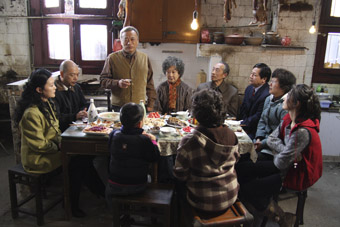
Apart Together
apart together
The most impressive fiction film from China (see the articles on page 16 and RT96, p15 on the documentaries which are rapidly emerging as a key component of Chinese cinema) was Wang Quanan’s Apart Together which derives from the unfashionable humanist middle-ground of Chinese cinema. It is not a star-driven genre film, and neither is it the kind of grungy miserabilist film beloved of international festivals.
Set against the backdrop of the tentative reconciliation of Taiwan and the People’s Republic of China, this is the story of a Kuomintang soldier who returns to Shanghai, to the sweetheart he abandoned 60 years ago, now living with her new husband and family. Thankfully what follows can’t be reduced to allegory. Instead we see how personal stories carry the weight of a wider politics. It is a funny, deeply observant and beautifully acted study of how history has made strangers of people who need to rediscover their cultural commonalities.
Chinese people talk to each other through and over food, and so the film concentrates mainly on a number of set pieces around dinner tables. Alcohol, popular song and sentimentality are the pillars on which the drama is elaborated in simply observed, long takes which allow for some ferociously good ensemble performances. History is a large and complicated business. Life is uncertain but so long as there is food on the table and people around it, that is all you can ask for, and that is enough.
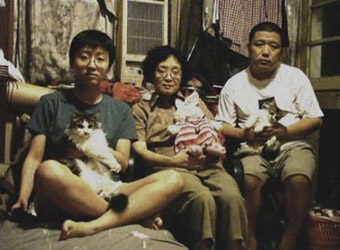
Liu Jiayin, Oxhide 2
oxhide 2
Food is never far from the foreground of Chinese films and Liu Jiayin’s Oxhide 2 (Sandy Cameron wrote an appreciation of the first in 2005; RT67, p22) centres on the making and consumption of a meal of dumplings. This is a reworking of the earlier film to see if its restrictions can be pushed even further. Oxhide contained 23 shots but this time Liu Jiayin gets it down to nine with each shot averaging 15 minutes. These are all taken in a single room of a cramped apartment with a static, locked-off camera—Liu appears in front of the camera while shooting it. The use of a widescreen aspect ratio extends the restrictiveness of the formal strategies by excluding characters’ heads for long chunks of time.
In some ways this is the ultimate work of everyday realism—until you realise that the action is carefully composed and staged. As with her previous film, Liu’s performers are her parents and herself, and the film shows them talking, squabbling and cooking together in real time and in their own home. As with any good work of minimalism, you pare down the elements so that small things assume larger impact. When the mother appears in the deep background of the first shot, it is quite thrilling to see that a door is suddenly revealed. When the father’s head lurches unexpectedly into the foreground of the frame, I recoiled more strongly than at any point in Mr Cameron’s turgid 3D nonsense.
one night in the supermarket
Finally, what’s the news from China’s commercial cinema? Yang Qing’s One Night in the Supermarket is an attempt to find, and cash in on, viable contemporary genres. Screwball comedy has worked well for South Korea—this reworks Attack the Gas Station—and it’s a big improvement over the medieval hack and slash epics which have carved an increasingly leaden path through Chinese cinema.
The model for imitation here is Ning Hao’s Crazy Racer from last year. We have bumbling crooks, larger than life characterisations in which eyeballs are constantly bugging out of heads, flashy transitions and intrusive camera and editing effects. One of the lead actors is even imported from Crazy Racer to get the narrative moving. A couple of disgruntled guys hold up an all-night convenience store and, predictably, things go wrong and draw in an increasing number of eccentric locals. This is painless enough but it’s nowhere near as funny as it ought to be. The performers’ heavy handed mugging will give you even greater appreciation for Ning Hao’s style of comedy.
Why care about it? As our media pound us with the one-dimensional picture of China as a grey, totalitarian place, it seems more important to get an insight into what makes the Chinese laugh. Creating comedy appears to be a more urgent task than adding yet another critique of an aimless and souless modern China.
RealTime issue #97 June-July 2010 pg. 15
© Mike Walsh; for permission to reproduce apply to realtime@realtimearts.net
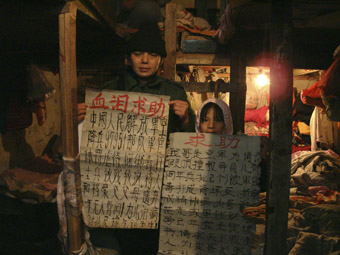
Petition
“BRING DOWN CORRUPTION, GIVE ME MY HUMAN RIGHTS!” THAT’S THE PLAINTIVE CRY HEARD NEAR THE BEGINNING OF ZHAO LIANG’S FILM, PETITION, A DISTURBING LOOK AT THE BRUTALITY, VIOLENCE AND INTIMIDATION SURROUNDING THOSE SEEKING JUSTICE IN CONTEMPORARY CHINA. GUO XIAOLU’S ONCE UPON A TIME PROLETARIAN SIMILARLY CONTINUES THE CHINESE INDEPENDENT DOCUMENTARY TRADITION OF PROBING WHAT LIES BEHIND THE GLITTERING FACADES OF CHINA’S ECONOMIC SUCCESS. BOTH FILMS APPEARED AT THE RECENT HONG KONG INTERNATIONAL FILM FESTIVAL, THE ONLY PLACE IN THE PEOPLE’S REPUBLIC WHERE SUCH CRITICAL WORKS CAN PLAY AT SUCH HIGH PROFILE EVENTS.
petition
Zhao Liang’s confronting feature-length documentary is the result of more than a decade of living and filming in a shanty town next to Beijing South Railway Station. The slum—now demolished—was once home to a floating population of thousands who came from all over the country to lodge complaints about authorities in their hometowns. Petitioning is a vestige of China’s feudal past, when any subject theoretically had the right to complain directly to the emperor if wronged by a low-level official. In a society where all levels of government, the courts and police are tightly controlled by the Communist Party, petitioning is the last hope for those seeking redress for an injustice.
Zhao’s film opens with his subjects recounting the litany of problems that brought them to the capital, from compulsory grain requisitions unpaid for by local officials to workers laid off from state enterprises without notice or compensation. Others have had their homes demolished without recompense, or suffered abuse in the armed forces.
The hopelessness of the petitioners’ situation quickly becomes apparent as Zhao follows them into offices ostensibly set up to receive their complaints. Filming secretly, Zhao captures the lethargic indifference of officials ensconced behind metal grilles and glass screens, who routinely deploy security guards to drag away old men and women and beat them when they resist. Outside, “retrievers”—hired thugs sent by local authorities to bring back those attempting to lodge complaints—lurk around the offices, assaulting petitioners and sometimes threatening to kill them if they do not leave Beijing. One petitioner who has been encamped in Beijing for 18 years is chased onto a railway line to be torn apart under a passing express train.
The extreme psychological stress inflicted by this system is traced through the story of Qi, a middle-aged woman pleading for an investigation into the death of her husband, who died mysteriously while undergoing a compulsory medical at work. When we meet Qi, her daughter is a young teenager, loyally following her mother to government offices day after day, rummaging through rubbish for food as they eke out a living in the petitioners’ slum. As she sees her youth and chance for education slip away, the daughter becomes increasingly disillusioned with her mother’s quest, and after years of waiting she flees with a young man to start a new life. She explains her motivations to camera, before entrusting Zhao Liang with a farewell note to her mother.
When Zhao hands the note to Qi, she breaks down and flees the filmmaker’s lens, accusing him of abetting her daughter’s “escape.” Zhao follows and begs her to stop, but after a prolonged chase that is at once absurd and heartrending, Zhao comes to a halt and we see the distraught mother disappear into the distance.
The sequence represents a narrative and ethical crossroads, the point where Zhao’s film becomes less a documentary ‘about’ these people and more an obsession that begins to disturbingly resemble that of the petitioners themselves. It’s as if Zhao, having witnessed and filmed these people’s suffering for over a decade, feels he must stick with them even when they reject his presence, keeping his camera rolling to ward off the awful truth that their situation will likely never be resolved. How do you finish a real-life story about injustice without end, in a system that offers endless new traumas in place of closure and resolution?
As it happens, outside forces bring some sense of cinematic closure. Shortly before the 2008 Olympics, Beijing South Railway Station and the adjoining slum are demolished to make way for an ultra-modern bullet train terminus. We see petitioners scrambling amongst the rubble as they desperately try to retrieve their meagre possessions before they are forcibly relocated to the city’s outskirts. The traumatised Qi disappears and Zhao learns she has been imprisoned in a psychiatric ward until the Games are over. The petitioner’s village is gone, but their story continues, an endless cycle of misery carefully concealed from visitors to the capital.
once upon a time proletarian: 12 tales of a country
Guo Xiaolu’s Once Upon a Time Proletarian: 12 Tales of a Country looks at life outside China’s prosperous key cities. It comprises short interviews with 12 subjects of varying backgrounds, starting with an outspoken farmer whose first words to camera are, “This country is shit!”
Continuing his straight-talking critique of contemporary China, the farmer exclaims, “It’s just raping, corruption, bribing and stealing…the Communists now are completely corrupt…people only care about how to make money. As long as it suits them—fuck the rest!”
While the film’s other subjects are more restrained, endemic corruption remains a common theme. A small-time restaurateur in the hometown of Lei Feng, a PLA soldier Mao once extolled as a virtuous model for the nation, explains how economic “reforms” have corroded the social fabric of the town: “Without bribing you can’t do anything. Money here can make a dead man alive.”
Guo Xiaolu’s interviewees reveal the profound disconnect many feel from their own lives in a society that is at once authoritarian and poor, yet rabidly materialistic. The restaurateur in Lei Feng’s hometown says, “We have no feelings, we just do business…I don’t care for anything else. I’ve more or less lost my life.” A fishmonger comments, “My life is blind,” though she adds that things were much worse back in her village. Young hotel workers explain how their days are an endless cycle of long hours worked for minimal wages. “Nothing is meaningful,” one of them says. “It’s difficult to even think.”
We also meet some who have gained from economic reforms, though corruption continues to lurk behind every comment. A wealthy hotelier explains that “the peasants were moved elsewhere” to make way for her hotel, a casual reference to the ongoing land grab that has seen vast numbers across China thrown out of their homes for little or no compensation in the name of ‘development.’
The film’s final sequence sees a group of young children in an art class speaking to camera. One boy confidently states he wants to be a famous artist, though he amusingly adds that Van Gogh and de Vinci were pitiable because, “They were poor and couldn’t find girlfriends.” His ideal life is “beautiful, free, without any restrictions.” A young girl speaks with quiet intelligence about her love of Van Gogh. Their optimism and confidence provide a sharp contrast with the adult interviewees, though whether this represents youthful naivety or a hope for the future is left open.
Once Upon a Time Proletarian sets hope against apathy, progress against problems, development against ongoing poverty. Most of all, Guo’s film, along with the more intense despair of Petition, evokes the existential void at the heart of a society in which the state fails to provide even a modicum of impartial justice, and treats any dream save material gain with suspicion.
Petition (Shang Fang), director Zhao Liang, producer Sylvie Blum, People’s Republic of China, 2009; Once Upon a Time Proletarian: 12 Tales of a Country (Ceng Jing de Wuchanzhe), director, producer Guo Xiaolu, producer Pamela Casey, People’s Republic of China, 2009
RealTime issue #97 June-July 2010 pg. 16
© Dan Edwards; for permission to reproduce apply to realtime@realtimearts.net
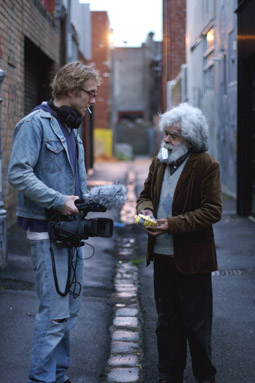
director Amiel Courtin-Wilson and Jack Charles, Bastardy
photo Adam Arkapaw
director Amiel Courtin-Wilson and Jack Charles, Bastardy
WHEN TOM ZUBRYCKI TOOK TO THE STAGE AT THE AUSTRALIAN INTERNATIONAL DOCUMENTARY CONFERENCE EARLIER THIS YEAR, TO ACCEPT THE STANLEY HAWES AWARD FOR HIS CONTRIBUTION TO THE AUSTRALIAN DOCUMENTARY SECTOR, HE DID SO WITH HIS CROSSHAIRS TRAINED ON TWO OF THE SECTOR’S BIGGEST GAME.
“At the ABC and SBS,” Zubrycki warned in his acceptance speech, “documentary slots are becoming more prescribed and rigid. Programs are tending to be format-driven and lighter in content. The range of subjects, viewpoints and ideas hitting our screens is narrowing.”
An independent filmmaker for over 25 years, Zubrycki accused the public broadcasters of exerting too much influence on the style and substance of the documentaries being made in Australia, as well as making programming decisions that ultimately stymied emerging filmmakers at the expense of those already established. “Don’t get me wrong,” he said. “We are pleased public broadcasters are commissioning our ideas. But is this concentration of decision-making good for the industry? For diversity?”
For many—filmmakers, critics and bureaucrats alike—the answer is an emphatic no. Zubrycki’s comments come at a time when, for all the critical acclaim and popular success enjoyed by certain high-profile documentaries and their makers, the vast majority of non-fiction films made in this country reek of a paint-by-numbers sameness. This tends to be the case regardless of whether a film is intended for theatrical release or broadcast: with important exceptions—Anna Broinowski’s Forbidden Lie$, Gillian Armstrong’s Unfolding Florence, and so on—most films choose not to experiment with visual language or create cinematic forms unique and relevant to their content, limiting themselves instead to a handful of only the most anaemic televisual tropes. All but a few devote the balance of their attention to individual psychology at the expense of social and cultural phenomena, or else tend towards the inoffensive genres of history and the natural sciences.
“There is a certain rigidity creeping in at the level of both form and content,” Zubrycki says. “Character and narrative-based documentaries are getting rarer and rarer. Of course, this is ironic because those are exactly the sorts of films that distributors around the world are crying out for.”
Much of the problem, he says, can be traced to the disappearance of half-hour and feature-length documentary slots from the public broadcasters’ line-ups, with high-concept documentary series taking precedence where once stand-alone films, by both emerging and established filmmakers, were the norm.
“The 30-minute documentary slot on SBS, Inside Australia, which was canned two years ago, was very important,” Zubrycki says. “Admittedly, the quality varied, but the series also produced some very good programs, which secured the broadcasters good ratings and gave emerging filmmakers an opportunity to give vent to their creativity on a project that was often original and unique.
“It’s too much to ask a filmmaker to have a four-part series of half-hour episodes as their first substantial documentary project. The risk of failure is too high. I wouldn’t be surprised if SBS follows the ABC in future by reducing its risk-taking and commissioning almost solely from established filmmakers.”
“What happens to emerging filmmakers then?” he asks. “It’s back to do-it-yourself filmmaking, which is fine if you’re making your first film, but hard if you want to begin establishing a career.”
Not that the public broadcasters, with their increasingly intransigent frameworks, are necessarily the best place for an established filmmaker, either. “I think what Amiel Courtin-Wilson is doing in Melbourne is really interesting,” Zubrycki says. “He tends to work with his protagonists for years, as he did with Jack Charles on Bastardy, and often has several films on the go at any one time. Then there’s John Hughes, who’s evolved his own masterly and unique style of essay film and whose new doco, Indonesia Calling, is playing at the Sydney Film Festival…But we have very few documentary auteurs in this country, which is mainly due to the dominance of the television-biased funding model.”
Zubrycki admits that alternatives do exist for filmmakers whose work does not tick the usual boxes. He believes that Screen Australia’s Special Documentary Fund, which has no market attachment requirements and has been set up to benefit those who wish to work independently of the broadcasters, needs to be expanded, noting with irony the fact that a number of films made possible through the scheme have since been sold back to channels that originally turned them down. He is also interested in the role that philanthropy could come to play in the sector over the course of the next 10 years. “In countries like the United States and Britain there are philanthropic institutions that actively support documentaries,” he says. “While that has been slow to take off in Australia, the Documentary Australia Foundation has been doing some great work in the area. It’s also very encouraging that some of the country’s film festivals are supporting documentaries.”
A recent alternative has emerged: the South Australian Film Corporation’s new Documentary Innovation Fund, which seeks to fund those projects that fall outside the funding and programming requirements of the public broadcasters.
“The ABC and SBS have for a long time been the agenda setters for documentary,” SAFC CEO Richard Harris says, “mainly because the commercial networks have always assumed there is no mass audience for docos.” (A curiously ironic view, he notes, given the commercial networks’ “ravenous” appetite for reality-based hospital, police and surf-lifesaving programs.)
“It is a fact that the ABC and SBS have recently moved away from their interest in one-offs and are more interested in series. I also think it is safe to say that they have generally become more risk-averse and more audience-driven in their approach. The public broadcasters have become more devoted to developing schedules and timeslots, where people know what to expect at a certain time, which is interesting in and of itself given that this is in fact a time in which audiences are starting to uncouple themselves from the idea of ‘appointment viewing’.”
“As a result,” he says, “I do feel that the balance has tipped and that there appears to be little room for programs that do not fit what have become more rigid schedule dictates. I think that this is unfortunate.”
The Documentary Innovation Fund, which closed its first round of applications in May, was born of what Harris describes as the funding body’s commitment to diversity. “There needed to be somewhere where the broadcasters were not the key gatekeepers,” he says. “While the broadcasters are major players—and thank god they are—they shouldn’t be the only ones. And this is particularly the case in South Australia where, with a few exceptions, we have a somewhat nascent documentary sector that doesn’t yet have the runs on the board.”
As for the question of where certain documentaries belong—on the big screen or the small one—Harris is convinced it will become less and less relevant as convergence and crossover become more and more prevalent.
“The line between cinema and television is such a vexed issue,” he says. “I do think it’s interesting that Bastardy, which was made with almost no budget, ultimately screened both theatrically and on the ABC. Perhaps that serves as an example of the new convergent world we are living in. If the boundaries are expanding, it’s because there’s no longer the same distinction between what should be seen on the theatrical screen and what should be seen on television or even on the net. I can’t help but feel that’s a good thing.”
Harris’s reference to the internet here does not quite convey the level of importance he ascribes to digital technologies and their potential uses. Indeed, both he and Zubrycki believe the future of innovative documentary filmmaking is ultimately to be written in binary, with the low-budget, self-distribution paradigm that digital video and the internet have made possible set to play an ever more crucial role.
“Digital distribution, both online and on theatrical screens, is going to offer exciting opportunities to those who are positioned to take advantage of them,” Harris says. “This will be the space for those filmmakers who have a true authorial voice. I think that form and subject matter will actually become more interesting in this space and that the influence of the broadcasters on these documentaries will become less and less.”
Zubrycki agrees. “The production system has changed almost beyond recognition in the last 10 years,” he says, “and that in turn has expanded documentary language.” And we can expect to see a similar evolution over the course of the next 10. “Faster download speeds are going to open up new horizons for distribution and should provide a new and useful income stream for producers,” he says.
For the most part, though, Zubrycki can’t see his big-game targets going down any time soon. “I think the current state of affairs will continue for a while for the simple reason that the industry wouldn’t survive were it not for television,” he says. “Television—both terrestrial and increasingly pay—will remain the main source of funding for documentaries.”
But Harris, who readily describes himself as an optimist, is not so sure. The big-game may be lumbering along as ever, he suggests, but with new and exotic mammals on the horizon, perhaps some much-needed change is already underway. “It’s a bit of mixed bag really,” he says. “With the conventional players vacating the space, I actually think the future options for documentary filmmakers are going to be quite exciting.”
For Tom Zubrycki’s Stanley Hawes Award address, go to www.tomzubrycki.com/read/2481982295.html. Applications for the current round of the South Australian Documentary Innovation Fund closed on May 17, but you can read about it on the Programs page at www.safilm.com.au.
RealTime issue #97 June-July 2010 pg. 17
© Matthew Clayfield; for permission to reproduce apply to realtime@realtimearts.net
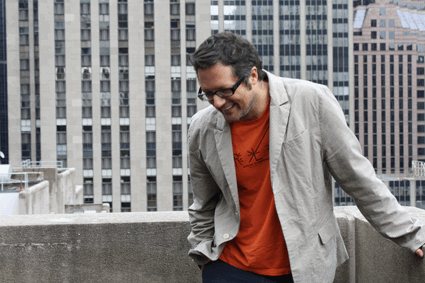
portrait Rafael Lozano-Hemmer, photo Ana Cristina Enrique; installation shot People on People, Rafael Lozano Hemmer 2010, Recorders Manchester Galllery UK, photo Peter Mallet
RAFAEL LOZANO-HEMMER IS BACK IN AUSTRALIA FOR THE WORLD PREMIERE OF A MAJOR NEW WORK, SOLAR EQUATION, WHICH WILL RUN JUNE 4-JULY 4 AT FEDERATION SQUARE IN MELBOURNE AS PART OF THE ANNUAL THE LIGHT IN WINTER FESTIVAL. DURING ITS INSTALLATION, HE SPOKE WITH SCOTT MCQUIRE, WHO INTRODUCED READERS TO THE WORK OF THE ARTIST IN REALTIME 89.
Can you begin by describing the new work?
Sure. Solar Equation is a 100,000,000: 1 scale maquette of the sun. We have floated a tethered aerostat—a static balloon—filled with helium and cold air over the Federation Square plaza. And what we’re doing is projecting, from five projectors, live mathematical simulations of the behaviour of the surface of the sun.
Since 1995, a new space observatory called SOHO has been sending imagery of the different types of solar flares and turbulence and dark spots—the actual weather patterns that can be seen at the sun. (The Solar and Heliospheric Observatory is an international collaboration between ESA and NASA; http://sohowww.nascom.nasa.go.) Another new observatory called SDO (Solar Dynamics Observatory, http://sdo.gsfc.nasa.gov) is now receiving imagery of the solar surface which almost matches the resolution of the earth’s surface that you can get with Google Earth. I think that the availability of all that imagery asks us to think about the sun in a different way. It used to be depicted in a very iconic way, and a symbolic way, and a mythical way. Today we’re beginning to see it more as a representation of non-linear processes. Solar Equation is a way to faithfully represent those phenomena in a scale that is more urban. Most importantly, it’s not a video that loops around, it’s actually imagery taken by SOHO and SDO overlaid with equations, which simulate those behaviours on the surface. It is mathematics playing back complex systems that will never be repeated.
Where did the idea for aerostat come from? And what are some of the practical issues about projecting the images onto that moving surface?
One of the issues with Federation Square is that it’s already a very complex space. It’s very much spoken for, every single surface is already expressing. It’s very baroque. So you either need to be strategic and do something very elegant and well placed, or something that’s going to speak to the scale of the square. And the only place I thought I could do that was the sky, because every other surface was already really predetermined. So early on I decided that it should be a piece for the sky. And I have never worked with inflatables, so I thought that would be an interesting direction to go in.
You like a challenge!
Yeah! When I first went around and I asked different companies to build this for us, literally all of them said that it’s impossible to do, because Melbourne has 90 kilometre per hour winds in a worst case scenario. So no company would agree to engineer something like that until we found Airstar (www.airstar-light.com). And they were up for the challenge. So we custom-manufactured the balloon, which is 14 metres in diameter, four metres bigger than any similar balloon made previously. Most balloons are elliptical or pear shaped. This one is very spherical, and that’s actually quite a difficult thing to do in terms of engineering. But in terms of the effect, we want people to just not think about the engineering. They should just come in and see a sun floating about 18 metres off the ground, and it’s working!
In terms of the graphics, one of the main reasons why people don’t project onto balloons very successfully is because they bob and sway. In our system, we have a capability to track the balloon in three dimensions, so that as it bobs and sways, our graphics actually compensate for that.

Solar Equation by Rafael Lozano-Hemmer for The Light in Winter, Federation Square
courtesy Federation Square
Solar Equation by Rafael Lozano-Hemmer for The Light in Winter, Federation Square
So the dynamic adjustment is part of the process of rendering on the fly?
That’s right. It’s just trying to have a perfect overlap between virtual and real. And that really matters to me, because what I’m trying to do with my work is to emphasise how virtual the material is and how material the virtual is. Having that exact registration is what allows people to have that moment of suspension of disbelief.
How do you get a seamless overlay of five projectors on a spherical surface?
The computing is being done by six media servers, which are interconnected but independent. So each of the media servers is actually rendering the segment of the balloon connected to a projector. The blending is happening through normal techniques, like alpha-blending and so on. So rather than a situation where you’re doing computer graphics or video, and you need to shift an enormous amount of data, to move from one projector to the next, here what we’re doing is we’re sending numbers from one computer to the next. So that as a particular singularity in the equation moves, it’s not the actual graphics that are being transmitted but the meta-qualities that prescribe that movement. This is how we managed to succeed with it. This is not a graphical environment, it’s a mathematical environment.
So you’re not so much making an image numerical, you’re visualising changes in number sequences?
That’s exactly right. The total piece that you’re seeing is the sum of individual sets of equations. For instance, some of the equations that we’re using are reaction diffusions, so you have these initial conditions which then generate a larger environment. And the initial conditions for each of the media servers are actually independent. So you don’t have to think of it in terms of the entire thing. You have to think of it in terms of the local effects of each of the equations. We have three layers of equations making the simulation and, in a way, the complexity helps make this possible.
What inspired the work?
As an artist who works a lot with light, I’m fascinated by the fact that pretty much every single culture has a sophisticated relationship with the sun. I think that, as an artist, it’s a way to represent the majesty of the source of all the forces that create life. Also, there’s a darker side to it. As Goethe said, the brighter the light, the darker the shadow. There’s a sense of real uncanny terror that I hope this piece will evoke. It’s not going to simply be a very pretty picture, there’s something really demonic and brutal, there’s a sheer force and violence associated with these explosions that I hope comes through the piece. I’m not sure if I’ll succeed with that, we’ll see in a few days.
But I like it that this light comes out of enormous destruction, and that destruction is also creation because of the creation of matter. So many of the very important narratives of art in general can be played off the sun. Personally, what I’m most attracted to about the sun is understanding the maths. The maths for me is a really interesting thing, because most of the ways in which these maths get played back are disembodied. To be able to present them in an urban embodiment really matters to me.
You once said “Today we can and should make dynamic mathematics our media.” Is that what’s going on here?
Absolutely. I agreed to this, I didn’t coin it. One could say that there was a fundamental shift in visual art with the introduction of perspective, with the kind of mathematical overlay into the pictorial plane introduced by Brunelleschi and others, changing the way visual art was experienced, altering its role in society, and so on. Today we’re seeing something similar. I think that non-linear dynamics, chaos, fractals, emergence, A-life—all of these different approaches, which are finally mature enough that you’re being able to generate these environments—I think that they genuinely contribute to a new understanding of art. And there’s a certain sense of it contributing to the aesthetics of post-humanism. It’s humbling, as an author, to let your work go out of control. In fact, if you can control it, you’re kind of failing! It’s not random, and it’s not pre-programmed, it’s something that is a collaboration with the maths. So the system has things to say, and we are just now beginning to be able to listen, and to present what those maths are producing in an attractive way.
What’s it going to be like for an audience?
It’s going to be disappointing to those who are expecting a cathartic spectacle. Often with a big urban piece, one thinks of a fireworks display, of a son et lumiere show, and with these there are very well established, associated narratives of catharsis. I think that the people who will enjoy it more are the ones who, all of a sudden on a Tuesday night, you know, find themselves in Fed Square after seeing a movie or something. They’re just walking by and they sit back and watch the math unfold. I’ve often said, and this piece is really a good example, that these works are closer to water fountains than to shows. There’s no beginning, there’s no end; it’s just a constant stream of imagery.
There is an interactive element to the project, though I’m not underlining it too much. We’re developing a piece of software which allows people using an iPod or an iPhone or an iPad to actually preview the equations and change some of the variables. For instance, there’s one moment where you can actually use the multi-touch surface of the device to pass your fingers over it, and you literally see all of the turbulence of the surface of the sun react to that touch. So it’s a little moment of intimacy, where you get the sense of agency in relationship to it. But I’m not promoting it too much because, unlike other interactive pieces of mine where it’s all about people self-representing, this is more just like an extension of the project.
In the future, I think this project’s going to continue, we’re going to take it to other cities, and as we get more time we’re going to add some more equations like Navier-Stokes and fractal flames. So it’s going to be like a platform for math, and I’m hoping that mathematicians will come to us and say ‘hey, have you tried this kind of approach?’, because we’re all interested in growing the platform.
This is the kind of work that could equally sit in an art institution but also a science museum.
Yeah, and that’s really good. If people call it art, that’s great. If they see it as sort of a didactic piece, that’s great too. I’m really happy to learn how people will see it; I have no idea actually. There’s already a lot of Twitter images, with people imagining what it’s going to be. I’m excited about what they’ll end up saying.
For more information about The Light in Winter and the work of Rafael Lozano-Hemmer visit: www.fedsquare.com/thelightinwinter and www.lozano-hemmer.com
The Light in Winter, Federation Square, Melbourne, June 4-July 4
RealTime issue #97 June-July 2010 pg. 23
© Scott McQuire; for permission to reproduce apply to realtime@realtimearts.net
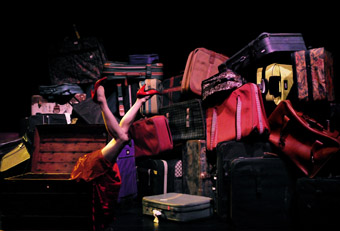
Rebecca Youdell, Cove, Bonemap
photo Suzon Fuks
Rebecca Youdell, Cove, Bonemap
BONEMAP’S COVE, AN IMMERSIVE ‘INTERACTIVE MEDIA ARTS EXPERIENCE,’ FELT LIKE A TEAR IN THE SPACE-TIME CONTINUUM, A PLACE APART, WHERE ERAS OVERLAPPED AND DISSOLVED, AND WHERE I COULD ACCESS MEMORIES NOT ALL MY OWN, BUT ACHINGLY FAMILIAR NONETHELESS. THIS APPARENTLY SIMPLE, BEAUTIFUL AND EVOCATIVE WORK, JUST 10 MINUTES LONG, CREATED A LEISURELY AND TIMELESS SPACE WITH WHICH THE VIEWER COULD INTERACT WITHOUT THE DISTRACTION OF NOTICING THE TECHNOLOGY, STRATEGY AND SWEAT SUPPORTING THE ‘EFFORTLESS’ EXPERIENCE.
My anticipation was heightened immediately at the booking phase when I (and every other viewer) was given an individual timeslot and the luxury of being an audience of one. This was principally due to the limitations of the technology involved (including an infrared tracking system), but Bonemap exploited the strategy fully, erasing the general expectation that numbers are everything in terms of audience. Without feeding off others’ reactions, the single viewer was compelled to rely on their own sensory and psychological responses, allowed to ‘own’ the space and to interact with the set and the solo performer, without interference.
After being primed by an usher while waiting in the foyer—”…movement is rewarded!”—I was led along a corridor to a doorway with a black drape, which built suspense while giving away nothing of what was beyond. The curtain was drawn back to allow me through, and my first brief sensation as I made out the wide circular enclosure of black scrim in the semi-darkness, was of being nine years old, agape in the Melbourne planetarium. I had to look back momentarily to check with the usher whether I should continue further forward. He gestured to keep going, then retreated, closing me in. I tentatively stepped down into the simmering fog of ankle deep dry ice to find that, yes, there was a floor underneath, I was not going to fall through to China. Piles of trunks and suitcases formed the perimeter of the ‘cove’, low in front, rising in hills behind to frame the single entrance/exit.
A moth or butterfly appeared high on the scrim and, following its flight, the ambient soundscape began to intone differently as I moved around the space. The moth was replaced by particles that could have been moondust or fog, and the power of the viewer to affect the projections quickly became apparent. I began to raise and wave my arms and walk back and forth, creating a black ‘hole’ in the fog which followed my movements. Then, mid-wave, the projection faded, an extended world beyond the scrim dawned. A woman in a red satin dress pulling a large travelling trunk was waving back at me.
From the safe haven of my cove, I could see a strange geography, teetering islands of luggage emerging from a suggested sea. The soundscape creaked and bubbled, reverberating with a low throbbing reminiscent of the industry of a port heard from underwater. The slight woman (Rebecca Youdell) continued to slowly make her way along a presumed dock, periodically pausing to squint into the distance as if looking for a familiar face waiting to meet her. If I smiled and waved she responded. Eventually she stopped and gestured at the trunk. I mimed that I wanted her to open it, and she did. Bending forward as if to take something out, she instead slowly disappeared into it, red shoes waving in the air as the scene went to black.
Waves washed against the walls of my cove, leaving me with a thousand questions about the fragile-looking lady in red. Why she was alone? Had she fallen through the world to China? I resumed exploring my space, opening a random case to reveal what looked, in the dim light of the projections, like vintage glass laboratory equipment, which I rapidly attempted to replace as I found.
The world beyond reappeared suddenly, and the woman was back, on one of the hillocks of cases, looking for something. Like an animal, she scrabbled around, sniffing the air, alert and primal even in her civilised finery. She singled out a little red valise, listened to it, then opened it to speak lovingly to something or someone inside. Back to black, back to wondering idly about the narrative I’ve witnessed, while playing with the projections, now clouds.
Then it’s sunset in the world beyond the cove, and the lady in red has transformed into a sea bird flying from the setting sun, her pleated dress now wings, her shadow looming huge on the scrim. She wheels in flight to follow my movement around the cove, as overhead a projected flock joins her migration. The sun sets and I must leave.
Bonemap’s Russell Milledge and Rebecca Youdell are masters at milking the power of suggestion and gesture to create rich visuals and engaging narratives. As they note, “the research funding for this work was focused on technical innovation” (primarily the interactive tracking systems), but they prove once again that technology becomes art when infused with their breadth of imagination. Following themes developed in their earlier work, The Exquisite Resonance of Memory (2008), Cove takes the viewer on a sensory journey through the ambiguous territories of colonisation, displacement, migration and memory, never pinned to a specific time and open to the viewer/interactor to question, interpret and colour with their own experience.
Bonemap, Cove, media design Russell Milledge, performer Rebecca Youdell, sound Steven Campbell, programming Jason Holdsworth; in association with Kick Arts Contemporary Arts and James Cook University School of Creative Arts; JUTE Theatre, Centre of Contemporary Arts, Cairns, April 29-May 1
RealTime issue #97 June-July 2010 pg. 24
© Bernadette Ashley; for permission to reproduce apply to realtime@realtimearts.net
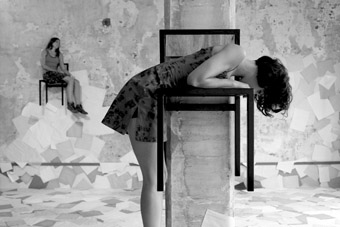
Cinetica
A LARGE CLOUD OF VOLCANIC ASH, SUSPENDED OVER BRITISH AIRSPACE AND SEVERELY DISRUPTING INTERNATIONAL TRAVEL, THREATENED TO CAST A PALL OVER MOVES’ FIVE-DAY PROGRAM, THIS YEAR RELOCATED FROM MANCHESTER TO A NEW AND WELL-RESOURCED HOME BASE AT LIVERPOOL’S BLUECOAT ARTS CENTRE. NOW IN ITS SIXTH YEAR, THE FESTIVAL IS ALSO NEGOTIATING THE POTENTIALLY TRICKY BUSINESS OF REGIME CHANGE, WITH INCOMING DIRECTOR GALA PUJOL AT THE HELM OF AN EXPANSIVE OPERATION, COMMITTED TO A REGION-WIDE, NON-TRADITIONAL SCREENING REMIT; A PAN-EUROPEAN NETWORK OF PARTNER FESTIVALS; AND TO SHOWCASING THE WIDEST POSSIBLE RANGE OF SCREEN-BASED MOVEMENT—WHICH MAY OR MAY NOT INCLUDE ELEMENTS TRADITIONALLY RECOGNISABLE AS ‘DANCE.’
While the ash cloud only succeeded in postponing program from Iceland, Hungary and Portugal to a rescheduled autumn event, a sense of generational handover pervaded every aspect of the festival. Work by a new crop of artists, filtering into mainstream programming, included the shifting subjectivity of Marina Tsartsara’s green-and-gold, meadow-set Through (2009) and the microscopic movement world of Fiona Geilinger’s charcoal-effect Pinstripe (2009). There were excursions into Second Life, the sporadic appearance of mobile phone pixillation—as distinctive as film grain—and the unvarnished immediacy of a YouTube aesthetic mixed with high-end finish from established, international ‘names’, such as Cordelia Beresford’s Sydney-set Night Shift (2009) and Marlene Millar and Philip Szporer’s spotlit, fragile Falling (2009). With additional links to the Watching Dance conference, held in parallel in Manchester, three home-set presentations on “Framing Motion” fielded Kate Sicchio’s notion of programmer as choreographer, composing pixels in frames within frames; Vida Midgelow on the politics of documentation, casting improvised movement as a process of disappearance; and Liverpool-based Gina Czarnecki’s outlining of her professional evolution from painting to film and then video, culminating in a slowed moment—captured in green-tinged night-vision—of close-in, facial transformation, from recent work Spintex (2009).
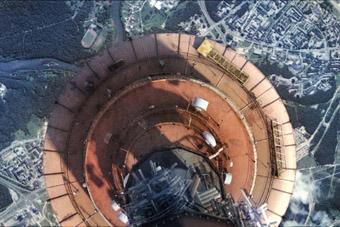
Synchronisation
The newly-introduced Alternative Routes awards resulted in a striking line-up, with first-prize winner Rimas Sakalauskas’ Synchronisation (2009) using the disquieting language of 1960s sci-fi in a slow-burn aggregation of sound and image, with a hollow metal sphere rising slowly, unnoticed, from a children’s play area, and a satellite’s revolving shadows hovering over patchworked landscape. Receiving special mention, a series of luminously monochrome images—an airborne arc of rock; an unearthed sunflower stalk; metal chairs suspended from writing-papered walls—in Ana Cembrero’s Cinética (2009), threaded through episodes of recognisably codified dance, with Thomas Browne’s Aston Gorilla (2009) capturing a young son’s dream image of his football-shirted, ape-masked father through a subtly edited movement language of simian swings and grabs. In addition, highly stylised diary-entry disruptions—the buzz of a house fly, the patterning of leaf shadow—in Marcin Wojciechowski’s Interferences (2009) sat against the graphic simplicity of Stuart Pound’s Dance 0-19 (2009) with its quick-fire progression of doubled, tripled, at times quadrupled numerals, white against a dark screen, illustrating the complex algorithmic workings of an intricate gamelan score.
Addressing issues at the heart of Moves’ identity, and reflecting widespread groundswell of artform shift, festival co-curator Gitta Wigro chaired a roundtable discussion of “Screendance on the Verge,” highlighting the dangers of artificial distinctions imposed around a self-titled niche. Pauline Brooks, of Liverpool John Moores University, outlined her role as facilitator for an emerging generation of screen-literate artists, while Claudia Kappenberg, head of the AHRC Network for Discourse and Publication in Screendance, emphasised the need for a body of informed writing within the field, also setting out her involvement as co-curator in the recent artist-led What If…Festival. Calling attention to the increase in hybridity across all forms, Jamie Watton, Director of South East Dance Agency, also noted the end of the producer-led era, acknowledging artists’ role at the centre of the creative process, with this shift reflected in a change of terminology from ‘screendance’ to the more open-ended ‘screen-based work.’
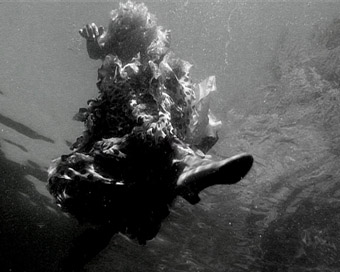
River Dreams
Illustrating this change of emphasis, a range of highly distinctive voices, scattered across scheduling, included Daniel Hopkins’ horizontal arrangement of subway train travel as blue/green stripes of periodic motion blur in Movement #1 (2009); the heightened materiality of Heidi Phillips’ archive footage in Discovering Composition in Art (2008); Richard O’Sullivan’s close-in, time-sliced landscape of rock and tree in Palimpsest (2008); Morgan Beringer’s partially glimpsed world of breakthrough between frames in Abstraction 27 (2009); and the soft fluidity of Betsy Dadd’s pastel lines in 8000 Drawings (2009), achieving a Norman McLaren-like state of never-settled flux. In addition, Sanke Faltien’s smoothly continuous camera motion through road-tunnel-set Queensway (2009) followed film-grained monochrome pathways of snaking white lines and overhead strip lights, and in Beatriz Sánchez’ highly accomplished River Dreams (2009) decontextualised fragments—a heeled, strap-fastened-shoe; the tiered flouncing of a polka-dotted flamenco dress; finger work against guitar fret board—took on the rippled fluidity of an underwater movement state.
In a particularly strong documentary-influenced programme, the deceptively simple surface gaze of Nick May and Ben Holland’s Food Chain (2009) surveyed Escher-like, multi-angled conveyer belts, the repetitive gestural unison of eye-deadened production line workers, and a single, flailing onion. Bronwen Buckeridge’s camera in Lacuna Cut (2009), closed in on the ritual application of mask-like face paint, abstracting to a red spot; a pink stick; encroaching expanses of blue, white and gold. Against the static foreground of a roughly textured field, archive wedding photos and architectural structures in Jonathan Franco’s Living Land (2008) momentarily flash up, and are gone, and in Carlos Amelia’s powerfully understated Tierra Y Pan (2008), slow, outward camera motion locates a dog tied to a post within a wind-whipped, desert-set horizon line, as focus gradually recedes from episodic and unsparing narrative detail, revealing in turn a heavily pregnant woman, a doctor’s bag, a spade.
Near the festival’s end, Daniel Bird’s contextualisation of Armenian filmmaker Sergei Paradjanov’s “dynamic, frenetic” symbolic language in The Colour of Pomegranates (1968) cast a long shadow across scheduling, identifiable in Anne Harild’s Morandi Room (2008), with front-on camera perspective catching the surface sheen of proliferating, differingly-shaped vessels, and the shifting gleams of light on rising water-level. Paradjavnov’s legacy was also evident in the snowset tableau of Galina Myznikova and Sergey Provorov’s Despair (2008) and in the poetic economy of a young female face in greyscale, close-in, slowed-motion, shaking blade-like wettened hair in Myznikova’s The Girl—Helicopter (2008).
Sited throughout the Bluecoat, installations included the linked remote screens of Charlotte Gould and Paul Sermon’s al fresco Urban Picnic, codes for mobile phone downloads created by Salford University students, and the rich visual arrangement of Sara Bjärland’s monochrome dandelion seeds in 80 Movements (2008), with a series of carefully composed slides appearing at rhythmically projected intervals. Across the four-frame line-up of Katrina McPherson and Simon Fildes’ Crux (2009), a quartet of male boulderers—captured in the detail of white-taped fingers, a beaded bracelet, a circular tattoo—attempt the unfakeable physical engagement of sheer exterior ascent, with slow eye scans and sudden drops, reaches for stone ledges and rock shelf and hand holds and finger crevices also recorded in the linear verticality of Laban-notated scores. Elsewhere, a single participant is guided through an immersive audiovisual experience by the intermittent touch of an unseen hand in Clara Garcia Fraile and Sam Pearson’s When We Meet Again, and left to re-enter real space alone with a smile and the gift of a single strawberry.
Viewed from within a landscape of hybridisation and boundary-crossings, Moves is looking like a festival whose time may just have come. Emerging into early evening light, the sky above Liverpool is a bright, clear blue, and not a cloud in sight.
Moves10, Bluecoat Arts Centre, Liverpool & venues throughout the north-west, UK, April 21-25
RealTime issue #97 June-July 2010 pg. 25
© Chirstinn Whyte; for permission to reproduce apply to realtime@realtimearts.net
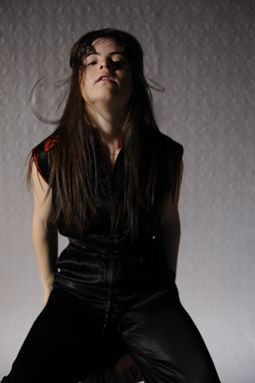
Jianna Georgiou, Sixteen by Sophie Hyde
photo Andy Rasheed
Jianna Georgiou, Sixteen by Sophie Hyde
THIS YEAR’S REELDANCE AUSTRALIA AND NEW ZEALAND AWARDS INCLUDED ALL THREE OF THE MAIN GENRES OF SCREENDANCE: DANCE-DRIVEN ‘DANCE ON CAMERA’ AS SEEN IN STRAND (MICHAELA PEGUM, SIOBHAN MURPHY AND DOMINIC REDFERN), VISUAL ART DRIVEN ‘VIDEO DANCE’ AS IN SHADOW IN BLUE (ZOE SCOGLIO) AND CINEMATIC DANCEFILM AS IN ALMOST ALL OF THE OTHER PRODUCTIONS SCREENED.
This impression of a strong cinematic sensibility comes from the award program being dominated by the work of a filmmaker (rather than a choreographer), Sophie Hyde, who directed three of the 10 works shown. Her works convey their meanings through mise en scene, montage and especially sound scores (by DJ TR!P, an indispensable collaborator). The three films form the Necessary Games ‘triptych’ performed by Restless Dance Theatre in South Australia, a company of mixed ability dancers.
The best of these, Sixteen (choreographed by Kat Worth), won the award for best dancefilm. It’s a sweet portrait of a young woman’s playful, physically expressed encounters with different men. The character’s disabilities are neither the text nor the subtext of the work, they are a given, which is not particularly remarked upon. Instead we are invited, through the frames within frames of a photographer’s studio where the piece is set, to see different qualities of relationship and a girl taking charge of her choices.
Slightly less successful in its creation of drama and relationship is Moth (choreographed by Paul Zikovich), which juxtaposes the moves of a young man with Down’s syndrome against those of a lean and muscular, able-bodied dancer. The pairing of these two, though adroitly shaped, felt a bit strained. That said, Moth had the most brilliant editing of the evening, with cuts creating movement dynamics and patterns of time that are as much ‘the dance’ as the movement of bodies.
The least engaging of the triptych, Necessity (choreographed by Tuula Roppola), was also, to me, the least successful in creating a cinematic experience of movement. It felt more like a recording of a dance than a cinematic construction, using close-ups for the small gestures and wider shots for the bigger gestures. This raises a problem not present in the other two: would I be interested in this if not for the unusual aspect of a disabled person dancing? I would be interested in Sixteen and Moth, but in this one, I wasn’t so sure.
The runner-up prize-winner was Tap Hop Lesson 1 (by Soda Jerk) a mash up of two pieces of archival footage—one a 1930s American movie in which a group of black men entertain the white folks gathered at a glamorous party, the other a 1980s television studio shoot of some guys doing hip hop. We’re invited to compare these alternating scenes, one on the left, the other on the right side of the screen, with little comment, except for their juxtaposition, until the soundtrack from one is laid under the images of the other so the Jazz and Tap of the 1930s becomes the ‘lesson 1’ for Hip Hop of the 80s. Aside from this slight if entertaining insight, this piece does not explore the implications of racial stereotyping and spectatorship to which it alludes.
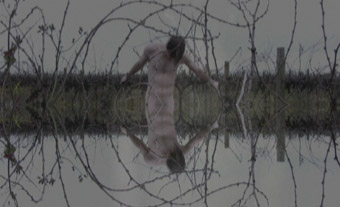
Saint Sebastian, James Welsby
Saint Sebastian (by James Welsby) winner of the “Encouragement Award” is an accumulation of images of lonely, vulnerable men making a strong reference to the eponymous tortured saint. The figures on screen are positioned as objects of beauty and pity, but the images constructed neither use the tools of visual art to create a sensual experience of beauty, nor the functions of cinema which would align us with the figures as characters and allow for the emotional engagement of pity.
The only ‘dance-driven’ piece on the evening was Strand, a sometimes glorious and more often maddeningly frustrating piece for two lovely dancers executing choreography in a sea of desert. There is one stunning camera angle in this piece, a long shot in which the dancing is contextualised in vastness—making it poignant, absurd and, in a way, fierce, in its battle against the odds of the space. But cutting closer in is unmotivated. It displays the dancing, but it frustrates the desire for the cinematic piece this could have been with more canny cuts and characters, or the visual artwork it might have been had it stayed with its one beautiful shot.
The only visual art driven ‘videodance’ on the night, Shadow in Blue, displays a lot of cool stuff that can be done with the effects palette on digital editing systems. But it also raises the question of duration. If the objective is to present a kaleidoscope of effects, shouldn’t it be up to the viewer to decide how long the toy will fascinate? Does the duration of this piece add to its meaning and justify its exhibition in a festival context or would it have more life on a gallery wall?
Motel Of Deception (Chrissie Parrott and Nancy Jones) wryly translates Neo Noir into a cleverly framed and surprisingly acrobatic set of physical relationships while keeping firmly rooted in the genre and the pleasures it affords. The textures of the seedy motel room, the deceptions framed in mirrors, the dance moves creating character and story all make for clever and engaging subversion of both the sincerity of dance (“the body never lies”) and the irony of Noir.
Tank Man Tango (Deborah Kelly) plays with documentary by suggesting that a fragment of news footage is actually a piece of choreography, and then documenting a project in which the instructions for executing that choreography travel the world and become a political ‘flash mob’ dance in commemoration of the victims of military force at Tiananmen Square. Playful yet pointed, this doco and the underlying dance achieve something rare: reminding us to care while adroitly avoiding a scolding.
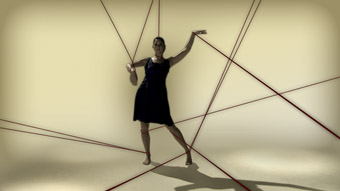
Reading the Body, Sue Healey
Finally, Reading the Body (Sue Healey) one of the most fully realised works of the evening, and certainly the most fluent integration of dance, art and cinema, offers a revelation which only cinema could give us, as well as finely balanced beauty and an articulate and sensitive dance. Healey overcomes the frequently experienced gap in comprehension between the dance and its audience by revealing, with animations, the inside of the body. These revelations are timed and phrased to punctuate, extend and interact with the dancer. The cinematically constructed relationship between the animations and the dancer align us with the character, make us feel what she feels, and give us access to the mysteries of dance.
Judges for the 2010 awards were Ross Gibson, Professor of Contemporary Arts, University of Sydney, Helen Simondson, Manager of Screen Events, Australian Centre for Moving Image, Shona McCullagh, Award Winning Dance on Screen Artist, Clare Stewart, Director of Sydney International Film Festival and Adrian Martin, Senior Lecturer in Film, Monash University.
–
Reeldance Australia & New Zealand Dance Awards, Reeldance Festival, Performance Space; CarriageWorks, Sydney, May 16
RealTime issue #97 June-July 2010 pg. 26
© Karen Pearlman; for permission to reproduce apply to realtime@realtimearts.net
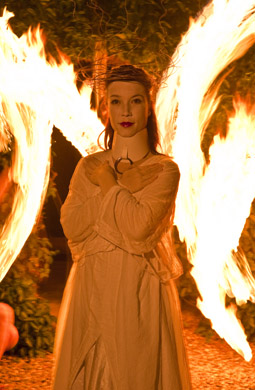
Andrea Jenkins, Dante’s Inferno, Zen Zen Zo
photo Simon Wood
Andrea Jenkins, Dante’s Inferno, Zen Zen Zo
ZEN ZEN ZO HAS BUILT A REPUTATION BASED ON SELF-DEVISED CREATIVE PROJECTS AS WELL AS RADICALLY UPDATED WESTERN CLASSICS. AN ECLECTIC, TRANSDICIPLINARY APPROACH INCORPORATES EASTERN DISCIPLINES SUCH AS THE SUZUKI METHOD AND BUTOH, WITH ELEMENTS OF POP CULTURE THROWN IN FOR GOOD MEASURE. BOTH STRANDS ARE APPARENT IN THE PRODUCTION OF DANTE’S INFERNO FOR THE IN THE RAW STUDIO SEASON AT BRISBANE’S OLD MUSEUM. THIS IS A SHOWCASE FOR GRADUATE STUDENTS FOLLOWING THEIR SIX-MONTH INTERNSHIP PROGRAM AND FEATURED GUEST CANADIAN DIRECTOR STEPHEN ATKINS WHO ALSO LAUDABLY UNDERTOOK THE TRAINING.
The Neo-Gothic edifice of Brisbane’s Old Museum was an eminently suitable site for a production styling itself as living hell. Despite the dire warnings of gypsy fortune tellers, the milling crowd outside the museum was soon gathered up by our Tour Guides, a pair of bubbly air hostesses with a perfect grasp of airborne vernacular who escorted us with torches over uneven ground to Hell’s Gates. Here we were confronted by a charivari chorus of the damned, Hell’s buskers, a foretaste of torments in store. We passed promenade-wise through an arching tunnel in a hedge into Hell itself. First stop, Limbo: four actors in perpetual circular motion, stepping up and down and around on blocks representing an endless gym for the soul. And so on through a series of installations in the grounds depicting interpretations of Dante’s sins including the third (the gluttonous), fourth (the avaricious/spendthrifts) and fifth (the melancholic) which were sometimes obvious, sometimes merely enigmatic and sometimes deadly as in the Night of the Living Dead.
At this point in the first circle of Hell where Dante depicts the eternal lovers, Francesca and Paolo, damned because they would not abandon their human, fleshly love for the love of God, the company seems to have flinched from exploring Dante’s sympathetic and complex examination of a situation reflecting his adoration for his ideal love, Beatrice. Instead we are treated to a quartet of reanimated souls enacting a post-Brechtian, cabaret-style ballad about their sordid and murderous lust for gold. Quibble aside, so far it has been an entertaining stroll through the grounds of Hell until the atmosphere changes after the deaths of our ebullient guides. We are abandoned, lost and barred by demons from continuing our journey through the realms of the Middle and Lower Hells, yet the only way out is down.
Our guiding light appears in the form of a shining angel, a striking figure of sculptural serenity, who is surely Beatrice as she appeared to Dante. Entering the building, the massive enclosure of the performance space dictates a different response. We no longer have the freedom of bystanders, fair-goers, or separate observers and feel threatened by the sheer proximity and physicality of the performers and the darker nature of their sins, which feel intimately personal. We witness a violent orgy of rape and pillage until herded by these truly damned souls into witnessing our own capacity for violence, masochistic self-harm and despair culminating in the sin of suicide startlingly portrayed by an instantaneous descent of two chairs on the end of ropes. Our attention is refocused by two girls sweetly singing a plaintive lament as a coda and then to self-deception within a loveless relationship until the alienated pair rise from the breakfast table to act out their onanistic fantasies. The final scene is a mechanistic office version of the treadmill of work encapsulated in Fritz Lang’s 1927 film Metropolis. We are invited to our first day on the job as we leave through a maze of candle-lit corridors to the Exit which is No Exit.
Last year Zen Zen Zo’s production of Shakespeare’s The Tempest turned powerfully on an interpretation based on contemporary post-colonial discourses and as a result won the Matilda Award for Best Independent Production in 2009. The rather fragmented nature of their current showing lacked such an underlying concept—a big ask, I know, when the original is such a monumental work and such a strong product of the Western medieval mindset. In part, the site-specific use of the Old Museum aptly stood in for the towering architecture of Dante’s Catholic faith which was the foundation of his epic poem but by shearing away Dante’s basic beliefs, rendering them simply as metaphors for life, this treatment risked destabilising the whole structure. Perhaps the trouble lay in the way the performance text was constructed. According to Atkins each and every cast member was given a snippet of the poem and told to go away and creatively interpret it. The results were assembled and the final shape of the piece collectively decided upon. However, I suspect it would take a true, mad heretic of the stature of Neitzche’s Zarathustra to perform such a cut and paste. Nevertheless, Zen Zen Zo’s characteristic energy and the unflagging focus of the ensemble playing was impressive in covering such huge territory on such rough ground. Dale Hubbard’s music was impressive and subtly modulated, and like Beatrice in many guises it led us through the production. The technical team also dealt adroitly with big outdoor stuff.
The classics, of course, can ask the questions that are often shouldered aside in the brutal tempo of modern life. But if so, the questions and not necessarily just the answers need to be recast in order to be relevant. I found the final ‘Metropolis’ scene (which I know some felt to be anticlimatic) the most replete from this aspect, with its icy promise of an unending corporate eternity which will lead us all, ironically soon enough, into the fiery furnace of the fundamentalist imagination so that the world ends, as TS Eliot predicted, not with a bang but a whimper.
Dante’s Inferno, devised by Zen Zen Zo Physical Theatre Company members and 2010 interns, dialogue Stephen Atkins, director Stephen Atkins, designer Alan John Jones, lighting designer Ben Hughes, composer Dale Hubbard, performers Zen Zen Zo Physical Theatre Ensemble, Brisbane Old Museum, May 6-22
RealTime issue #97 June-July 2010 pg. 7
© Douglas Leonard; for permission to reproduce apply to realtime@realtimearts.net
{$slideshow} CHARACTERISTICALLY, AIMEE SMITH CONCEIVES WORKS ON A SINGLE SOCIAL CONCERN. IN BREAKINGS IT’S THE RAMIFICATIONS OF BEING IMMERSED IN MEDIA-DEFINED HYPER-REALITIES. IN THE BEST OF HER WORKS, A RIGOROUS CLARITY OF PURPOSE EITHER PUMMELS THE IDEA UNTIL ITS TENETS COLLAPSE (WAITING FOR THE REVOLUTION, 2009) OR THE SURFACE IDEA FRACTURES INTO ITS INEVITABLE INTERPRETIVE MULTIPLICITIES (REFUND POLICY, 2007, AND ACCIDENTAL MONSTERS OF MEANING, 2009).
Smith’s first full-length work, Breakings, driven by schizophrenic responses of the character/performer, both affirms the array of options given by the media-dominated environment and closes down personal agency in a claustrophobic deadend of failure and loneliness. The unforgiving perspective enfolds the terminable condition of an isolated individual brought about by virulent bombardments of realities from somewhere beyond word and screen.
The cornered life begins in a tightly set bed-sit, plastered with newspaper across every conceivable surface and furbished at appropriate points with electronic screens. Pathological obsession lurks as paper and text, image and pronouncements operate in juxtaposition with Smith to enact curious metaphors and misplaced relationships. The morning alarm rings and the screen image is switched off before Smith rises to extract cat food from the screen fridge for the screen cat. Normality pervades the Baudrillardian simulacra-scape without missing a monotone 2D beat.
Beginning with the normal action of reading the morning’s paper Smith then travels the room’s dimensions devouring endless printed edicts with an increasing avidity that drags the body in its wake. It is as if spectators are taken on a pocket-compact history of human engagement with the media, suggesting a viral susceptibility to information born with the invention of print. Fuelled by a compulsion to know as much and as quickly as is possible, the quick-fix ingestion is serviced by the production’s innovative and deceptively simple technologies that extend word into sound and pictures. Screens, formerly stand-ins for reality, splutter into action and project images and statistics of atrocities in the same breath as seductive views of glamour and success. Media has, in a sense, acquired its proper stride or, more tellingly, its crazed flight. Death and mutilation interpenetrate sexual allure with a speed and ease which is played out by Smith’s corporeal appropriation of collisions of horror and hope. Smith’s body becomes the site of abuse, penetrated by an artillery of information with scant regard for human comprehension.
Entrapment folds to a false quietude, when Smith, the achingly human young woman, moves within an isolated rectangle of coloured light. The movement sheds its frenzy to become calm and beautifully fluid until spectators realise that this light is nothing more than a television test pattern. What seems like a respite from affliction sours into the affliction itself: the human individual is but a standby pattern before the main action begins. In such an impasse, a human soul is a mere figment of broken desire. The ending is thus forecast long before the screen lights emit evidence of cross-wiring malfunction. Unfed screen cats and deformed and abused children share a similar fate with their co-performer, Smith; they are shattered and extinguished though, unlike her, they are never immune, in their digital sanity, from relentless replication and projection.
Breakings does not end when the lights go out but extends through post-performance forums, designed not so much to elicit reflection on the production as to promote dialogue on issues raised between Smith, guests from academia, arts and the media, the affable facilitator James Berlyn and the audience. I suspect the exchanges will focus on Smith’s singular focus which omits all trace of the new media’s democratic activism and social networking and thus can cast Breakings as a throw-back to the days of media-mogul control. However, such questioning can explore artistic storytelling, utilising, ironically, the tactics of social networking to probe Smith’s approach, enabling its singularity to provoke a diversity of ideas.
Breakings may not have plumbed the full range of media intervention into our lives but it has pushed feeding the cat into a peculiarly revealing—and perhaps enunciated—can of digital worms.
One paradoxical worm raised by Breakings involves questions about the capacity of dance and dancers to portray mental and bodily disintegration. The physical fitness and beauty of dancers (if not the whole philosophical/psychological basis of the discipline) inhibits grotesque or undesired states like damage and decrepitude. Entanglement in beauty facilitates a sense of identity loss in the performer but, at the same time, impedes the more distressing schizophrenic disability which seems to be in Smith’s sights. The screen cat in spite of screen and reality confusions remains cute and Smith carries her breaking perhaps too eloquently to convey unhinged reality.
Breakings, choreographer, performer, audio visuals Aimee Smith, sound Ben Taaffe, lighting Mike Nanning, video mapping Jerrem Lynch, set design Bryan Woltjen, set & costumes Fiona Bruce, outside eye Michael Whaites, co-produced by Performing Lines WA and STRUT dance; PICA, Perth, April 8-11; www.aimee-smith.com/blog/
RealTime issue #97 June-July 2010 pg. 28
© Maggi Phillips; for permission to reproduce apply to realtime@realtimearts.net
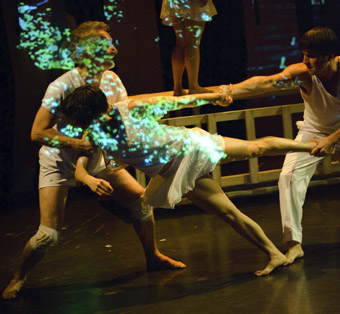
Pomona Road
photo Nick Lane
Pomona Road
MAYBE THEY’RE CALLED NUCLEAR FAMILIES NOT BECAUSE THEY CLUSTER AROUND A STABLE CENTRE BUT BECAUSE THEY COLLIDE AND SCATTER, DESCRIBE ORBITS. BECAUSE OF THEIR PUSH-PULL OF ATTRACTION AND REPULSION. BECAUSE AT THE HEART OF FAMILY IS NOT STABILITY BUT A NEVERENDING CLEAVING TOGETHER AND FLYING APART. ENERGY THAT DISASSEMBLES BUT IS NEVER DESTROYED. KATRINA LAZAROFF’S POMONA ROAD ASKS WHAT HAPPENS WHEN THESE FLUID CONFIGURATIONS COLLIDE WITH THE BLANK WALL OF TRAUMA.
Lazaroff has cast her dancers as an archetypal family: Mum, Dad, the two sisters and a brother, an ‘every family’ that allows an audience to examine the questions that come with each disaster—What would I do? How could we, would we survive?
Trauma here comes as the destruction of the family home by bushfire and its elision of history and identity. The family is cut loose, each member forced to reimagine themselves, and it’s this territory that Pomona Road charts. The dynamic energy of family and eruptive trauma combine as a double helix propelling Pomona Road in a play between dissolution and stability.
The pivotal event of the bushfire is one from Lazaroff’s own history: her family lost a home to fire in 1980 and lived through the 1983 Ash Wednesday bushfires. This intimacy and assuredness with the material pervades the work. The spoken recollections from family and friends of their bushfire experiences provide an overarching narrative structure which drives and frames the action as well as providing historical specificity.
Pomona Road’s strength lies in the quality and integration of its elements. Choreography that keeps the dancers in almost constant motion captures a sense of particles moving. The immersive and evocative projections of Nic Mollison, the fine set design by Kerry Reid and Richard Seidel, Sascha Budimski’s driving and atmospheric score and the dramaturgy of Catherine Fitzgerald all contribute to the work’s tight storytelling.
Time and place are called forth through projections—TV shows, the bush and later flames, sparks, drifting leaves and wallpaper patterns over monumental cut-out tree shapes arranged around the space. There are the sounds of local radio, the susurration of trees and narrators recollecting the beauty and danger of the hills.
Lazaroff deploys her dancers in dissolving and reforming constellations marking out relationships and alliances. Dad and Mum economically describe a duologue of power, the girls pull each other into and out of orbits, father and son raise fences, tumble and grasp. Flying off, regrouping, they graze past each other, tracing out all the lineaments of family.
Like classical tragedy, momentum runs towards and away from the inexorable fact of the fire. Jagged synthesiser motifs and sonorous drones prefigure the fire’s arrival— “It’s gonna get us this time.” Drowning in flames the family frantically cross and recross each other’s trajectories, a dense interwoven panic climaxing with the father screaming silently, consumed by flames, the family at his feet.
As Antigone discovers in Anouilh’s tragedy, it’s not the event that matters but the aftermath where the tragedy unfolds. Against luminous burnt trees and floating home-plans that mark out the characters’ bodies as rooms—‘bedroom,’ ‘bath,’ ‘living’—trauma recurs as sparks and flames overlay and leak into their new, fragile ‘normal.’
A daughter shakes out a joyless little shimmy as the family don cast-off clothes — “Thank the nice lady.” Fat electronica builds anxiety as dreams of a new home dissolve into fire with the family becoming a mesh of hard diagonals on the floor, arms and legs thrown up in the air, verbal ejaculations like involuntary physical tics: “I have to do everything,” “It’s not my turn,” “He started it.”
Balanced against incipient chaos is a neat invocation of the family car, the only fixed point in all this loose energy. Dad drives, Mum as passenger, kids in the back. Pre-fire they bicker to sweet guitar pop, lean into the curves together, working as a unit. In the cold aftermath, eyes shut, isolated, they lean forward, lean back, stop cold in shock.
Moving through this post-bushfire world, in the way we get hooked on songs that speak to certain moments in our lives, we hear Gerry Rafferty’s “Baker Street.” Its nostalgia doubly captured in time, the song becomes an obsessive refrain of loss and longing: “And when you wake up it’s a new morning, the sun is shining it’s a new morning. You’re going, you’re going home.”
Circling around their vanished property, looping through the event, the family endlessly draw themselves to their own centre—“You’re going home.”
Pomona Road, director, choreographer, producer Katrina Lazaroff, performers Carol Wellman, Peter Sheedy, Veronica Shum, Emma Stokes, Zac Jones, lighting, projection, design Nic Mollison, set design Kerry Reid, Richard Seidel, sound design Sascha Budimski, dramaturg Catherine Fitzgerald, voiceovers Nick and Stena Lazaroff, Chris Lazaroff, Margie Hann Syme, Trevor Syme; presented in conjunction with Adelaide Festival Centre’s inSpace program; The Space, Adelaide Festival Centre, April 21-24
RealTime issue #97 June-July 2010 pg. 28
© Jemima Kemp; for permission to reproduce apply to realtime@realtimearts.net
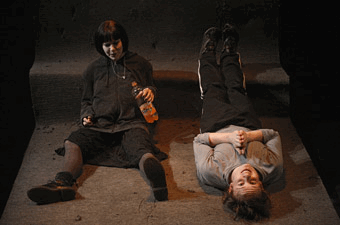
Sarah Ogden, Dylan Young, Moth, Malthouse Theatre and Arena Theatre Company
photo Jeff Busby
Sarah Ogden, Dylan Young, Moth, Malthouse Theatre and Arena Theatre Company
AT THE TIME OF WRITING, THREE PUBLIC DEBATES ARE RICOCHETING AROUND MELBOURNE: THE ALLEGED INVASION OF PRIVACY ENACTED BY SOCIAL MEDIA SITE FACEBOOK; THE “DON’T ASK, DON’T TELL” COMMENTS BY AN AFL FOOTBALLER REGARDING HOMOSEXUALITY IN THE SPORT; AND THE TROUBLING NATIONAL CALL TO “BAN THE BURQA.”
Though no one has, as yet, articulated any link between these issues, it strikes me that a common thread connects them: the right to choose how much of ourselves we reveal to others, and the ways in which we do so. Is society eroding distinctions between public and private, with ‘transparency’ (that loathsome term so favoured by government and big business alike) used to justify an increasingly Foucaultian surveillance of citizens? Maybe. Thankfully I can take these thoughts to the theatre, where the politics of the gaze and the power of the audient can be explored under more controlled conditions.
malthouse & arena: moth
At the centre of Moth, the latest production between Arena Theatre and Malthouse Theatre, is a moment of violence that speaks directly to these concerns. There is an assault, but the true savagery stems less from the physical harm inflicted than the fact that it is filmed on a mobile phone and uploaded to the internet. We watch the two teenage victims reliving their pain as unwilling spectators themselves, party to the comments of schoolmates splaying out beneath the endlessly repeatable footage. It’s a peculiarly postmodern horror that is compounded by their own complicity—in assuming the position of witness to their own bullying, they soon take on the role of bully themselves and turn upon each other.
There’s far more to Moth than this—it’s an outstanding character study inspired by tragic real events, as well as a finely crafted example of collaborative theatremaking at its best. Declan Greene’s script digs deeply into the monstrous dynamics of high school life that many of us have probably repressed (for good reason); it’s almost assured that any audience member will leave with an enriched, if unsettling, understanding of the frightening world today’s teenagers inhabit. It’s also a superbly performed work, with Dylan Young especially creating a compelling and complex anti-hero.
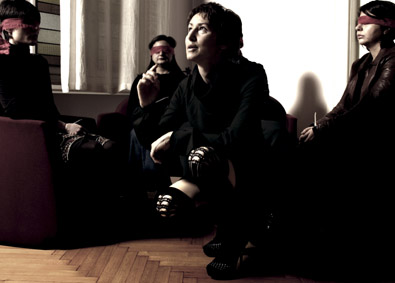
Roberta Bosetti, The Persistence of Dreams: The Sandman, IRAA Theatre
photo Umberto Costamagna
Roberta Bosetti, The Persistence of Dreams: The Sandman, IRAA Theatre
iraa: the persistence of dreams:
the sandman
The gaze is turned upon the audience in IRAA Theatre’s The Persistence of Dreams: The Sandman. A pair of strangers enter your home; after guiding them through the dwelling you are seated and a performance, of a sort, begins. Into the dialogue creep telling references to a range of intertexts that explore the breakdown of social norms and domestic security—Michael Haneke’s Funny Games, David Lynch’s Blue Velvet, Cormac McCarthy’s The Road. Soon enough you find yourself involved in just such a violation, subjected to a mild but provocative series of acts that put you in the role of object rather than voyeur. The fact that the experience is shared—you must gather between six and 12 fellow travellers—adds to this a sense of shared subjugation.
The work’s title alludes to the ETA Hoffmann short story which prompted Freud’s theories of the uncanny, and the experience itself literalises this notion as an incursion of the unfamiliar into the known. It’s not a terrifying experience, and neither is The Persistence of Dreams, but it does have a haunting effect enhanced by the manipulation of your home’s lighting and the rearrangement of the items in your living space. Most tellingly, once the strangers had departed, I found myself discussing for several hours with my fellow guests exactly what had just occurred, as if to dispel some lingering phantom and seek through words the return of the familiar.
jo lloyd’s 24 hrs, dancehouse
A recent Jo Lloyd project commissioned by Dancehouse offered a less threatening form of meditation on the way the makers of art modulate what is shown and kept hidden. 24 Hrs saw four choreographers each given a 24-hour period in which to develop a work from scratch, presenting the new performance at the conclusion of the allotted time. Much of the development was recorded on video and streamed online, where audiences could join in discussions of what they were seeing and become active commentators.
Though I could only make it to the first two presentations of 24 Hrs I found in them a marked contrast. Natalie Cursio’s work was a messy installation of recycled waste in which a series of fertile scenarios sprouted. The three dancers worked around clear moments in which power dynamics shifted or relationships reformed themselves; within this framework there was still a loose sense of play and spontaneity which tapped the tight time restrictions to produce a charming liveliness. In a post-show forum Cursio was asked whether the piece would go on to have a further life in some form, but all present seemed to agree that its transience was key to its meaning.
Shelley Lasica’s work the following week—also for three dancers—had a similar air of improvisation within boundaries, but for me didn’t raise the range of questions Cursio’s work inspired. It appeared more a formal exercise in technique, admirable in that respect, but not making the conditions in which it was produced a part of its own investigation. It was a work that could easily be seen as the starting point for a later, more developed project, but this meant that on its own it seemed too much a performance in embryonic form rather than something complete and contained in its own right.
Both pieces did allow audiences to contemplate the exposed mechanics of creation, but does viewing fragments of a work in progress and hearing the thoughts of makers on the fly add to or subtract from our experience of the final result? I don’t know the answer. It simply offers a different experience with its own rewards and disappointments. I certainly wouldn’t want the bones of every production revealed, since one of the joys of art is the possibility of encountering something magnificently realised from a position of innocent ignorance. Conversely, most forms of aesthetic production emerge from a process in which artists select those things they wish to reveal and attempt to control other functional elements. Pay no attention to the man behind the curtain.
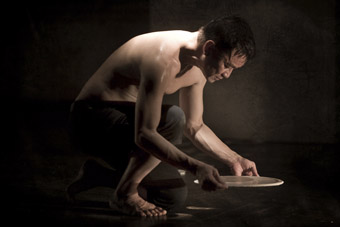
Tony Yap, Rasa Sayang
photo Jave Lee
Tony Yap, Rasa Sayang
tony yap, rasa sayang
None of this is new. The contract between a performer and their audience has always possessed its variable clauses of revelation and reticence, knowing and guessing, curiosity and blindness. There is an uncomplicated pleasure in being offered something that doesn’t claim a raw, unmediated transparency but is the result of careful crafting and modulated reticence. One such offering was Tony Yap’s Rasa Sayang, a small but exquisite solo dance accompanied by a live score by Tim Humphrey and Madeleine Flynn.
Before the performance began, Yap was among his audience, conversing with animation, but once the lights dimmed he entered a state of precisely controlled expression that channelled great emotions into tiny gestures. Much of the work seemed to work through memories of Yap’s mother and the intimacy of memory, regret and grief, but this was not an autobiographical work. That only brief, at times abstract details, of this relationship were unveiled didn’t obscure the effects of the piece but broadened them, allowing Yap’s audience space within which to introduce their own experiences and understanding of family and distance. Though not an overt subject of the work, this necessary reciprocity in any act of performance will always inform its shape and significance; when we look at another, we may also be looking at ourselves.
Arena Theatre & Malthouse Theatre, Moth, writer Declan Greene, director Chris Kohn, performers Sarah Ogden, Dylan Young, design Jonathan Oxlade, lighting Rachel Burke, composer Jethro Woodward; Tower Theatre, CUB Malthouse, May 13-30; IRAA Theatre, The Persistence of Dreams: The Sandman, created & performed by Roberta Bosetti & Renato Cuocolo; various locations, April 7-May 7; 24 Hrs, curator Jo Lloyd, choreographers Natalie Cursio, Shelley Lasica, Phillip Adams, Luke George; Dancehouse, April 30 – May 21; Tony Yap Company, Rasa Sayang, creator, performer Tony Yap, composers Tim Humphrey, Madeleine Flynn; fortyfivedownstairs, Melbourne, April 22-25
RealTime issue #97 June-July 2010 pg. 29
© John Bailey; for permission to reproduce apply to realtime@realtimearts.net
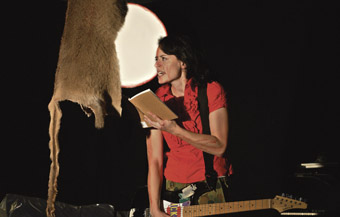
Deborah Robertson, Prompter Live Studio Development, 2010, Hydra Poesis
photo Traianos Pakioufakis
Deborah Robertson, Prompter Live Studio Development, 2010, Hydra Poesis
THE WESTERN AUSTRALIAN THEATRE DEVELOPMENT INITIATIVE (WATDI) IS NOW IN THE SECOND YEAR OF ITS PILOT PROGRAM, WITH 2010 APPLICATIONS CURRENTLY AT THE SHORTLIST STAGE AND THREE SUCCESSFUL APPLICANTS FROM 2009 WELL ADVANCED IN THEIR CREATIVE DEVELOPMENTS.
Funded by the Australia Council, WATDI’s formal structure is of particular interest for two reasons: its five-stage, consultative application process, and a seemingly unique management partnership of three key players in Perth’s contemporary performing arts scene: Perth Institute of Contemporary Arts (PICA), The Blue Room and ArtRage.
According to PICA Director Amy Barrett-Lennard, WATDI is currently the only significant provider of development funding for new theatre in WA, following the demise of the state government’s Major Production Fund. The scheme’s particular aim has been the encouragement of artists to engage in intensive research and creative development, without necessarily focusing on performance outcomes. It offers amounts of $30,000, $60,000 or $90,000 to assist successful applicants to achieve their goals.
To this end, in 2009-10 local companies Hydra Poesis, pvi collective, and a Sudanese-Australian theatre exploration, The Shrouds or the Dead, have each been fortunate to explore, research and develop work, not only free from the pressure of producing a show, but actively encouraged to ‘think big’ along the way.
Hydra Poesis received $60,000 to develop Prompter Live Studio. The work takes place in three locations simultaneously, with three completely separate audiences linked by interconnected studio installations. It follows the evolving relationship between a foreign correspondent and their local ‘fixer;’ explores a surreal prisoner-exchange; and enters the performative world of the lone video blogger.
Prompter Live Studio’s development team includes Hydra Poesis Director Sam Fox, co-writer Patrick Pittmann and sound artist David Miller, with performers Deborah Robertson, Michelle Robin Anderson and Brendan Ewing. The WATDI grant, in addition to buying development time, has enabled the team to work with mentor Dicky Eton of UK performance group Pacitti Company, live forum TV producer Richard Fabb and writer/dramaturg Stephen Sewell.
Working with these artists, says Fox, has helped the team develop a deep understanding of how Prompter Live Studio’s blend of performance material and technical approach might work with more traditional ideas of storytelling. The project, he says, has been an opportunity that other forms of funding could not have adequately supported.
“One of the things the WATDI process is trying to be true to,” he says, “is the idea of this being a predominantly research and development process, and not turning it into a creative development where we try and produce as much of the work as we can.”
He believes that without the WATDI funding, Hydra Poesis could not have undertaken the research: “We would have made an attempt at the work but…it’s a really ambitious project, and thematically and conceptually it requires a lot of development.” He also feels that the standard “bums on seats” requirement would have precluded it from other current funding options.
WATDI’s five-stage application process begins with a one-page proposal. Shortlisted applicants are interviewed by panellists from the three partner organisations, and a further shortlist is invited to develop proposals further, and provided with $3000 to do so. In-depth discussion then takes place with the panel, this time including an additional, ‘external’ member. Stage five is the funding announcement and from here on, the degree of communication is largely up to the grant recipients.
All the partner organisations see this process as a chance for artists to discuss and develop their proposals in a supportive environment. Fox agrees that rigorous discussion of the proposal at interviews helped Hydra Poesis to refine and develop their proposal. Both Fox and PICA’s Performance Program Manager, Vernon Guest, acknowledge the care with which the artist–funder relationship needs to be managed, however, particularly in a small arts environment where ‘everyone knows everyone.’
Guest says the structure continues to evolve in the current round, with the panel working to achieve the ideal balance between ‘arm’s length’ and ‘responsive’ approaches. The benefit of more communication with artists lies in greater sharing of expertise and advice, and a more supported structure. At the same time, a major benefit of less contact is the minimisation of administration costs. Guest cites some organisations as carrying around 15% of administration costs, partly due to the need for project officers to be constantly communicating with artists. WATDI is currently running at around five to seven percent administration costs.
Both PICA’s Amy Barrett-Lennard and The Blue Room’s Louise Coles comment that one of WATDI’s unexpected positives has been the developing relationship between the three partner organisations. The work of running WATDI is divided according to resources, for example PICA takes care of marketing and communications, as it is well set up to do this.This ‘piggy-backing’ of WATDI requirements onto existing infrastructure is also significant in keeping costs down.
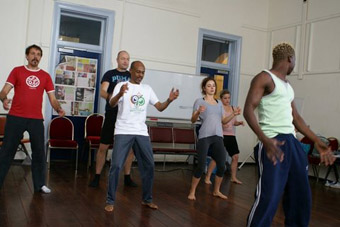
Workshop, The Shrouds or the Dead
Hydra Poesis is nearing the end of its WATDI development, and plans to produce a ‘test’ version of Prompter Live Studio in 2011. Other recipients in 2009, pvi collective, used their WATDI funding to research and develop Transumer, an ‘augmented reality’ work using iPhones, currently running as part of 17th Biennale of Sydney. The Shrouds or the Dead, based on a play by Sudanese-Australian writer Afeif Ismail, took the form of a three-week intensive development in which performers, musicians and a translator joined Ismail in exploring the ‘transcreation’ of his work to an Australian, multicultural context, examining how Sudanese performance tradition could inform and be informed by other methods, including Butoh.
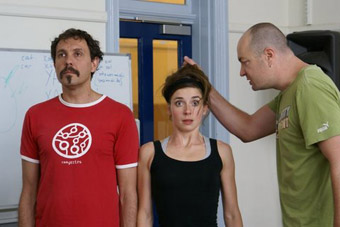
Workshop, The Shrouds or the Dead
ArtRage Festival Director, Marcus Canning, speaks positively about the applications in the current WATDI round: although they were fewer in number, he says, the quality this year was higher overall, with greater diversity and some very strong regional proposals. The point of the initiative, he reasserts, is “development unshackled from the needs of set production outcomes.”
“There is a sense in the second year that there is a growing understanding of what this can mean,” Canning says, “and more key practitioners putting forward a greater array of expansive and brave development ideas.”
It appears WATDI’s impact is threefold: strengthening the research focus of the companies involved through the critical feedback process (a process, it should be noted, that extends not only to successful applicants); providing WA’s theatre sector with an important new opportunity to develop work at a deep level; and building relationships between the organising partners. The Australia Council for the Arts will soon receive reports from WATDI on its first year of operation; then it will begin to make its own assessment of the initiative. Meanwhile, it will be interesting to see what emerges from the 2010 application round.
The Western Australian Theatre Development Initiative (WATDI) is funded by the Australia Council for the Arts and driven by partners PICA, The Blue Room and ArtRage. WADTI: www.watdi.org.au; Hydra Poesis: hydrapoesis.net; pvi collective: www.pvi.com; The Shrouds or the Dead: http://shroudsorthedead.wordpress.com/about/
RealTime issue #97 June-July 2010 pg. 30
© Urszula Dawkins; for permission to reproduce apply to realtime@realtimearts.net
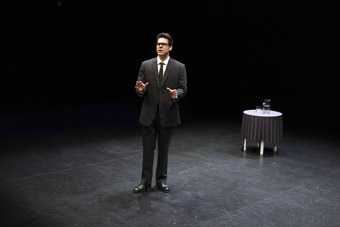
Jason Klarwein, Thom Pain (based on nothing), Queensland Theatre Company
photo Rob Maccoll
Jason Klarwein, Thom Pain (based on nothing), Queensland Theatre Company
SO FAR THIS YEAR IN BRISBANE TWO PERFORMANCES STAND OUT FOR THEIR ABILITY TO TRACK THE TWISTS AND TURNS CONTEMPORARY ANOMIE HAS TAKEN WHILE AT THE SAME TIME SHOCKING US INTO A PROFOUND REALISATION OF OUR OWN ISOLATION AS INDIVIDUALS. INSTEAD OF ASKING US TO GET INVOLVED, JOIN A RECOVERY GROUP OR ASK OUR DOCTOR FOR A PRESCRIPTION FOR PROZAC, THESE WORKS SEVERELY TESTED THE METTLE OF THEIR AUDIENCES AS THEY PRESENTED INVIGORATINGLY DIFFERENT (AND DESPAIRINGLY SIMILAR) VERSIONS OF THE GROUND ZERO OF THE HUMAN CONDITION.
The first of these was the homegrown product, Brian Lucas’ Performance Anxiety (RT96), a whirling dervish of performance cabaret which stands authoritatively alongside, and bears comparison with, American playwright Will Eno’s monologue titled Thom Pain (based on nothing), directed by John Halpin and performed by Jason Klarwein for the Queensland Theatre Company, and which has been described as “stand up existentialism.”
If both productions are dominated by the en-soi—in Sartrean existential terms the world experienced as alien and senselessly contingent dominated—they also cast a penumbral light on the dialectically opposing notion of the pour-soi, the individual self who challenges the givens of both social and personal history from a position deemed to be inalienably and ineluctably free. Both performances hinged on this quixotic quest for self-identity, so it is no wonder that a forthcoming project of Eno’s is an adaptation of the classical treatment of the subject, Ibsen’s Peer Gynt.Nor is it surprising that Lucas is currently directing Ionesco’s absurdist drama, The Chairs, for La Boite Theatre in Brisbane. In an evident revival of tradition, both seem to have learned from Beckett’s use of even the most miniscule silence to offset their words, and are well versed in Pinter’s throwaway sleight of hand.
Eno is a funny writer in the sense that Pinter wrote to The Sunday Times in 1960: “As far as I’m concerned The Caretaker is funny up to a point. Beyond that point it ceases to be funny, and it was because of that point that I wrote it.” Eno in an interview with QTC, revealing the level of his own subtle sleight of hand, writes, “The play’s title reminds me, of course, of Thomas Paine (famous for his Revolutionary War pamphlets with the words “the summer soldier and the sunshine patriot”), but it also somehow reminds me of a broken arm, both soft and hurtful, recognisable, but somehow wrong.” Behind the wounded and apparently character-armoured and conformist representation of Eno’s anti-hero, who wears a plain dark suit and tie and sports black horn-rimmed glasses, stands an authentic revolutionary hero, the existential pour-soi. If Thomas Paine the pamphleteer is feebly recapitulated in Thom Pain’s solipsistic maunderings, and Thom’s feints to rhetorically engage with the audience are succeeded by an almost instantaneous withdrawal from the fray, there is indeed a soft hurtfulness, a recognisable wrongness which is manifestly our own mirrored in his actions.
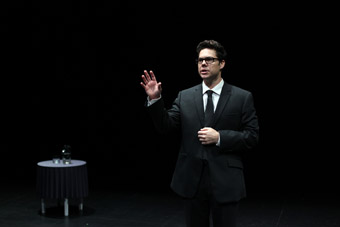
Jason Klarwein, Thom Pain (based on nothing), Queensland Theatre Company
Although he adopts the stance of being perpetually, paranoidly en garde, it seems useless to attempt to psychoanalise a character who is such a writerly, theatrical confection. Only towards the end, when the defensive precision of language breaks down into a painful, repetitively fragmented stream of consciousness does he let his guard down and invite our sympathy in the usual sense. This is the point at which he flies away, disappears back into the realm of his author’s imagination while leaving behind the concrete presence of the hapless other, his mirrored substitute—the member of the audience he has cajoled onstage to assist in an act of magic which has failed to ensue, unless by Catholic transubstantiation. His last line as he exits is the puckishly ironic: “Isn’t it great to be alive?”
The strength of the production lies in Eno’s Wildean language which incorporates such pithy observations about the end of a love affair as “I disappeared in her and she, wondering where I went, left.” Such ironic lucidity is equally applied to the nicely established loneliness of childhood (Thom doesn’t mention his parents) in an anecdote about the accidental electrocution of his pet dog. The most verbally actualised and traumatic scenario describes the boy’s misapprehension when he is attacked by bees: “Kind of beautiful, if you like that sort of thing. If you like the idea of a little boy desperately spreading stinging bees over his bleeding body. Desperately yelling, ‘Help me, bees, Help,’ and putting his little swollen hand into the hive for more.”
Thom’s recounting of his life turns on such incidents in a Yeatsian gyre rather than any straightforward narrative. A writer like Eno, as Martin Esslin said about Beckett, is essentially lyrical, concerned with such basic questions as “Who am I?” Both Eno and Lucas have returned to the problems enunciated by the great 20th-century poet Rilke in The Notes of Laurid Brigge: “And so we walk around, a mockery and a mere half: neither having achieved being, nor actors.” John Halpin and Jason Klarwein made an intelligent and sensitive team elucidating the philosophical premises, and at the same time urging each of us to become the good person whom Eno was trying to be when he wrote the piece.
Queensland Theatre Company, Thom Pain (based on nothing), writer Will Eno, director Jon Halpin, performer Jason Klarwein, composer Phil Slade, lighting designer Jason Glenwright, design consultant Josh McIntosh; Billie Brown Studio, Brisbane, March 15-April 10
RealTime issue #97 June-July 2010 pg. 32
© Douglas Leonard; for permission to reproduce apply to realtime@realtimearts.net
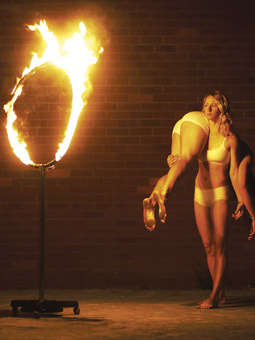
Rachael Ogle, Sam Fox, Hydra Poesis
Hydra Poesis’ new work Personal Political Physical Challenge premieres in July at PICA. It’s described as “a provocative, exciting and adult interpretation of the childhood game “truth, dare or physical challenge?”
Hydra Poesis is run by Sam Fox who has been artistic director of STEPS Youth Dance Company, created in community cultural development and festival programs and is working on a Masters degree on community collaborative production models at Murdoch University. You can read about his Western Australian Theatre Development Initiative (WATDI) project Prompter Live Studio.
Fox’s motivation for the show is clearly evident, “From B-grade romance to high drama, protagonists are so often concerned with the internal intricacies of their relationships with each other with no regard to their shared connection to the rest of the world. In this show we set those plot indulgences on fire!” Yes, fire is one of the components of the show, along with dance and ‘surreal’ theatrics.
Fox is directing and co-choreographing with collaborators Rachel Ogle and Martin Hansen while the show’s visual world is being realised by Thea Costantino and its music by Stina Thomas. RT
Hydra Poesis, Personal Political Physical Challenge Perth Institute of Contemporary Arts, July 16–20; http://hydrapoesis.net
RealTime issue #97 June-July 2010 pg. 32
© RealTime ; for permission to reproduce apply to realtime@realtimearts.net
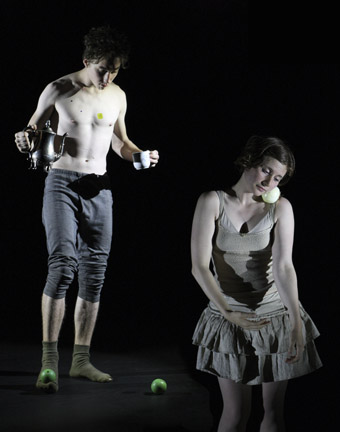
Silvertree & Gellman, Scattered Tacks
photo Alicia Ardern
Silvertree & Gellman, Scattered Tacks
THE NEXT DECADE IN THEATRE AND CONTEMPORARY PERFORMANCE WILL BE A DECADE OF PHENOMENA, NOT OF SIGNS, OF EXPERIENCING RATHER THAN READING PERFORMANCE. THE FIRST ‘SEMESTER’ OF THE ARTS HOUSE 2010 PROGRAM COULD BE NEATLY DIVIDED IN TWO PARTS: AUSTRALIAN CONTEMPORARY CIRCUS AND UK-BASED RELATIONAL PERFORMANCE. THE LATTER (WHERE THE AUDIENCE BECOME PERFORMERS AND CO-CREATORS) IS A BACKLASH AGAINST 20 YEARS OF MEDIATISED POSTMODERN THEATRE.
These new works are theatre minus stage, performance minus performers and spectacle minus the spectacular. The audience experience is the event itself: tactile, immediate, immersive, anti-ironic. The semiotic component is minimal, sometimes altogether absent, as the performance exists mainly in the mind of the spectator. It appears, perhaps, as our era abandons questions of meaning and engages with amplified possibilities of doing. It’s almost like a direct answer to Deleuze’s dream of the new non-representational theatre, in which “we experience pure forces, dynamic lines in space which act without intermediary upon the spirit.” And although tested by performance-makers both here (bettybooke, Panther) and elsewhere (Rimini Protokoll), the UK, building on its rich variety of live art, is something of a leader.
This form is too young to have encountered much meaningful criticism in Australia, but every form quickly accumulates knowledge. While I don’t think everything we have seen at Arts House could be called successful, the failures are just as interesting, like the results of an experiment.
Take Rotozaza. Their two shows, Etiquette and Wondermart, promised a new form of expression, ‘autoteatro,’ but delivered a half-hearted combination of pomo referentiality and demanding, mediatised interactivity. Both are no more than voices inside a headset, giving instructions to a single audience member. Wondermart is a walk through a(ny) supermarket. Etiquette is 30 minutes in a café, in which you and another audience member perform an encounter, a conversation from Jean Luc Godard’s Vivre Sa Vie, the final scene from Ibsen’s A Doll’s House, and much else—sometimes by talking to each other, sometimes moving figurines on the chess board in front of you.

Wondermart, Rotozaza
photo Ant Hampton
Wondermart, Rotozaza
While very engaging in those few moments when the narration matches what’s happening in space (such as when theories of shopper behaviour are confirmed by innocent bystanders in the supermarket), most of both shows consisted of a series of mundane and tiring little tasks. Despite the interactive pretences, they were not so much an experience for one audience member as a performance by one audience member, with the concomitant stage anxiety—even if nobody was watching. The problem was not just that many aspects of the situation cannot be sufficiently controlled by the audience-performer (my noisy supermarket trolley forbade me from following shoppers as instructed; or the concentration required to both quickly deliver lines and hear your partner-in-dialogue). Rotozaza underestimate our anxiety not to let the performance down: a compulsive need to please the dictatorial voice inside the headphones by performing everything right.
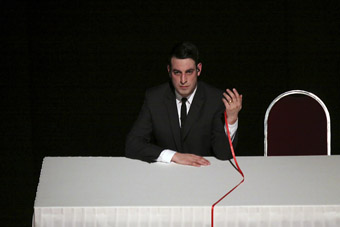
Mem Morrison, Ringside
photo National Museum of Singapore/Chris P
Mem Morrison, Ringside
If Rotozaza forgot how unpleasant structured events can be, Mem Morrison went all the way and staged the worst aspects of a wedding ceremony in Ringside. Its entire conceptual spine is the sense of alienation, monotony, meaninglessness and loneliness one feels at a collective ritual. The performance starts before it starts—audience groups are arranged into family photos, well-dressed and carnation-studded as per instructions—and seated around one long table. An infinite number of black-clad women, both attendants, family and brides-to-be, deliver food and crockery. Amidst the flurry Morrison is the only male, unhappy, confused, 12 years old, jokingly told it’s his turn next, sometimes playing with a Superman toy and sometimes MC-ing with his shoe instead of a microphone.
Ringside’s aspirations are sky-high, but the performance never manages to reveal much of its topical menagerie: ethnicity, gender, tradition, multiculturalism are signposted rather than explored or experienced. Morrison’s entire text is delivered through headphones, creating a mediatised distance that in 2010, after 20 years of screens onstage, is as déjà-vu as it is genuinely disengaging. There is a paradox within Ringside: it purports to bring forth an aspect of Turkish culture, but the distanciation intrinsic to the method condemns it as facile. The experience is ultimately of witnessing a whining 12-year-old, loudly airing his discontent at being dragged to a family event.
Helen Cole’s Collecting Fireworks, on the other hand, a performance archive and an archive-performance, is as simple as it is brilliant. A genuine one-on-one performance (a dark room, a single armchair, recorded voices describing their favourite performance works, followed by recording one’s own contribution), it exemplifies the opening possibilities of this new form: no stage, no performers, but a deeply meaningful experience. I suspect the end result will be a genuinely valuable archive of performance projects, as we are encouraged to remember not only the details of these works, but also the effect they had on us.
The reasons the two local circus performances were on the whole much more successful are complex: Australia’s long tradition of contemporary circus and Melbourne’s close acquaintance with both the form and the artists are not the least important. If with relational performance, imported from an emerging artistic ecology overseas, we occasionally felt both short-changed and ignorant, with circus we could comfortably feel at the world’s cutting edge.
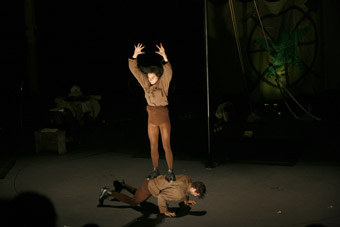
Propaganda, acrobat
photo Ponch Hawkes
Propaganda, acrobat
Acrobat’s long-awaited new work, Propaganda, points to the long tradition of circus used as Soviet agitprop, educational art dreamt up by Lenin in 1919 as “the true art of the people.” The company’s take is both ironic and deeply earnest, and it takes weeks of confusion before concluding that, yes, their open endorsement of cycling, eating veggies and gardening nude was serious. The tongue is in cheek, yes, when spouses Jo Lancaster and Simon Yates heroically kiss in the grand finale, centrally framed to the tune of Advance Australia Fair like the ideal Man and Woman in social-realist art. But it is a very slight joke indeed.
The specificity of circus could be defined as the pendular motion between crude and dangerous reality and the illusion of spectacle: relying on physical strength more than on representational techniques (it is impossible to just ‘act’ a trapeze trick), it can never completely remove the real from the stage. Acrobat’s previous (and better) work—titled smaller, poorer, cheaper—created tension by opening up the spectacle to reveal the hidden extent of the real: social stereotypes and obligations, physical strain, illness. Propaganda foregrounds circus as this family’s life: from the two children pottering around to the unmistakable tenderness between Lancaster and Yates and the heart-on-sleeve honesty of the beliefs they propagate. The dramaturgical incongruence between the ironic self-consciousness of the Soviet theme, with its inevitably negative undercurrent, and the performers’ trademark lack of pretence, remained the least fortunate aspect of the work. From the message to the magnificent skills on display, everything else was flawless.
Scattered Tacks, by Skye and Aelx Gellman and Terri Cat Silvertree (see article), stripped away spectacle to reveal the essence of circus: awe. Circus is a naturally postdramatic form: its narrative arc fragmented, aware of its own performativity (what Muller called “the potentially dying body onstage”) and constantly anxious about the irruption of reality on stage. Scattered Tacks is raw circus, naked: at times it felt like an austere essay in thrill. It revealed that the rhythm of audience suspense and relief hinges less on the grand drama of leaps and tricks and more on visceral awareness of the subtle dangers and pain involved. Eating an onion, climbing barefoot on rough-edged metal cylinders, overworking an already fatigued body—these were the acts that left the audience breathless. Yet they also achieve poignant beauty. The Gellmans and Silvertree bring Australian circus, traditionally rough and bawdy, closer to its conceptual and elegant French sibling, but in a way that is absolutely authentic.
Australia offers a good vantage point from which to observe the human being. Visiting Europe recently, it struck me how dense the semantics of the European theatre are in comparison. Performing bodies there are acculturated and heavy under the many layers of interpretation, history, meaning. The body here, on the other hand, easily overpowers the thin semiotics of Australian culture, emerging strong, bold and without adjectives, without intermediary. Body as phenomenon, not as signifier. It will be interesting to observe how the emerging interest in theatre as presence, rather than representation of meaning, unravels—and how much this country will participate in this trend. In this season it’s circus, one of the oldest forms of performance, that emerges as the more successful. The relational performance works only rarely overcame the trap of referentiality.
Arts House: Rotozaza, Etiquette, Wondermart, co-directors Silvia Mercuriali and Ant Hampton, Arts House and around Melbourne; Mar 16–April 3; Mem Morrison Company, Ringside, writer, director, concept, performance Mem Morrison, sound & music composition Andy Pink, design Stefi Orazi, North Melbourne Town Hall, March 17-21; Helen Cole, Collecting Fireworks, director Helen Cole, technical consultant Alex Bradley, North Melbourne Town Hall, March 17-19; Acrobat, Propaganda, conceived and performed by Simon Yates and Jo Lancaster, also featuring Grover or Fidel Lancaster-Cole, Meat Market, March 27-April 3; Silvertree and Gellman, Scattered Tacks, created and performed by Terri Cat Silvertree, Alex Gellmann, Skye Gellmann, Arts House, Meat Market, Melbourne, March 16-21
RealTime issue #97 June-July 2010 pg. 33
© Jana Perkovic; for permission to reproduce apply to realtime@realtimearts.net
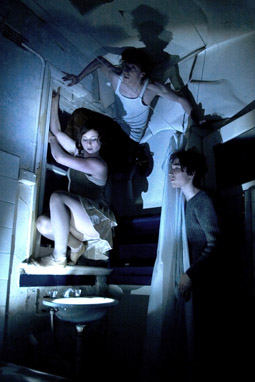
Silvertree & Gellman, Scattered Tacks
photo Alicia Ardern
Silvertree & Gellman, Scattered Tacks
The creators of Scattered Tacks, Skye Gellmann, Terri Cat Silvertree and Aelx Gellmann are fast building a reputation as physical theatre innovators with a performance language all of their own. In this edition Jana Perkovic reviews the recent Art House showing of Scattered Tacks.
The trio variously trained in circus and physical theatre as children working with Cirkidz, Kneehigh Puppeteers and then Urban Myth Theatre of Youth in Adelaide and in later years in corporeal mime and traditional and contemporary Japanese theatre forms.
Aelx Gellman describes himself as “a creative masochist, unusualist and escape artist, specialising in random feats of dexterity and prestidigitation.” To this we might add the human spelling error! The Gellmanns studied at NICA and all were involved in co-founding companies (Rambutan, Shuttlecock) along the way. The three went on to gather a string of Best Emerging and Most Promising awards including for Skye Gellman in 2007 Most Promising Male Actor at Melbourne’s Short and Sweet festival.
In 2008 their signature work, Scattered Tacks won the Melbourne Fringe Award for Most Outstanding Production and in 2009 was programmed by Yaron Lifschitz at CIRCA for their showcase of new works at Brisbane Powerhouse. This is where our reviewer Douglas Leonard was taken by the work: “No extraneous effects. Fragments of a life obscurely shared were dimly recreated. The light distorted, flattened and sculpted identifiable shapes into pure, foreboding forms.” (See full review.) Lifschitz described Scattered Tacks as “one of the most challenging and significant pieces of New Circus to emerge in years.” In the same year, the work toured to Noorderzon Performing Arts Festival in the Netherlands.
Skye Gellmann is currently developing a solo performance for the 2010 Sydney Fringe Festival called Eyes Fight, Projector Light, “a minimalist circus experiment involving an acrobatic body and the cutting light of a slide projector.” It will be is directed by Terri Cat Silvertree who is also developing her own solo performance. RT
www.scatteredtacks.skyebalance.com
RealTime issue #97 June-July 2010 pg. 34
© RealTime ; for permission to reproduce apply to realtime@realtimearts.net
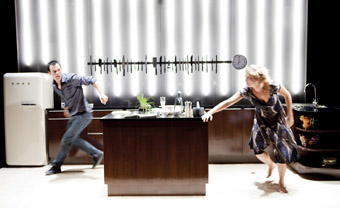
Socratis Otto, Leeanna Walsman, Stockholm, Sydney Theatre Company
photo Brett Boardman
Socratis Otto, Leeanna Walsman, Stockholm, Sydney Theatre Company
UK PHYSICAL THEATRE GROUP FRANTIC ASSEMBLY EXPLAIN IN THE PROGRAM NOTES TO THEIR AUSTRALIAN RECONSTRUCTION OF STOCKHOLM, THAT ‘STOCKHOLM SYNDROME’ OCCURS WHEN A “HOSTAGE SHOWS SIGNS OF LOYALTY TO THE HOSTAGE-TAKER.” A TEXT-BASED WORK WITH DANCE AND MOVEMENT INTERJECTIONS, STOCKHOLM HAS BEEN REMOUNTED BY DIRECTOR-CHOREOGRAPHERS SCOTT GRAHAM AND STEVEN HOGGETT WITH AN AUSTRALIAN CAST TO FIT A PRE-EXISTING CHOREOGRAPHIC SCORE. THE PRETEXT FOR THE PLAY IS “DIFFICULT AND DESTRUCTIVE” LOVE.
Playwright Bryony Lavery was commissioned by the company to interweave words with movement around themes of control, desire and manipulation. Employed as a recurring motif, the word “Stockholm” comes to work as an awkwardly literal reference to the demise of a sparring couple’s relationship. It is both the actual ‘elsewhere’ of a holiday in the making and the figural ‘reality’ of a relationship-in-crisis.
The main misuse of the term is in its application to the the young couple, Kali and Todd (Leeanna Walsman and Socratis Otto), Lavery envisaging their world in terms of “retro-jealousies” over past lovers, overblown romantic ideals and sickly sweet histories. On the celebration of Todd’s birthday, they dance around their SMEG/smug kitchen meting out reminiscences and arguments over a recipe for dinner. Stockholm, the literal city, sits in the distance as the promise of holiday escape from a relationship that appears more like something from a real estate advertisement than anything real. Stockholm Syndrome—the metaphorical premise of passive submission to a controlling power—never materialises as we slowly realise that Kali’s manipulations (taunts, violence, spying on Todd’s text messages) are the product of something infinitely more despairing than dynamics of master and slave. It seems that Kali is deeply psychologically unwell—a thematic with which Stockholm unfortunately never risks engaging.
Kali and Todd’s pas-de-deux is played out through a combination of text and physicality, where the literal again looms large in movement pieces that could have more abstractly conveyed the difficult machinations of mental illness and its impacts on loved ones. Instead, the choreographers plot the lovers stacking the grocery shopping in the kitchen cupboards, for example, with gestures that resemble musical, more than physical, theatre. They do make suspenseful use of tight kitchen spaces and knives, but when movement is pre-empted by the text, the problems are exacerbated. Kali’s calls for “birthday dance time” and “this last dance, it’s a slow one” uncomfortably reveal that text and movement, caught in a kind of self-conscious narration of their dramaturgical coexistence, aren’t speaking to each other at all. In this respect, this work loses its relevance to a field of progressively innovative physical or movement-based theatre work which also happens to be locally driven and conceived (think Force Majeure or Branch Nebula).
The action takes place in a set that also over-performs: we move between a tight kitchen space, an outdoor stairwell, an upstairs attic bedroom and a balcony water pool. The mechanised apparatus intrudes into the fictional world in a way that might be better left unelaborated. Moments of scenic abstraction could be promising (a strange devil-like voice appears both at the staircase and in the water pool) but seem more drawn towards underscoring scenographic technicalities rather than developing any stronger thematic sense of actual psychological disorder. A bedtime scenario towards the close of the piece does attempt to place physical tension in relation to narrative tension (the performers are suspended by arm straps on a high leaning platform whilst taking us to a quasi dreamstate in which they pre-empt the future birth, and then grisly murder, of their own children), and yet this too is undercut by their concurrent baring of sexy chests and skin.
If Stockholm Syndrome registers a scenario of unwitting surrender to a hostage-taker, then Stockholm left me feeling disengaged. When issues of mental illness are conveyed as simplistically violent and manipulative, when relationships resemble the stylistic tropes of The Sydney Magazine, and when theatre then moves in its bag of tricks to try to take us all hostage, I’m tempted to have a similar response to Todd, whose final challenge to Kali is calmly to the point: “I’m too intelligent for this.”
Frantic Assembly, Sydney Theatre Company, Stockholm, writer Bryony Lavery, direction & choreography Scott Graham, Steven Hoggett, performers Socratis Otto, Leeanna Walsman, design Laura Hopkins, costumes Jennifer Irwin, lighting Andy Purves, sound design Adrienne Quartly, assistant to the choreographers Dean Walsh; STC, Wharf 1, March 17-April 24
RealTime issue #97 June-July 2010 pg. 34
© Bryoni Trezise; for permission to reproduce apply to realtime@realtimearts.net
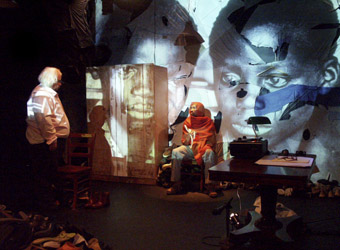
l-r David Moody, Martin Mhando, Witness, Blue Room
photo Serge Tampalini
l-r David Moody, Martin Mhando, Witness, Blue Room
ON A SMALL STAGE CLUTTERED WITH COUNTLESS PAIRS OF OLD SHOES—THE SHOES OF THE DEAD—BETWEEN A COUPLE OF RICKETY WOODEN CHAIRS AND AN IMPOSING, OFFICIAL-LOOKING DESK, TWO MEN PLAY A GAME. ONE, AFRICAN, WIRY AND ENERGETIC, SPINS OR FLIPS A COIN—IT DOESN’T MATTER WHICH—THE RESULT IS ALWAYS HEADS. THE OTHER, WHITE, MASSIVE AND MANIACALLY CONVIVIAL, SEEMS TO BE HIS FRIEND. THE TWO PLAY THE GAME LIKE SPARRING KIDS, LIKE GROWN-UP BROTHERS, LAUGHING TOGETHER MORE INSISTENTLY EVERY TIME THE PREDICTABLE RESULT COMES UP AGAIN—YES, HEADS.
Witness, co-written by award-winning Tanzanian-Australian filmmaker Martin Mhando and WA actor and writer David Moody, explores the law of probability as it plays out in bitter human conflicts, retelling stories of torture and atrocities from Chile to Cambodia in a constantly morphing, fractured form. As the play progresses, the men perform a collage of vignettes in which the roles of white, black, male, female, jailer, prisoner, aggressor and victim are endlessly exchanged. At one point Moody dons a curly black wig to play a comical Colonel Gaddafi; elsewhere both men perform a disturbing Auschwitz cabaret scene as “Hymie and Abe,” complete with Marx Brothers nose-and-glasses.
Produced by newly formed company, Ujamaa—Swahili for ‘collective brotherhood’—Witness is directed and designed by Serge Tampalini, whose shoe-strewn stage is backed by a makeshift projection screen of t-shirt fragments, stretched like overlapping skins. The co-writer-performers and Tampalini are all lecturers at Murdoch University’s School of Social Sciences and Humanities, with lighting and stage management provided by Murdoch students.
Mhando and Moody are joined on stage by actor Lesley-Anne Philps, who as a pointedly well-groomed translator, transcriber and witness observes horrors such as white man Moody repeatedly dunking black man Mhando’s head into a bucket of water, as Mhando attempts to recount the death of a daughter in Rwanda; or the two men telling and retelling their tortures to one another from inside black plastic garbage bags shoved against the piles of rotting shoes. Moody becomes a prisoner, capturing a small bird in his cell—signified by a tiny red satin slipper that he holds delicately with genuinely bruised and welted arms. He delivers a soliloquy that ends with the assertion that “As long as Mandela lives…” But Mandela is dead! laughs Mhando, while the impeccably dressed Philps at her desk smirks at Moody’s wasted passion.
Witness is scripted from several sources including the writings of Tom Stoppard, Athol Fugard, John Kani and Winston Ntshona, and Philip Gourevitch. The bending, morphing and reshaping of narratives produces a sense of anxiety—it’s sometimes hard to follow, but tellingly construes the two men as interchangeable, even placing them at times ‘on the same side.’
The pace and tone of the production are relentless, a barrage of action that might benefit from further development; though, at the same time, audience discomfort serves to highlight the pain of testimony and the legacy of terrors that lies behind the notion of ‘reconciliation.’ At the centre of the work is a scene in which Mhando plays a veiled Antigone, defending her burial of her brother Polynices. Her words seamlessly shift and we realise she’s reciting a section of Noel Pearson’s 2001 address at the Charles Perkins Oration: “On the Human Right to Misery, Mass Incarceration and Early Death.”
The brotherly camaraderie of Mhando and Moody as the play’s alternate antagonists and allies is one of the great strengths of Witness. The opening scene of seeming intimacy and mateship lays a foundation of uncertainty that echoes throughout the ensuing episodes, forcing a constant reassessment of relations between the two.
At times the play’s ever-mounting layers of testament and reframe risk turning to melodrama, as with the scene where Philps holds the collapsed Mhando in her arms, pieta-like, and speaks of “a great Katrina of grief.” The scene is undeniably tender, though, and it is this ability to constantly evince conflicting emotions that seems to propel the play to its ultimate unfolding.
Witness does unfold and seems to end, but takes one last shift to a strikingly coherent scene in which Philps becomes director and Moody and Mhando actors dissecting their own performance with a mix of passion, fire and self-disgust. “Six million people died and we’re doing La Cage aux Folles?,” shouts Moody. “Guilty white liberal and sad black man” confront one another in ‘real life’, until Philps interjects: “He’s the black one, Okay? So he should know!” White man storms off stage. Is he coming back? Black man fishes out his coin and tosses it. “Tails!”, he laughs as he triumphantly exits.
Witness, script, from various sources, by performers Martin Mhando, David Moody, performer Lesley-Anne Philps, director, designer Serge Tampalini, Ujammaa Productions; The Blue Room Theatre, Perth, May 4-22; www.blueroom.org.au
RealTime issue #97 June-July 2010 pg. 35
© Urszula Dawkins; for permission to reproduce apply to realtime@realtimearts.net
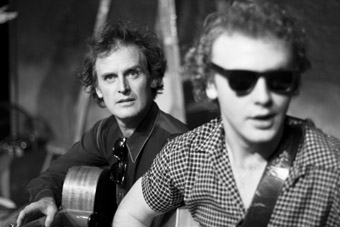
Andrew Henry (Johnny Cash), Matt Ralph (Bob Dylan), Chronic Ills of Robert Zimmerman, Tamarama Rock Surfers
photo Declan Kuch
Andrew Henry (Johnny Cash), Matt Ralph (Bob Dylan), Chronic Ills of Robert Zimmerman, Tamarama Rock Surfers
FOR ANYONE WITH EVEN A PASSING ACQUAINTANCE WITH TODD HAYNES’ I’M NOT THERE (2007), IT WAS IMPOSSIBLE TO SIT THROUGH BENITO DI FONZO’S EPICALLY-TITLED PLAY THE CHRONIC ILLS OF ROBERT ZIMMERMAN: AKA BOB DYLAN (A LIE)—A THEATRICAL TALKING BLUES AND GLISSENDORF, WITHOUT BEING REMINDED OF CATE BLANCHETT’S JUDE QUINN: “I’M JUST A STORYTELLER, MAN. IT’S ALL I AM.”
For one thing, the resemblance of The Chronic Ills’ Matt Ralph to Blanchett’s Quinn is uncanny, as is their resemblance to Bob Dylan, the man on whom their characters are based. For another, the segment of Haynes’ film that Di Fonzo’s play most resembles is the one in which Quinn appears. (Jude is one of six Dylan doppelgängers in the picture, each of whom occupies a stand-alone storyline rendered in a distinct cinematic style.) Both the play and the Quinn segment share a classic pop art sensibility, all appropriation, allusion and madcap namedropping (The Beatles and Allen Ginsberg show up in the film; Joan Baez, John Lennon, Yoko Ono and more in the play). While Haynes’ reference points are predominantly cinematic—Fellini’s 8 ½ and Pennebaker’s Don’t Look Back are the most obvious in the Quinn segment, though Richard Lester’s Hard Day’s Night gets a look-in, too, and Jean-Luc Godard’s Masculin Féminin is referenced throughout all six of the characters’ segments—Di Fonzo turns to Dylan’s music. Mimicking the formal operations of the songs, if not necessarily echoing their content, the play careens along as though it were a lost verse of Subterranean Homesick Blues, relying less on narrative cohesion or biographical accuracy than on free association and impressionistic causal logic.
For some people’s money, this is the production’s greatest shortcoming (as indeed, for more of their money, is true of the film). On the night I saw The Chronic Ills, one person even remarked to me that it felt as though Di Fonzo had written the play in front of the Wikipedia entry on Dylan, resorting to superficial pop culture references and betraying an unfamiliarity with the work. This criticism misses the point, and twice. In fact, The Chronic Ills’ impressionistic streak is evidence of an intense familiarity with Dylan’s work and its internal operations: episodic, fast-paced and surreal, the result is a text constructed entirely out of what Ginsberg, describing the songwriter’s lyrics, once called “chains of flashing images.”
The more serious point missed by this criticism is the fact that the play isn’t really about Dylan at all and therefore needn’t hew too closely to the recorded facts of the troubadour’s life. Rather, the real subjects of the play are storytelling, mythmaking and the formation of identity.
Dylan is the perfect subject for such a project for the simple reason that he has been an active participant in his own mythologising for so long, albeit in a paradoxical, often contradictory manner. He has been lying to and glissendorfing journalists—using language to intentionally mess with them—since his emergence in the sixties (“Mr Quinn, Mr Quinn! Do you have a word for your fans?” “Astronaut.”) and has experimented with the conventions of self-representation and self-mythologising in films such as 1978’s Renaldo and Clara, which he directed, and 2003’s Masked and Anonymous, which he wrote. At the same time, he has bristled at any attempts by others to mythologise him without his consent. His refusal to play any of the roles the culture has prescribed for him, paired with the near-constant reinventions that have allowed him to avoid such prescriptions, gives him a mercurial quality that seems to make mythologisation impossible even as it invites further attempts. I’m Not There is particularly interested in the ramifications of this latter contradiction, and indeed is a product of it. Inspired, according to the opening credits, by Dylan’s music and “many lives,” it offers its complex, fragmented narrative as a metaphor for the various selves we carry inside of us and the unknowability of any whole of which they may ostensibly be a part. (Todd Solondz’s Palindromes did something similar three years earlier.)
The Chronic Ills comes at things from a different angle, suggesting that even in the face of this essential unknowability we might still be able to glissendorf some idea of ourselves into being. Where I’m Not There is about self-effacement—or at least attempts to navigate the terrain of the self-effaced—The Chronic Ills is about storytelling as an act of self-creation. Robert Zimmerman talked Bob Dylan into existence, and that lie, as the titular parenthetical calls him, has been talking himself further into it ever since. What Di Fonzo captures so well with his wordplay monologues and his indifference to the historical record is the idea that a life is as much a work of art as any song or film or play. This is true of any life, of course, but of the artist in question it’s particularly so. Dylan’s life has been a performance fashioned almost entirely out of poetry and lies, which is really just another way of saying out of stories.
Tamarama Rock Surfers, The Chronic Ills of Robert Zimmerman: AKA Bob Dylan (A Lie), A Theatrical Talking Blues and Glissendorf , writer Benito Di Fonzo, director Lucinda Gleeson, performers Andrew Henry, Lenore Munro, Matt Ralph and Simon Rippingale, designer Eliza McLean, lighting design Richard Whitehouse, producers Jennifer Hamilton, Sophie Alize Finnane; Old Fitzroy, Sydney, April 6-24
RealTime issue #97 June-July 2010 pg. 36
© Matthew Clayfield; for permission to reproduce apply to realtime@realtimearts.net
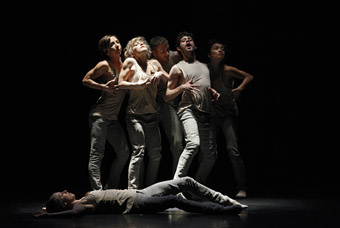
Are We That We Are, Sydney Dance Company
photo Jeff Busby
Are We That We Are, Sydney Dance Company
HERE’S A COLLECTION OF REVIEWS OF QUITE DIVERSE WORKS SEEN OVER RECENT MONTHS WHICH I ADMIRED OR QUERIED, SOMETIMES BOTH, OVER MATTERS OF FORM AND HYBRIDITY. ALL HAD SOMETHING SPECIAL TO OFFER.
adam linder: are we that we are
In a RealTime interview (RT95), young Berlin-based Australian choreographer Adam Linder said of his new work for Sydney Dance Company, Are We That We Are, “I’m personally very interested in altered states, in what is fundamental to the right side of our brain—the sensory, the visionary, the experiential.” The outcome is unlike anything we’ve seen from the company, a series of strange images heightened by idiosyncratic choreography and lighting that dances. As if to suggest that the work takes place in one man’s mind, Linder enters the stage from the auditorium and sits at a desk from which he views a woman with a long rope controlling a horse-man, prancing hypnotically in a wide circle, trotting, falling. Figures unfurl from Linder’s desk. A voice-over speaks of being “reborn to the possibility of rapture.” An elaborate tangling of bodies entwines one woman (Natalie Allen) in particular, light states changing rapidly with each shift in the engagement, her body maximally expressive within the tightest of limits, the apparent indifference of her oppressors. A huge column of light descends like the rolling monolith from 2001: A Space Odyssey (a favourite of ecstasy seekers) but emitting rich, fluid colour states against epic neo-60s guitar as Linder and Charmene Yap, in the demanding centrepiece of the work lock into a sensual knot, a two-headed creature, Kama Sutra-ish. They work close to the floor, driven, disorienting in their relationship to the illuminating, alien surveillor hanging above.
In a big mood swing, a chorus line, arms linked, prance in like a row of Norman Lindsay fauns—soon Linder will ride them like a king on a chariot. In the final scene, as a disturbing bass line distorts, the dancers emerge upstage holding balloons, moving forward, glowing, Linder amongst them, but eventually reversing as if he’s in this, but not of it, echoing the work’s opening. The dramas of control and release, the sci-fi-ish and sexual evocations, group fantasies and the final smiling love-in (a relatively unremarkable scene) are what we expect of altered states but are here imbued with a disturbing otherness and enriched by imaginative choreography and committed dancing, not least from Linder himself, and superb lighting by Nick Schlieper. Are We That We Are was on a double bill with Rafael Bonachela’s 6 Breaths.
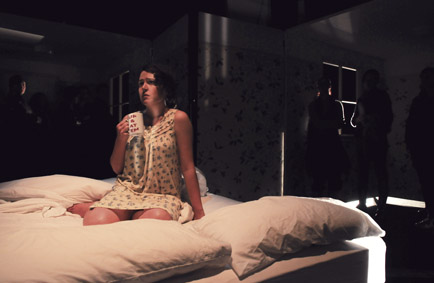
Clare Britton, Hole in the Wall, Performance Space
photo Heidrun Löhr
Clare Britton, Hole in the Wall, Performance Space
hole in the wall
Matt Prest and Clare Britton’s Hole in the Wall is above all a uniquely engaging sensory experience. In four groups of 10 we are ushered into small wall-papered, low-ceilinged rooms in the performance space. The door slams shut behind us, the windows are closed. The room moves. We move to keep up (the rooms are on wheels, we are walking on the performance space floor). We have no idea where we are. The room stops and we are plunged into darkness from which emanates an anxious male voice bewailing lost opportunities, uncertain futures and the relative pleasures of mortality. Lights up and we’re on the move again. The doors open and we face a bed and the other rooms and our fellow audience—we’ve formed a house. A woman struggles with a mattress as if being devoured by it, crying for help until interrupted by her male partner who doesn’t get this game (which is perhaps little different from the anxious musings to which we’ve just been submitted). They settle down, murmuring further anxieties in their restless sleep in an off-kilter dialogue. That’s how the show works, without giving away too much more, save that the rooms are locked in other configurations and that the couple display their anxieties in monologues, literally running arguments, a dance (part erotic, part threatening) and some nervous partying.
At the core of this couple’s anxieties are dreams of perfection pitched against the blandness of contemporary living and complicated by communication problems. Each performer evinces a comfortable physical presence, wandering among us, appearing through a window, darting through slammed doors. Vocally though they’re less comfortable, Britton too loud in what is after all an intimate space, Prest a tad over-nuanced in his delivery and both slipping into conventional acting intonation when they need to find a performative voice equal to the strange world they have created spatially. This problem is amplified by a tame script that while calculatedly deploying the cliches of domestic argument and everyday existential crises lacks the specificity and poetry with which, again, to match the distinctiveness of the rest of the artists’ creation. The ending too is sentimental: given the multiplying tensions and outpourings of angst, it’s too easily resolved. I wonder also, about our role as audience, simply occupying rooms like ghosts or unacknowledged guests (save in the party scene). For all this, Hole in the Wall remains a memorable experience, part fun disorientation, part Bachelard-on-wheels and definitely worthy of a longer and more developed life.
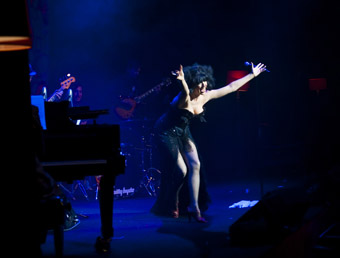
Meow Meow at Late Night Lounge, Sydney Opera House
photo Justin Malinowski
Meow Meow at Late Night Lounge, Sydney Opera House
meow meow: meow to the world
Meow Meow was in town, “back by her own demand”, with a return season of Meow to the World: Crisis is Born, a scabrous out-of-schedule Xmas celebration of the Global Financial Collapse. Compared with her other shows, where her high maintenance neediness (it’s still here) dominates, this Meow Meow is up there with Stephen Colbert of the Colbert Report, walking the satirical knife edge of simultaneously playing out and undercutting the kind of vicious selfishness that free market narcissism yields, not least during economic downturns. She provides the flowers for the audience to throw for her sumptuous, gorgeously frocked opening but then commences to savagely cost-cut, complaining (“Did anyone bring any atmos? Do I have to do everything!”; “No smoking? I might as well have brought an extra large Ventolin), stripping herself and her band of their clothes (“the Opera House cut the dry-cleaning budget”). She steals drinks and food from the audience (“Just looking for a cheese platter. The Opera House didn’t feed us”) and introduces three local youngsters (“the orphans—we ordered three”). These she then ruthlessly exploits, bullying them through “My Favorite Things” and “Silent Night” before propelling them into the audience to beg for money.
But there are more rewards than clever satire as dark songs like the Dresden Dolls’ “Missed ME” and Nick Cave’s Red Right Hand deepen the mood, while more buoyant classics, art house and popular, reflect the mood swings of our times. Meow Meow is in more than excellent voice, the band, led by New Yorker Lance Horne is top notch and I leave Meow to the World heartened that cabaret can still bite. Meow to the World: Crisis is Born premiered in New York in 2008 and won Best Cabaret in the Sydney Theatre Awards for 2009.
the folding wife
A very welcome Mobile States tour of The Folding Wife is taking this inventive and culturally idiosyncratic production to a wide audience. Jan Cornall’s review of the original production, “One woman in many: survival and resilience” (RT 79) says it all: “The audience is left with sensual impressions of lace and blood, laughter and sorrow, ‘roasted corn on Sundays, coloured parasols reflecting the white heat of the sun’ and a heritage of women, strong, beautiful and dignified, who have survived on memories of a glorious past or a projected future as they bent and folded into themselves a nation’s pain.” I recommend you read the whole review.
The particular power of The Folding Wife emanates from the construction of the work as a living installation—Valerie Berry (deftly playing the female generations of one family) is casually sculpted and adorned into shape by two on-stage artists using clothing, props and projections. It’s as if we are witnessing the forces of family, history, politics and culture (Filipino and then Australian) shaping a life which, in the end, refuses manipulation. Strong physical gestures (an Imelda Marcos shoes routine is a highlight), sensual, if sometimes alarmingly visceral screen images (we simultaneously witness their making), and lateral story-telling align with a poetic text to yield a curiously contemplative experience—of a work of art in more than a simply theatrical sense.
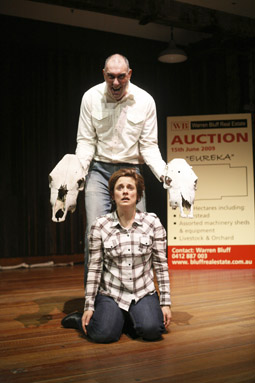
Stefo Nantsou, Lindy Sardelic, Burnt, Zeal Theatre
photo Tracey Schramm
Stefo Nantsou, Lindy Sardelic, Burnt, Zeal Theatre
burnt
To see the Zeal Theatre trio performing Burnt is to witness a company hard at work, as a very good band (whose instruments double as FX devices), amiable hosts and excellent actors, initially as a farming family rounding up sheep and then, virtuosically, adding a large number of other characters from a drought-stricken rural community. The story is sadly predictable if rooted in fact (the company had done on-the-ground research into growing poverty, probable loss of an inherited property, desperate measures, new multicultural pressures, family tensions and the potential for suicide) but is written with wicked wit and a touch of pathos and performed with remarkable precision—just the right amount of idiosyncratic personality touches and the capacity to shape the multitude of scenes like a team of adroit film editors. Other playwrights could learn much from them. This is bare bones theatre of the highest order—a few sheep and cattle skulls litter the stage with a car seat and an oil drum; the rest is embodied in these truly engaging performers.
fox
Writer Margaret Wild and illustrator Ron Brooks’ Fox is an award winning picture book for young people about a bushfire-injured magpie aided by a one-eyed dog. Their relationship is sundered when a fox promises more than the dog can offer. The book’s storytelling is very spare, while the opera version is theatrically and musically elaborate. An ever present soprano (her character otherwise undefined) is the only singer and delivers the narration (Sarah Jones has a fine voice but is at her best in lower registers where consonants remain intact) while three performers enact the animals, but in several and inevitably confusing modes—as actors, as puppeteers and in projections.
Unlike Red Leap’s adaptation of Shaun Tan’s The Arrival (RT95) which was for the most part faithful to the author’s aesthetic, this account of Fox further complicates things by gendering the scenario—the fox is a handsome, swaggering male seducer and magpie a helpless female, with their stylish costuming taking us a long way from the book’s plain, bush reality. While there are moments of evocative puppeteering, brisk action and a dash of comedy from the dog, each episode is framed by song in the operatic mode (not always immediately memorable) yielding longeurs that flatten the drama, despite director Kate Gaul’s inventiveness. There is some attractive writing from composer Daryl Wallis but it’s not integrally dramatic, dominating rather than serving the story. For bringing new opera to young audiences, Fox is to be admired, if in the process revealing the challenges of adaptation.
–
Sydney Dance Company, New Creations, Are We That We Are, choreography Adam Linder, dramaturgy Sally Schonfeldt, costumes Jordan Askill, lighting Nick Schlieper, sound Adam Synnott; Sydney Theatre, March 23-April 10; Hole in the Wall, concept, performance, design Matt Prest, Clare Britton, concept, director Hallie Shellam, text Halcyon Macleod, lighting design Mirabelle Wouters, concept, set Danny Egger, sound, animation James Brown; Performance Space, CarriageWorks, May 26-29; Meow Meow, Meow to the World: Crisis is Born, The Studio, Sydney Opera House, March 2-14; Urban Theatre Projects, The Folding Wife, performer Valerie Berry, writer Paschal Daantos Berry, director Deborah Pollard, design, multimedia Anino Shadowplay Collective, lighting Neil Simpson, Performing Lines for Mobile States; Performance Space, CarriageWorks, Sydney, May 19-22; Zeal Theatre, Burnt, writer-performers Tom Lycos, Stefo Nantsou, performer; Lindy Sardelic, director Stefo Nantsou, music Tom Lycos, Wharf 2, Sydney Theatre Company, May 25-28; Fox, Monkey Baa with Siren Theatre Co, director Kate Gaul, composer Daryl Wallis, performers David Buckley, Jay Gallagher, Sarah Jones, Jane Phegan, designer Gabriela Tylesova, lighting Designer Luiz Pampolha, Seymour Centre, Sydney, April 10-17
RealTime issue #97 June-July 2010 pg. 37
© Keith Gallasch; for permission to reproduce apply to realtime@realtimearts.net
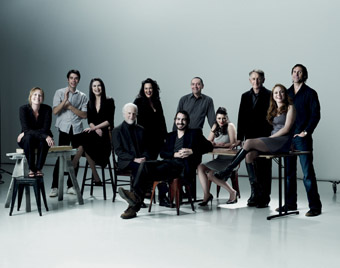
The Actors Company (2008)
photo Jason Capobianco
The Actors Company (2008)
JAMES WAITES’ PLATFORM PAPER, “WHATEVER HAPPENED TO THE STC ACTORS COMPANY?” IS A RARITY IN AUSTRALIAN WRITING ABOUT THE THEATRE. IF MORE LIKE INVESTIGATIVE JOURNALISM (WAS THE ENSEMBLE KILLED OFF?) THAN FORMAL ESSAYING (IF NOT WITHOUT CONSIDERED THESES) IT’S WRITTEN WITH A DOCUMENTARY MAKER’S ATTENTIVENESS TO HIS SUBJECTS (DRAWING ON NUMEROUS INTERVIEWS) AND A NOVELIST’S NARRATIVE DRIVE (WHO DID IT?). BUT WHAT GIVES THE PAPER ITS PECULIAR POWER IS WAITES AS WITNESS.
In a career that has included being an arts documentary script writer for ABC radio, a part-time lecturer in drama, research assistant to Rex Cramphorn, editor of Theatre Australia and, notably, reviewer for the National Times, Sydney Morning Herald and now on his own website (www,jameswaites.com), Waites has closely observed for over 30 years plays, careers and movements. In that time he has seen ensembles and other collaborative efforts (Australian Nouveau Theatre, Lighthouse, Gilgul, Keene/Taylor Project, Paris Theatre) come and go and has a clear understanding of their inherent complexities, of the differences between top-down and bottom-up models and of many a contemporary actor’s desire to be a collaborator—more than “a gun for hire.” The essay’s dynamic functions around these often binary complexities.
STC artistic director Robyn Nevin’s admirable desire was to create great acting opportunities of a kind difficult to achieve in the standard show by show theatre model. But is a large state theatre company the place to do it? Waites posits contradictions in Nevin’s handling of the ensemble, some circumstantial given the nature of the institution that housed it, others seemingly at odds with her own experience. As a young actor in the 70s Nevin had been part of the Performance Syndicate, an intensely collaborative ensemble directed by Rex Cramphorn. But, given her wider responsibilities for the STC, she could not lead the Actors Company nor act with it. Instead, after a failure to appoint a leader, three successive ‘managers’ were appointed for the ensemble. Waites writes, “This failure to find a ‘first among equals—should that read ‘to decide between democracy and autocracy?’ was to underpin many of the conflicts that lay ahead.”
A consistently top-down approach meant that seasons were programmed and plays cast without consulting actors, let alone discussions shared about direction and design. Some guest directors had never or only briefly seen the actors at work, and similar casting decisions were made from show to show. Even more critical, from the beginning there seems to have been no discussion between Nevin and the actors about precisely what their purpose was as an ensemble.
Nevin’s closest contact with the ensemble came with directing Mother Courage: “despite a major incident during rehearsals, by opening night [in May 2006]…everybody on stage looked good.” After several frustrating months the actors had arranged their own meeting and Nevin wandered into it—a tense encounter ensued: “[T]here is no avoiding the brutal fact that something terrible had happened that Easter Monday. It was not immediately apparent, but a wedge had been driven between Nevin and the actors. After so much work in getting the ensemble started, Nevin could not get over the feeling she had been profoundly betrayed. It seemed to her that she had given birth to a spider that ate its own mother.”
Waites reports that in interviews Nevin was “no less critical of herself” than he has been in his essay. Her belief that an ensemble forms and evolves through working together, not through talk, had proven problematic. Company spirits however were lifted by Barrie Kosky who, if “leading from the front”, offered “intense participation” in the creation of the epic, The Lost Echo. Waites praises Nevin: “Few in Australia had given Kosky this kind of unflinching support.”
Casting of a fixed number of players (Waites calls it the Holy 12) proved to be problematic. Kosky would have liked two senior female actors in the ensemble, Benedict Andrews a range of guest performers to keep the situation fluid. But in 2007 Andrews’ production of Patrick White’s The Season at Sarsaparilla, showed that fixed numbers and gender constraints “can occasionally produce an unexpectedly successful result.” Again the ensemble was working with an auteur, and on a complete version of the set from the first day of rehearsals. Responding to Andrews’ very precise demands, “individuals felt it safe to take risks. They would try things they would never have dared try in a one-off production.” As with The Lost Echo, the combination of auteur and ensemble appears in Waites’ essay as a fruitful model, although with provisos introduced by the company’s more complicated experience with Andrews on War of the Roses, dealt with later in the essay by Waites.
Waites’ praise for The Season at Sarsaparilla is considerable, especially if we think about it in terms of STC’s exports to New York—Hedda Gabler, A Streetcar Named Desire. “If there was ever an Australian production that deserved to be seen by the rest of the world, it was [The Season at Sarsaparilla]. For me in my 30 years of following and writing about the making of Australian theatre, this production represents, both culturally and creatively, the highest point. An onstage Everest.” This one show alone makes Waites grateful for the existence of the Actors Company.
Difficult times followed: problems with directors, serious arguments, resignations, illness. But the work kept being made and the pressures of back to back productions alleviated. Waites’ deftly sketches ensemble members: Pamela Rabe as the “nurturing ‘wolf mother’”, the experienced, inspiring older men, the ‘malcontents’ (a complex picture) and offering glimpses of other members. Rabe’s direction of Daniel Keene’s Citizens (with Tim Maddock directing Soldiers in the other half of the double bill, The Serpent’s Teeth) appears to have been a relief for the company, being directed by one of their own and in terms of their own working method.
So why didn’t the Actors Company survive beyond three of its projected five years? The new artistic directors, Andrew Upton and Cate Blanchett thought it financially unsustainable, but even if they had the money they had reservations, “we thought it was too sacred.” Like some others, Pamela Rabe, for whom working as part of the ensemble had been “the most important and electric experience of my professional life,” was left with a sense of unfinished business.
Waites ends his paper with core lessons “any state theatre company would do well to heed if it set up an ensemble within a broader company framework.” He doesn’t say they shouldn’t do it, although the essay points towards very likely intractable institutional problems.
First, he recommends stable leadership that will provide assurance and continuity. Within this framework, guest directors need to fit “the ensemble’s over-arching goals.” These, of course, are the first things that need to be established. Presumably Waites would want the role of the actors clarified—what kind of ensemble will they be getting themselves into, what precisely will be their creative contribution? Secondly, he argues for more flexible ensemble numbers—although he doesn’t address how this might affect the very sense of ensemble that comes from familiarity and continuity. Thirdly he recommends alternative activities for ensemble members—regular skills classes, small-scale experimental works: “opportunities to explore ‘simplicity’ and ‘intimacy’” as opposed to constant involvement with “juggernauts.” To do this he might have added directing opportunities given his what-if support for Rabe as potential Actors Company leader (a huge challenge, mind you, for a beginner director).
By the time of the War of the Roses, the Actors Company was far from its original self, featuring guest performers including Cate Blanchett and only small roles for some long term members, but there was just enough of a rewarding sense of continuity, not least evident in a scale of vision rarely seen in this country, expertly inhabited and realised by its actors. Perhaps what we witnessed over the years was in fact a directors theatre enabled by a variably willing ensemble. Without doubt the supreme performances of the three years were seen in the productions by Kosky and Andrews, who each, at different points in the essay, wonder about the role of the director—Kosky about an inherent Australian resistance to the strong director and Andrews about the best work coming from strong leadership. The degree of creative freedom an actor has within an ensemble led by an auteur is likely to vary as enormously as the differences between auteurs. Some are more authoritarian or democratic than others—but, essentially, the vision is the director’s. Other kinds of ensemble, not part of larger institutions, are about creative power sharing—the director’s vision is important, critical even, but subject to creative cooperation, even compromise. The Actors Company is a very particular case, whereas in Lighthouse, say, under Jim Sharman, the ensemble was the company, not one company inside another, but the lessons can still apply.
Waite’s essay is eminently readable, the writing relaxed and evocative, the tone aptly personal as he draws on his considerable experience of theatre and his judgments for the most part are fair and considered. Occasionally the writing is calculatedly dramatic, tipping into hyperbole, making the reader wary: “…the lines of communication were simply not as open and flowing as they needed to be. Sadly, it was this that triggered the descent into the maelstrom that occurred over the course of the next two productions and left the Holy 12 permanently damaged.” This kind of narrative forecasting is also not uncommon, if adding a certain novel-ish suspensefulness.
Like much else in Australian theatre history the Actors Company is unlikely to be documented anywhere else soon, so this perceptive, intimate essay is more than welcome as a critical homage, a tribute to a partly successful, sometimes highly significant venture into too rare a form in this country, the ensemble.
James Waites, Whatever Happened to the STC Actors Company?, Platform Paper No 23, Currency House, Sydney, April 2010
RealTime issue #97 June-July 2010 pg. 38
© Keith Gallasch; for permission to reproduce apply to realtime@realtimearts.net
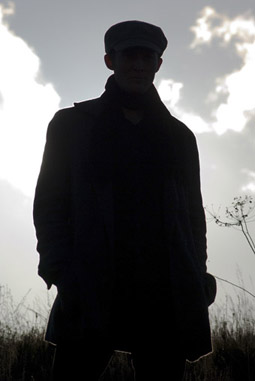
Lawrence English
photo Pawel Kulczynski
Lawrence English
WHEN I ARRIVE AT THE HOME OF LAWRENCE ENGLISH, THE PLACE IS LITERALLY PULSING WITH THE DRONE OF A FLOOR SANDER GRINDING BACK THE FRONT ROOM FLOORBOARDS. THE DEAFENING DIN MIGHT SEEM A WEIRD INTRODUCTION TO AN ARTIST KNOWN MORE FOR SUBTLE SONIC MINIMALISM, BUT FOR ME IT SERVES AS A REMINDER OF THE TIME WHEN I FIRST ENCOUNTERED ENGLISH, BACK IN THE STRANGE DARK ERA OF 1990S INDUSTRIAL MUSIC IN BRISBANE. SINCE THEN HE HAS GONE ON TO BECOME ONE OF AUSTRALIA’S KEY MEDIA ARTISTS, AND, THOUGH HIS CURATORIAL AND CREATIVE ACTIVITIES TAKE PLACE ACROSS THE GLOBE, HE CONTINUES TO MAKE BRISBANE HIS BASE.
room 40 origins
English’s sound work explores environmental and musical sources and is highly regarded for its intelligent invocation of perception, memory and space. He also curates the ROOM40 imprint, which has consistently issued an impressive array of sound-art related activities and events. ROOM40 is celebrating its 10th year, so I talked with English about the label and his thoughts about how this last momentous decade unfolded. He explained, “ROOM40 came about as a sort of umbrella organisation. I thought of it having the publishing arm, the curatorial/gallery/installation project-oriented arm and then the concert/festival part of it, with them coming together under that banner with some kind of focus. So people could have an idea of what they were going to experience or at least think, ‘I’ve gone to two other events or I’ve bought two CDs so I’ll take a risk with this one even though I don’t know who that artist is.’ In some ways it has been a process of building up that trust.”
tape trading
I ask English about his history in music distribution and he tells me about how it all started with cassette tape trading: “I got my first PO Box when I was 15, because my parents got sick of packages turning up at the house, and I was kind of paranoid about them not turning up—they were always oversized and never fit in the letterbox. In fact we only closed that PO Box this year…it felt like a real cutting off. You should have seen the lady at the post office when I went to close it, I was like, ‘I’m really sorry, I’m going to have to close this box now.’ She was really upset…Tape trading was a fundamental part of how I got into music. You’d basically send off a bunch of stuff, and cross your fingers a package was on its way to you…What’s so interesting now if you want something, even something that’s out of print, you type it into Google, or iTunes, or whatever, and it’s there, and you download it, and you’ve got it in 10 minutes. I remember, when you started reading about a band, first you had to find the person with the demo tape, trade with that person…it could be a process of like 18 months before you finally heard the band! You’d built up so much anticipation by then. But when you finally got it…you’d spent so much time invested in it, and it was so great finally getting to hear that music and say, ‘Oh these guys, they sound so amazing!’”
becoming a label
On the animating forces behind becoming a label, English nominates “the satisfaction of getting people’s work out there. Every single record we’ve put out, I can say, 100%, I have a very deep respect for. They’re essentially giving you their child, their artistic first-born, saying “Here, can you deliver this to the right ears?” English explained how he tried to express this responsibility in the creation of ROOM40’s aesthetic, which is “not necessarily a sonic aesthetic—it’s an aesthetic of the label, involving non-standardised packaging and attention to the overall presentation.” Though creating a catalogue wasn’t on his mind when he started out, “When you look at it now, 10 years later, it looks like a catalogue.”
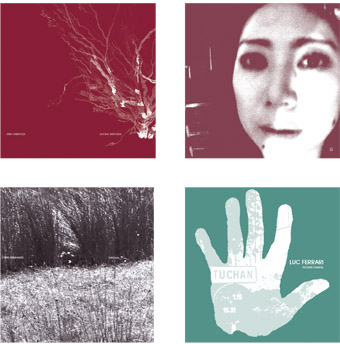
ROOM40 covers, clockwise from top left – Erik Griswold – Altona Sketches , Tujiko Noriko/Lawrence English/John Chantler – U, Luc Ferrari – Tuchan Chantal, Chris Abrahams – Thrown
archival life
The archival aspect of ROOM40 “has always been a big part of it” according to English, “because, in traditional music circles, in six months’ time an album’s irrelevant. Ideally what I wanted to do was have an album where you could come to it in five or 10 years and still have an engaging and meaningful experience.” He gives the example of Melbourne artist Rod Cooper’s 2006 Friction album: “it’s still current, it still makes sense, it’s still a total summary of part of the work he’s done.”
filling a brisbane gap
We discussed how ROOM40 differs from a traditional music label, and how it evolved organically. “Obviously, being [in Brisbane] in the 1990s, there wasn’t a whole lot going on. There was Small Black Box [an exploratory music series] and that was it. There wasn’t a lot of opportunity for international artists to come here. A lot of people skipped Brisbane. Even What is Music? didn’t come to Brisbane until like 2003…That has really only changed in probably the last 10 years. There was a big gap up here.
“So that was the motivation behind the Fabrique series at the Powerhouse (40 events over eight years), to try to build up the audience. I always felt frustrated at the way events featuring experimental music felt a bit…exclusive. I just didn’t agree with that. As far as I was concerned, you could be into pop music, and that wouldn’t matter; you’d come to one of these events and, if it was articulated to you in the right way, you’d give it a try and maybe like it, maybe not, but at least you had the experience. I was definitely not part of the scene, because I was interested in a lot of other things as well, like punk rock and hip hop. I thought “I love experimental music…if I can come to it, surely other people can. And obviously that happened, look at the way things have developed in Brisbane. Take Audiopollen (the weekly underground music club 2007-2009) for example. You can see that the audience has grown massively.”
As part of the ongoing conversation with that growing audience, this year also sees the fifth anniversary of Open Frame, ROOM40’s annual festival (Brisbane Powerhouse, Oct 6-7), which this year will also present an event in London in November. Legacy projects involve the reissuing of some of the label’s albums on vinyl, such as Ben Frost’s classic Steelwound (2003) and Chris Abrahams’ Thrown (2005). There are other interesting plans afoot.
a guide to site-listening
English explains that ROOM40 is to release its first book through the label, a site listening guide—“Rather than sight-seeing, I’m asking people to site-listen.” The book’s introduction promises not “an exhaustive list of listening locations around Brisbane,” but rather, an offer of “possible encounters, personal reflections and suggestions as to what sounds might be worth listening out for in this city.” It’s easy to see how this publication, with its “open-ended invitation to listen to the spaces you might find yourself in,” has evolved naturally out of both the artist’s creative explorations of sonic environments, along with ROOM40’s ear-opening agenda. As Lawrence English explains, “it’s about privileging the ears over the eyes.”
http://www.room40.org
RealTime issue #97 June-July 2010 pg. 39
© Danni Zuvela; for permission to reproduce apply to realtime@realtimearts.net
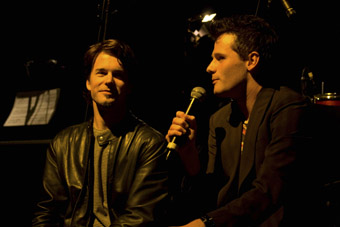
Alex Pozniak, Andrew Batt-Rawden
photo Emily Sandrussi
Alex Pozniak, Andrew Batt-Rawden
BEING MORE THAN AN EMERGING CONTEMPORARY MUSIC ENSEMBLE, CHRONOLOGY ARTS IS COMMITTED TO BUILDING NEW MODELS FOR PERFORMANCE, FUNDRAISING AND COMMISSIONING. HAVING BEEN IMPRESSED BY TWO OF THE ENSEMBLE’S ‘GENRE-BUSTING’ CONCERTS, ONE OF THEM IN THE RECENT ISCM WORLD NEW MUSIC DAYS FESTIVAL, I MET WITH DIRECTORS ALEX POZNIAK AND ANDREW BATT-RAWDEN, WHO ARE BOTH IN THEIR 20S AND BOTH COMPOSERS, TO LEARN WHAT STRATEGIES THEY WERE EMPLOYING IN MEETING THE CHALLENGES OF SUSTAINABILITY FOR ‘CONTEMPORARY CLASSICAL’ MUSIC.
The ‘genre-busting’ tag became a running gag in our meeting. Recently the pair had been advised that if they wanted arts funding, that’s what they’d have to be—genre-busting. From what I’ve experienced of their work, they already are. In Gradations of Light, large video projections synced with performances, musicians moved though the audience and three electric guitars powered Pozniak’s Illuminations (www.realtimearts.net/article/92/9553). “We’ll just have to be more genre-busting,” Pozniak says.
Chronology Arts has quickly carved out a niche. Batt-Rawden says that “since the Seymour Group died” Ensemble Offspring, with its contemporary compositions and invaluable forays back across 20th-century musical movements, have occupied centre-stage, “but we concentrate on getting the really new, new music” with which to attract audiences and donors.
While Pozniak and Batt-Rawden see arts funding as part of Chronology’s future, they’re working hard at finding alternative income sources and Batt-Rawden has already had some success. Early concerts relied on ticket sales, small payments to musicians (these have grown, they say), one-off composition grants for contemporary works from the Sydney Conservatorium of Music (“really designed for groups like us”) and, significantly, private philanthropy. Batt-Rawden says that Chronology Arts has been quite reliant on a few key donors giving from $2,000 to $5,000 each. Other strategies are event-based, like private performances or an art auction expected to raise $20,000. In June, Chronology Arts is holding a private dinner in a restaurant for its supporters at $200 head with three small installations plus selected food, wine and music—”which we’re composing right now!” The diners will be current and potential commissioners. It’s ironic, jokes Pozniak, “contemporary music is not usually seen as aiding digestion.”
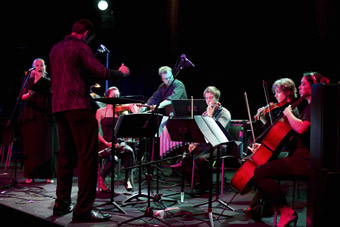
Chronology Arts, In Focus, 2009
photo Emily Sandrussi
Chronology Arts, In Focus, 2009
Batt-Rawden’s energies are currently focused, among other things, on the Commissioner’s Circle, which he describes as “a unique marketing concept to promote the concerts as well as raise funds for composers.” How does he find the potential commissioners? “Networks are very important,” he replies, “and chance—I talked to someone about the idea after a concert and they offered me a cheque.” He adds with a grin that “the real secret is home-made pasta dinners” for prospective donors. Previous fundraising experience, including with Song Company, has clearly given Batt-Rawden the confidence to push ahead in an area which might make many young artists wary. But structure helps: the group’s Commissioner’s Circle gatherings bring together composers and donors as potential partners.
I ask if people who become commissioners are likely to repeat the experience, as they do, say, in the visual arts. “It’s the whole idea,” says Batt-Rawden, “A commission is a long-standing relationship.” For that reason he wants a younger generation to take on the commissioning role and provide long-term continuity: “Perhaps we’ll have to call them non-executive producers,” he quips, alert perhaps to the need to find a seductive contemporary label.
As composers themselves and with empathy for others grounded in their own experiences, how do Pozniak and Batt-Rawden fare with commissions? “My first one was $50 a minute for a string quartet,” recalls Batt-Rawden. “I’m at the lower end, with the price gradually rising.” “It’s half paid, half unpaid,” says Pozniak, “which I don’t expect to change any time soon, especially with Chronology Arts [Laughs]. A Melbourne Symphony Orchestra development project had a fee, not a great one, but it was to write for an orchestra! If in 2012 I could make $10,000 for three works, that would be good; the equivalent of a day’s work a week. I write four or five pieces a year and, to survive, teach at Sydney University, the Conservatorium High School and McDonald College. And now I’m being paid by Chronology Arts. But Andrew does more work while I’ve been busy composing.”
Although Batt-Rawden is on a “part-time wage for 70 hours a week” with Chronology Arts, he clearly relishes his role: “I see fund-raising as just like sales with targets and deadlines and a strategic approach. We’re not begging artists.”
As for their group’s investment in their concerts, Pozniak explains that “some are more extravagant in terms of the number of performers involved and what the incidentals are in terms of lighting and cross-artform components. So if we get worried about money we’ll tone down the instrumentation.” Batt-Rawden adds that “each event costs $5,000 to $15,000, with a lot of in-kind support and not a lot of money in advance—we have to foster relationships early so come crunch time donors are already committed.”
We come back to the issue of how to seek out commissioners. Batt-Rawden emphasises that “Commissioner’s Circle is not just for Chronology Arts. We’re interested in securing commissions for, say, Song Company and very interested in ‘genre-busting’ cross-artform temporal art commissions that don’t only involve composers.” Pozniak points to a problem and its solution: “A lot of people don’t check out new classical music concerts because of the outmoded format, so we bring in other elements to make the performances more appealing, potentially securing another audience that’s supportive of other art forms.” Batt-Rawden declares, “We’re market-conscious artists!” Pozniak says, “We have to respond to tech advances or we’re not current, but there are ways of being current and genre-busting without selling out. We’re opening our minds laterally to assimilate what’s out there.”
I ask how supportive Chronology Arts finds Sydney. Pozniak thinks that “being youngish we’re a kind of link between the Con and Sydney Uni—the opportunities they offer—and the world outside. But we had to build our own support. Just because you’ve graduated, Ensemble Offspring aren’t going to commission you. We wanted to create opportunities for ourselves but also for performers and composers at the Con with a lot of potential, if they want to tap into the contemporary thing. Mostly they don’t, but it’s curious, the second-years I teach are very proactive. They look up to what we’re doing, we talk aesthetics and composition and they’re fired up and they do their own things. We’re catering for graduates. We’ll also host a concert of undergrad works in Sydney Uni’s Verge Arts Festival. It’s a kind of mentoring.” Batt-Rawden agrees, “Sydney’s great at monuments but who’s looking after the small fry and the estuaries where the arts really develop? It’ll become easier for emerging artists when we get smarter at marketing and networking and philanthropy and online delivery.”
Shortly after our meeting it was announced that Chronology Arts had been awarded a Sydney City Council partnered Arts Bunker residency at Sydney University’s Seymour Centre, a two-year program with office space and “mentoring in all areas of arts management.”
Forthcoming Chronology Arts concerts include the remarkable pianist Zubin Kanga in Piano Inside/Out Verbrugghen Hall, Sydney Conservatorium of Music, July 2, in a program including works by Liza Lim and Drew Crawford. On July 28 Kanga will join another Australian ‘international’, soprano Jane Sheldon, in Chiaroscuro featuring Apparitions by George Crumb and Sonetos del amor Oscuro by Rosalind Page. Pozniak is looking forward to a September 15 concert featuring Chronology’s core ensemble (flute, Jane Duncan; cello Eleanor Betts; saxophone Andrew Smith; clarinet Toby Armstrong; viola Luke Spicer; and piano Jacob Abela, with conductor Geoff Gartner) and compositions by Pozniak and Batt-Rawden and others, a reminder, he says, that despite the large scale of some of their concerts “we are an ensemble.” It’s an ensemble with a distinctive vision, one that can only strengthen Sydney’s fragile new music ecology.
www.chronologyarts.net
RealTime issue #97 June-July 2010 pg. 40
© Keith Gallasch; for permission to reproduce apply to realtime@realtimearts.net
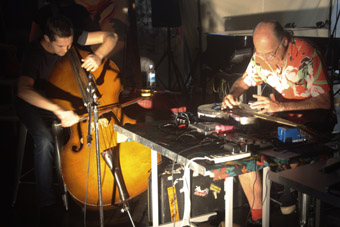
Mike Majkowski, Mike Cooper, See Hear Now
photo Glen O’Malley
Mike Majkowski, Mike Cooper, See Hear Now
WHILE IMPROVISATION IS NOT A FAVOURITE OF MINE, THERE WERE ENOUGH MOMENTS DURING THE MUSIC CENTRE NORTH QUEENSLAND’S SEE HEAR NOW MUSIC-DRIVEN, MULTI-ARTFORM FESTIVAL WHEN ARTISTS AND THEIR MEDIA ‘CLICKED’ BEAUTIFULLY AND THE JOY OF THE ARTFORM CAME ALIVE. ANY RESERVATIONS I HAD WERE MAINLY TO DO WITH THE ‘ART’ OF COLLABORATION SO ESSENTIAL IN IMPROVISATION—WOULD ARTISTS REALLY LISTEN TO EACH OTHER; USE SPACE AND SILENCE AND TIMING TO INTERPRET WHAT WAS BEING SAID; AND ADD TO THE MOMENT RATHER THAN SIMPLY CREATE PARALLEL OR EVEN UNRELATED PATHS?
My reservations however were not shared by the audience. Right from opening night there was an air of excitement and expectation at what might eventuate. Although music-driven, each concert included a component of conventional visual arts, film, photography or projection plus movement or dance or theatre. Performers flown in for the weekend were all involved in music technology in some way: Mike Cooper, slide guitar; Grayson Cooke, live audio-visuals; Rod Cooper, original instruments; Mike Majkowski, bass; and Erik Griswold, prepared piano.
The most satisfying collaborations were those involving Gold Coast-based performance poet Jayne F Keane. Her theatrical skills supported entertaining narratives, at times pithy or poignant. When her collaborators entered her space, the improvisations came alive.
Keane and technologist/composer Steven Campbell presented the most polished improvisation of the festival, They Say Drowning Is Like a Dream. The result of an ongoing collaboration, it is perhaps unfair to single out this work given the scaffolding that time and familiarity brings. They Say Drowning…was well paced and the media (poetry and sound bytes) worked well together, creating a whole that was more powerful for its pace, cohesion and sense of purpose.
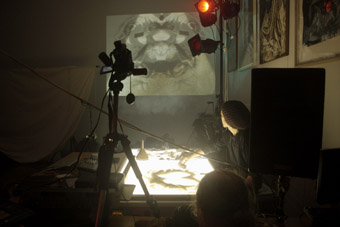
Tom Jefferson, See Hear Now
photo Glen O’Malley
Tom Jefferson, See Hear Now
Visual artists at the festival seemed largely impervious to what was going on around them, and even some musicians and dancers whose art forms are rooted in sound, space and silence appeared to lack the ability to work with co-performers. An interesting performance where more space would have enhanced the work involved a mandala created by emerging artist Tom Jefferson, drawing in sand on a light box. The patterns were projected on a wall, and then processed through an effects box by lighting expert Mark Bancroft. Initially the kaleidoscope-like shifts lifted the action, giving it another dimension. However, too many changes and gradually too many effects weakened the impact, leaving no space to savour or even retain a connection with the physical performers. The projections became a distraction rather than a complement to the whole.
Where there was a discernible connection between performers, the results were exciting. Percussionist Ian Brunskill played with exceptional intelligence in the work Frock, using a huge array of percussion sparingly and to good effect. At the climax of this seven-part improvisation, built around Keane’s poetry and readings from 18th-century newspapers, Brunskill smashed sheets of glass and china plates. Keane followed up with a constrained poem where she lined up beer bottles as a sign of aging and loss. Theatre practitioner Mark Reed was outstanding as a sinister figure while Mike Cooper joined in with an inspired musical commentary on both Reed’s characterisation and Keane’s poetry, again with intelligence and insight, slipping layers of slide guitar riffs and motifs into the improvisation space.
The festival’s visual arts curators, Sue Tilley and Selena Smith, engaged imaginatively in many of the collaborations, notably in the opening piece, The Chance in Bowing, with Griswold, Majkowski and Cooper. They occupied the space almost as fully as the dancers (Manu Reynaud and Rebecca Forde), splashing paint across, under and around a veil of fabric stretching from one end to the other. In Frock, Tilley, Smith and Alison McDonald created an ‘haute couture’ outfit on a live model using sheet music.
Festival director Michael Whiticker’s City Debris opened powerfully with Griswold’s performance on prepared piano both arresting and inviting. Whiticker played with samples and live percussion while Cooper coaxed some wonderful sounds from a hurdy-gurdy-like banjo invention which had two necks and various protruding pieces which he bowed, plucked, hit or scraped. Artists Therese Duff, Alison McDonald and Michele Deveze painted “an abstract of light and shade” using crayon and black paint on a long length of off-white cloth wound around movement artists Thalia Klonis and Caitlin Whiticker. Again this was an intelligent improvisation, the movement artists measured and understated and—unlike some others—not preoccupied with being centrestage or dance-like. The relationship between sound and movement was discernible but it was not until the daubing of the visual artists on the cloth became part of the movement that the whole work gelled, ebbing and flowing organically.
A breathtaking bass solo by Mike Majkowski, originally a jazz player, was the result of his teaming up with Grayson Cooke who used “an audio-reactive patch to create live, abstract ‘visual music’ triggered entirely by Majkowski’s bass playing” (program notes). The visual content for this performance played second fiddle to the bassist’s virtuosity which held everyone rapt. Majkowski bowed, plucked, struck and scratched all over the instrument, using tools such as wooden chopsticks, pegs and other implements to explore sound and silence. It was a very impressive performance, deserving of the long appreciative silence from the audience before they applauded.
In Trystero System (explained on the web as a loose grouping of musicians dedicated to free improvisation over dance beats of some kind), Grayson Cooke teamed with Mike Cooper to present an improvisation of processed slide guitar sounds and “deconstructed jungle beats.” Cooke’s work appeared to be political: his images, projected through a matrox box across multiple screens, featured Japanese anime dolls in skimpy outfits with fly-eye sunglasses and botoxed lips —a comment perhaps on the cruelty of popular culture and stereotype distortions, with Cooper’s Hawaiian guitar reinforcing the allusion. To the side of the performance area fibre artist Michelle Hall quietly created an incongruous ‘soft sculpture’ accompaniment, unravelling spools of thread of different colours and weights which fell like lace on the ground. She then wound the threads ever more tightly around screen legs and other bits of furniture and would have continued, in her own world, except that everyone else had finished. Trystero System’s symbolism proved thoroughly provocative and intriguing.
Unrecognised and unrewarded by funding bodies, Music Centre North Queensland is struggling to survive on ever-diminishing operational finances, so this exceptional festival could well prove the bitter maxim that art still flourishes under adversity. It is a tribute to the passion of the two part-time staff who run the centre and organised the festival, that such a host of interesting and challenging artistic events were gathered under one banner. If and when funding dries up, regional Queensland and avant garde art practitioners will possibly lose a very rich and significant cultural resource.
Music Centre North Queensland, See Hear Now; School of Creative Arts, James Cook University, Townsville, April 16-18
RealTime issue #97 June-July 2010 pg. 42
© Justine Wilkinson; for permission to reproduce apply to realtime@realtimearts.net
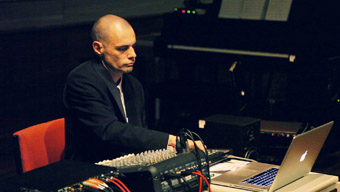
Malcolm Riddoch, Decibel, Still and Moving Lines
photo Gemma Pike
Malcolm Riddoch, Decibel, Still and Moving Lines
PERTH AUDIENCES LIKE TO THINK OF THEMSELVES AS UNBEARABLY ISOLATED, SO WHEN LOCAL ENSEMBLE DECIBEL DECIDED TO PERFORM THE COMPOSITIONS OF ONE OF THE CANONICAL FIGURES OF EXPERIMENTAL MUSIC, ALVIN LUCIER, THEY ATTRACTED A GOOD CROWD. LUCIER WAS A GOOD CHOICE FOR THE FIRST OF DECIBEL’S COMPOSER SERIES IN THIS REMOTE CAPITAL, BECAUSE HIS WORK LENDS ITSELF TO THINKING ABOUT WHERE YOU ARE IN BOTH SPACE AND TIME.
After the lateral philosophies of the late New York school, Lucier deconstructs the usual arrangement of composers, performers, listeners and sounds. It is as if his pieces are more realised than interpreted, demonstrated than performed, as sine wave oscillators collide with clarinets, voices echo into nothingness and a Beatles melody is played through a teapot.
Nothing illustrates Lucier’s special place in the history of the acoustic arts more than the first piece performed here, Shelter (1967). Malcom Riddoch manipulated the difference between sounds that could be heard through the venue’s walls and their amplification inside, picked up by contact microphones placed around the building. As one sound mirrored another, the walls seem to dissolve in the mix. What Lucier has designed here, through the slight phase change between outside and inside, is a way for an audience to become aware of how our ears construct the spaces around us, and Riddoch’s achievement is to orchestrate the resonance of these spaces. Lucier’s pieces realise the simplicity of sound’s presence, beyond the range of the home stereo, bringing to his work a quality as timeless as the idea of the room itself.
So in the classic I am Sitting in a Room (1970), the sound of a recorded voice is played back and recorded again and again, until the recording is muffled by its own resonating, spatial echoes. Here the former West Australian newsreader Peter Holland came out of his ABC studio to bring the piece a particular resonance for its local audience, his familiar voice becoming unfamiliar as it diffracted into space. In these early pieces the room itself is an instrument, while later Lucier works turn to the sine wave oscillator as an instrument, combining it with the clarinet, flute, saxophone and piano to investigate tonal relationships. Decibel’s program was largely made up of these later works, in which the appearance of classical instruments alongside the purity of an electronically generated pitch rendered them grotesque, the human breath a distorted and messy medium with which to investigate the greater goals of Lucier’s spatial sounds.
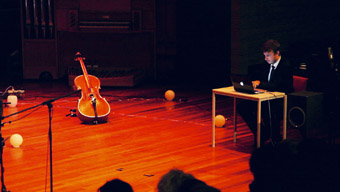
Tristan Parr, Decibel, Still and Moving Lines
photo Gemma Pike
Tristan Parr, Decibel, Still and Moving Lines
In Memoriam Stuart Marshall (1993) sets a clarinet against an oscillator, and demands that the instrument match its pitch. Here clarinet player Lindsay Vickery struggled for some minutes to engage with the precise sound of the oscillator before meeting it with his own. As if in a colossal battle between human and machine, Vickery’s breath came to create a series of sound effects that produced negative images in the oscillations, outlining resonant frequencies that sought out an exact spatial collusion. The performance became nothing short of sensational, as the ear attended to magical shifts of pitch, tone and even rhythm that appeared as pulsing shapes shifting from one side of the room to the other. Vickery’s triumph came at a price, however, as his sweating brow revealed the frailty of the human instrument system of sound production against the cleaner, digital sound source. Lucier’s simplicity, his attendance to singular effects, appeared to edge this archaic instrument into obsolescence.
Lucier’s pieces may be better conceived as scientific experiments or works of conceptual art than as music in a compositional sense. So his commissioned Beatles cover, Nothing is Real (Strawberry Fields Forever; 1990), is here performed on piano by Stuart James and played back through a teapot, its lid lifted and replaced, as per Lucier’s instructions, by Decibel’s director Cat Hope. We are no longer listening to the famous melody, but instead to its duration and spatial presence: in Directions of Sound from the Bridge (1978), James altered an electronic tone played from a cello’s bridge to show how the shape of the instrument changes the way this tone is distributed around the space. Lights placed around the room brightened and dimmed according to the changing pitch and the cello’s sound shadow. Thus Perth was treated to a lesson in acoustic phenomena, an interrogation of the conservatism of the concert format, and an ecstatic experience of sound at its most sparse.
Decibel, Still and Moving Lines: The Music of Alvin Lucier; Western Australian Academy of Performing Arts, Perth, May 13; http://decibel.waapamusic.com
RealTime issue #97 June-July 2010 pg. 43
© Darren Jorgensen; for permission to reproduce apply to realtime@realtimearts.net
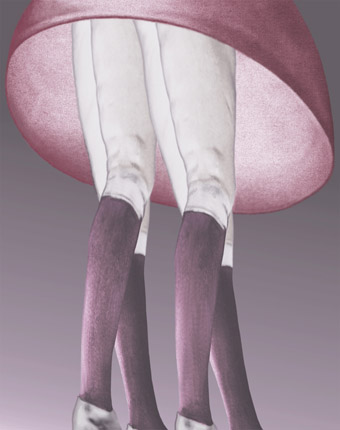
Pat Brassington, Twins, 2001, series Gentle, Fotofreo
courtesy the artist and Stills Gallery
Pat Brassington, Twins, 2001, series Gentle, Fotofreo
PHOTOGRAPHY IS ABLE TO EMBRACE A VARIETY OF GENRES AND PRACTICES. FROM JOURNALISM AND DOCUMENTARY TO THE CONCEPTUAL AND PERFORMING ARTS, FROM THE SENTIMENT OF PRIVATE PHOTOGRAPHS TO THE MASS SPECTACLES OF MEDIA AND MARKETING, IT TRAVERSES VERY DIFFERENT MEANINGS. SHOWING SOME OF THESE MEANINGS HAS BEEN THE MISSION OF THE BIENNIAL FOTOFREO FESTIVAL, FOREGROUNDING BOTH THE DIVERSITY AND UNITY OF THE MEDIUM.
The effect of its many shows in many venues is to confuse the easy categories with which we are used to classifying photographic images, so that the conceptual begins to look like documentary and vice versa. Two black-and-white exhibitions on this year’s program highlight this category confusion. One is from Tasmanian photographer Ricky Maynard and the other shows John Joseph Dwyer’s meticulous images of Kalgoorlie from the beginning of the 20th century.
At first glance, there is nothing much to see in Maynard’s show, touring from the Museum of Contemporary Art in Sydney. Portraits of Tasmanian Aboriginal people sit alongside various landscapes of the region. What brings the show to life is the information that accompanies the photographs. An image of a tree and surrounding bush is called Traitor (2007), and Maynard tells us that it marks the spot where Tasmanian chief Manalargenna made an agreement for his people to stay on the islands of Bass Strait. They were to die there, never to return to their homelands. The photograph now bears the weight of a violent history, and one’s attention is drawn to its meticulous framing and careful exposure, to the grain of the tree and tone of the shadows. In Healing Garden (2005), an image of a fenced-in garden of trees sits on a flat empty plain. Maynard writes that this surreal site is where a massacre took place. The haunting of Tasmania appears to bleed through the image, as Maynard brings his documentary mode of photography to life with conceptual information.
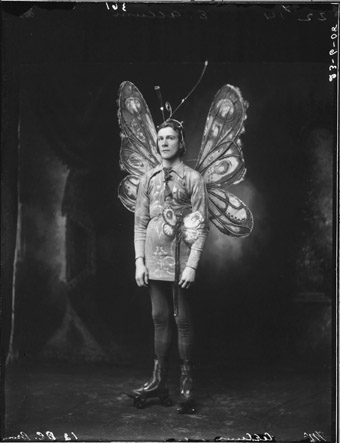
John Joseph Dwyer, Untitled (Mr Allum), 23 June 1908
image courtesy Western Australian Museum
John Joseph Dwyer, Untitled (Mr Allum), 23 June 1908
Different sorts of revelations take place in Dwyer’s images of the mining town of Kalgoorlie during its boom years early in the 20th century. They show some of the quaint customs of its residents, pictured in fancy dress, as well as the architecture of the city and mines that surround it. Dwyer’s work is of retrospective interest not so much for its subjects but for its photographic style. While we are accustomed to thinking of the documentary image as something of an objective record, here the perspective of Dwyer’s images anticipate the American and British periods of social realist photography in the 1920s and 30s. They are framed to give their subjects, whether people, buildings or mines, a sense of grandeur. Time allows us to see Dwyer as an artist rather than as a simple chronicler of his times.
Conceptual photographers are very aware of these kinds of paradoxes, in which the angle of the lens is warped by one’s own historical gaze. We live in an era that is overheated by imagery, in which we tend to look through photographs rather than at them. Narelle Autio brings the invisible to the fore as she packs the walls of the Fremantle Maritime Museum with photographs of flotsam and jetsam recovered from her local, South Australian beach. Collections of crab claws and coral remains are arranged in great optical patterns from floor to ceiling and photographed against a uniform white background. Lonely shoes and gloves clogged by oceanic detritus and sand appear like stains on the purity of this colour. Images of old lighters, fireworks, matches, dolls, underwear, bottles, coconuts, goggles, glasses, knives, starfish, stingrays, birds and seaweed speak of a collector who can’t leave anything out. The obsessive quality of the show contains both an intimacy and a careful objectivity, Autio handling her throwaway materials with care.
In the last FotoFreo in 2008 there was a serious absence of female photographers in the major exhibitions, but this time the gender numbers are near even. Pat Brassington’s moody composite photographs could have been taken straight from a French surrealism magazine. Her renderings of torsos, tongues and limbs in pink, brown and orange exposures have the mark of a suburban imagination gone strange. Legs suspended between floral pillows and blind mermaids sit alongside one another in an assemblage of dreamy softness. Two series of photographs, one from the 1980s and another more contemporary, share a series of motifs. The corners of rooms, blinds and curtains turn conventional spaces and objects into the haunting material of dreams.
It is difficult not to compare 2010’s FotoFreo with its blockbuster precedent in 2008. There are fewer featured shows this time, and fewer international and national names. In 2008 Edward Burtynsky’s commission to take large scale photographs of West Australian mines provoked much local discussion, as did a series of standout international shows by Roger Ballen, Chen Nong, Adam Broomberg and Oliver Chardin. It also gave locals a chance to see interstate photographers Brook Andrew, Marian Drew, Polixeni Papapetrou and Darren Siwes for themselves. FotoFreo plays an important educational function for isolated Perth audiences. The non-appearance of Jeff Wall, rumoured to be among the guests, was disappointing given the high expectations that FotoFreo has set up.
Yet the excitement of FotoFreo lies as much in the festive atmosphere created by shows organised independently around town as it does in the main galleries. During March and April it was near impossible to walk into a Fremantle cafe, restaurant or venue without encountering a series of photographs neatly placed on the wall. The flexibility and honesty of photography makes the festival a friendly one, accessible to practitioners and viewers alike. So it is that FotoFreo brings people’s eyes to a medium that is all around us and is yet rendered invisible by the same saturation, as we take for granted the most encompassing media of our age.
FotoFreo 2010, venues around Fremantle and Perth, March 20-April 18
RealTime issue #97 June-July 2010 pg. 44
© Darren Jorgensen; for permission to reproduce apply to realtime@realtimearts.net
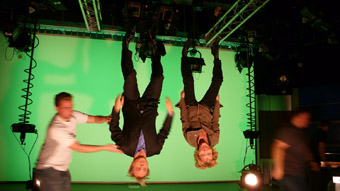
Aspekte (included in Tableau Vivant TV), Christian Jankowski, 17th Biennale of Sydney
courtesy Klosterfelde, Berlin and Lisson Gallery, London
Aspekte (included in Tableau Vivant TV), Christian Jankowski, 17th Biennale of Sydney
DAVID ELLIOT’S TITLE FOR THE 2010 BIENNALE OF SYDNEY, THE BEAUTY OF DISTANCE: SONGS OF SURVIVAL IN A PRECARIOUS AGE, OFFERS MULTIPLE THEMATIC ENTRY AND EXIT POINTS AS DISCUSSED BY JACQUELINE MILLNER IN HER PREVIEW (RT96, P10). FORTUNATELY, THE EVENT RISES TO THE CHALLENGE OF THIS EPIC NOMENCLATURE WITH A MULTIFARIOUS ARRAY OF WORKS FROM 166 ARTISTS SPREAD ACROSS SEVERAL VENUES —THE FANTASTICALLY ATMOSPHERIC COCKATOO ISLAND, PIER 2/3, THE BOTANIC GARDENS, MCA AND EVEN A CLUB SPACE, SUPERDELUXE, INSTALLED IN ARTSPACE.
I sought out the video pieces (which alone are numerous) to explore Elliot’s curatorial vision. Perhaps not surprisingly, many of the time-based pieces work with the idea of song. To some extent, this makes several seem quite similar since they employ the methodology of setting found text or incongruous content to music. Some are more successful than others in pushing beyond mere juxtaposition to resonate more deeply.
Gamu Mambu (Blood Song, 2010) by Christian Thompson (Australia) gives us a Dutch Baroque opera singer performing in Thompson’s heritage language, Bidjara. The subtitling in English allows a glimpse of the culture’s colloquialisms, while the sung Bidjara phrases—complex multi-syllabic words—let us sense the strangeness of these sounds in the mouth of the singer whose European technique prefers vowels to consonants. Thompson’s superimposition of cultures succinctly raises the issues of language and cultural identity, an interesting foil to Susan Hiller’s The Last Silent Movie (2007, USA) in which audio recordings of endangered languages highlight the precariousness of ancient cultures in the 21st century.
A three-screen work created specifically for the biennale by Mieskuoro Huutajat (Shouting Men’s Choir, Finland) takes Kevin Rudd’s 2008 apology to the Indigenous people of Australia as its source material. The screens show headshots of the somewhat unkempt men from the choir alternately speaking and shouting the text. Sometimes a speaker in full shout is stripped of sound. The gently accented phrases, shouted words and silenced cries unite and overlap to create a moving statement on both the power and yet inadequacy of words alone to effect reconciliation.
Perestroika Songspiel by Chto Delat (2008, Russia) offers a performance for video drawn from documentation revealing what local people thought in the early days of Perestroika. Perspectives on the complex issues involved are presented in speeches and dialogues elaborated further by a vocal quintet. The form is clearly performance, yet it occurred to me that such a blatantly agitprop text (lacking even a Brechtian twist) would never actually be performed theatrically—contemporary theatre and performance generally strive for greater complexity in form and content. I had similar thoughts about Lament of the Argentine Military by Tarryn Gill and Pilar Mata Dupont (2010, Australia). The piece is a visually beautiful and well-produced faux-Broadway musical (also accompanied by two large format prints), presenting the atrocities of the Argentinean dictatorship. But does the performative style offer anything more than parody?
In fact a number of the works make me wonder about the relationship of performance to video art. Presented as live performance would these works satisfy conceptually? Why, when a video camera is involved, does the performance language so often seem too simple? Or is the manipulation of a popular form via video into ‘high art’ enough in itself as it allows the works greater accessibility?
Fortunately the creations of Marcus Coates and Christian Jankowski demonstrate that there is scope for much more complexity even while utilising parody. At first glance Marcus Coates is taking the piss in his work A Ritual for Elephant and Castle (2010, UK). Coates calls himself a contemporary shaman. In a silver-grey suit and accompanied by a stuffed buzzard on the end of a stick, he wanders around the London suburb of Elephant and Castle discussing the proposed redevelopment of the area in order to create a performance ritual. What complicates this apparent parody is that Coates seems utterly sincere. He is the perfect ‘change counselor’ as he leads the local development committee through a creative visualisation to assist him in finding material for his coming performance project. Local residents open up to him, offering critical responses to his ideas. Most revealing of all is his meeting with the local property developer, whom Coates gets to help him “find the physical form” of his performance. The developer engages thoroughly in the activity, drawing on the ‘energy principle of Tai Chi’ to explain the “movement with intention” that he feels the area needs. Through his bizarre posturings, Coates actually gets the community to seriously engage in discussion about the issues of change and progress.
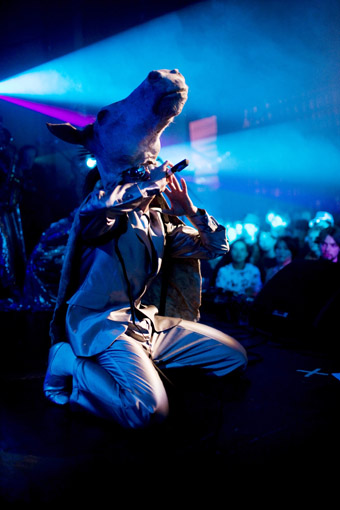
Vision Quest with Chrome Hoof, A Ritual for Elephant and Castle, 2010, Marcus Coates
photo Nick David, produced by NOMAD, courtesy the artist, Kate MacGarry, London and Workplace Gallery Gateshead;
Vision Quest with Chrome Hoof, A Ritual for Elephant and Castle, 2010, Marcus Coates
These encounters are shown on three monitors while the final ritual is projected large—a kind of post-punk-glam rock extravaganza, in which Coates appears, still in silver suit but with a stuffed horse head atop his own, and accompanied by a silver lycra-ed band, Chrome Hoof. Perhaps here I doubt the sincerity—maybe he is in reality a postmodern parodic performer—and I wonder if any of the people he has consulted actually attended this event. Perhaps most interesting is the final meeting with the council where he talks them through the visions he saw during his performance, including swallows nesting in his armpits—he interprets this as a development approach involving small scale sustainable projects. It’s a message which the council hears without the trace of a smirk, and might just heed. A Ritual for Elephant and Castle works as a community-cum-live art project, as documentary and video art.
Similarly, Christian Jankowski’s work could be misunderstood as mere prank, or too self-reflective, yet as it develops the conceptual material complicates and deepens. Jankowski has been actively utilising broadcast television as his subject and medium for some time now (including convincing German TV hosts to present an entire show while hanging upside down). For this biennale he has made Tableau Vivant TV (2010, Germany) in collaboration with Andrew Frost from The Art Life and the College of Fine Art. Utilising the ABC TV’s Art Nation program along with other local and international broadcasters (or so it seems), Jankowski frames his piece as a documentary on the making of his biennale commission. However Jankowski himself never speaks, rather he is a static figure in the background, often with other frozen ‘characters’ at moments in the taping: in the bathtub at the moment of inspiration; a party on a Sydney balcony where Frost and Jankowski first meet; a meal in a swanky restaurant in which Jankowski tries to sell his idea to Biennale director David Elliot; a moment of creative self-reflection and doubt on Bondi Beach. His thoughts are voiced by a variety of television journalists in Germany, England and Australia, including ‘celebrity’ journalists such as Anne Fulwood and Angela Bishop. As the ideas behind the making of the work unfold, Jankowski deftly unpacks a range of complex issues about the relationship of television to video art, art to television, celebrity, the nature of biennales, curatorship and the creative process. While occasionally labouring the point (Kylie Kwong’s valiant effort to elaborate on the relationship between cooking and video editing begins to show the strain), Tableau Vivant TV is smart artmaking in which form and content are inextricably linked and which is both challenging and entertaining.
Beyond these explorations of performance, David Elliot has curated works from some of the blockbuster names of video art. Isaac Julien’s Ten Thousand Waves (2010, UK) is a stunning installation across nine screens. Based on the tragedy of drowned cockle harvesters in Moorecomb Bay, UK in 2004, Julien has collaborated with renowned Chinese artists such as poet Wang Ping, calligrapher Gong Fagen and actress Maggie Cheung to create a multi-faceted reflection on homeland and migration—part documentary, part fantasy, part memorial. Forget 3D, Julien’s stunning imagery, intelligently presented in split narratives across the multiscreens, is a far more immersive, and rewarding cinematic experience.
Interestingly, Julien also collaborated with artist Yang Fudong, who presents his own work in this biennale, East of Que Village (2007, China)—a bleak exploration of life in northern China. Fudong projects black and white images across six screens, his quiet, non-invasive style juxtaposing scenes of a pack of dogs who are literally dying of starvation in front of the camera (even feeding off other dogs) with quotidian human activities in an inhospitable landscape. As westerners it’s easy for our sympathies to go to the dogs, yet the lives of the people here are perilously close to the same level of hardship. East of Que Village is a confronting and conflicting experience.
Similarly, Steve McQueen’s Gravesend looks at the hardship of miners in the Congo, who scratch from the earth by hand an unspecified but valuable commodity. I find McQueen’s work to be essentially visual-audio: the potency of each image drawn out by the heightening of diegetic sound, such as the amazing timbres of splintering rock or compressed air machines. Structured by poetic association—the glow of the molten substance in a crucible is paralleled by the orb of the sun setting behind the factory; the labour of the men is contrasted with the clinical atmosphere of the roboticised factory—McQueen’s work is evocative without being definitive.
Of the many video works in the 17th Biennale of Sydney I found myself drawn to the ones discussed here not only because of a personal preoccupation with performance and video, on the one hand, and the interplay of audio and the visual on the other, but because all of these works exemplified David Elliot’s thematic provocation. While this tight curatorial vision sometimes runs the risk of inflicting homogeneity, it also offers boldness—a willingness to say something, at a time when it is all too easy to stifle conscience and be satisfied with distractions.
17th Biennale of Sydney, The Beauty of Distance: Songs of Survival in a Precarious Age, curator David Elliot; Cockatoo Island, MCA, Wharf 2/3, AGNSW Forecourt, Sydney Opera House, The Botanic Gardens, Artspace; May 12-Aug 1
RealTime issue #97 June-July 2010 pg. 46
© Gail Priest; for permission to reproduce apply to realtime@realtimearts.net
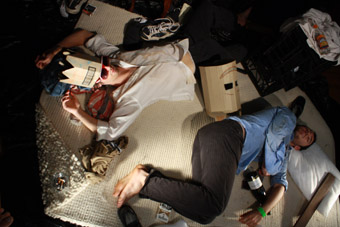
Robbie O’Brien, Tom McCosker, Room 328
photo John Feely
Robbie O’Brien, Tom McCosker, Room 328
room 328: drunk performance
Director and producer duo Daniel Santangeli and Genevieve Trace and an ensemble of physical theatre and circus trained performers “not afraid to touch their audience” premiere Room 328 at Brisbane’s Metro Arts July 6-10. The show is “a response to current social rhetoric around alcohol-fuelled violence and Brisbane’s stringent drinking laws (lockout included)…We wanted to put the audience into the centre of this experience. When you walk into this show, it’s like entering a nightclub. You don’t sit down, you are surrounded by performers and sometimes you can’t even see your hand held out in front of you.” The production’s focus is “on the male experience of the issue…the type of lost men who throw the first punch, wear ties and take pills”, but the artists promise the picture won’t be one-dimensional. (Is young female drunken violence then a different phenomenon, perhaps one deserving its own show?) Choreography will be by Liesel Zinc, music by bass guitarist and keyboard player Mike Willmett from local indie band My Fiction and setting by local interior designer Elise Terranova. Among the seven performers is Skye Gellman of Scattered Tacks (see article) fame. Director Daniel Sanatangeli’s track record includes the immersive DJ While You Sleep (created with Lawrence English and Joel Stern). There’ll be no sleeping in Room 328, unless you pass out. Room 328, The Galleries, Metro Arts, Brisbane, July 6-10, www.metroarts.com.au
under milkwood: virtually real
Dylan Thomas’ radio classic, Under Milkwood (I grew up on the recording featuring Richard Burton as the ‘first voice’ and read the role in a high school stage production), is a headily poetic rendering of the eccentricities, sadnesses and sins (the sexual ones were excised from our school production) of a small Welsh community. In whatever format, on air, filmed (1972 with Burton, Elizabeth Taylor, Peter O’Toole et al) or staged it’s a work ultimately for listening, a reverie devoid of conventional dramatics, taking us deep into the dreams of the inhabitants of Llareggub (‘bugger all’ backwards). As a stage work, Under Milkwood has had a limited career. But perhaps a new version with one performer manifesting all the roles in real and virtual formats might well capture the work’s sense of free-floating interiority. Filmmaker Vanessa Hughes is directing and has created the media world (with some intriguing visual collaging) that performer and co-creator Zoe Norton Lodge will inhabit as some 64 characters (half of whom are substantial). It’s a bold approach with fascinating potential “to begin (again) at the beginning.” Bambina Borracha Productions, Under Milkwood, Sidetrack Theatre, Marrickville, Sydney, July 1-18, bookings 02 9550 3666
increased funding for nsw arts
NSW Arts Minister Virginia Judge has announced, “An extra $3.5 million will support additional performing arts tours, new works and foster further development in the small-to-medium arts sector” (Press Release, Budget 2010-11, June 8). Coming so soon after Judge’s consultative meeting with the small to medium performing arts sector (as reported in “Talking with the Minister“) this was very welcome news.
There’s also $1m (of $4.5 million over four years) “towards the acquisition of Pier 2/3—the last undeveloped wharf in the performing arts precinct of Walsh Bay.” Let’s hope, and lobby, that this vast wharf not be subdivided into conventional theatre and gallery spaces or controlled by neighbouring major performing arts companies but kept flexible for experimental ventures, festivals and biennales.
There’s also $1.5 million in recurrent funding for CarriageWorks at Eveleigh, “cementing its place as the hub of the State’s small-to-medium contemporary creative sector”, but presumably no increase to allow the venue (or its principal resident, Performance Space) to become a serious producer rather than a venue for hire. Without such an investment how will CarriageWorks ever grow?
Other organisations have benefited substantially. There’s “a total investment of $13 million in the $53 million redevelopment of the Museum of Contemporary Art, $2.91 million over three years for the Sydney Film Festival, a total investment of $2 million through to 2014 for the Sydney Writers’ Festival and $1.75 million a year through to 2014 for Sydney Festival First Night.” And Judge announced at the Biennale of Sydney launch a substantial funding hike for that event too.
Whatever questions are raised by the arts budget, including just how the small to medium sector funding will be allocated, it’s encouraging to see Minister Judge continuing to be responsive to the needs of NSW artists.
parramatta: creative city
Funding from the 2010-11 NSW arts budget “to develop creative enterprise hubs within the Parramatta CBD” has boosted this western Sydney centre’s ambition to be “a creative city.” Parramatta City Council Lord Mayor Paul Garrard said the project, “jointly funded by Council and the NSW Government, will profile Parramatta as a leader in the creative industries by transforming disused commercial premises into innovative spaces for artists and other creative practitioners to create, exhibit and sell their work” (Press Release, June 16). This funding will add further low cost artist spaces to the existing Parramatta Artists Studio and Connect Studios.
cairns cultural precinct
As a result of strong campaigning from Cairns Regional Council, the Cairns Arts and Cultural Sector (including Arts Nexus), and the wider Cairns community, the Queensland government has announced an initial investment of $42.5m for a cultural precinct for this far north Queensland city. The facility will include a performing arts centre (with a main auditorium of 1,000 tiered seats, a flat floor, flexible performance space with 300 to 350 retractable seats and a rehearsal facility that can accommodate up to 100 seats), a museum and a public plaza for open-air performances large scale and intimate. The centre’s performance space design “is influenced by western and Indigenous culture, combining the concepts of the amphitheatre and the Bora Ring. These concepts are evident in the unique functionality of the Centre, including fully retractable walls, which take advantage of the outlook across Trinity Inlet and allows for an open air performance experience” (Press Release, June 8). The museum “will be dedicated to the presentation and exploration of the vibrant and diverse culture and history of Far North Queensland with a focus on Aboriginal and Torres Strait Islander culture and history.” In a city with limited performing arts facilities the new centre will doubtless be a great asset for local and visiting innovators.
www.cairns.qld.gov.au/content/CulturalPrecinct/index.html
emptyspaces nsw
Inspired by Marcus Westbury’s Renew Newcastle initiative, on June 7 the NSW government, as an integral part of their emptyspaces program, launched a new website service designed to promote ‘pop-up’, short-term re-uses of empty shops and other spaces for creative and community uses around the state. “The website is part of Arts NSW’s work on Creative Enterprise Hubs [that] operate in temporary low cost or free premises provided by commercial property owners, local governments and communities to artists and arts groups looking for space to produce, deliver and consume arts products and experiences.”
Emptyspaces is hosted by UTS Shopfront as part of the Cultural Asset Mapping in Regional Australia (CAMRA) project. The site “includes a Toolkit of information sheets and resources developed with the Arts Law Centre of Australia and the NSW Department of Planning, case studies of empty space initiatives in NSW, nationally and internationally, a community space for sharing information, maps of projects and spaces and the capacity for empty spaces to be logged.” According to Kim Spinks, Manager, Capacity and Development, Arts NSW has held briefings on Creative Enterprise Hubs in Lismore, Parramatta, Lithgow, Port Kembla and Gosford with further briefings to be held in Wagga Wagga on July 19 and in Leichhardt and Wollongong. The Emptyspaces Project Manager is Lisa Andersen, Community Engagement Coordinator,?UTS Shopfront Community Program,?02 9514 2902, lisa.andersen@uts.edu.au; http://emptyspaces.culturemap.org.au/
RealTime issue #97 June-July 2010 pg.
© RealTime ; for permission to reproduce apply to realtime@realtimearts.net
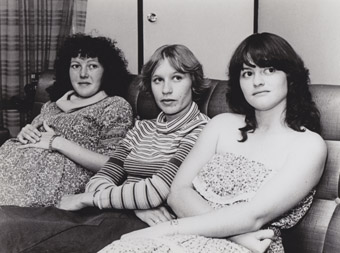
Diana Doman, Josie Petersen, Kerry Carlson, 1980, Love Lust & Lies
GGILLIAN ARMSTRONG’S MOST RECENT FEATURES, DEATH DEFYING ACTS (2001) AND CHARLOTTE GRAY (2008), HAVE BEEN FIZZERS, FULL OF BIG IDEAS AND CASTS, BUT LACKING THE CAREFUL SCRIPTING AND ATTENTION TO FINE DETAIL THAT MADE HER EARLIER WORKS, HIGH TIDE (1987) AND MY BRILLIANT CAREER (1979), SO MEMORABLE. HER RECENT DOCUMENTARY-MAKING IS ANOTHER STORY.
Unfolding Florence: The Many Lives of Florence Broadhurst (2005) was a wonderful unravelling of the demise of its subject, a luscious experience where style met substance and the audience swooned. Armstrong’s new documentary, Love, Lust & Lies (2009), is more down-to-earth but just as dramatically satisfying, the latest episode in a social-realist experiment that began in 1976 with three 14-year-olds—Kerry, Josie and Diana—plucked from an Adelaide youth centre, to talk to camera about their lives, dreams and hopes (Smokes and Lollies, 1970). Armstrong continued to check in with them at ages 18 (Fourteen’s Good, Eighteen’s Better, 1980 ), 26 (Bingo, Bridesmaids and Braces,1988) and 33 (Not Fourteen Again, 1996). Love, Lust & Lies meets the women in 2009, now at age 47.
In choosing a number of subjects to track through their lives Armstrong took on a challenge similar to Michael Apted in his Up! series, commencing with 7 Up! in 1964. Apart from satisfying your curiosity, seeing how the girls turn out and whether they realise their ambitions—with apparently limited resources—it’s also an opportunity to see how Armstrong reveals herself, how she has matured as a filmmaker. Her willingness to be present within the frame, to answer questions, engage in dialogue about the process, sets her apart from Apted, who remains very much the clinical observer. It’s also made very clear that Australia is not a classless society; her subjects do not have the same opportunities as Armstrong and there’s a sadness for everyone in this realisation.
Kerry and Josie tell Armstrong plainly they don’t want to watch the earlier films, that they “choose to forget,” concentrating on moving forwards. One of the limitations of the series’ format is that Armstrong spends a great deal of time looking backwards over the women’s lives. While good to have a recap, it’s slightly frustrating to spend so much time back then, particularly when I suspect most people seeing the film have seen the others too. I was also curious at first as to why Armstrong spent so much time talking to their daughters rather than the women themselves, as if pushing them out of their own film. But when Josie later says, “You don’t stop parenting when you’ve had your children. Parenting goes on for generations,” I understood the sophistication of Armstrong’s technique. Ultimately the film is not about three women any more; it’s about the legacy of motherhood. Josie and Diana are still struggling with relationships, with children, with deceit—both had absent mothers. Kerry, who had loving parents, knows how to treat her husband (and her own ideas) with care and respect; everything about the interviews reveals a couple in love.
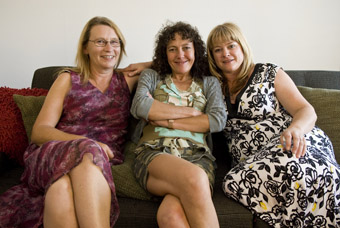
Josie Petersen, Diana Doman, Kerry Carlson, 2009 Love, Lust & Lies
What’s fascinating about this particular instalment is how the stories of children and grandchildren (some now adults) start to reveal the web of lies and intrigue previously woven by the women in earlier episodes. There are dramatic revelations of lies told, not only to Armstrong and her audience, but within the families themselves—lies crucial enough to have destroyed the fabric of their lives. You suspect the women were often lying quite successfully to themselves, too, at the time, and it’s intriguing to reconsider former interviews from this perspective; fresh faces seen in a new light.
The other unavoidable comparison is between 14-year-old girls then and now. While the central themes remain the same—obsession with boys, becoming body-conscious, rebelliousness against parents—there’s no trace here of the contemporary world: mobiles, the internet, email. Back then, after her mother abandons the family, Josie serves her father and brothers food kept warm in the oven, automatically assuming the mother’s role at age 14. The girls are just on the brink—about to negotiate the first wave of feminism—but at this point their options seem so limited: get married; be a secretary; study to teach. As a father says, “A girl can get in a lot of trouble, a boy can’t.” The girls don’t question this. For their daughters, the options are seemingly enormous (the army, being a pilot) but that doesn’t change a great deal in this century—they too end up with limited education, often deadbeat, controlling men around and early pregnancies; the cycle continues.
Apted’s series, now available on DVD, hasn’t quite lived up to expectations, refusing to question its own currency and adapt with the times. Participants suddenly disappeared without notice (I’d spend the whole episode worrying about them: were they dead? just not interested? fed up? in a mental institution?). It was hard to tell what they thought of the process; some appeared to hate it. The interesting questions, never asked, were why did others continue to take part, and what impact did their participation have on the shape of their lives? But one aspect of 7 Up! I did like was the way its three female subjects were often interviewed and framed together. It gave them an interesting dynamic, bouncing off each other in heated debate. I often wished we could spend more time with the women as a group—with Armstrong interrogating them on the trickier issues, to see how they presented in front of each other, what they were willing to reveal, the divergence between narratives alone and together. But you get the feeling they have, as many friends do, drifted apart; they remain polite and tentative, probably not the footage Armstrong was really after.
The film ends, as always, on an open note, but it’s hard to imagine Gillian Armstrong will give up here. You yearn to see the women slogging on, into retirement, hopefully realising their dreams of travel and finding a place of peace. And there’s the burning question that remains: I just have to know, will Diana end up staying with Fury?
Love, Lust & Lies, producer, director Gillian Armstrong, producer Jenny Day, original music Cezary Skubiszewski, cinematographer Paul Costello, editor Nicholas Beauman; screening in limited release nationally.
This article first appeared online May 24
RealTime issue #97 June-July 2010 pg. 20
© Kirsten Krauth; for permission to reproduce apply to realtime@realtimearts.net
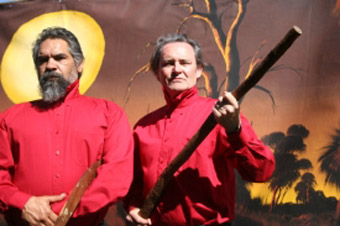
Kelton Pell, Geoff Kelso, Bindjareb Pinjarra
IN THE SOUTH WEST OF WESTERN AUSTRALIA IN 1834, FIVE YEARS AFTER WHITE SETTLEMENT, A GOVERNMENT SURVEY WAS UNDERTAKEN IN THE INTERESTS OF PROTECTING THE LIFE AND PROPERTY OF THE SETTLERS. IT CULMINATED IN A BLOODY BATTLE AT PINJARRA IN WHICH THE 21 NAMED BINDJAREB NYOONGARS WERE KILLED. OF COURSE IT WASN'T A BATTLE ANYMORE THAN IT WAS A SURVEY. IT WAS A MASSACRE AND THE BODIES OF MANY MORE UNNAMED BINDJAREB WERE WASHED DOWN THE MURRAY RIVER; ACCORDING TO INDIGENOUS ACCOUNTS BETWEEN 70 AND 150 MEN, WOMEN AND CHILDREN.
One white officer died from falling off his horse. Since then the Pinjarra massacre has been a casualty of the history wars. Back then the Bindjareb were wedged between two landowners: Peel who owned 250,000 acres on the Mandurah side of the river and Meares who had 20,000 acres on the southern side of the Bindjareb. They were squeezed in along the river. This configuration of forces was the basis for the massacre; the Bindjareb had nowhere to go and were mowed down with muskets fired from both banks of the river.
This year is the 175th anniversary of the massacre and it is being remembered with a play, a travelling art exhibition and a website with a podcast which can be downloaded as an audio tour for people who visit the massacre's location. The site is so fiercely contested that the local council still refuses to acknowledge the event or put up signage let alone erect a memorial. So, paradoxically the virtual site, www.pinjarramassacresite.com, is the contemporary historical site.
The podcast was made by the actors who feature in the play, Bindjareb Pinjarra, performed in Fremantle at Deckchair Theatre. This is a revival of the 1994 production. The original performer-creators, Kelton Pell, Geoff Kelso and Phil Thomson, who approached the Pinjarra man Trevor Shorty Parfitt to be the fourth storyteller, have regrouped to honour his memory and pass the show on to three new people, another senior Pinjarra man Frank Nannup and two young fellas—Nyoongar actor Isaac Drandic and Wadjella, Sam Longley. The play must be passed on because it exists as an oral form created from improvisation around the historical records and the oral acccounts of the Nyungars and informed by the everyday as well as present day interactions. The ensemble of six male actors are all agile performers and accomplished improvisers and very funny too, because this play about a massacre is presented as a comedy with a black undercurrent. The humour is always deadly serious. The actors play across age, class and race and play they do so that all the stereotypes are well worked over for comic effect. Its great strength is the depth of story it tells and the quality of the tale tellers. Among them, Kelton Pell and Sam Longley stand out in particular for their ability to take us deep inside the other and find the familiar self beyond stereotype.
The staging is pared back and clear, everyone wears the same costume-uniform, there are few props, no sets, just benches to return to between scenes, and, dominating the space, a mural backdrop painted in the Carrolup style by contemporary Nyoongar artist Lance Tjyllyungoo Chadd whose work features in the exhibition at the old Fremantle Gaol along with 20 other artists. The backdrop is a powerful, atmospheric landscape of big old river gums and grasstrees beside a deep gully and a shaded creek depicted at sunset, conjuring a gothic scenario of ghosts, blackboys and a river running with blood and choked with bloated bodies. It presents a disturbing stillness that can never be read as elegiac once you know the history of the place.
Subtly dramatic lighting played on this painting, animating all its moodiness enhanced by the soundscape which incorporated voices, rifle shots, birdsong and the plaintive wail of a didjeridu. The actors contributed the live sound of clapsticks to punctuate the scenes, drive the action forward, keeping us alert and alarmed, unable to forget what happened. If there was any doubt that the play needed to be revived post-Apology, then what happened to Shorty Parfitt's family on opening night when they ordered a taxi which refused to pick them up, shows that even in tourist savvy, sophisticated Fremantle there are still deep pockets of racism. The story still needs telling.
Bindjareb Pinjarra will tour to The Dreaming Festival June 11-14 June, Woodford, www.woodfordfolkfestival.com/thedreaming, and Brisbane Powerhouse, June 15-17
Bindjareb Pinjarra, created and performed by Isaac Drandic, Geoff Kelso, Sam Longley, Franklin Nannup, Kelton Pell & Phil Thomson; Victoria Hall, Fremantle, March 17-April 3
RealTime issue #96 April-May 2010 pg. web
© Suzanne Spunner; for permission to reproduce apply to realtime@realtimearts.net
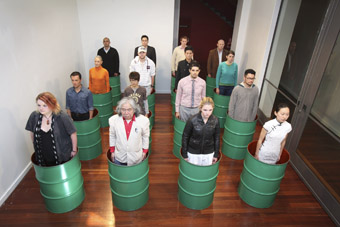
Tatsumi Orimoto, Oil Can, 2010, 4A Centre for Contemporary Asian Art
courtesy the artist, photo Alex Craig
Tatsumi Orimoto, Oil Can, 2010, 4A Centre for Contemporary Asian Art
“IF IT’S ART, IT’S ART,” CONCEDES A BEMUSED PEDESTRIAN AS HE HEADS OFF AFTER BEING MOMENTARILY ABSORBED INTO THE CROWD OBSTRUCTING THE FOOTPATH OUTSIDE THE 4A CENTRE FOR CONTEMPORARY ASIAN ART. IN A SMALL WHITE-WALLED ROOM FILLED WITH 15 GREEN 44 GALLON OIL DRUMS PAINTED RED ON THE INSIDE STAND BLANK FACED FELLOW CITIZENS AND THE ARTIST WHOSE WORK, OIL CAN, THIS IS—TATSUMI ORIMOTO.
In a line outside the window, volunteers await their turn to expressionlessly occupy a drum for 30 seconds. Orimoto purposefully fusses about, directing individuals—it might be five, or 14—into position. When satisfied, he chooses a drum for himself and is helped in using a small step ladder. Once everyone is still, looking forward towards the street, the moment is captured by a photographer perched high on a ladder just inside the window. Then the process begins again, Orimoto creating new permutations for well over an hour.
Outside the crowd grows and, after a half hour or so, an emboldened Orimoto beckons to passersby to join his volunteers, which they willingly do. Meanwhile, chatty observers explain to the newly arrived what they think the work is about: “alienation,” “ordinary people at the mercy of the oil industry,” “people discarded,” A newcomer asks, “Is someone making a movie? “Now there are several other photographers in the room and, outside, mobile phones are held aloft. Moments of stillness, as the latest permutations are realised, alternate with the bustle of selection, arranging and clambering in an out of drums. The sense of occasion is palpable and participation unthreatening. The cultural mix of volunteers, true to China Town (next door is the inviting Polish deli, Cyril’s), is rich and welcoming.
Oil Can suggests much, reminding us of Ham and Clov in their bins in Beckett’s Endgame, sharpening our sense of non-communicative personal isolation (curiously at odds with the conviviality of the crowd and the willingness of the volunteers) and heightening our appreciation of art as its usual complex two-way process—observer and observed—but to which has been added the ever increasing role of observer as observed, through participation and co-creation with the artist. All of this intensifies the sense of ‘everyday surreal’ that Oil Can evokes—pedestrians in their street clothes stepping into the neat rows of drums to have their images captured for purposes that remain unexplained. I look forward to seeing the documentation; doubtless it will be a work of art in itself, offering a more formal meditation, but stripped of the excited hubub of the performance it might mean something else.
Centre 4a’s enterprising program of live performances engages new audiences—surprising them with art while making it simulantaneously part of the everyday.
Tatsumi Orimoto was born in 1946 in Kawasaki, Japan and studied at the Institute of Art, California. In 1971 he moved to New York, where he worked as an assistant to Nam June Paik and was introduced to Fluxus. In 1977 he returned to Kawasaki where he currently lives and works. His performances have been presented in several countries including the Biennale of Sydney, Sao Paulo Biennale and Venice Biennale.
Tatsumi Orimoto, Oil Can, 4A Centre for Asian Contemporary Art, Sydney, May 13
RealTime issue #96 April-May 2010 pg. web
© Keith Gallasch; for permission to reproduce apply to realtime@realtimearts.net
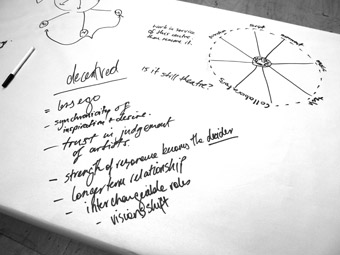
Workshop notes Dramaturgies #4
FEBRUARY SAW THE 4TH DRAMATURGIES SEMINAR ORGANISED BY MELANIE BEDDIE, PETER ECKERSALL AND PAUL MONAGHAN. PREVIOUS MEETINGS FOCUSSED ON THE ONLY PARTIALLY RESOLVED DEFINITION OF 'DRAMATURGY,' ON DRAMATURGY AS A CRITICAL AND POLITICAL PROJECT (“INTERVENTIONIST DRAMATURGY” IN ECKERSALL’S WORDS), AS WELL AS PRACTICAL STRATEGIES FOR WORKING IN A DRAMATURGICAL MANNER.
There were three working parties for Dramaturgies #4: Collaboration facilitated by Eckersall, Diversity by Beddie and Training and Research (the group I joined) by Monaghan. John Romeril noted of Dramaturgies #3 that it had an “experiential emphasis.” with a “learn by doing and observing approach”, problems being addressed “on the floor” and on one’s feet. The decision of Eckersall’s group to present their findings in the form of a space strewn with snaking passages of text, balls of paper, objects, and scenographically arranged mess, reminiscent of artist Joseph Beuys’ perfomative lectures for the Free International University, represented an attempt to blend experiential knowledge (the body, performance, space) with theory and ideas.
Overall though, Dramaturgies #4 took the form of oral discussion. With Richard Murphet playing a prominent role, at times it seemed a festschrift for the former head of VCA Theatre. Murphet’s engrossing keynote reminded us of links between contemporary understandings of theatrical structure and Euro-American developments, as well our indebtedness to the experimental, often nationally-focused, work of the Australian Performing Group and the Pram Factory. Murphet attended US director and theorist Richard Schechner’s infamous production Dionysius in 69, which The Australian characterized as “the ultimate 1960s group-grope show.” Schechner’s ideas on the transcendence of the mundane through staged interactions, in which text, image, design and the body all played a significant role, and which were widely dispersed about a multi-focal theatrical space, helped set the tone not only for much of the material produced by artists like Murphet, but incited Australian practitioners to wrestle with articles on Artaud and Brecht from Schechner’s journal, TDR. Thinking dramaturgically has a long history in Australia, running from Eugenio Barba’s influential appearance in The Drama Review [TDR] through to Murphet’s production of The Inhabited Man (2008; see RT 87, p8).
The working parties at Dramaturgies #4 struggled to find common ground, leading to some “group envy.” In closing presentations, many of the Diversity panel contended that the matter is best addressed as an integral concept, enmeshed within every aspect of theatrical thinking, rather than treating it separately, whilst we in Pedagogy wrestled with how to approach so broad a question as the teaching of the full variety of practices involved in the structuring of theatrical knowledge.
Literary issues of editing, textual analysis, and May-Brit Akerholt’s wonderful keynote on script translation, loomed large, but we broadly agreed that the task was to assist students, artists and the public to “think dramaturgically”—rather than necessarily to become that strange beast, the “company dramaturg,” who is typically yoked to the text. Dramaturgy was seen as a way to think in terms of the structures and tendencies involving space, text, sound, light, time, politics and so on (Barba’s weft or “weave”), all of which are measured, invoked and manipulated within the theatrical scene—and within many social and historical arenas as well.
After much to-ing and fro-ing, Murphet offered a possible systematisation of certain critical aspects of a dramaturgical consciousness, which I gloss below. Universal agreement was never to arise, and I felt there was a reluctance by many to confess how our own constructions of dramaturgical practice were weighted towards post-1960s “performance” and the kinds of neo-avant-garde theatre promoted by Schechner and his successors. Dramaturgies #4 was not just notable for its stellar list of delegates, but also for those not present. Where was MTC, the Australian Ballet, Bell Shakespeare, the Australian Writers’ Guild and other institutions many of us characterise as relatively “conservative”? Eckersall’s proposed “‘national audit’ of dramaturgical practices in and for the sector” could not be fully effected here.
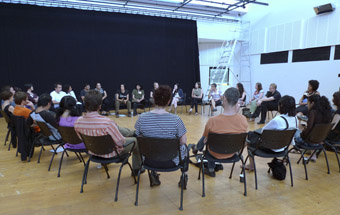
The circle Dramaturgies #4
Dramaturgies #4 rather reflected a partisan (though internally divided) set of proposals for thinking about how theatre is put together and how it relates to the wider world, whereby certain aspects of avant-garde praxis and ideals of social or aesthetic intervention—however modest in form, even if only focused on changing perception rather than political structures per se—would be espoused. Whilst dramatically inflected work was the dominant subject of discussion, dance theatre and at least some forms of performance art could be accommodated by the proposed models and membership. Nevertheless, dramaturgy as a potentially totalising socio-aesthetic critique, as a way of modelling the wider social 'ecology' of theatrical ways of acting and describing phenomena—be these on stage, in the visual arts, in political and social action, of socio-cultural occurrences varying from war to shopping—remains an unexplored challenge.
To think dramaturgically, one must learn how to read a piece of theatre; which I would see as rendering all dramaturgs critics. Secondly, it was agreed that one must have a broad knowledge of all aspects of theatrical practice and construction, running from choreography to lighting, text and so on (there was some debate as to whether one should learn such ideas “from the inside” by doing, or, as in my own teaching, through “outside” analysis). One must be able to think of theatrical composition in terms of its formal elements. Phrases such as “the performance score” were deemed helpful, as were models from music (harmony and dissonance), literature (Homeric structures, the Epic, Aristotelian tragedy, Viktor Shklovsky’s concept of “making strange” or defamiliarisation and so on), visual arts (balance and composition), plastic arts (texture, weight, mass) and—especially as far as my own teaching is concerned—the multidisciplinary pedagogy of director Oscar Schlemmer, architect Walter Gropius, painter Wassily Kandinsky, composers Paul Hindemith and others at the Bauhaus School in the 1920s.
Ian Maxwell from Performance Studies at University of Sydney observed that dramaturgs must know how to “break the hermeneutic circle of the work”, or in Murphet’s terms, to disabuse those “expectations” which the structural rules listed above might impose. Barba and Eckersall have used the terms “turbulence” and “con-fusion” to suggest a similar interplay of order and a deconstruction of that order within dramaturgy. This could involve, for example, sudden transitions from tragedy to farce, or vexing a progression from light to darkness.
Monaghan began with the suggestion that a dramaturg is one who “imagines his or her audience”. Such a generalised concept is broad enough to encompass works where the aim is to challenge and provoke, as well as more humanist ideas of the performing arts as entertainment, as describing one’s own life (drawing-room comedy, for example) and other forms of practice.
Finally, one concept which I would contend is essential to all considerations of art, is an awareness that any and all forms of dramaturgy contain within them a “worldview.” The dramaturg must take seriously ideas about philosophy, politics, the body, religion, ritual, anthropology, race, gender, sexuality and other matters as they pertain to the work and to the world as a whole. To craft a theatrical space is to model the world, society and the cosmos—the theatrum mundi or little theatre of the world which Renaissance scholars extolled. Dramaturgical perspectives have the potential to provide a totalising “gesamtkunstwerk” of culture itself, of politics, the arts and of our relation to these phenomena.
Whilst Dramaturgies #4 did not reach any final agreement on how to impart such a way of conceiving knowledge and experience, let alone what limits to such concepts we might want to impose and under what circumstances, Eckersall, Monaghan and Beddie provided a challenging forum wherein such ideas could be debated. If the only outcome of Dramaturgies #4 was to allow us to listen to theatre-maker and Director of The Centre of Performance Research (UK) Richard Gough’s celebration of the cultural and affective density of objects, then it was worthwhile. Gough confessed that, like many other dramaturgs, he was “drawn to objects that…emerge into daylight from dusty attics, mouldy sheds, damp garages and…junk shops…I liked the patina…the scars and markings of an object well used, of functionality and distress; objects abandoned, discarded, rejected and forlorn.”
Such Duchampian detritus has an already established life of theatrical processes and history, which is waiting to be invoked within new theatrical environments, from the cabinet of curiosities to the stage. Having heard that one of Australia’s most successful dramaturgs, Michael Kantor, announce to delegates he is leaving theatre to take up a more environmentally proactive life, Gough’s words about cherishing of the worn textures of embodied refuse, and of the performative weight locked within otherwise derelict objects, suggested that the full ecology of dramaturgy continues to need careful and sensitive husbandry.
Dramaturgies #4, convenors Melanie Beddie, Peter Eckersall & Paul Monaghan; Victorian College of the Arts, Melbourne University, Feb. 17-20.
RealTime issue #96 April-May 2010 pg. web
© Jonathan Marshall; for permission to reproduce apply to realtime@realtimearts.net
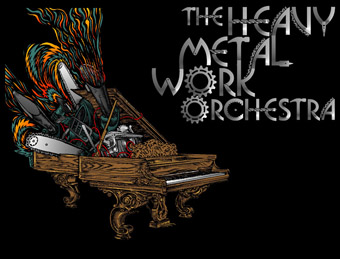
Heavy Metal Work Orchestra
heavy metal work orchestra
The DeMiXerphone, a new instrument created by Frederick Rodrigues, amazingly allows composers and musicians “to have precise control over the pitch, timbre and rhythmic potential of almost any electrical appliance.” You can see it in action as Rodrigues, Abel Cross, trumpeter Scott Tinkler and pianist Adrian Klumpes perform a work for “a 12-piece computer controlled ensemble of power tools and appliances.” Heavy Metal Work Orchestra, The Red Rattler Theatre, 6 Faversham St, Marrickville, Sydney May 28, 7:30pm; May 29, 7:30pm; May 30, 3pm, www.heavymetalworkorchestra.com
adelaide film festival submissions call
The 2011 BigPond Adelaide Film Festival (BAFF) is calling for submissions for its 2011 program in the categories of feature film, documentary, animation, short film, experimental and new media work. You can download a form, submit online through the BAFF website or visit Withoutabox (www.withoutabox.com), an online film festival submission service. For submission deadlines and guidelines visit the BAFF website at www.adelaidefilmfestival.org. BigPond Adelaide Film Festival, Feb 24-March 6, 2011
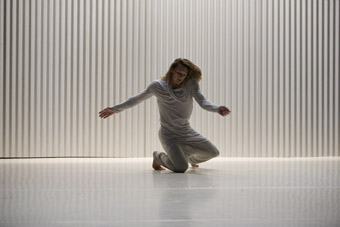
Luke Hanna, The Cry, Dance North
photo Ferry Photography
Luke Hanna, The Cry, Dance North
dancenorth, the cry
Dancenorth’s eagerly awaited first full-length work from new artistic director Raewyn Hill is The Cry, exploring “the momentum created by a life of [drug] dependency that sweeps others up in their path. Ultimately, we wish to portray the relentless nature of pursuing recovery and the strength needed to build a life in recovery.” The Cry opened in Cairns, May 21-22, has its hometown premiere in Townsville, June 2-6. and tours to Proserpine, August 13-14. Dancenorth, The Cry, www.dancenorth.com.au
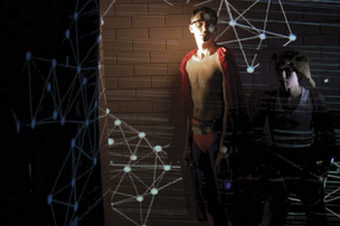
Nic Dorward, YOUTHvsPHYSICS 2009
photo Amelia Dowd
Nic Dorward, YOUTHvsPHYSICS 2009
restaged histories project, youth vs physics
After its Next Wave premiere of YOUTHvsPHYSICS, the Restaged Histories project flies to hometown Brisbane to examine “thwarted attempts to fly” as exemplified by Icarus, Superman and a fictional Soviet cosmonaut named Omon Ra. The company describe the work as “part science experiment and part rock concert” with “two performers, risking life and limb in the name of heroism and entertainment and taking a smart and irreverent look at boyhood and imagination in an attempt to disprove heroism.” Restaged Histories are Artists-in-Residence at Brisbane Powerhouse and YOUTHvsPHYSICS was commissioned and developed by Next Wave through kickstart 2009. The Restaged Histories project, YOUTHvsPHYSICS, Brisbane Powerhouse, June 2-5; brisbanepowerhouse.org
the light in winter, melbourne
The European tradition of light festivals in mid-winter has taken hold in Australia, first with The Light in Winter in Melbourne (see RT84) with a focus on community installations, and then in Sydney with VIVID and the Smart Light Festival in 2009 with an emphasis on innovation (see RT90). The music-oriented VIVID is on again this year (more below) and will be joined again by Smart Light in 2011. Robyn Archer’s 2010 The Light in Winter program involves, community events, forums and leading illumination and digital artists, with a commissioned work from Mexican electronic artist Rafael Lozano-Hemmer to be launched on June 4. Read Scott McQuire’s introduction to this artist’s work (see RT89) and you’ll see that the commission is a considerable coup for Melbourne. There’ll be a new interview with Lozano-Hemmer in RealTime 97 -June 11]. For more information about The Light in Winter and the work of Rafael Lozano-Hemmer visit: www.fedsquare.com/thelightinwinter and www.lozano-hemmer.com. The Light in Winter, Federation Square, Melbourne, June 4-July 4
vivid sydney
Last year’s inaugural Vivid festival seemed to appear out of nowhere, but offered some large scale spectacle and intense musical experiences that Sydney’s audiences embraced. This year, the guest curators of the performance program, Vivid Live based at the Sydney Opera House, are the power ‘odd couple’ Laurie Anderson and Lou Reed. They are billed as “bringing Manhattan to Sydney” with a very impressive range of concerts by both established and rising stars such as Rickie Lee Jones, Marc Ribot, The Blind Boys of Alabama, Bardo Pond, My Brightest Diamond and Holly Miranda. There are also artist from further afield such as Melt Banana and Boris from Japan and the Tuvan throatsinging champions Chirgilchin.
Along with individual concerts many of the artists have been programmed together into themed nights such as the Slow Music Night (June 4), and Noise Night (including Australians Oren Ambarchi and Lucas Abela’s Rice屎Corpse, May 31). There is even a daytime concert for dogs in the Opera House Forecourt (June 5). And of course there are numerous appearances by Anderson and Reed including a Transitory Life, a solo retrospective performance by Laurie Anderson; Songs from Delusion with Anderson joined by Eyvind Kang, Colin Stetson and Doug Wieselman; Reed’s Metal Machine Music; New York Genius, photos curated by Reed from the Magnum Photographic Archive; and a range of talks with the curators. There’s also a theatrical offering with The Shipment by Young Jean Lee’s Theatre Company lauded as some of the best and boldest experimental playwriting in America.
Apart from the Vivid Live program, a range of other activities are also gathered under the Vivid umbrella such as the lighting of the Opera House Sails with images from Laurie Anderson, and Macquarie Visions, which will illuminate the historic buildings of Macquarie street with projections. The harbour spectacular Fire Water returns to the Rocks, this time with a Bollywood flavour exploring the story of ship that sailed to Sydney from Calcutta in 1797. Creative Sydney also returns with talks and forums focusing on the local scene (its artists again almost totally absent from the Vivid Live program), which along with X | Media | Lab and the Song Summit offer opportunities to discuss the creative health of Sydney and NSW. Vivid, various venues, May 27-June 21; Vivid Live, Sydney Opera House May 28- June 11; http://vividsydney.com/; http://vividlive.sydneyoperahouse.com
RealTime issue #96 April-May 2010 pg. web
© RealTime ; for permission to reproduce apply to realtime@realtimearts.net
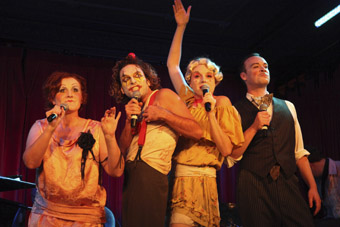
Eliza Logan, Josh Quong Tart, Vashti Hughes, David Keene, Vashti Hughes Ensemble, The Wild Party
photo Brendon Moar
Eliza Logan, Josh Quong Tart, Vashti Hughes, David Keene, Vashti Hughes Ensemble, The Wild Party
FOURTEEN YEARS AGO THE FOUR-MEMBER VASHTI HUGHES ENSEMBLE PRESENTED WILD PARTY TO SOME ACCLAIM AND SOLD-OUT SEASONS AT THE MELBOURNE COMEDY FESTIVAL. NOW RE-PRESENTED AT THE NEW RAVÁL THEATRE IN SURRY HILLS, THIS JAZZ, CABARET AND SPOKEN WORD FUSION IS FULL OF REMINISCENCES OF BYGONE TIMES, RAISING QUESTIONS ABOUT THE USE-BY-DATE OF SOME PERFORMANCE MODES.
The evening opens with a four-piece jazz band providing mood music in Ravál’s dimly lit and crowded theatre bar, tucked above the Macquarie Hotel’s sports bar. The couple in front of me seems to have the right idea, perched on a plush black, leather lounge sipping a string of martinis. We could have been transported back in time, although the music is without the experimentation, the improvisation, the ‘being in the moment’ that I idealistically associate with 20s jazz bars. Enter the Vashti Hughes Ensemble, energetically forming a tableau vivant, while the band slip into providing soundtrack for the performance. Two men and two women pose in costumes evoking 1920s bohemia, but the men’s incongruous Converse shoes, the careful theatricality of the poses and the exaggerated whiteface make-up hint at a contemporary clowning troupe.
Wild Party is a risqué narrative poem written by Joseph Moncure March in 1926 and banned upon publication. It is often seen as a jazz-influenced precursor to Beat poetry, particularly as William S Burroughs once declared that it made him become a writer. The Hughes Ensemble is fairly faithful to the tradition—the poem being the driving element of the show to which all other elements seem subjugated. It comes to life as the ensemble craft an aural space, drawing together sounds, rhythms and narrative through-line. The story is of Queenie (Hughes), “a blonde [whose] age stood still” and her misogynist lover, Burrs (Josh Quong Tart), “A clown. Of renown”, whose portrayal is strangely reminiscent of Heath Ledger’s Joker. After a falling-out and near bout of domestic violence the couple decides to throw a party. Queenie’s best mate Kate (Eliza Logan) turns up with the handsome Mr Black (David Keene) and Queenie executes her revenge on Burrs by ‘making a pass’ at Black which fast-tracks into a love affair.
Although the four performers each take on a character, their predominant role is as ensemble poet narrator. The fidelity of their recital however reveals the datedness of form and text removed from their original context. Moncure March’s text is less shocking these days and while the ensemble do their best to show off the raunchiest bits, and this is where most of their comedy comes from, the piece grasps for contemporary relevance. Cabaret can still be sexually and politically subversive as in queer performance seen in Sydney, such as Gurlesque and much of the work at Red Rattler. I look hard for this in Wild Party, but I find homage more than anything else.
The whole affair predictably comes to a head with a pistol being pulled from a bedroom drawer. Burrs is murdered and Queenie (now channelling Cole Porter) sings apathetically, it was “just one of those things.” There was little variation in musical tone throughout and the performance was for the most part formulaic. However, it looked like a lot of fun to do, and it’s hard to say a form has reached its use-by-date when a packed house is enjoying it.
Vashti Hughes Ensemble, Wild Party, performers Vashti Hughes, Josh Quong Tart, Eliza Logan, David Keene, Ravál Theatre, Macquarie Hotel, Sydney, March 15-April 3
RealTime issue #96 April-May 2010 pg. web
© Megan Garrett-Jones; for permission to reproduce apply to realtime@realtimearts.net
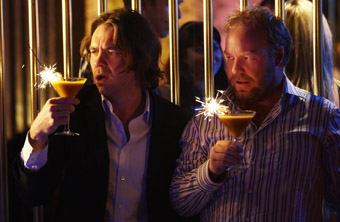
Brendan Cowell & Peter Helliar, I Love You Too
photo John Tsiavis, courtesy Roadshow Films
Brendan Cowell & Peter Helliar, I Love You Too
FIRST-TIME FEATURE DIRECTOR DAINA REID HAS BEEN A COMEDIAN UP TO NOW (WRITING AND ACTING IN FULL FRONTAL, PERFORMING WITH SHAUN MICALLEF) AND DIRECTING MAINLY TV SERIES, INCLUDING THE UNDERRATED ABC COMEDY, VERY SMALL BUSINESS.
Her debut film relies on star power—Sydney super model Megan Gale strutting the red carpet at the Sydney launch before her first Australian screen role; a wonderfully nuanced performance as always from Peter Dinklage, the sensitive leading man in The Station Agent, and who, according to IMDB, has appeared in both the original and now the US version of Death at a Funeral; and Brendan Cowell, who seems to be everywhere.
Having just surfaced from the muddy mines of Flanders in Beneath Hill 60, here Cowell stars opposite Peter Helliar (who also wrote the feature). His effortless move from upstanding hero in a war drama to scruffy but sexy no-hoper in a romantic comedy shows he’s a truly versatile actor and probably the first choice on most directors’ lists. But stars are not enough. The film eventually suffers from a slowly grinding plot and various romances that never seem to quite blossom.
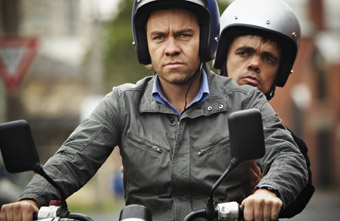
Brendan Cowell, Peter Dinklage, I Love You Too
photo John Tsiavis, courtesy Roadshow Films
Brendan Cowell, Peter Dinklage, I Love You Too
US director Judd Apatow proved with Knocked Up and The 40 Year Old Virgin that romantic comedies don’t have to be about a man and a woman. It’s the bromance that counts, that awkward and shambolic love affair between a guy and his mates. In Apatow’s work the writing can be crisp, hilarious and sometimes deeply disturbing. Here, Peter Helliar seems to be aiming for the same kind of film (and no doubt a lucrative market) and while he’s created some sharp one-liners and lovably messed-up characters, overall, the writing and pace of the film fall flat. It’s not helped by the unevenness of the acting. For all Megan Gale’s grace and beauty, she is not a natural on camera and her stilted performance highlights the talent of others around her, Cowell and Dinklage in particular. Then again, she doesn’t have much to work with. She’s a model with a heart of gold. Full stop. Helliar also seems to be working in a bit of Love, Actually with various relationship strands he tries to tie up by the end and there’s the lovable quirky family, a la The Castle—I Love You Too has ‘produced for the multiplex’ stamped all over it. You suspect though that Helliar had a darker story in mind and it’s lurking in there somewhere.
The main problem is that the film tries to hide its bromance leanings behind a conventional romance (between Cowell as Jim and Yvonne Strahovski as Alice) that never rings true. Alice sports a jolly hockeysticks Bridget-Jones-accent so grating you wish she would return to London and stay there. The writing of romance is difficult and Helliar appears uncomfortable with it, and the female characters in general. It’s as if he doesn’t really want to let his characters fall in love. He holds them back. The film is much stronger in the scenes where Helliar and Cowell bounce off each other in their insecure manly ways, trying to pick up chicks, arguing at the squash court. By the end we’ve had all the cinematic clichés we can handle bundled into the final scenes: an explanation (as to why he can’t say ‘I love you’); a race to the airport in a taxi, to ‘stop that plane’; a funeral (why did he have to die?); and, of course, a wedding.
At the gala premiere of I Love You Too, the radio commentator on the red carpet was welcoming the stars, saying each time, “Australian films are always so depressing, aren’t they! It’s great that this film is a comedy. It’s a breath of fresh air, isn’t it. It’s not like other Australia films.” But you could tell he hadn’t seen an Australian film for years. Popular Australian comedies (The Castle, Muriel’s Wedding, Strictly Ballroom, Kenny) have been sharper than this, and audiences know what they want when they see it. As Cowell and Helliar left him behind to enter the cinema, he tried desperately, floundering, to give away free tickets and t-shirts to the crowd. But they just weren’t interested—unless they could get a photo with Megan Gale.
I Love You Too, director Daina Reid, producers Yael Bergman, Laura Waters, writer Peter Helliar, cinematography Ellery Ryan, original music David Hirschfelder, editor Ken Sallows, production designer Jennifer A. Davis. www.iloveyoutoomovie.com
RealTime issue #96 April-May 2010 pg. web
© Kirsten Krauth; for permission to reproduce apply to realtime@realtimearts.net
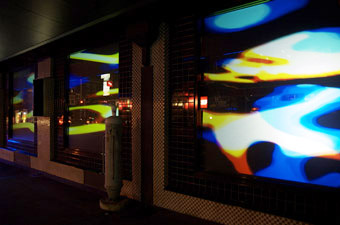
Tom Hall, The Past Will Betray
courtesy the artist
Tom Hall, The Past Will Betray
AS A MULTIMEDIA ARTIST, COMPOSER AND ELECTRONIC MUSICIAN, TOM HALL HAS CREATED WORK CONSISTENTLY REVOLVING AROUND TWO COMPLEMENTARY AMBITIONS THROUGHOUT HIS CAREER—THE EXTRAORDINARY EXTENDING ITSELF INTO THE ORDINARY AND VICE VERSA.
As a musician, Hall’s work within Brisbane-based ensembles like Damon Black’s Secret Birds or his own AxxOnn project has often been defined by the composer’s ongoing struggle to redefine laptop drones and electronic composition as a pursuit as egalitarian and accessible as the electric guitar and heavy metal. The laptop-oriented AxxOnn, by way of example, have spent the past two years performing alongside metal-oriented acts like Boston’s Isis and Seattle’s Sunn 0))).
Hall’s work as a multimedia artist, by contrast, has frequently found him sequencing and re-contextualising tasteful photographs and naturally occurring imagery of mundane environments into transcendental collages of light and sound. His solo compositions as a sound artist, furthermore, echo this approach. Euphonia, Hall’s 2008 collaborative album with fellow Brisbane-based artist Lawrence English, consisted of little more than solitary murmurs of shimmering electronics woven into gorgeous and hypnotic soundscapes.
The issue that has stalked the artist’s entire career has been the effective synthesis of his two perspectives. Hall has shown consistent difficulty in regards to creating a work that unites both ordinary and extraordinary worlds without revealing a clear bias to either. At best, in 2009’s Left of Left installation at Brisbane’s Judith Wright Centre, he has created transcendental work with a strong grounding in everyday influences; while, at his worst (Secret Birds’ earliest collaborative performances), Hall’s various worlds have collided, with violently fractured and disappointing results.
The Past Will Betray, however, has brought Hall closer to a unified artistic vision than any of his previous works. A stylistic successor to Left of Left presented within an almost identical framework, Hall’s most recent installation reveals both a broader conceptual scope than previously and a more refined appreciation of focus and deliberation. The work is officially geared towards exploring the indistinct areas between past and present but, ironically, The Past Will Betray is Hall’s most distinctive and focussed work yet.
A week-long interactive visual exhibit displayed nightly via the Judith Wright Centre’s Shopfront Space windows, The Past Will Betray’s installation component is very much a refinement of Hall’s Left of Left practices. The key difference is, whereas Left of Left consisted of multiple projections layered and dispersed throughout the entirety of the Shopfront Space and glimpsed through its windows, Betray’s visuals are projected directly onto the windows. The work immediately engages more with the public and fosters a greater sense of interactivity—a true joy.
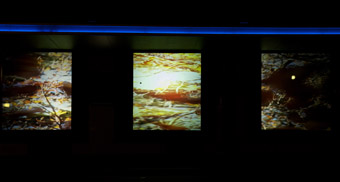
Tom Hall, The Past Will Betray
courtesy the artist
Tom Hall, The Past Will Betray
Visually the exhibit is titillating enough: Hall has expanded his range of austere, distended urban and nature images into colourful psychedelic vistas, effortlessly bathing the Shopfront windows in hues of orange and red without sacrificing the beauty of his more staid imagery. But, in interacting with the exhibit on a physical level, you discover an especially rewarding connection.
Placing your hands on the warm glass of the windows, you can practically feel the work give way to your indeterminate will. The colours, images and ideas almost seem to morph beneath your very fingertips. It’s often difficult to determine how much change is governed by interaction, but the work is a mammoth step forward from Left of Left and a truly thrilling experience in and of itself.
As with Left of Left, the exhibition concludes with a concert performance of work by Hall with supporting sound artists. But this somewhat blemishes the exhibition’s advancements. Whereas Left of Left saw Hall delivering the audio-visual source material of his exhibit over to multimedia artists Lawrence English and Lloyd Barrett to present additional versions of the exhibition’s central premise, The Past Will Betray’s final night doubles as a launch for Hall’s latest solo album Past, Present Below and, as such, proves to be a much more sound-oriented affair.
The performances presented on the night are far from unremarkable—Oren Ambarchi’s deconstructed guitar noise proves fittingly cerebral and Ambrose Chapel’s blend of doom-metal and ambience is intriguing and accomplished while Hall’s lush drones are a particular delight—but the entire event seems like a rather discontinuous and dissatisfying conclusion for such a fascinating exhibit.
Tom Hall, The Past Will Betray, Judith Wright Centre of Contemporary Arts, Brisbane, installation March 18-25, performance March 25
RealTime issue #96 April-May 2010 pg. web
© Matthew O’Neill; for permission to reproduce apply to realtime@realtimearts.net




















































![S]h]elf](https://www.realtime.org.au/wp-content/uploads/art/36/3671_giang_shelf.jpg)

















![l-r: Giang Dang, Phalla San, Joelle Jacinto [outside theatre]](https://www.realtime.org.au/wp-content/uploads/art/37/3701_gallasch_idf3.jpg)















































































































